
Oracle® Database
Database In-Memory Guide
23ai
F46739-10
July 2024
Oracle Database Database In-Memory Guide, 23ai
F46739-10
Copyright © 2016, 2024, Oracle and/or its affiliates.
Contributors: Frederick Kush
Contributing Authors: Maria Colgan, Vineet Marwah, Andy Rivenes, Randy Urbano, Roopesh Ashok Kumar, Frederick
Kush
Contributors: Yasin Baskan, Nigel Bayliss, Eric Belden, Larry Carpenter, Shasank Chavan, William Endress, Michael
Gleeson, Allison Holloway, Katsumi Inoue, Jesse Kamp, Chinmayi Krishnappa, Vasudha Krishnaswamy, Hariharan
Lakshmanan, Sue Lee, Teck Hua Lee, Huagang Li, Yunrui Li, Yuehua Liu, Roger Macnicol, Aurosish Mishra, Ajit
Mylavarapu, Khoa Nguyen, Jay Patel, Kathy Rich, Beth Roeser, Rich Strohm, Dina Thomas, Qiuhong Wang, Bob
Zebian
This software and related documentation are provided under a license agreement containing restrictions on use and
disclosure and are protected by intellectual property laws. Except as expressly permitted in your license agreement or
allowed by law, you may not use, copy, reproduce, translate, broadcast, modify, license, transmit, distribute, exhibit,
perform, publish, or display any part, in any form, or by any means. Reverse engineering, disassembly, or decompilation
of this software, unless required by law for interoperability, is prohibited.
The information contained herein is subject to change without notice and is not warranted to be error-free. If you find
any errors, please report them to us in writing.
If this is software, software documentation, data (as defined in the Federal Acquisition Regulation), or related
documentation that is delivered to the U.S. Government or anyone licensing it on behalf of the U.S. Government, then
the following notice is applicable:
U.S. GOVERNMENT END USERS: Oracle programs (including any operating system, integrated software, any
programs embedded, installed, or activated on delivered hardware, and modifications of such programs) and Oracle
computer documentation or other Oracle data delivered to or accessed by U.S. Government end users are "commercial
computer software," "commercial computer software documentation," or "limited rights data" pursuant to the applicable
Federal Acquisition Regulation and agency-specific supplemental regulations. As such, the use, reproduction,
duplication, release, display, disclosure, modification, preparation of derivative works, and/or adaptation of i) Oracle
programs (including any operating system, integrated software, any programs embedded, installed, or activated on
delivered hardware, and modifications of such programs), ii) Oracle computer documentation and/or iii) other Oracle
data, is subject to the rights and limitations specified in the license contained in the applicable contract. The terms
governing the U.S. Government's use of Oracle cloud services are defined by the applicable contract for such services.
No other rights are granted to the U.S. Government.
This software or hardware is developed for general use in a variety of information management applications. It is not
developed or intended for use in any inherently dangerous applications, including applications that may create a risk of
personal injury. If you use this software or hardware in dangerous applications, then you shall be responsible to take all
appropriate fail-safe, backup, redundancy, and other measures to ensure its safe use. Oracle Corporation and its
affiliates disclaim any liability for any damages caused by use of this software or hardware in dangerous applications.
Oracle®, Java, MySQL, and NetSuite are registered trademarks of Oracle and/or its affiliates. Other names may be
trademarks of their respective owners.
Intel and Intel Inside are trademarks or registered trademarks of Intel Corporation. All SPARC trademarks are used
under license and are trademarks or registered trademarks of SPARC International, Inc. AMD, Epyc, and the AMD logo
are trademarks or registered trademarks of Advanced Micro Devices. UNIX is a registered trademark of The Open
Group.
This software or hardware and documentation may provide access to or information about content, products, and
services from third parties. Oracle Corporation and its affiliates are not responsible for and expressly disclaim all
warranties of any kind with respect to third-party content, products, and services unless otherwise set forth in an
applicable agreement between you and Oracle. Oracle Corporation and its affiliates will not be responsible for any loss,
costs, or damages incurred due to your access to or use of third-party content, products, or services, except as set forth
in an applicable agreement between you and Oracle.

Contents
Preface
Audience xi
Documentation Accessibility xi
Related Documents xi
Conventions xi
Part I Oracle Database In-Memory Concepts
1
Introduction to Oracle Database In-Memory
1.1 Challenges for Analytic Applications 1-1
1.2 The Single-Format Approach 1-2
1.3 The Oracle Database In-Memory Solution 1-2
1.3.1 What Is Database In-Memory? 1-2
1.3.1.1 IM Column Store 1-3
1.3.1.2 Advanced Query Optimizations 1-4
1.3.1.3 High Availability Support 1-5
1.3.2 Improved Performance for Analytic Queries 1-5
1.3.2.1 Improved Performance for Data Scans 1-5
1.3.2.2 Improved Performance for Joins 1-8
1.3.2.3 Improved Performance for Aggregation 1-8
1.3.3 Improved Performance for Mixed Workloads 1-8
1.3.4 In-Memory Support for Exadata Flash Cache 1-9
1.3.5 High Availability Support 1-10
1.3.6 Ease of Adoption 1-11
1.4 Requirements for Database In-Memory 1-12
1.5 Principal Tasks for Database In-Memory 1-13
1.6 Tools for the IM Column Store 1-16
1.6.1 In-Memory Eligibility Test 1-16
1.6.2 In-Memory Advisor 1-18
1.6.3 Cloud Control Pages for the IM Column Store 1-22
1.6.4 Oracle Compression Advisor 1-22
iii

1.6.5 Oracle Data Pump and the IM Column Store 1-23
2
In-Memory Column Store Architecture
2.1 Dual-Format: Column and Row 2-1
2.1.1 Columnar Data in the In-Memory Area 2-1
2.1.1.1 Memory Pools in the In-Memory Area 2-2
2.1.2 Row Data in the Database Buffer Cache 2-3
2.2 Size of the In-Memory Area 2-5
2.3 In-Memory Storage Units 2-6
2.3.1 In-Memory Compression Units (IMCUs) 2-7
2.3.1.1 IMCUs and Schema Objects 2-7
2.3.1.2 Column Compression Units (CUs) 2-13
2.3.1.3 In-Memory Storage Indexes 2-15
2.3.2 Snapshot Metadata Units (SMUs) 2-17
2.3.2.1 IMCUs and SMUs 2-17
2.3.2.2 Transaction Journal 2-17
2.3.3 In-Memory Expression Units (IMEUs) 2-18
2.4 Expression Statistics Store (ESS) 2-19
2.5 In-Memory Process Architecture 2-20
2.5.1 In-Memory Coordinator Process (IMCO) 2-20
2.5.2 Space Management Worker Processes (Wnnn) 2-20
2.5.3 In-Memory Dynamic Scans 2-21
2.5.3.1 Purpose of IM Dynamic Scans 2-21
2.5.3.2 How IM Dynamic Scans Work 2-22
2.5.3.3 Interface for IM Dynamic Scans 2-24
2.6 CPU Architecture: SIMD Vector Processing 2-26
2.6.1 SIMD and Non-JSON LOBs 2-27
2.6.2 SIMD Access for JSON Data 2-27
2.6.3 SIMD and Oracle Numbers 2-27
2.6.4 SIMD and Exadata Smart Flash Cache 2-28
Part II Configuring and Populating the IM Column Store
3
Enabling and Sizing the IM Column Store
3.1 Overview of Enabling the IM Column Store 3-1
3.2 Estimating the Required Size of the IM Column Store 3-1
3.3 Enabling the IM Column Store for a CDB or PDB 3-2
3.4 Sizing the In-Memory Area 3-5
3.4.1 Increasing the Size of the IM Column Store Dynamically 3-8
3.5 Views for Working Automatic Sizing of the IM Column Store 3-9
iv

3.6 Disabling the IM Column Store 3-9
4
Automating Management of In-Memory Objects
4.1 Configuring Automatic In-Memory 4-1
4.1.1 Purpose of Automatic In-Memory 4-1
4.1.2 How Automatic In-Memory Works 4-1
4.1.2.1 Automatic In-Memory Heat Level Statistics 4-2
4.1.2.2 How Enabling Objects for Automatic In-Memory Works 4-2
4.1.2.3 How Automatic In-Memory Population Works 4-5
4.1.2.4 How Automatic In-Memory Eviction Works 4-5
4.1.3 User Interface for Automatic In-Memory 4-6
4.1.4 Controlling Automatic In-Memory 4-8
4.1.5 Setting the Time Interval for Automatic In-Memory 4-9
4.2 Enabling ADO for the IM Column Store 4-10
4.2.1 About ADO Policies and the IM Column Store 4-11
4.2.2 Purpose of ADO and the IM Column Store 4-11
4.2.3 How ADO Works with Columnar Data 4-13
4.2.3.1 How Heat Map Works 4-13
4.2.3.2 How Policy Evaluation Works 4-13
4.2.4 Controls for ADO and the IM Column Store 4-14
4.2.5 Creating an ADO Policy for the IM Column Store 4-16
4.3 Allowing AIM to Automatically Enable and Manage Performance Features 4-17
4.3.1 The DBMS_AUTOIM API 4-18
4.3.2 Views for Inspecting AIM 4-19
5
Enabling Objects for In-Memory Population Manually
5.1 About Manually Enabling Objects for In-Memory Population 5-1
5.1.1 Purpose of Enabling Objects for In-Memory Population 5-1
5.1.2 Controls for In-Memory Objects 5-2
5.1.2.1 The INMEMORY Subclause 5-2
5.1.2.2 Priority Options for the Population of In-Memory Objects 5-6
5.1.2.3 Compression Levels for In-Memory Objects 5-8
5.1.2.4 Oracle Compression Advisor 5-10
5.2 Enabling and Disabling Tables for the IM Column Store 5-10
5.2.1 Enabling New Tables for the In-Memory Column Store 5-10
5.2.2 Enabling and Disabling Existing Tables for the IM Column Store 5-11
5.2.3 Enabling and Disabling Tables for the IM Column Store 5-11
5.2.3.1 Creating an In-Memory Table: Example 5-11
5.2.3.2 Creating a Table with In-Memory Partitions: Example 5-12
5.2.3.3 Creating an In-Memory External Table: Example 5-13
v

5.2.3.4 Creating an In-Memory Partitioned External Table: Example 5-15
5.2.3.5 Creating and Populating a Hybrid External Table: Example 5-18
5.2.3.6 Enabling an Existing Table for the IM Column Store: Example 5-20
5.2.3.7 Setting In-Memory Compression to FOR CAPACITY LOW: Example 5-20
5.2.3.8 Setting In-Memory Priority to HIGH: Example 5-21
5.2.3.9 Changing the Compression and Priority Settings for an In-Memory Table:
Example 5-21
5.2.3.10 Disabling a Table for the IM Column Store: Example 5-22
5.2.3.11 Disabling Columnar Format on Exadata Smart Flash Cache: Example 5-22
5.3 Enabling and Disabling Columns for In-Memory Tables 5-22
5.3.1 About In-Memory Columns 5-22
5.3.1.1 Selective Columns 5-22
5.3.1.2 IM Virtual Columns 5-26
5.3.1.3 IM Full Text Columns 5-27
5.3.2 Enabling IM Virtual Columns 5-29
5.3.3 Enabling IM Full Text Columns 5-32
5.3.4 Enabling a Subset of Columns for the IM Column Store 5-34
5.3.5 Specifying INMEMORY Column Attributes on a NO INMEMORY Table 5-35
5.3.6 INMEMORY(ALL) and NO INMEMORY(ALL) Subclauses 5-37
5.4 Enabling and Disabling Tablespaces for the IM Column Store 5-38
5.5 Enabling and Disabling Materialized Views for the IM Column Store 5-39
6
Populating the IM Column Store Manually
6.1 About Manual Population of In-Memory Objects 6-1
6.1.1 How Manual In-Memory Population Works 6-1
6.1.1.1 Prioritization of In-Memory Population 6-1
6.1.1.2 How Background Processes Populate IMCUs 6-5
6.1.2 User Interface for Manual In-Memory Population 6-5
6.1.2.1 Population Using SELECT 6-5
6.1.2.2 Population Using DBMS_INMEMORY.POPULATE 6-6
6.1.2.3 Population Using DBMS_INMEMORY_ADMIN.POPULATE_WAIT 6-6
6.1.2.4 Population Using DBMS_INMEMORY.REPOPULATE 6-8
6.2 Forcing Initial Population of an In-Memory Object 6-8
6.3 Populating In-Memory Tables Manually: Examples 6-10
6.3.1 Populating an In-Memory Table Using a Full Table Scan: Example 6-10
6.3.2 Populating a Table Using the POPULATE Procedure: Example 6-12
6.3.3 Setting a Timeout Using the POPULATE_WAIT Function: Example 6-13
6.3.4 Populating an In-Memory External Table Using DBMS_INMEMORY.POPULATE:
Example 6-14
6.3.5 Refreshing an In-Memory External Table Using the REPOPULATE Procedure:
Example 6-16
vi

Part III Optimizing In-Memory Queries
7
Optimizing Queries with In-Memory Expressions
7.1 About IM Expressions 7-1
7.1.1 Purpose of IM Expressions 7-2
7.1.2 How IM Expressions Work 7-3
7.1.2.1 IM Expressions Infrastructure 7-3
7.1.2.2 Capture of IM Expressions 7-4
7.1.2.3 How the ESS Works 7-6
7.1.2.4 How the Database Populates IM Expressions 7-7
7.1.2.5 How IMEUs Relate to IMCUs 7-8
7.1.3 User Interfaces for IM Expressions 7-9
7.1.3.1 INMEMORY_EXPRESSIONS_USAGE 7-9
7.1.3.2 DBMS_INMEMORY_ADMIN and DBMS_INMEMORY 7-10
7.1.4 Basic Tasks for IM Expressions 7-11
7.2 Configuring IM Expression Usage 7-11
7.3 Capturing and Populating IM Expressions 7-12
7.4 Accelerating DATE Queries with In-Memory Optimized Dates 7-16
7.5 Dropping IM Expressions 7-17
8
Optimizing In-Memory Joins
8.1 About In-Memory Joins 8-1
8.2 Optimizing Joins with Join Groups 8-1
8.2.1 About Join Groups 8-1
8.2.2 Purpose of Join Groups 8-2
8.2.3 How Join Groups Work 8-4
8.2.3.1 How a Join Group Uses a Common Dictionary 8-4
8.2.3.2 How a Join Group Optimizes Scans 8-5
8.2.4 When a Hash Join Uses Common Dictionary Encodings 8-7
8.2.5 Creating Join Groups 8-9
8.2.6 Monitoring Join Group Usage 8-12
8.2.6.1 Monitoring Join Groups Using a SQL Monitor Report: Example 8-13
8.2.6.2 Monitoring Join Groups from the Command Line: Example 8-16
8.2.7 Leveraging Join Groups on a RAC Cluster 8-18
8.3 Optimizing Joins Using In-Memory Deep Vectorization 8-18
8.3.1 About In-Memory Deep Vectorization 8-18
8.3.2 How In-Memory Deep Vectorization Works 8-19
8.3.3 How an In-Memory Vectorized Join Works 8-19
8.3.4 User Interface for Deep Vectorization 8-20
8.3.5 Query Types Supported by the Deep Vectorization Framework 8-20
vii

8.3.6 In-Memory Vectorized Join: Example 8-21
8.3.7 In-Memory Deep Vectorization for Multi-Level Joins 8-22
9
Optimizing Aggregation
9.1 Optimizing In-Memory Aggregation with VECTOR GROUP BY 9-1
9.1.1 About IM Aggregation 9-1
9.1.2 Purpose of IM Aggregation 9-1
9.1.2.1 When IM Aggregation Is Useful 9-2
9.1.2.2 When IM Aggregation Is Not Beneficial 9-3
9.1.3 How IM Aggregation Works 9-3
9.1.3.1 When the Optimizer Chooses IM Aggregation 9-4
9.1.3.2 Key Vector 9-5
9.1.3.3 Two Phases of IM Aggregation 9-6
9.1.3.4 IM Aggregation: Scenario 9-7
9.1.4 Controls for IM Aggregation 9-12
9.1.5 In-Memory Aggregation: Example 9-13
9.2 Optimizing In-Memory Arithmetic 9-14
9.2.1 About In-Memory Optimized Arithmetic 9-14
9.2.2 Enabling and Disabling In-Memory Optimized Arithmetic 9-15
10
Optimizing Repopulation of the IM Column Store
10.1 About Repopulation of the IM Column Store 10-1
10.1.1 Row Modifications and the Transaction Journal 10-1
10.1.2 Automatic Repopulation 10-1
10.1.3 Manual Repopulation of External Tables 10-2
10.2 How Data Loading Works with the IM Column Store 10-2
10.2.1 How Conventional DML Works with the IM Column Store 10-2
10.2.1.1 Staleness Threshold 10-3
10.2.1.2 Double Buffering 10-3
10.2.2 How Direct Path Loads Work with the IM Column Store 10-4
10.2.3 How a Partition Exchange Load Works with the IM Column Store 10-5
10.3 When the Database Repopulates the IM Column Store 10-7
10.3.1 Threshold-Based and Trickle Repopulation 10-7
10.3.2 Factors Affecting Repopulation 10-9
10.4 Controls for Repopulation of the IM Column Store 10-10
10.5 Optimizing Trickle Repopulation: Tutorial 10-11
Part IV High Availability and the IM Column Store
viii

11
Managing IM FastStart for the IM Column Store
11.1 About IM FastStart 11-1
11.1.1 Purpose of IM FastStart 11-1
11.1.2 How IM FastStart Works 11-1
11.1.2.1 How the Database Manages the FastStart Area 11-2
11.1.2.2 How the Database Reads from the FastStart Area 11-5
11.2 Enabling IM FastStart for the IM Column Store 11-5
11.3 Retrieving the Name of the Current IM FastStart Tablespace 11-7
11.4 Migrating the FastStart Area to a Different Tablespace 11-8
11.5 Disabling IM FastStart for the IM Column Store 11-9
12
Deploying IM Column Stores in Oracle RAC
12.1 Overview of Database In-Memory and Oracle RAC 12-1
12.1.1 Multiple IM Column Stores 12-1
12.1.2 Distribution and Duplication of Columnar Data in Oracle RAC 12-4
12.1.2.1 Distribution of Columnar Data in Oracle RAC 12-4
12.1.2.2 Duplication of Columnar Data in Oracle RAC 12-8
12.1.3 Parallelism in Oracle RAC 12-11
12.1.3.1 Serial and Parallel Queries in Oracle RAC 12-11
12.1.3.2 Auto DOP in Oracle RAC 12-12
12.1.4 FastStart Area in Oracle RAC 12-13
12.2 Configuring In-Memory Services in Oracle RAC 12-14
12.2.1 Instance-Level Service Controls 12-14
12.2.2 Object-Level Service Controls 12-15
12.2.3 Benefits of Services for Database In-Memory in Oracle RAC 12-16
12.2.4 Configuring an In-Memory Service for a Subset of Nodes: Example 12-17
13
Deploying an IM Column Store with Oracle Active Data Guard
13.1 About Database In-Memory and Active Data Guard 13-1
13.1.1 Purpose of IM Column Stores in Oracle Active Data Guard 13-1
13.1.1.1 Identical IM Column Stores in Primary and Standby Databases 13-1
13.1.1.2 IM Column Store in Standby Database Only 13-2
13.1.1.3 Different Objects in the Primary and Standby IM Column Stores 13-2
13.1.2 How IM Column Stores Work in Oracle Active Data Guard 13-3
13.1.3 In-Memory Restrictions in Active Data Guard 13-5
13.2 Configuring IM Column Stores in an Oracle Active Data Guard Environment 13-5
Part V Database In-Memory Reference
ix

14
In-Memory Initialization Parameters
15
In-Memory Views
A
Using IM Column Store in Cloud Control
A.1 Meeting Prerequisites for Using IM Column Store in Cloud Control A-1
A.2 Using the In-Memory Column Store Central Home Page to Monitor In-Memory
Support for Database Objects A-1
A.3 Specifying In-Memory Details When Creating a Table or Partition A-2
A.4 Viewing or Editing IM Column Store Details of a Table A-3
A.5 Viewing or Editing IM Column Store Details of a Partition A-3
A.6 Specifying IM Column Store Details During Tablespace Creation A-3
A.7 Viewing and Editing IM Column Store Details of a Tablespace A-4
A.8 Specifying IM Column Store Details During Materialized View Creation A-4
A.9 Viewing or Editing IM Column Store Details of a Materialized View A-4
Glossary
Index
x

Preface
This manual explains the architecture and tasks associated with the Oracle Database In-
Memory feature set.
This preface contains the following topics:
Audience
This document is intended for database administrators who manage an In-Memory Column
Store (IM column store), and developers who optimize analytic queries that use Oracle
Database In-Memory features.
Documentation Accessibility
For information about Oracle's commitment to accessibility, visit the Oracle Accessibility
Program website at http://www.oracle.com/pls/topic/lookup?ctx=acc&id=docacc.
Access to Oracle Support
Oracle customers that have purchased support have access to electronic support through My
Oracle Support. For information, visit http://www.oracle.com/pls/topic/lookup?ctx=acc&id=info
or visit http://www.oracle.com/pls/topic/lookup?ctx=acc&id=trs if you are hearing impaired.
Related Documents
This manual assumes that you are familiar with Oracle Database Concepts. The following
books are frequently referenced:
• Oracle Database Data Warehousing Guide
• Oracle Database VLDB and Partitioning Guide
• Oracle Database SQL Tuning Guide
• Oracle Database SQL Language Reference
• Oracle Database Reference
Many examples in this book use the sample schemas, which are installed by default when you
select the Basic Installation option with an Oracle Database. See Oracle Database Sample
Schemas for information on how these schemas were created and how you can use them.
Conventions
The following text conventions are used in this document:
xi

Convention Meaning
boldface
Boldface type indicates graphical user interface elements associated with an
action, or terms defined in text or the glossary.
italic Italic type indicates book titles, emphasis, or placeholder variables for which
you supply particular values.
monospace
Monospace type indicates commands within a paragraph, URLs, code in
examples, text that appears on the screen, or text that you enter.
Preface
xii

Part I
Oracle Database In-Memory Concepts
This part introduces the Oracle Database In-Memory (Database In-Memory) feature set, and
explains the basic architecture of the In-Memory Column Store (IM column store).

1
Introduction to Oracle Database In-Memory
Oracle Database In-Memory (Database In-Memory) is a suite of features that greatly improves
performance for real-time analytics and mixed workloads. The In-Memory Column Store (IM
column store) is the key feature of Database In-Memory.
Note:
Database In-Memory features require the Oracle Database In-Memory option. For
the Database In-Memory Base Level, the IM column store size is limited to 16 GB at
the CDB level. See Oracle Database Licensing Information User Manual for details
on which features are supported for different editions and services.
1.1 Challenges for Analytic Applications
Traditionally, obtaining good performance for analytic queries meant satisfying several
requirements.
In a typical data warehouse or mixed-use database, requirements include the following:
• You must understand user access patterns.
• You must provide good performance, which typically requires creating indexes, and
materialized views.
For example, if you create 1 to 3 indexes for a table (1 primary key and 2 foreign key indexes)
to provide good performance for an OLTP application, then you may need to create additional
indexes to provide good performance for analytic queries.
Figure 1-1 Multiple Indexes
Table
OLTP
Indexes
Analytic
Indexes
Meeting the preceding requirements creates manageability and performance problems.
Additional access structures cause performance overhead because you must create, manage,
and tune them. For example, inserting a single row into a table requires an update to all
indexes on this table, which increases response time.
1-1

The demand for real-time analytics means that more analytic queries are being executed in a
mixed-workload database. The traditional approach is not sustainable.
1.2 The Single-Format Approach
Traditionally, relational databases store data in either row or columnar formats. Memory and
disk store data in the same format.
An Oracle database stores rows contiguously in data blocks. For example, in a table with three
rows, an Oracle data block stores the first row, and then the second row, and then the third
row. Each row contains all column values for the row. Data stored in row format is optimized for
transaction processing. For example, updating all columns in a small number of rows may
modify only a small number of blocks.
To address the problems relating to analytic queries, some database vendors have introduced
a columnar format. A columnar database stores selected columns—not rows—contiguously.
For example, in a large sales table, the sales IDs reside in one column, and sales regions
reside in a different column.
Analytical workloads access few columns while scanning, but scan the entire data set. For this
reason, the columnar format is the most efficient for analytics. Because columns are stored
separately, an analytical query can access only required columns, and avoid reading
inessential data. For example, a report on sales totals by region can rapidly process many
rows while accessing only a few columns.
Database vendors typically force customers to choose between a columnar and row-based
format. For example, if the data format is columnar, then the database stores data in columnar
format both in memory and on disk. Gaining the advantages of one format means losing the
advantages of the alternate format. Applications either achieve rapid analytics or rapid
transactions, but not both. The performance problems for mixed-use databases are not solved
by storing data in a single format.
1.3 The Oracle Database In-Memory Solution
The Oracle Database In-Memory (Database In-Memory) feature set includes the In-Memory
Column Store (IM column store), advanced query optimizations, and availability solutions.
The Database In-Memory optimizations enable analytic queries to run orders of magnitude
faster on data warehouses and mixed-use databases.
1.3.1 What Is Database In-Memory?
The Database In-Memory feature set includes the IM column store, advanced query
optimizations, and availability solutions.
Database In-Memory features combine to accelerate analytic queries by orders of magnitude
without sacrificing OLTP performance or availability.
See Also:
Oracle Database Licensing Information User Manual to learn about the Database In-
Memory option
Chapter 1
The Single-Format Approach
1-2

1.3.1.1 IM Column Store
The IM column store maintains copies of tables, partitions, and individual columns in a
compressed columnar format that is optimized for rapid scans.
The IM column store stores the data for each table or view by column rather than by row. Each
column is divided into separate row subsets. A container called an In-Memory Compression
Unit (IMCU) stores all columns for a subset of rows in a table segment.
Video:
Video
Storage in the SGA
The IM column store resides in the In-Memory Area, which is an optional portion of the system
global area (SGA). The IM column store does not replace row-based storage or the database
buffer cache, but supplements it. The database enables data to be in memory in both a row-
based and columnar format, providing the best of both worlds. The IM column store provides
an additional transaction-consistent copy of table data that is independent of the disk format.
Figure 1-2 Dual-Format Database
New In-Memory
Format
Normal Buffer
Cache
SalesSales
Columnar
Format
Row
Format
Reports
Transactions
Database
Sales
Table
Server
Note:
Objects populated in the IM column store do not also need to be loaded into the
buffer cache.
Chapter 1
The Oracle Database In-Memory Solution
1-3

Population of Objects in the IM Column Store
In-Memory population is the automatic transformation of row-based data on disk into columnar
data in the IM column store. When the
INMEMORY_AUTOMATIC_LEVEL
initialization parameter is
set to
HIGH
, the database automatically decides the optimal segments and columns to populate
in the IM column store, evicting infrequently accessed segments. No user decision-making is
required.
Alternatively, you can manage the IM column store manually, specifying the
INMEMORY
clause at
the object or column level, and then choosing when to populate objects. You can specify the
INMEMORY
clause at any of the following levels, listed from lowest level to highest level:
• Column (nonvirtual or virtual)
• Table partition (internal or external)
• Table (internal or external) or materialized view
• Tablespace
For any object, you can configure all or a subset of its columns for population. Similarly, for a
partitioned table or materialized view, you can configure all or a subset of the partitions for
population.
See Also:
• "In-Memory Column Store Architecture"
• "Enabling the IM Column Store for a CDB or PDB"
• "Automating Management of In-Memory Objects"
• Oracle Database SQL Language Reference for more information about the
INMEMORY
clause
1.3.1.2 Advanced Query Optimizations
Database In-Memory includes several performance optimizations for analytic queries.
Optimizations include:
• An expression is a combination of one or more values, operators, and SQL functions
(
DETERMINISTIC
only) that resolve to a value. By default, the In-Memory Expression (IM
expression) optimization enables the
DBMS_INMEMORY_ADMIN.IME_CAPTURE_EXPRESSIONS
procedure to identify and populate “hot” expressions in the IM column store.
An IM expression is materialized as a hidden virtual column, but is accessed in the same
way as a non-virtual column. IM expressions support the storage of virtual columns with
the following data types:
NUMBER
,
CHAR
,
VARCHAR2
,
DATE
,
TIMESTAMP
,
TIMESTAMP WITH TIME
ZONE
,
BINARY_FLOAT
,
BINARY_DOUBLE
, and
RAW
. They do not store virtual columns that have
character-set dependent data types, such as
NCHAR
and
NVARCHAR2
. The also do not
support NLS-dependent data types.
• A join group is a user-defined object that specifies a set of columns frequently used to join
a set of tables. In certain queries, join groups enable the database to eliminate the
performance overhead of decompressing and hashing column values.
Chapter 1
The Oracle Database In-Memory Solution
1-4

• For aggregation queries that join small dimension tables to a large fact table, In-Memory
Aggregation (IM aggregation) uses the
VECTOR GROUP BY
operation to enhance
performance. This optimization aggregates data during the scan of the fact table rather
than afterward.
• In the IM column store, repopulation is the automatic update of IMCUs after the data within
them has been significantly modified. If an IMCU has stale entries but does not meet the
staleness threshold, then background processes may instigate trickle repopulation, which
is the gradual repopulation of the IM column store.
Related Topics
• Optimizing In-Memory Queries
This Part explains how to optimize queries using In-Memory Expressions, join groups, and
In-Memory aggregation. It also explains how the IM column store repopulates modified
data.
1.3.1.3 High Availability Support
Availability is the degree to which an application, service, or function is accessible on demand.
Database In-Memory supports the following availability features:
• In-Memory FastStart (IM FastStart) reduces the time to populate data into the IM column
store when a database instance restarts. IM FastStart achieves this by periodically saving
a copy of the data currently populated in the IM column store on the disk in its compressed
columnar format.
• Each node in an Oracle Real Application Clusters (Oracle RAC) environment has its own
IM column store. It is possible to have completely different objects populated on every
node, or to have larger objects distributed across all IM column stores in the cluster. In
Engineered Systems, it is also possible to have the same objects appear in the IM column
store on every node.
• Starting in Oracle Database 12c Release 2 (12.2), an IM column store is supported on a
standby database in an Active Data Guard environment.
Related Topics
• High Availability and the IM Column Store
This part explains how to use the IM column store with high availability features such as In-
Memory FastStart (IM FastStart), Oracle Data Guard, and Oracle Real Application Clusters
(Oracle RAC).
1.3.2 Improved Performance for Analytic Queries
The compressed columnar format enables faster scans, queries, joins, and aggregates.
1.3.2.1 Improved Performance for Data Scans
The columnar format provides fast throughput for scanning large amounts of data.
The IM column store enables you to analyze data in real time, enabling you to explore different
possibilities and perform iterations. Specifically, the IM column store can drastically improve
performance for queries that do the following:
• Scan many rows and applies filters that use operators such as
<
,
>
,
=
, and
IN
• Select few columns from a table or a materialized view that has many columns, such as a
query that accesses 5 out of 100 columns
Chapter 1
The Oracle Database In-Memory Solution
1-5

• Enable fast In-Memory searching of text, XML, or JSON documents when queries specify
the
CONTAINS()
or
JSON_TEXTCONTAINS()
operators
Note:
"IM Full Text Columns"
Related Topics
• CPU Architecture: SIMD Vector Processing
For data that is populated in the IM column store, the database uses SIMD (single
instruction, multiple data) processing.
• Dual-Format: Column and Row
When you enable an IM column store, the SGA manages data in separate locations: the
In-Memory Area and the database buffer cache.
• Configuring and Populating the IM Column Store
You can enable and size the In-Memory Column Store (IM column store). You can also
configure In-Memory settings for objects, and populate these objects in the IM column
store.
1.3.2.1.1 Pure In-Memory Scans
In a pure In-Memory scan, all data is accessed from the IM column store.
Scans of the IM column store are faster than scans of row-based data for the following
reasons:
• Elimination of buffer cache overhead
The IM column store stores data in a pure, In-Memory columnar format. The data does not
persist in the data files or generate redo, so the database avoids the overhead of reading
data from disk into the buffer cache.
• Data pruning
The database scans only the columns necessary for the query rather than entire rows of
data. Furthermore, the database uses storage indexes and an internal dictionary to read
only the necessary IMCUs for a specific query. For example, if a query requests all sales
for a store with a store ID less than 8, then the database can use IMCU pruning to
eliminate IMCUs that do not contain this value.
• Compression
Traditionally, the goal of compression is to save space. In the IM column store, the goal of
compression is to accelerate scans. The database automatically compresses columnar
data using algorithms that allow
WHERE
clause predicates to be applied against the
compressed formats. Depending on the type of compression applied, Oracle Database can
scan data in its compressed format without decompressing it first. Therefore, the volume of
data that the database must scan in the IM column store is less than the corresponding
volume in the database buffer cache.
• Vector processing
Each CPU core scans local in-memory columns. To process data as an array, the scans
use SIMD (single instructional, multiple data) vector instructions. For example, a query can
read a set of values in a single CPU instruction rather than read the values one by one.
Vector scans by a CPU core are orders of magnitude faster than row scans.
Chapter 1
The Oracle Database In-Memory Solution
1-6

For example, suppose a user executes the following ad hoc query:
SELECT cust_id, time_id, channel_id
FROM sales
WHERE prod_id BETWEEN 14 and 29
ORDER BY 1, 2, 3;
When using the buffer cache, the database would typically scan an index to find the product
IDs, use the rowids to fetch the rows from disk into the buffer cache, and then discard the
unwanted column values. Scanning data in row format in the buffer cache requires many CPU
instructions, and can result in suboptimal CPU efficiency.
When using the IM column store, the database can scan only the requested
sales
columns,
avoiding disk altogether. Scanning data in columnar format pipelines only necessary columns
to the CPU, increasing efficiency. Each CPU core scans local in-memory columns using SIMD
vector instructions.
Video:
Video
1.3.2.1.2 In-Memory Hybrid Scans
An In-Memory hybrid scan retrieves rows from both the IM column store and row store.
Using the selective columns feature, you can enable a subset of columns in an object for In-
Memory access. For example, if the only
sales
columns specified in application queries are
prod_id
,
cust_id
, and
amount_sold
, then you might decide to save memory by applying the
INMEMORY
attribute to only these columns. However, a user might issue the following ad hoc
query:
SELECT prod_id, time_id FROM sales WHERE cust_id IN (100,200,300);
Because
time_id
is a
NO INMEMORY
column, the query must retrieve data from the row store,
possibly reducing performance. However, the optimizer can consider an In-Memory hybrid
scan because the following conditions are met:
• All columns in the predicate are
INMEMORY
. In this example,
cust_id
is the only predicate
column, and it is
INMEMORY
.
• The
SELECT
list contains an arbitrary mix of
NO INMEMORY
and
INMEMORY
columns. In this
example,
prod_id
is
INMEMORY
, but
time_id
is
NO INMEMORY
.
Within a single table scan of
sales
, an In-Memory hybrid scan filters data in the IM column
store and projects data from the row store. In this way, an In-Memory hybrid scan can increase
response time by orders of magnitude.
Note:
"In-Memory Hybrid Scans"
Chapter 1
The Oracle Database In-Memory Solution
1-7

1.3.2.2 Improved Performance for Joins
A Bloom filter is a low-memory data structure that tests membership in a set. The IM column
store takes advantage of Bloom filters to improve the performance of joins.
Bloom filters speed up joins by converting predicates on small dimension tables to filters on
large fact tables. This optimization is useful when performing a join of multiple dimensions with
one large fact table. The dimension keys on fact tables have many repeat values. The scan
performance and repeat value optimization speeds up joins by orders of magnitude.
Related Topics
• About In-Memory Joins
Joins are an integral part of data warehousing workloads. The IM column store enhances
the performance of joins when the tables being joined are stored in memory.
See Also:
"About In-Memory Joins"
1.3.2.3 Improved Performance for Aggregation
An important aspect of analytics is to determine patterns and trends by aggregating data.
Aggregations and complex SQL queries run faster when data is stored in the IM column store.
In Oracle Database, aggregation typically involves a
GROUP BY
clause. Traditionally, the
database used
SORT
and
HASH
operators. Starting in Oracle Database 12c Release 1 (12.1), the
database offered
VECTOR GROUP BY
transformations to enable efficient in-memory, array-based
aggregation.
During a fact table scan, the database accumulates aggregate values into in-memory arrays,
and uses efficient algorithms to perform aggregation. Joins based on the primary key and
foreign key relationships are optimized for both star schemas and snowflake schemas.
See Also:
• "Optimizing In-Memory Aggregation with VECTOR GROUP BY"
• Oracle Database Data Warehousing Guide to learn more about SQL aggregation
1.3.3 Improved Performance for Mixed Workloads
Although OLTP applications do not benefit from accessing data in the IM column store, the
dual-memory format can indirectly improve OLTP performance.
When all data is stored in rows, improving analytic query performance requires creating access
structures. The standard approach is to create analytic indexes, materialized views. For
example, a table might require 3 indexes to improve the performance of the OLTP application
(1 primary key and 2 foreign key indexes) and 10-20 additional indexes to improve the
performance of the analytic queries. While this technique can improve analytic query
Chapter 1
The Oracle Database In-Memory Solution
1-8

performance, it slows down OLTP performance. Inserting a row into the table requires
modifying all indexes on the table. As the number of indexes increases, insertion speed
decreases.
When you populate data into the IM column store, you can drop analytic access structures.
This technique reduces storage space and processing overhead because fewer indexes,
materialized views are required. For example, an insert results in modifying 1-3 indexes
instead of 11-23 indexes.
While the IM column store can drastically improve performance for analytic queries in business
applications, ad hoc analytic queries, and data warehouse workloads, pure OLTP databases
that perform short transactions using index lookups benefit less. The IM column store does not
improve performance for the following types of queries:
• A query with complex predicates
• A query that selects many columns
• A query that returns many rows
See Also:
Oracle Database Data Warehousing Guide to learn more about physical data
warehouse design
1.3.4 In-Memory Support for Exadata Flash Cache
Not all objects marked
INMEMORY
may fit in DRAM memory at the same time. If you use Oracle
Exadata Storage Server Software, then Exadata Smart Flash Cache can serve as
supplemental memory.
When the IM column store is enabled, Exadata Smart Flash Cache reformats data
automatically into In-Memory columnar format. In previous Exadata releases, only Hybrid
Column Compressed data was eligible for flash storage in IM columnar format. The
reformatting occurs for both compressed (including OLTP compression) and uncompressed
tables.
Note:
If Database In-Memory Base Level is enabled, then the CELLMEMORY feature is
disabled for Oracle Exadata.
With this format, most Database In-Memory performance enhancements are supported in
Smart Scan, including joins and aggregation. Also, reformatting uncompressed and OLTP-
compressed data blocks into IM columnar format can significantly reduce the amount of flash
memory required.
Exadata Smart Flash Cache transforms the data in the following stages:
1. Oracle Exadata caches data from eligible scans in a legacy columnar format so that the
data is available immediately. This format is columnar, but it is not the same format used
by the IM column store.
Chapter 1
The Oracle Database In-Memory Solution
1-9

2. In the background, Oracle Exadata reformats data into the pure IM column store format at
a lower priority. The background writes prevent interference with the main workload.
If the database is not running an OLTP workload, then a data warehousing workload can
consume 100% of the flash cache. However, an OLTP workload limits the data warehouse
workload to no more than 50% of the flash cache. This optimization ensures that OLTP
workload performance is not sacrificed for analytic scans.
By default, Exadata Smart Flash Cache compresses data using the level
MEMCOMPRESS FOR
CAPACITY LOW
. To change the compression level or disable the columnar format altogether, use
the
ALTER TABLE ... NO CELLMEMORY
statement.
See Also:
• "Enabling the IM Column Store for a CDB or PDB"
• "CPU Architecture: SIMD Vector Processing"
• Oracle Exadata Database Machine System Overview to learn more about the
CELLMEMORY
attribute
• Oracle Database Licensing Information User Manual for details on which features
are supported for different editions and services
1.3.5 High Availability Support
The IM column store is fully integrated into Oracle Database. All High Availability features are
supported.
The columnar format does not change the Oracle database on-disk storage format. Thus,
buffer cache modifications and redo logging function in the same way. Features such as
RMAN, Oracle Data Guard, and Oracle ASM are fully supported.
In an Oracle Real Application Clusters (Oracle RAC) environment, each node has its own IM
column store by default. Depending on your requirements, you can populate objects in different
ways:
• Different tables are populated on every node. For example, the
sales
fact table is on one
node, whereas the
products
dimension table is on a different node.
• A single table is distributed among different nodes. For example, different partitions of the
same hash-partitioned table are on different nodes, or different rowid ranges of a single
nonpartitioned table are on different nodes.
• Some objects appear in the IM column store on every node. For example, you might
populate the
products
dimension table in every node, but distribute partitions of the
sales
fact table across different nodes.
See Also:
"High Availability and the IM Column Store"
Chapter 1
The Oracle Database In-Memory Solution
1-10

1.3.6 Ease of Adoption
Database In-Memory is simple to implement, and requires no application changes.
Key aspects of Database In-Memory adoption include:
• Ease of deployment
No user-managed data migration is required. The database stores data in row format on
disk and automatically converts row data into columnar format when populating the IM
column store.
• Compatibility with existing applications
No application changes are required. The optimizer automatically takes advantage of the
columnar format. If your application connects to the database and issues SQL, then it can
benefit from Database In-Memory features.
• Full SQL compatibility
Database In-Memory places no restrictions on SQL. Analytic queries can benefit whether
they use Oracle analytic functions or customized PL/SQL code.
• Ease of setup
No complex setup is required. The
INMEMORY_SIZE
initialization parameter specifies the
amount of memory reserved for use by the IM column store. By configuring the IM column
store, you can immediately improve the performance of existing analytic workloads and ad
hoc queries.
• Ease of object management
Automatic In-Memory uses access tracking and column statistics to manage objects in the
IM column store. When the
INMEMORY_AUTOMATIC_LEVEL
initialization parameter is set to
HIGH
, the database automatically decides the optimal segments and columns to retain in
the IM column store, evicting "cold" (infrequently accessed) segments. No user decision-
making is required.
Note:
If the
INMEMORY_FORCE
initialization parameter is set to
BASE_LEVEL
, then
Automatic In-Memory is disabled even if
INMEMORY_AUTOMATIC_LEVEL
is set. Even
if tables have a compression level of
AUTO
, Automatic In-Memory background
operations do not run.
• Optional fine-grained control of In-Memory objects and columns
When
INMEMORY_AUTOMATIC_LEVEL
is not set to
HIGH
, the
INMEMORY
clause in DDL
statements specifies the objects or columns to be populated into the IM column store. You
can specify that only certain objects or certain columns are eligible for In-Memory
population.
Chapter 1
The Oracle Database In-Memory Solution
1-11

See Also:
• "Enabling and Sizing the IM Column Store" to learn how to enable the IM column
store
• "Configuring Automatic In-Memory"
• Oracle Database Reference to learn about the
INMEMORY_SIZE
,
INMEMORY_FORCE
,
and
INMEMORY_AUTOMATIC_LEVEL
initialization parameters
1.4 Requirements for Database In-Memory
The Oracle Database In-Memory option is required for all Database In-Memory features. The
Database In-Memory Base Level is available for an IM column store that is 16 GB or less.
Requirements include:
• To use the Database In-Memory Base Level, the
INMEMORY_FORCE
initialization parameter
must be set to
BASE_LEVEL
in the initialization parameter file at the CDB level. You cannot
set this parameter dynamically, or set it at the PDB level. The
BASE_LEVEL
setting has the
following consequences:
– All
INMEMORY
objects and columns automatically and transparently use the
compression level of
QUERY LOW
.
– Automatic In-Memory is disabled.
• To use the CellMemory feature without incurring the overhead of creating an IM column
store, set this parameter to
CELLMEMORY_LEVEL
. This option is valid only for on-premises
Oracle Exadata systems.
Note that if the value of
INMEMORY_SIZE
is greater than
0
, then setting
INMEMORY_FORCE=CELLMEMORY_LEVEL
is equivalent to setting
INMEMORY_FORCE=DEFAULT
. In
this case, the Database In-Memory option is enabled, even if you use CellMemory only.
• For the Base Level, the IM column store size must not exceed 16 GB.
• The IM column store requires a minimum of 100 MB of memory. The store size is included
in
MEMORY_TARGET
.
• For Oracle RAC databases, if the
INMEMORY_FORCE
initialization parameter is set to
BASE_LEVEL
, then the column store size of each database is limited to 16 GB.
No special hardware is required for an IM column store.
See Also:
• "Estimating the Required Size of the IM Column Store"
• "Deploying IM Column Stores in Oracle RAC"
• Oracle Database Licensing Information User Manual for all licensing-related
information for Database In-Memory
Chapter 1
Requirements for Database In-Memory
1-12

1.5 Principal Tasks for Database In-Memory
For queries to benefit from the IM column store, the only required task is sizing the IM column
store. Query optimizationf and availability features require additional configuration.
Principal Tasks for Configuring the IM Column Store
The following table lists the principal configuration tasks.
Table 1-1 Configuration Tasks
Task Notes When Required To Learn More
Enable the IM column
store by specifying its
size.
Set
INMEMORY_SIZE
to a value
greater than zero.
For the Database In-Memory
Base Level only, you can allocate
up to 16 GB on any CDB or any
instance of an Oracle RAC
database.
The
COMPATIBLE
initialization
parameter must be set to
12.1.0
or higher.
Required for all Database In-
Memory features
"Enabling the IM Column
Store for a CDB or PDB"
For the Database In-
Memory Base Level,
perform additional
configuration.
For the Database In-Memory
Base Level only, the
INMEMORY_FORCE
initialization
parameter must be set to
BASE_LEVEL
at the CDB level,
and
INMEMORY_SIZE
must be
less than or equal to 16 GB.
Required only for the Database
In-Memory Base Level
"Enabling the IM Column
Store for a CDB or PDB"
Configure Automatic In-
Memory to enable,
populate, and evict cold
segments to ensure that
the working data set is
always populated
When the
INMEMORY_AUTOMATIC_LEVEL
initialization parameter is set to
HIGH
, Oracle Database uses
internal usage statistics to
manage the workload. For
example, if the database
determines that certain partitions
of the
sales
table are frequently
queried, then it enables them as
INMEMORY
and populates them.
As the workload changes, and
segments become "cold," they
are replaced by hot segments.
Note: If the
INMEMORY_FORCE
initialization parameter is set to
BASE_LEVEL
, then Automatic In-
Memory is disabled even if
INMEMORY_AUTOMATIC_LEVEL
is
set. Even if tables have a
compression level of
AUTO
,
Automatic In-Memory
background operations do not
run.
Required for fully automated
management of Database In-
Memory objects
"Configuring Automatic
In-Memory"
Chapter 1
Principal Tasks for Database In-Memory
1-13

Table 1-1 (Cont.) Configuration Tasks
Task Notes When Required To Learn More
Enable columns,
partitions, tables or
materialized views, or
tablespaces for
population into the IM
column store.
Unless
INMEMORY_AUTOMATIC_LEVEL
is
set to
HIGH
, all objects are
NO
INMEMORY
by default. This
means that they cannot be
populated in the IM column store.
Manually specifying the
INMEMORY
clause in a DDL
statement enables an object for
In-Memory access, that is,
makes it eligible to be populated.
Note: If the
INMEMORY_FORCE
initialization parameter is set to
BASE_LEVEL
, then
INMEMORY
objects and columns
automatically use
QUERY LOW
compression. The data dictionary
views may continue to show pre-
existing compression settings,
but the Base Level always
transparently compresses
objects and columns at the
QUERY LOW
level.
Required when
INMEMORY_AUTOMATIC_LEVEL
is
not
HIGH
"Enabling Objects for In-
Memory Population
Manually"
Populate objects into to
the IM column store
manually
Enabling an object for In-Memory
access is a separate step from
populating it. Unless
INMEMORY_AUTOMATIC_LEVEL
is
set to
HIGH
, the population of an
object depends on its
INMEMORY ... PRIORITY
setting. When set to
NONE
(default), you must manually
populate the object using a query
or PL/SQL call. It will not be
populated otherwise.
When
INMEMORY ...
PRIORITY
is not set to
NONE
, the
database automatically populates
INMEMORY
objects after instance
startup based on their position in
the queue. For example, objects
with
HIGH
priority are populated
before objects of
LOW
priority. In
this case, you do not need to
manually populate an object
unless you want to override the
queue.
Required when the
PRIORITY
setting is
NONE
"Populating the IM
Column Store Manually"
Chapter 1
Principal Tasks for Database In-Memory
1-14

Table 1-1 (Cont.) Configuration Tasks
Task Notes When Required To Learn More
Create Automatic Data
Optimization (ADO)
policies to set
INMEMORY
attributes on objects in
the IM column store.
For example, a policy can evict
the
sales
table from the IM
column store after 10 days of no
access. In-Memory ADO features
require that
HEAT_MAP=ON
is set
to
ON
and
INMEMORY_SIZE
is set
to a nonzero value.
Optional "Enabling ADO for the IM
Column Store"
Principal Tasks for Optimizing In-Memory Queries
In-Memory query optimizations are not required for the IM column store to function. The
following optimization tasks are optional.
Table 1-2 Query Optimization Tasks
Task Notes To Learn More
Manage automatic detection of IM
expressions in the IM column store by
using the
DBMS_INMEMORY_ADMIN
package.
For example, invoke the
IME_CAPTURE_EXPRESSIONS
procedure to
define the period in which the database can
identify “hot” expressions, and then
gradually populate them. The
INMEMORY_EXPRESSIONS_USAGE
initialization parameter controls the type of
IM expression that the database can
populate: static, dynamic, or both.
"INMEMORY_EXPRESSIONS_US
AGE"
Define join groups using the
CREATE
INMEMORY JOIN GROUP
statement.
Candidates are columns that are frequently
paired in a join predicate, for example, a
column joining a fact and dimension table.
"Creating Join Groups"
If necessary for a query block, specify
the
VECTOR_TRANSFORM
hint to enable
in-memory aggregation, or
NO_VECTOR_TRANSFORM
to disable it.
In-memory aggregation is an automatically
enabled feature that cannot be controlled
with initialization parameters or DDL.
"Controls for IM Aggregation"
Limit the number of IMCUs updated
through trickle repopulation within a two
minute interval by setting the initialization
parameter
INMEMORY_TRICKLE_REPOPULATE_SER
VERS_PERCENT
.
You can disable trickle repopulation by
setting this initialization parameter to
0
.
"Threshold-Based and Trickle
Repopulation"
Principal Tasks for Managing Availability
The principal tasks are shown in the following table.
Chapter 1
Principal Tasks for Database In-Memory
1-15

Table 1-3 Availability Tasks
Task Notes To Learn More
Specify an In-Memory FastStart (IM
FastStart) tablespace using the
DBMS_INMEMORY_ADMIN.ENABLE_FAST
START
procedure.
IM FastStart optimizes the population of
database objects in the IM column store
when the database is restarted. IM
FastStart stores information on disk for
faster population of the IM column store.
"Enabling IM FastStart for the IM
Column Store"
For an object or tablespace, specify
INMEMORY
in DDL statement with the
DISTRIBUTE
or
DUPLICATE
keywords to
control the distribution of data in Oracle
RAC.
By default, each In-Memory object is
distributed among the Oracle RAC
instances, effectively employing a share-
nothing architecture for the IM column
store.
"Deploying IM Column Stores in
Oracle RAC"
In an Oracle Data Guard environment,
you can use the same Database In-
Memory initialization parameters and
statements on a primary or standby
database.
For example, you can enable the IM
column store on both a primary and
standby database by setting
INMEMORY_SIZE
. Optionally, use the
INMEMORY DISTRIBUTE FOR SERVICE
clause in DDL to populate a different set of
data in the IM column store on the primary
and standby databases.
"About Manually Enabling Objects
for In-Memory Population"
1.6 Tools for the IM Column Store
No special tools or utilities are required to manage the IM column store or other Database In-
Memory features. Administrative tools such as SQL*Plus, SQL Developer, and Oracle
Enterprise Manager (Enterprise Manager) are fully supported.
This section describes tools that have specific Database In-Memory feature support.
1.6.1 In-Memory Eligibility Test
The In-Memory Eligibility Test helps you to determine whether or not a database workload will
benefit from use of the Database In-Memory feature.
Many workloads benefit from Database In-Memory, however some may not. The In-Memory
Eligibility Test determines if a given workload would benefit or not benefit from Database In-
Memory and assesses its eligibility for use of this feature. Eligibility is gauged by the
percentage of analytical activity in the workload. If you are planning to implement Database In-
Memory, you can use this tool to quickly identify and filter out databases that are ineligible --
those where analytic activity is low and where you would see no substantive gain from the use
of Database In-Memory. You can then focus your Database In-Memory deployment on
databases whose workload includes more intense analytic activity and could therefore benefit
substantially. The higher the percentage of analytical activity in the workload, the more benefit
you gain from Database In-Memory.
The In-Memory Eligibility Test is the
IS_INMEMORY_ELIGIBLE
procedure within the PL/SQL
package
DBMS_INMEMORY_ADVISE
. This package is built into Oracle Database. You do not need
to download and install it.
Running the In-Memory Eligibility Test is a preliminary step you should perform before you run
In-Memory Advisor on any database where you are considering enabling Database In-Memory.
This can save time, because the In-Memory Eligibility Test does a quick analysis that tells you
up front, before you run In-Memory Advisor (which takes longer), whether or not Database In-
Chapter 1
Tools for the IM Column Store
1-16

Memory is appropriate for the given workload. You should skip running In-Memory Advisor on
workloads where the In-Memory Eligibility Test tells you that the level of analytic activity is
insufficient to warrant the use of Database In-Memory.
If you are considering whether or not to enable Database In-Memory on your databases, do
the following:
1. Run the In-Memory Eligibility Test on candidate database workloads to find out which
workloads can or cannot effectively use Database In-Memory.
2. Run the In-Memory Advisor on any workload, except those that the In-Memory Eligibility
Test has determined are ineligible.
Below is an example of how to use
DBMS_INMEMORY_ADVISE.IS_INMEMORY_ELIGIBLE
. There are
three options for selecting the AWR snapshots to be examined. This one uses snapshot IDs to
specify a range of snapshots.
@im
sets the context to the Database In-Memory IM column
store. See the Database PL/SQL Packages and Types Reference linked in below for the
syntax details of this procedure.
Example 1-1 Call to DBMS_INMEMORY_ADVISE.IS_INMEMORY_ELIGIBLE
SQL> variable inmem_eligible BOOLEAN
SQL> variable analysis_summary VARCHAR2(4000)
SQL>
SQL> pause
SQL>
SQL> exec dbms_inmemory_advise.is_inmemory_eligible(26,
30, :inmem_eligible, :analysis_summary);
PL/SQL procedure successfully completed.
SQL>
SQL> pause
SQL>
SQL> print inmem_eligible
INMEM_ELIGIBLE
-----------
TRUE
SQL> print analysis_summary
ANALYSIS_SUMMARY
------------------------------------------------------------------------------
-----------------------
Observed Analytic Workload Percentage is 40% is greater than target Analytic
Workload Percentage 20%
Chapter 1
Tools for the IM Column Store
1-17

See Also:
• The Database PL/SQL Packages and Types Reference documents the
DBMS_INMEMORY_ADVISE package, including the
IS_INMEMORY_ELIGIBLE
procedure for testing eligibility for Database In-Memory.
• The Exporting AWR Data in the Database Performance Tuning Guide explains
how to export AWR snapshot data.
• In-Memory Advisor describes how to use this tool.
1.6.2 In-Memory Advisor
The In-Memory Advisor provides a quantatative analysis of how a database would benefit from
the Database In-Memory
The advise it generates gives you recommendations for various column store sizes and lists
the recommended set of objects for each size. Run this advisor if you are considering
deploying Database In-Memory on your databases.
How the In-Memory Advisor Works
The In-Memory Advisor differentiates analytics processing from other database activity based
on SQL plan cardinality, Active Session History (ASH), parallel query usage, and other
statistics. The In-Memory Advisor estimates the size of objects in the IM column store based
on statistics and heuristic compression factors.
The advisor estimates analytic processing performance improvement factors based on data
from AWR, ASH, and heat map statistics.
Using the In-Memory Advisor
The PL/SQL package
DBMS_INMEMORY_ADVISE
contains the APIs for the steps to follow.
1. Enable Heat Map. This is required in order to use
DBMS_INMEMORY_ADVISE
.
ALTER SYSTEM SET HEAT_MAP = ON
2. Use
DBMS_INMEMORY_ADVISE.START_TRACKING
to create an In-Memory Advisor tracking
task.
3. Stop tracking workload statistics for the last created In-Memory Advisor tracking task.
DBMS_INMEMORY_ADVISE.STOP_TRACKING;
You must stop tracking before you can generate the advise.
4. Run
DBMS_IN_MEMORY_ADVISE.GENERATE_ADVISE
.
The advisor examines the workload statistics, performs its analysis, and then generates
the advise.
5. List the advise.
DBMS_IN_MEMORY_ADVISE.LIST_ADVISE(TASK_ID,IN_MEMORY_SIZE);
Chapter 1
Tools for the IM Column Store
1-18

This function returns the advise as the record
INMEMORY_ADVISOR_RECOMMENDATION
.
Multiple records can be included. You can print the output of the record as shown here.
Owner
here refers to the schema name of the table/partition. The
object_name
refers to the
table_name
and if this is a partitioned table,
subobject_name
refers to the partition name,
begin
v_im_adv_res :=
dbms_inmemory_advisor.list_advise(v_task_id,
10000);
v_tab_im_adv_res :=
v_im_adv_res.recommended_obj_list;
dbms_output.put_line('List of recommended objects ');
dbms_output.put_line('v_tab_im_adv_res.count : ' ||
v_tab_im_adv_res.count);
for i in 1..v_tab_im_adv_res.count loop
dbms_output.put_line('Owner : ' || v_tab_im_adv_res(i).owner);
dbms_output.put_line('Table : ' || v_tab_im_adv_res(i).object_name);
dbms_output.put_line('Partition : ' ||
v_tab_im_adv_res(i).subobject_name);
end loop;
end;
/
List of recommended objects
v_tab_im_adv_res.count : 2
Owner : tpch
Table. : Lineorder
Partition : SYS_P258
Owner : tpch
Table : Lineorder
Partition : SYS_P234
The formal definition of
INMEMORY_ADVISOR_RECOMMENDATION
is as follows.
type Inmemory_Advisor_Recommendation is Record
(
inmemory_size number,
db_time_baseline number, /* DB time for IM size = 0 */
db_time_baseline_analytics number,
/* Estimated analytics time for IM size = 0 */
db_time_high number, /* High end of estimated DB time */
db_time_low number, /* Low end of estimated DB time */
db_time_analytics_high number, /* High end of estimated analytics db
time */
db_time_analytics_low number, /* Low end of estimated analytics db time
*/
recommended_obj_list Inmemory_Adv_Obj_Tab /* List of objects recommended
* for the simulated IM size
*/
);
Chapter 1
Tools for the IM Column Store
1-19

The list of objects recommended is the data structure
INMEMORY_ADV_OBJ_TAB
, which is
defined through the following. The type
INMEMORY_ADV_OBJ_TAB
is table of
INMEMORY_ADV_OBJECT
.
type Inmemory_Adv_Object is record
(
Owner Varchar2(Ora_Max_Name_Len),
Object_Name Varchar2(Ora_Max_Name_Len),
Subobject_Name Varchar2(Ora_Max_Name_Len)
);
Note:
You can also review the last advise with the view
DBA_INMEMORY_ADVISOR_RECOMMENDATION
.
This procedure returns an optimal list of recommended objects for a given
INMEMORY_SIZE
constraint. You can implement the configuration recommended in the advise in whole or in part,
or you can disregard it. It is best to follow the recommendations in full if you intend to deploy
In-Memory on the database.
Below are the steps for generating an advise with In-Memory Advisor. Note that you should run
the In-Memory Eligibility Test first. That test is not included in this example. You can learn
about it in the link provided at the end of this topic.
Example 1-2 Steps for Running In-Memory Advisor
1. Turn on
HEAT_MAP
and start tracking. This starts the In-Memory Advisor analytic work.
SQL> alter system set heat_map=on;
System altered.
SQL> @start_track
SQL>
SQL> variable taskid NUMBER;
SQL>
SQL> exec dbms_inmemory_advise.start_tracking(:taskid);
PL/SQL procedure successfully completed.
SQL>
SQL> print taskid
TASKID
----------
1
2. Stop tracking. Do this before generating the advise.
SQL> exec dbms_inmemory_advise.stop_tracking;
PL/SQL procedure successfully completed.
Chapter 1
Tools for the IM Column Store
1-20

3. You can now generate the advise.
SQL> exec dbms_inmemory_advise.generate_advise;
PL/SQL procedure successfully completed.
Results returned in this case are as follows. In-Memory Advisor simulates various Oracle
Database In-Memory sizes and estimates the database time for a reference workload for each
size.
INMEMORY_SIZE_MB ESTIMATED_DB_TIME_MINUTES RECOMMENDED_OBJECTS
---------------- -------------------------
------------------------------------------------------------------------------
--
0 8.6197877
74.1 8.27409783 Owner: SCOTT Table: ANA_5 ;Owner:
SCOTT Table: ANA_4 ;
296.4 5.57368015 Owner: SCOTT Table: ANA_5 ;Owner:
SCOTT Table: ANA_4 ;Owner: SCOTT Table: ANA_1
518.7 4.22347132 Owner: SCOTT Table: ANA_5 ;Owner:
SCOTT Table: ANA_4 ;Owner: SCOTT Table: ANA_1
741 2.87326248 Owner: SCOTT Table: ANA_5 ;Owner:
SCOTT Table: ANA_4 ;Owner: SCOTT Table: ANA_1
You can also use the view
DBA_INMEMORY_ADVISOR_RECOMMENDATION
to see the results in a
formatted layout.
In-Memory Advisor and the In-Memory Eligibility Test
The recommended strategy to prepare for deployment of Database In-Memory is to first run
the In-Memory Eligibility Test on the database and then run the In-Memory Advisor.
The In-Memory Eligibility Test is a companion to the the In-Memory Advisor. This tool identifies
workloads where In-Memory technology would not be useful, so that you can focus your
Database In-Memory efforts on workloads that can benefit. Run the In-Memory Advisor only on
databases where the In-Memory Eligibility Test has first determined that the workload is a good
candidate for Database In-Memory.
The In-Memory Advisor and the In-Memory Eligibility Test are both bundled into the PL/SQL
package
DBMS_INMEMORY_ADVISE
. This package is included with Oracle Database. You do not
need to download and install it.
Chapter 1
Tools for the IM Column Store
1-21

See Also:
• In-Memory Eligibility Test. Run this tool to get a preliminary assessment of a
workload before analyzing the workload with In-Memory Advisor.
• The Database PL/SQL Packages and Types Reference documents the
DBMS_INMEMORY_ADVISE package.
• The Exporting AWR Data in the Database Performance Tuning Guide explains
how to export AWR snapshot data.
• The Oracle Database Reference describes the view
DBA_INMEMORY_ADVISOR_RECOMMENDATION.
1.6.3 Cloud Control Pages for the IM Column Store
Enterprise Manager Cloud Control (Cloud Control) provides the In-Memory Column Store
Central Home page. This page gives a dashboard interface to the IM column store.
Use this page to monitor in-memory support for database objects such as tables, indexes,
partitions and tablespaces. You can view In-Memory functionality for objects and monitor their
In-Memory usage statistics. Unless otherwise stated, this manual describes the command-line
interface to Database In-Memory features.
Related Topics
• Using IM Column Store in Cloud Control
You can configure and manage the IM column store in Oracle Enterprise Manager Cloud
Control (Cloud Control).
See Also:
"Using IM Column Store in Cloud Control" explains how to use Cloud Control to
manage the IM column store.
1.6.4 Oracle Compression Advisor
Oracle Compression Advisor estimates the compression ratio that you can realize using the
MEMCOMPRESS
clause. The advisor uses the
DBMS_COMPRESSION
interface.
See Also:
• "Oracle Compression Advisor"
• Oracle Database PL/SQL Packages and Types Reference to learn more about
DBMS_COMPRESSION
Chapter 1
Tools for the IM Column Store
1-22

1.6.5 Oracle Data Pump and the IM Column Store
You can import database objects that are enabled for the IM column store using the
TRANSFORM=INMEMORY:y
option of the
impdp
command.
With this option, Oracle Data Pump keeps the IM column store clause for all objects that have
one. When the
TRANSFORM=INMEMORY:n
option is specified, Data Pump drops the IM column
store clause from all objects that have one.
You can also use the
TRANSFORM=INMEMORY_CLAUSE:string
option to override the IM column
store clause for a database object in the dump file during import. For example, you can use
this option to change the IM column store compression for an imported database object.
Video:
Video
See Also:
Oracle Database Utilities for more information about the
TRANSFORM impdb
parameter
Chapter 1
Tools for the IM Column Store
1-23
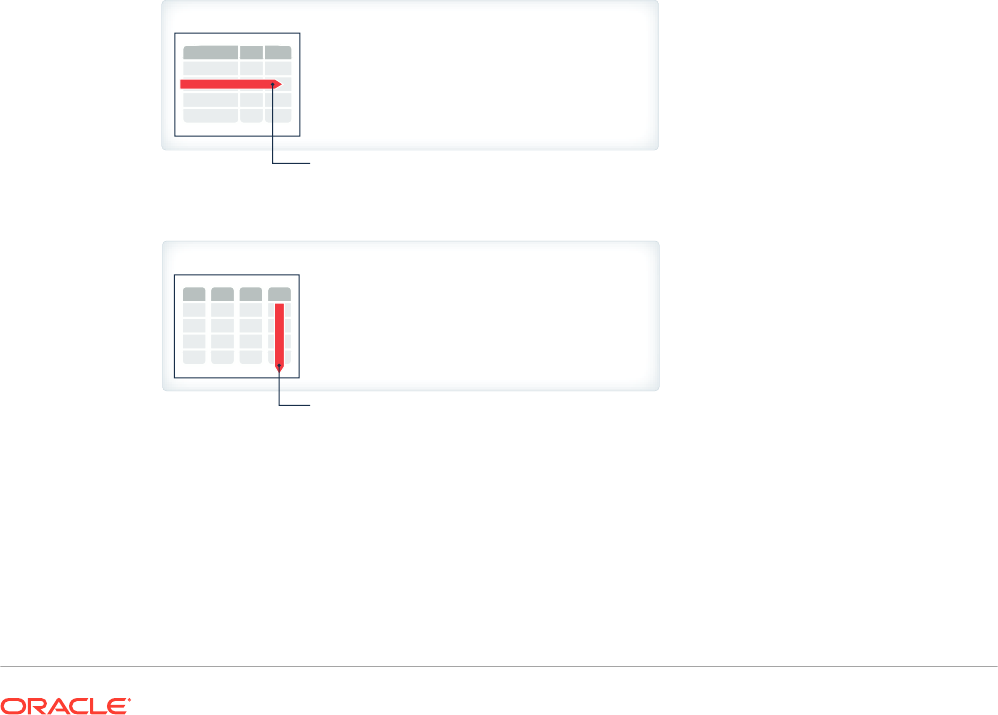
2
In-Memory Column Store Architecture
The In-Memory Column Store (IM column store) stores tables and partitions in memory using
a columnar format optimized for rapid scans. Oracle Database uses a sophisticated
architecture to manage data in columnar and row formats simultaneously.
2.1 Dual-Format: Column and Row
When you enable an IM column store, the SGA manages data in separate locations: the In-
Memory Area and the database buffer cache.
The IM column store encodes data in a columnar format: each column is a separate structure.
The columns are stored contiguously, which optimizes them for analytic queries. The database
buffer cache can modify objects that are also populated in the IM column store. However, the
buffer cache stores data in the traditional row format. Data blocks store the rows contiguously,
optimizing them for transactions.
The following figure illustrates the difference between row-based storage and columnar
storage.
Figure 2-1 Columnar and Row-Based Storage
Sales
Rows Stored Contiguously
Columns Stored Contiguously
Sales
Transactions run faster on row format
· Example: Query or Insert a sales order
· Fast processing few rows, many columns
Analytics run faster on column format
· Example: Report on sales totals by region
· Fast accessing few columns, many rows
Query
Query
2.1.1 Columnar Data in the In-Memory Area
The In-Memory Area is an optional SGA component that contains the IM column store.
2-1

2.1.1.1 Memory Pools in the In-Memory Area
The In-Memory Area is divided into subpools for columnar data and metadata.
These pools can be seen in the Example 2-1
• The columnar data pool
This subpool stores the IMCUs, which contain the columnar data. The
V$INMEMORY_AREA.POOL
column identifies this subpool as
1MB POOL
.
• The metadata pool
This subpool stores metadata about the objects that reside in the IM column store. The
V$INMEMORY_AREA.POOL
column identifies this subpool as
64KB POOL
.
• IM pool metadata
This subpool stores other specialized metadata structures which are not suitable to be
stored in the 64K POOL. It's listed as
IM POOL METADATA
in
V$INMEMORY_AREA.POOL
The database determines the relative size of the two subpools. It allocates the majority of
space in the In-Memory Area to the columnar data pool (1 MB pool).
Note:
Oracle Database automatically determines the subpool sizes. You cannot change the
space allocations.
Example 2-1 V$INMEMORY_AREA View
This example queries the
V$INMEMORY_AREA
view to determine the amount of available memory
in each subpool (sample output included):
SELECT pool, alloc_bytes, used_bytes, populate_status
FROM V$INMEMORY_AREA;
POOL ALLOC_BYTES USED_BYTES POPULATE_STATUS
1MB POOL 796,917,760 680,525,824 DONE
64KB POOL 25,165,824 4,128,768 DONE
IM POOL METADATA 16,777,216 16,777,216 DONE
The current size of the In-Memory area is visible in
V$SGA
:
SELECT name, value/(1024*1024*1024) "SIZE_IN_GB"
FROM V$SGA
WHERE NAME LIKE '%Mem%';
NAME SIZE_IN_GB
-------------------- ----------
In-Memory Area 10
In this example, you can see that the database uses a small percentage of memory for internal
management structures.
Chapter 2
Dual-Format: Column and Row
2-2

See Also:
Oracle Database Reference to learn about
V$INMEMORY_AREA
2.1.2 Row Data in the Database Buffer Cache
The database buffer cache stores and processes data blocks in the same way whether the IM
column store is enabled or disabled. Buffer I/O and buffer pools function the same.
The IM column store enables data to be simultaneously populated in the SGA in both the
traditional row format (the buffer cache) and the columnar format. The database transparently
sends OLTP queries (such as primary key lookups) to the buffer cache, and analytic and
reporting queries to the IM column store. When fetching data, Oracle Database can also read
data from both memory areas within the same query.
Note:
In the execution plan, the operation
TABLE ACCESS IN MEMORY FULL
indicates that
some or all data is accessed in the IM column store.
The dual-format architecture does not double memory requirements. The buffer cache is
optimized to run with a much smaller size than the size of the database.
The following figure shows a sample IM column store. The database stores the
sh.sales
table
on disk in traditional row format. The SGA stores the data in columnar format in the IM column
store, and in row format in the database buffer cache.
Chapter 2
Dual-Format: Column and Row
2-3
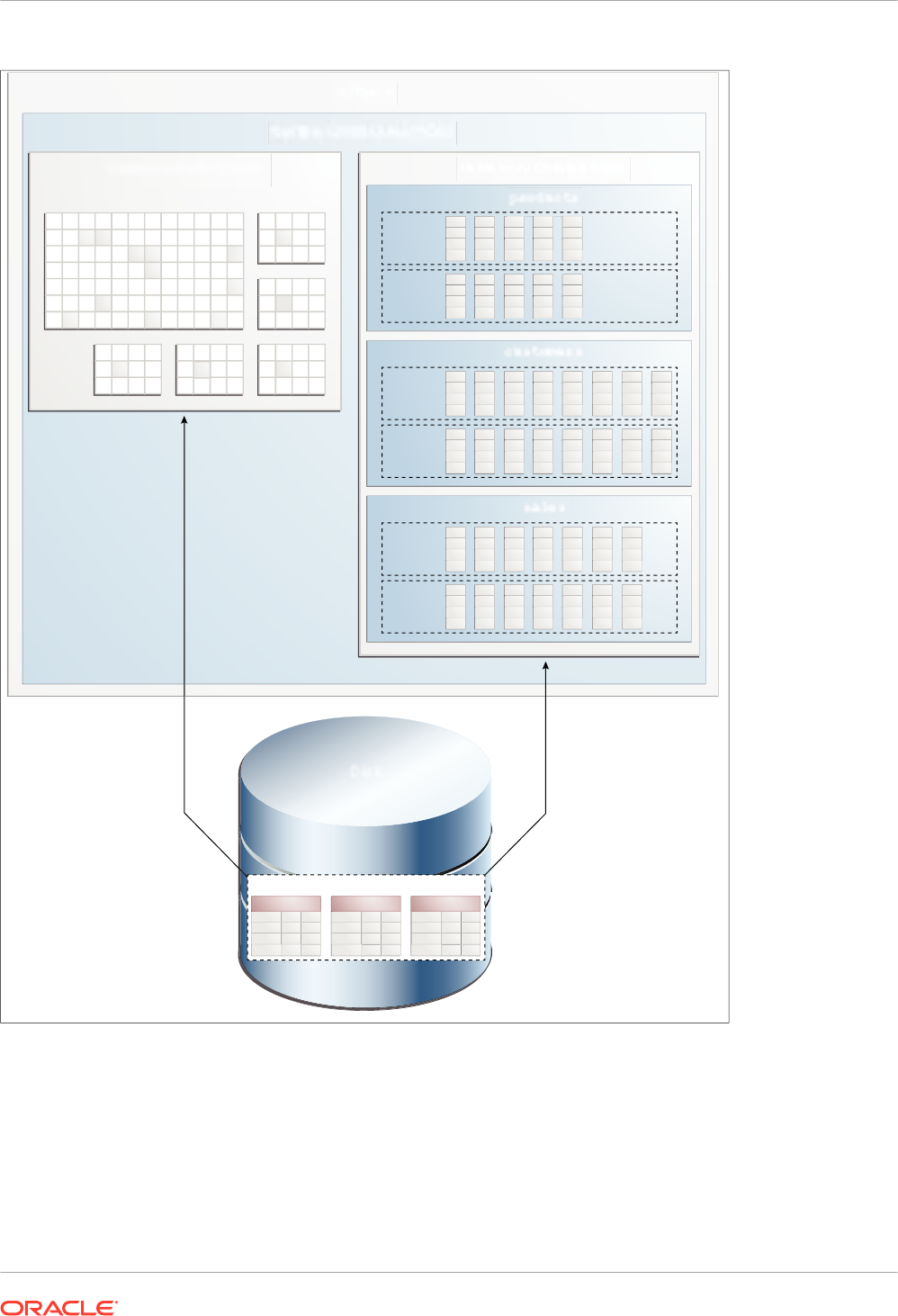
Figure 2-2 IM Column Store
Database Buffer Cache
System Global Area (SGA)
Instance
In-Memory Column Store
sales
customers
products
IMCU 1
IMCU 2
IMCU 3
IMCU 4
IMCU 5
IMCU 6
Disk
sh Schema
products
customers
sales
Every on-disk data format for permanent, heap-organized tables is supported by the IM column
store. The columnar format does not affect the format of data stored in data files or in the buffer
cache, nor does it affect undo data and online redo logging.
The database processes DML modifications in the same way, regardless of whether the IM
column store is enabled, by updating the buffer cache, online redo log, and undo tablespace.
However, the database uses an internal mechanism to track changes and ensure that the IM
column store is consistent with the rest of the database. For example, if the
sales
table is
Chapter 2
Dual-Format: Column and Row
2-4
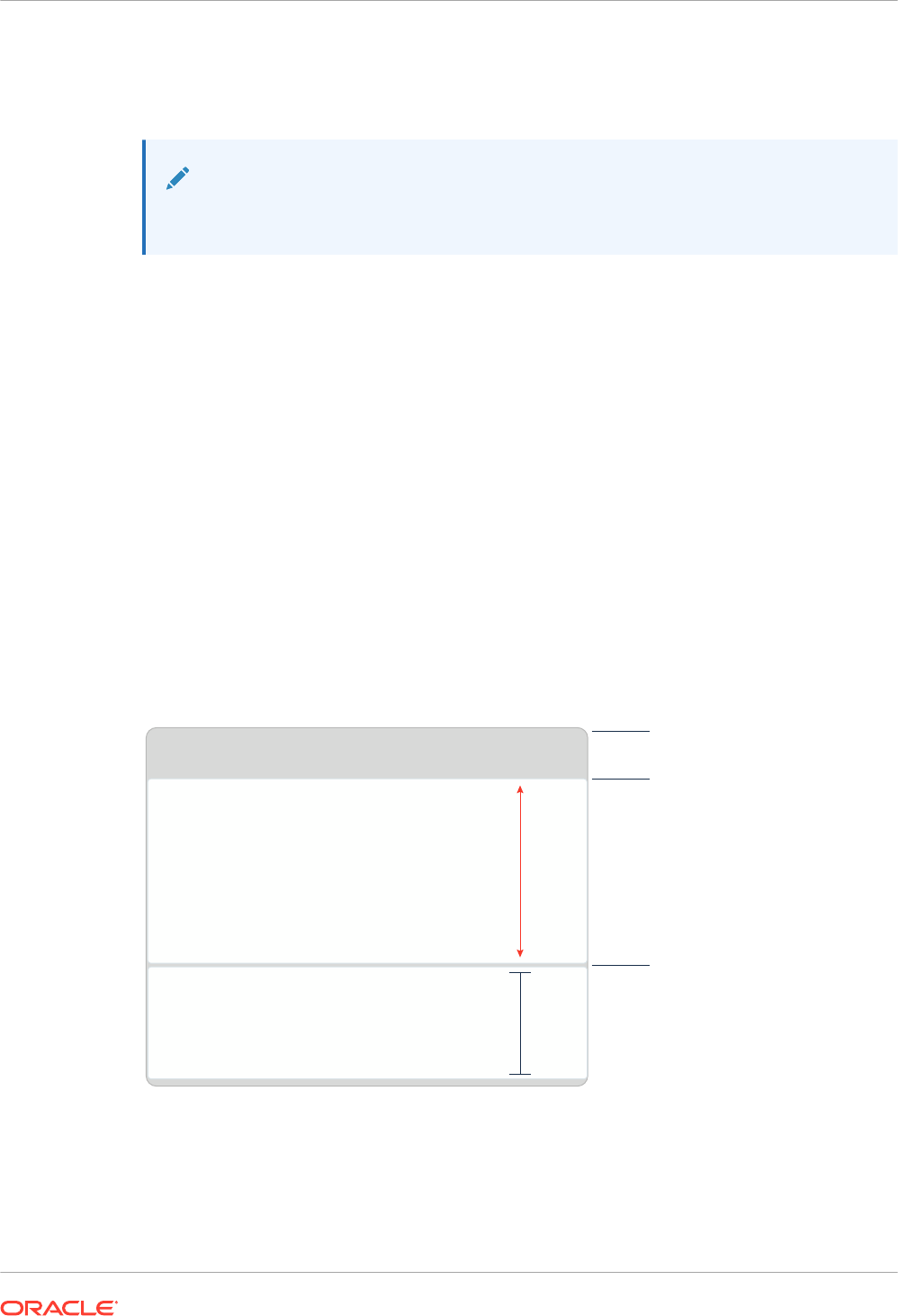
populated in the IM column store, and if an application updates a row in
sales
, then the
database automatically keeps the copy of the
sales
table in the IM column store
transactionally consistent. A query that accesses the IM column store always returns the same
results for a query that accesses the buffer cache.
See Also:
Oracle Database Concepts to learn more about the database buffer cache
2.2 Size of the In-Memory Area
The In-Memory Area within the System Global Area (SGA) for a database instance is
controlled by the
INMEMORY_SIZE
initialization parameter. By default, the size of the In-Memory
Area is 0, which means the IM column store is disabled. The In-Memory Area can also be
resized dynamically, either through automatic management or manually.
To enable the IM column store, set the In-Memory Area to a value greater than zero. The size
is shown in
V$SGA
.
The In-Memory Area and SGA_TARGET
The In-Memory Area is subtracted from the
SGA_TARGET
initialization parameter setting. For
example, if you set
SGA_TARGET
to 10 GB, and if you set the
INMEMORY_SIZE
to 4 GB, then 40%
of the
SGA_TARGET
setting is allocated to the In-Memory Area. The following graphic illustrates
the relationship.
Figure 2-3 INMEMORY_SIZE and SGA_TARGET
Unused
SGA
In-Memory Area
SGA_MAX_SIZE
SGA_TARGET
INMEMORY_SIZE
Dynamic
Static
As of Oracle Database 23ai when ASMM (Automatic Shared Memory Management) is
enabled, the In Memory Area is controlled by automatic memory management, like the other
components of the SGA, including the buffer cache and the shared pool. ASMM provides
dynamic resizing of the physical In-Memory column store based on the workload.
Chapter 2
Size of the In-Memory Area
2-5

Automatic memory management requires that AIM (Automatic In-Memory) level is set to
MEDIUM
or
HIGH
. Use the
INMEMORY_SIZE
parameter to set the minimum size of the IM column
store.
If ASMM is not enabled, then the In-Memory Area size is not controlled by automatic memory
management. The database does not automatically shrink the In-Memory Area when the buffer
cache or shared pool requires more memory, or increase the In-Memory Area when it runs out
of space. In this case, you can change the physical size of the column store by increasing or
decreasing the value of
INMEMORY_SIZE
before instance startup. This parameter can also be
dynamically modified during runtime at the CDB and PDB levels.
2.3 In-Memory Storage Units
The IM column store manages both data and metadata in optimized storage units, not in
traditional Oracle data blocks.
Oracle Database maintains the storage units in the In-Memory Area. The following graphic
gives an overview of the In-Memory Area and the database processes that interact with it. The
remaining chapter describes the various memory components.
Chapter 2
In-Memory Storage Units
2-6
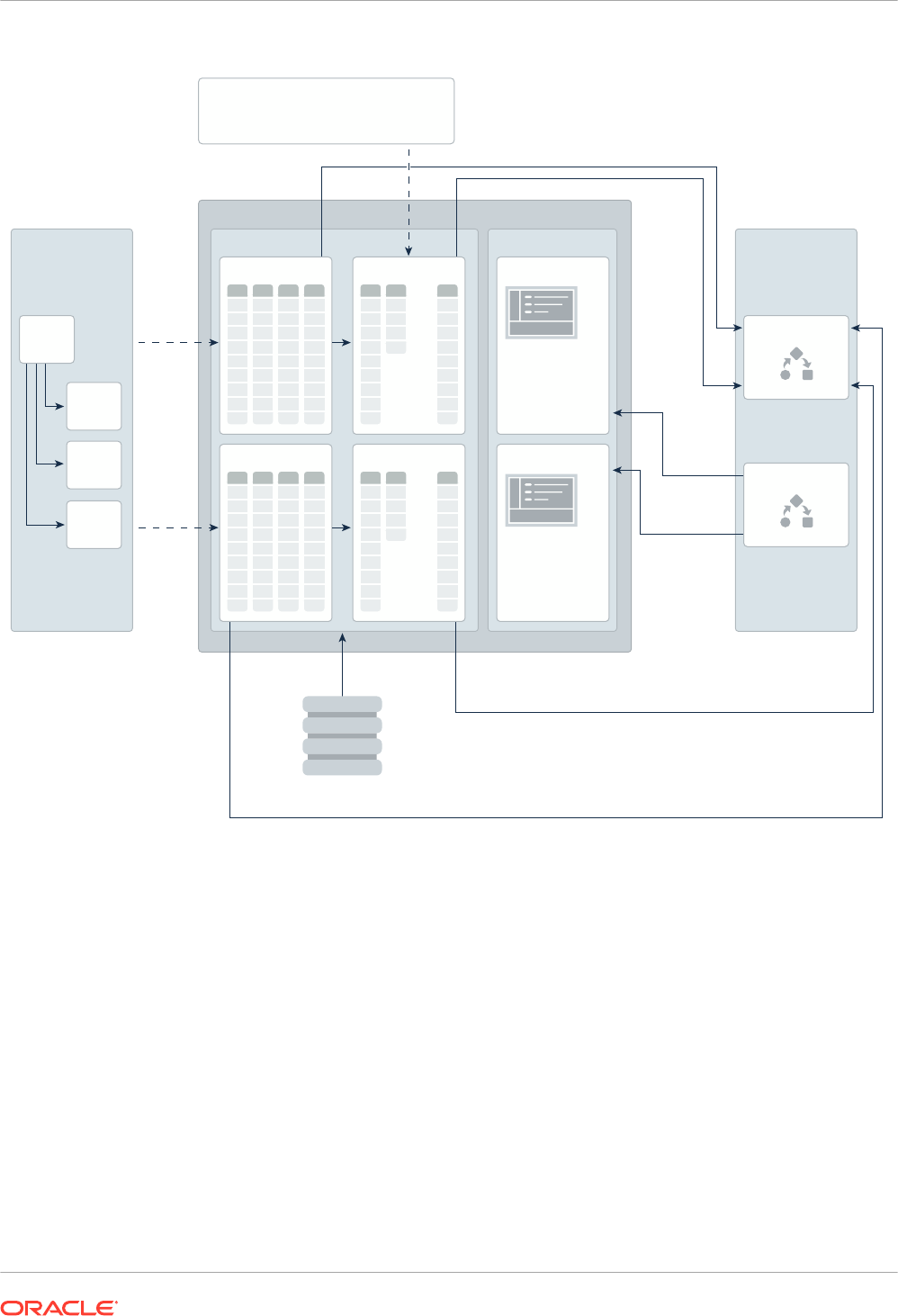
Figure 2-4 IM Column Store: Memory and Process Architecture
In-Memory Area
IMCU
IMCU
IMEU
IMEU
Database
In-Memory
Area
Columnar Data
SMU
SMU
Metadata
w000
w001
w002
Background
Processes
Scans
Scans
Scans
Invalidations
Populate
Populate
IMCO
Foreground
Processes
Queries
Expression Statistics Store (ESS)
and
User-Defined Virtual Columns
DML
2.3.1 In-Memory Compression Units (IMCUs)
An In-Memory Compression Unit (IMCU) is a compressed, read-only storage unit that
contains data for one or more columns.
An IMCU is analogous to a tablespace extent. An IMCU has two parts: a set of Column
Compression Units (CUs), and a header that contains metadata such as the IM storage index.
2.3.1.1 IMCUs and Schema Objects
The IM column store stores data for a single object (table, partition, materialized view) in a set
of IMCUs. An IMCU stores columnar data for one and only one object.
Chapter 2
In-Memory Storage Units
2-7

2.3.1.1.1 IMCUs and INMEMORY Columns
For an object specified as
INMEMORY
, every column listed in the
INMEMORY
clause is included in
every IMCU.
For example, the
sh.sales
table has 7 columns. The following DDL statement specifies the
table as
INMEMORY
, which means that every IMCU for
sales
includes columnar data for these 7
columns:
ALTER TABLE sh.sales INMEMORY MEMCOMPRESS FOR QUERY LOW;
NO INMEMORY Columns in INMEMORY Objects
You can specify that some but not all columns in an
INMEMORY
table have the
INMEMORY
attribute. For example, the
sh.customers
table has 23 columns. The following DDL statement
specifies that 15 columns in
sh.customers
have the
NO INMEMORY
attribute, which means that
the other 8 columns in the table have the
INMEMORY
attribute:
ALTER TABLE sh.customers INMEMORY
MEMCOMPRESS FOR QUERY LOW
NO INMEMORY ( cust_gender, cust_year_of_birth, cust_marital_status,
cust_postal_code, cust_city, cust_state_province,
cust_main_phone_number, cust_income_level, cust_credit_limit,
cust_email, cust_total, cust_total_id, cust_eff_from,
cust_eff_to, cust_valid );
The following query shows the compression levels of the columns in
sh.customers
, indicating
which columns are
NO INMEMORY
:
SET LINESIZE 200
COL TABLE_NAME FORMAT a25
COL SEG_COL_ID FORMAT 999
COL COLUMN_NAME FORMAT a25
COL INMEMORY_COMPRESSION FORMAT a11
SELECT SEGMENT_COLUMN_ID AS "SEG_COL_ID", COLUMN_NAME, INMEMORY_COMPRESSION
FROM V$IM_COLUMN_LEVEL WHERE TABLE_NAME = 'CUSTOMERS'
ORDER BY SEG_COL_ID;
SEG_COL_ID COLUMN_NAME INMEMORY_CO
---------- ------------------------- -----------
1 CUST_ID DEFAULT
2 CUST_FIRST_NAME DEFAULT
3 CUST_LAST_NAME DEFAULT
4 CUST_GENDER NO INMEMORY
5 CUST_YEAR_OF_BIRTH NO INMEMORY
6 CUST_MARITAL_STATUS NO INMEMORY
7 CUST_STREET_ADDRESS DEFAULT
8 CUST_POSTAL_CODE NO INMEMORY
9 CUST_CITY NO INMEMORY
10 CUST_CITY_ID DEFAULT
11 CUST_STATE_PROVINCE NO INMEMORY
12 CUST_STATE_PROVINCE_ID DEFAULT
13 COUNTRY_ID DEFAULT
14 CUST_MAIN_PHONE_NUMBER NO INMEMORY
Chapter 2
In-Memory Storage Units
2-8

15 CUST_INCOME_LEVEL NO INMEMORY
16 CUST_CREDIT_LIMIT NO INMEMORY
17 CUST_EMAIL NO INMEMORY
18 CUST_TOTAL NO INMEMORY
19 CUST_TOTAL_ID NO INMEMORY
20 CUST_SRC_ID DEFAULT
21 CUST_EFF_FROM NO INMEMORY
22 CUST_EFF_TO NO INMEMORY
23 CUST_VALID NO INMEMORY
The following graphic represents three tables from the
sh
schema populated in the IM column
store:
customers
,
products
, and
sales
. In this example, each table has a different number of
columns specified
INMEMORY
. The IMCUs for each table include only data for the
INMEMORY
columns.
Chapter 2
In-Memory Storage Units
2-9
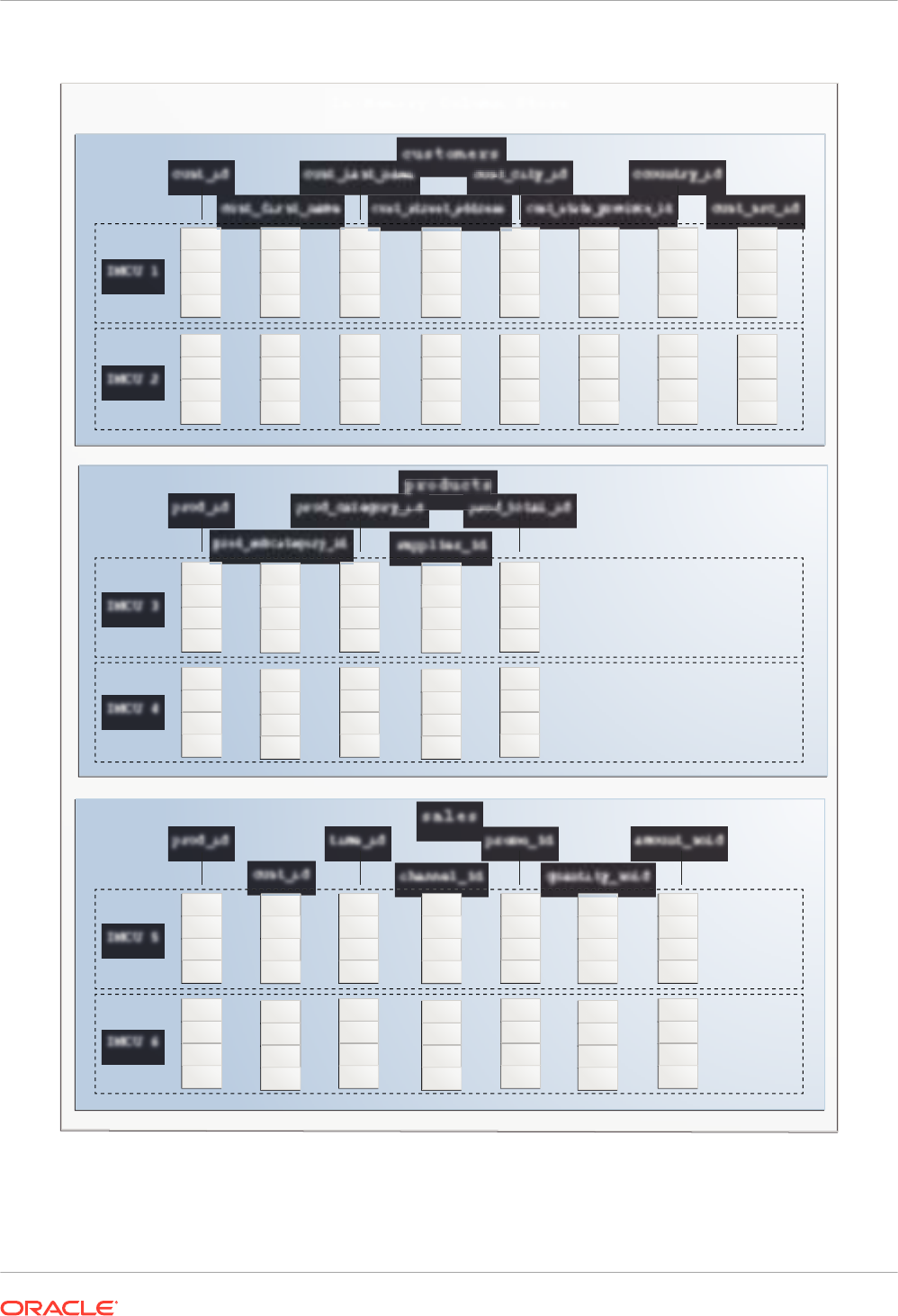
Figure 2-5 Columns and IMCUs
products
channel_id
sales
In-Memory Column Store
customers
cust_id ccountry_idcust_last_name cust_city_id
cust_first_name
cust_src_id
cust_street_address
cust_state_province_id
IMCU 1
IMCU 2
IMCU 3
IMCU 4
IMCU 5
IMCU 6
prod_id amount_soldtime_id
promo_id
cust_id
quantity_sold
prod_id
pr
prod_category_id prod_total_id
prod_subcategory_id
supplier_id
Chapter 2
In-Memory Storage Units
2-10

Queries That Reference NO INMEMORY Columns
When a query references a
NO INMEMORY
column, the table scan retrieves data from the row
store rather than the IMCUs in the IM column store. Row store access occurs even if all other
columns referenced in the query are populated
INMEMORY
columns.
For example, assume that the
customers
table is populated into the IM column store. The
cust_id
and
cust_last_name
columns are specified
INMEMORY
, but the
cust_postal_code
column is specified as
NO INMEMORY
. You issue the following query:
SELECT cust_id, cust_last_name, cust_postal_code
FROM customers
WHERE cust_id < 5001
ORDER BY cust_id;
In this case, the database accesses the row store, not the IM column store, even though
cust_postal_code
is the only
NO INMEMORY
column referenced in the query. The following
query, which has
cust_postal_code
in the predicate but not the
SELECT
list, must also access
the row store:
SELECT cust_id, cust_last_name
FROM customers
WHERE cust_postal_code = 77501
ORDER BY cust_id;
See Also:
• "About In-Memory Columns"
• https://blogs.oracle.com/in-memory/what-happens-if-a-column-is-not-populated
for a blog entry on accessing columns that are not populated in the IM column
store
• Oracle Database SQL Language Reference to learn about the
ALTER TABLE
statement
2.3.1.1.2 In-Memory Compression
The IM column store uses special compression formats optimized for access speed rather than
storage reduction. The columnar format enables queries to execute directly against the
compressed columns.
Compression enables scanning and filtering operations to process a much smaller amount of
data, which optimizes query performance. Oracle Database only decompresses data when it is
required for the result set.
The compression applied in the IM column store is closely related to Hybrid Columnar
Compression. Both technologies process column vectors. The primary difference is that the
column vectors for the IM column store are optimized for SIMD vector processing, whereas the
column vectors for Hybrid Columnar Compression are optimized for disk storage.
When you manually enable an object for population into the IM column store, you specify the
type of compression in the
INMEMORY MEMCOMPRESS
clause:
FOR DML
,
FOR QUERY
(
LOW
or
HIGH
),
Chapter 2
In-Memory Storage Units
2-11

FOR CAPACITY
(
LOW
or
HIGH
), or
NONE
. When
INMEMORY_AUTOMATIC_LEVEL
is
HIGH
, the database
automatically applies
MEMCOMPRESS AUTO
to all objects.
See Also:
• "Controls for In-Memory Objects"
• "Configuring Automatic In-Memory"
• Oracle Database Concepts to learn more about Hybrid Columnar Compression
2.3.1.1.3 IMCUs and Rows
Each IMCU contains all column values (including nulls) for a subset of rows in a table segment.
A subset of rows is called a granule.
All IMCUs for a given segment contain approximately the same number of rows. Oracle
Database determines the size of a granule automatically depending on data type, data format,
and compression type. A higher compression level results in more rows in the IMCU.
A one-to-many mapping exists between an IMCU and a set of database blocks. As illustrated
in Example 2-2, each IMCU stores the values for columns for a different set of blocks.
The columns in an IMCU are not sorted. Oracle Database populates them in the order that
they are read from disk.
The number of rows in an IMCU dictates the amount of space an IMCU consumes. If the target
number of rows causes an IMCU to grow beyond the amount of contiguous 1 MB extents
available in the 1 MB pool, then the IMCU creates additional extents (pieces) to hold the
remaining column CUs. An IMCU always allocates space in 1 MB increments.
Example 2-2 IMCUs and Row Subsets
In this simplified example, only the following 4 columns of the
customers
table have the
INMEMORY
attribute:
cust_id
,
cust_first_name
,
cust_last_name
, and
cust_gender
. Only 5
rows exist in the table, stored in 2 data blocks. Conceptually, the first data block stores its rows
as follows:
82,Madeline,Li,F;37004,Abel,Embrey,M;1714,Hardy,Gentle,M
The second data block stores rows as follows:
100439,Uma,Campbell,F;3047,Lucia,Downey,F
Assume IMCU 1 stores the data for the first data block. In this case, the
cust_id
column
values for the 3 rows in this data block stores are stored “vertically” within a CU as follows:
82
37004
1714
Chapter 2
In-Memory Storage Units
2-12

IMCU 2 stores the data from the second data block. The
cust_id
column values for these 2
rows are stored within a CU as follows:
100439
3047
Because the
cust_id
value is the first value for each row in the data block, the
cust_id
column
is in the first position within the IMCU. Columns always occupy the same position, so Oracle
Database can reconstruct the rows by reading the IMCUs for a segment.
Related Topics
• Controls for In-Memory Objects
You can enable tablespaces, tables (internal and external), partitions, and materialized
views for In-Memory access. You can also specify options such as compression and
population priority.
2.3.1.2 Column Compression Units (CUs)
A Column Compression Unit (CU) is contiguous storage for a single column in an IMCU.
Every IMCU has one or more CUs.
2.3.1.2.1 Structure of a CU
A CU is divided into a body and a header.
The body of every CU stores the column values for the range of rows included in the IMCU.
The header contains metadata about the values stored in the CU body, for example, the
minimum and maximum value within the CU. It may also contain a local dictionary, which is a
sorted list of the distinct values in that column and their corresponding dictionary codes.
The following figure shows an IMCU with 4 CUs for the
sales
table:
prod_id
,
cust_id
,
time_id
, and
channel_id
. Each CU stores the column values for the range of rows included in
the IMCU.
Chapter 2
In-Memory Storage Units
2-13
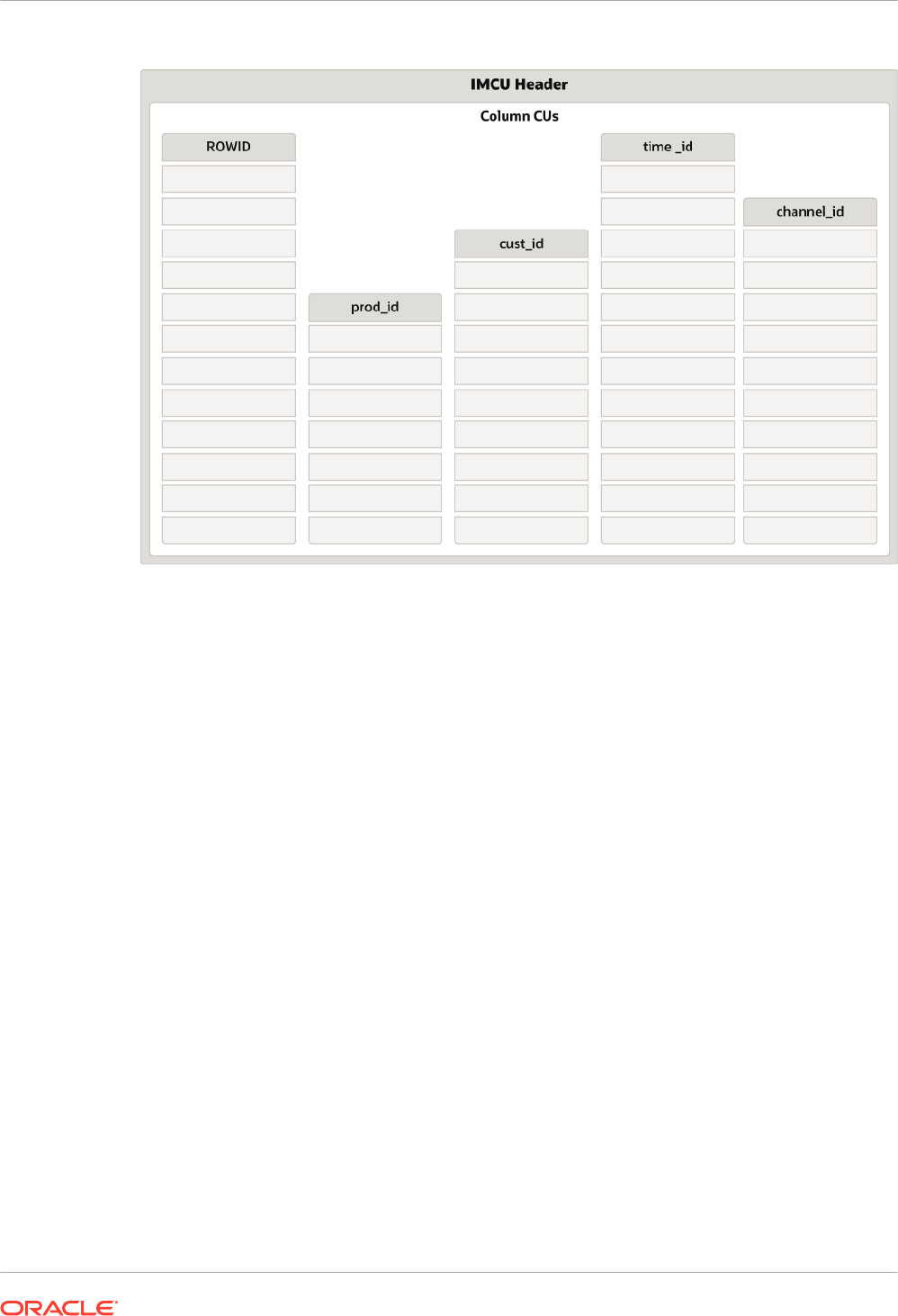
Figure 2-6 CUs in an IMCU
The CUs store values in rowid order. For this reason, the database can answer queries by
“stitching” the rows back together. For example, an application issues the following query:
SELECT cust_id, time_id, channel_id
FROM sales
WHERE prod_id =5;
The database begins by scanning the
prod_id
column for entries with the value
5
. Assume that
the database finds
5
in position two in the
prod_id
column. The database now must find the
corresponding
cust_id
,
time_id
, and
channel_id
for this row. Because the CUs store data in
rowid order, the database can find the corresponding
cust_id
,
time_id
, and
channel_id
values in position 2 in those columns. Thus, to answer the query, the database must extract the
values from position 2 in the
cust_id
,
time_id
, and
channel_id
columns, and then stitch the
row back together to return it to the end user.
2.3.1.2.2 Local Dictionary
In a CU, the local dictionary has a list of distinct values and their corresponding dictionary
codes.
The local dictionary stores the symbol contained in the column. The following figure illustrates
how a CU stores a
name
column in a
vehicles
table.
Chapter 2
In-Memory Storage Units
2-14

Figure 2-7 Local Dictionary
0
2
2
1
2
0
0
Audi
Cadillac
Cadillac
BMW
Cadillac
Audi
Audi
Column CU
Min: Audi
Max: Cadillac
Value ID
Audi 0
BMW 1
Cadillac 2
In the preceding figure, the CU contains only 7 rows. Every distinct value in this CU, such as
Cadillac
or
Audi
, is assigned a different dictionary code, such as
2
for
Cadillac
and
0
for
Audi
. The CU stores the dictionary code rather than the original value.
Note:
When the database uses a common dictionary for a join group, the local dictionary
contains references to the common dictionary rather than the symbols. For example,
rather than storing the values
Audi
,
BWM
, and
Cadillac
for the
vehicles.name
column, the local dictionary stores dictionary codes such as
101
,
220
, and
66
.
The CU header contains the minimum and maximum values for the column. In this example,
the minimum value is
Audi
and the maximum value is
Cadillac
. The local dictionary stores the
list of distinct values:
Audi
,
BMW
, and
Cadillac
. Their corresponding dictionary codes (
0
,
1
, and
2
) are implicit. The local dictionary for a CU in each IMCU is independent of the local
dictionaries in other IMCUs.
If a query filters on Audi automobiles, then the database scans this IMCU for only
0
codes.
Related Topics
• How a Join Group Uses a Common Dictionary
A common dictionary is a table-level set of dictionary codes.
See Also:
"How a Join Group Uses a Common Dictionary"
2.3.1.3 In-Memory Storage Indexes
Every IMCU header automatically creates and manages In-Memory Storage Indexes (IM
storage indexes) for its CUs. An IM storage index stores the minimum and maximum for all
columns within the IMCU.
Chapter 2
In-Memory Storage Units
2-15

For example,
sales
is populated in the IM column store. Every IMCU for this table has all
columns. The
sales.prod_id
column is stored in a separate CU within every IMCU. The IMCU
header has the minimum and maximum values of each
prod_id
CU (and every other CU).
To eliminate unnecessary scans, the database can perform IMCU pruning based on SQL filter
predicates. The database scans only the IMCUs that satisfy the query predicate, as shown in
the
WHERE prod_id > 14 AND prod_id < 29
example in the following graphic.
Figure 2-8 Storage Index for Columnar Data
15
16
17
18
19
20
21
1
min 1, max 7
prod_id
min 8, max 14
2
3
4
5
6
7
22
23
24
25
26
27
28
8
9
10
11
12
13
14
IMCU 1
IMCU 2
min 15, max 21
IMCU 3
min 22, max 28
IMCU 4
Chapter 2
In-Memory Storage Units
2-16

2.3.2 Snapshot Metadata Units (SMUs)
A Snapshot Metadata Unit (SMU) contains metadata and transactional information for an
associated IMCU.
2.3.2.1 IMCUs and SMUs
The columnar pool of the In-Memory Area stores the actual data: IMCUs and IMEUs. The
metadata pool in the In-Memory Area stores the SMUs.
Figure 2-9 IMCUs and SMUs
This figure shows IMCUs in the data pool, and SMUs in the metadata pool.
SGA
In-Memory Area
IMCU
IMCU
IMCU
IMCU
Columnar Data
Metadata
IMCU Pool
SMU
SMU Pool
SMU
SMU
SMU
Every IMCU maps to a separate SMU. Thus, if the columnar data pool contains 100 IMCUs,
then the metadata pool contains 100 SMUs. The SMUs store several types of metadata for
their associated IMCUs, including the following:
• Object numbers
• Column numbers
• Mapping information for rows
2.3.2.2 Transaction Journal
Every SMU contains a transaction journal. The database uses the transaction journal to keep
the IMCU transactionally consistent.
Chapter 2
In-Memory Storage Units
2-17

The database uses the buffer cache to process DML, just as when the IM column store is not
enabled. For example, an
UPDATE
statement might modify a row in an IMCU. In this case, the
database adds the rowid for the modified row to the transaction journal and marks it stale as of
the SCN of the DML statement. If a query needs to access the new version of the row, then the
database obtains the row from the database buffer cache.
Figure 2-10 Transaction Journal
In-Memory Area
IMCU
Columnar Format
Data
Metadata
SMU
ROW_ID:123765490
Journal
The database achieves read consistency by merging the contents of the column, transaction
journal, and buffer cache. When the IMCU is refreshed during repopulation, queries can
access the up-to-date row directly from the IMCU.
See Also:
"Optimizing Repopulation of the IM Column Store" for an in-depth discussion of how
the IM column store maintains transactional consistency
2.3.3 In-Memory Expression Units (IMEUs)
An In-Memory Expression Unit (IMEU) is a storage container for materialized In-Memory
Expressions (IM expressions) and user-defined virtual columns.
The database treats materialized expressions just like other columns in the IMCU.
Conceptually, an IMEU is a logical extension of its parent IMCU. Just as an IMCU can contain
multiple columns, an IMEU can contain multiple virtual columns.
Every IMEU maps to exactly one IMCU, mapping to the same row set. The IMEU contains
expression results for the data contained in its associated IMCU. When the IMCU is populated,
the associated IMEU is also populated.
A typical IM expression involves one or more columns, possibly with constants, and has a one-
to-one mapping with the rows in the table. For example, an IMCU for an
employees
table
contains rows 1–1000 for the column
weekly_salary
. For the rows stored in this IMCU, the
IMEU calculates the automatically detected IM expression
weekly_salary*52
, and the user-
Chapter 2
In-Memory Storage Units
2-18

defined virtual column
quarterly_salary
defined as
weekly_salary*12
. The 3rd row down in
the IMCU maps to the 3rd row down in the IMEU.
The IMEU is a logical extension of the IMCUs of a particular segment. By default, the IMEU
inherits the
INMEMORY
clause properties, including Oracle Real Application Clusters (Oracle
RAC) properties such as
DISTRIBUTE
and
DUPLICATE
, from the base segment. You can
selectively enable or disable virtual columns for storage in IMEUs. You can also specify
compression levels for different columns.
Related Topics
• About In-Memory Columns
For internal tables, both In-Memory virtual columns (IM virtual columns) and nonvirtual
columns are eligible for IM population. For external tables, only nonvirtual columns are
eligible.
• In-Memory Views
This topic describes data dictionary and dynamic performance views related to the In-
Memory Column Store (IM column store).
2.4 Expression Statistics Store (ESS)
The Expression Statistics Store (ESS) is a repository maintained by the optimizer to store
statistics about expression evaluation. The ESS resides in the SGA and persists on disk.
When an IM column store is enabled, the database leverages the ESS for its In-Memory
Expressions (IM expressions) feature. However, the ESS is independent of the IM column
store. The ESS is a permanent component of the database and cannot be disabled.
The database uses the ESS to determine whether an expression is “hot” (frequently
accessed), and thus a candidate for an IM expression. During a hard parse of a query, the ESS
looks for active expressions in the
SELECT
list,
WHERE
clause,
GROUP BY
clause, and so on.
For each segment, the ESS maintains expression statistics such as the following:
• Frequency of execution
• Cost of evaluation
• Timestamp evaluation
The optimizer assigns each expression a weighted score based on cost and the number of
times it was evaluated. The values are approximate rather than exact. More active expressions
have higher scores. The ESS maintains an internal list of the most frequently accessed
expressions.
Control the behavior of IM expressions using the
DBMS_INMEMORY_ADMIN
package. For example,
the
IME_CAPTURE_EXPRESSIONS
procedure prompts the database to identify and gradually
populate the hottest expressions in the database. The
IME_POPULATE_EXPRESSIONS
procedure
forces the database to populate the expressions immediately.
ESS information is stored in the data dictionary and exposed in the
DBA_EXPRESSION_STATISTICS
view. This view shows the metadata that the optimizer has
collected in the ESS. IM expressions are exposed as system-generated virtual columns,
prefixed by the string
SYS_IME
, in the
DBA_IM_EXPRESSIONS
view.
Chapter 2
Expression Statistics Store (ESS)
2-19

See Also:
• "About IM Expressions"
• Oracle Database SQL Tuning Guide to learn more about ESS
• Oracle Database Reference to learn more about the
DBA_EXPRESSION_STATISTICS
view
• Oracle Database PL/SQL Packages and Types Reference to learn more about
the
DBMS_INMEMORY_ADMIN
package
2.5 In-Memory Process Architecture
In response to queries and DML, server processes scan columnar data and update SMU
metadata. Background processes populate row data from disk into the IM column store.
2.5.1 In-Memory Coordinator Process (IMCO)
The In-Memory Coordinator Process (IMCO) manages many tasks for the IM column store. Its
primary task is to initiate background population and repopulation of columnar data.
Population is a streaming mechanism, converting row data into columnar format, and then
compressing it. IMCO automatically initiates population of
INMEMORY
objects with any priority
other than
NONE
. When objects with priority
NONE
are accessed, IMCO populates them using
Space Management Worker Process (Wnnn) processes.
The IMCO background process also initiates threshold-based repopulation of IM column store
objects when they meet a staleness threshold. IMCO may instigate trickle repopulation for any
IMCU in the IM column store that has stale entries but does not meet the staleness threshold.
Trickle repopulation occurs automatically in the background. The steps are as follows:
1. IMCO wakes up.
2. IMCO determines whether population tasks need to be performed, including whether any
stale entries exist in an IMCU.
3. If IMCO finds stale entries, then it triggers a Space Management Worker Process to
repopulate these entries in the IMCU.
4. IMCO sleeps for two minutes, and then returns to Step 1.
See Also:
• "Optimizing Repopulation of the IM Column Store"
• Oracle Database Reference to learn more about background processes
2.5.2 Space Management Worker Processes (Wnnn)
Space Management Worker Processes (Wnnn) populate or repopulate data on behalf of
IMCO.
Chapter 2
In-Memory Process Architecture
2-20

During population, Wnnn processes are responsible for creating IMCUs, SMUs, and IMEUs.
When creating IMEUs, the worker processes perform the following tasks:
• Identify virtual columns for population
• Create virtual column values
• Compute values for each row, transform the data into columnar format, and compress it
• Register the objects with the space layer
• Associate the IMEUs with their corresponding IMCUs
Note:
During IMEU creation, parent IMCUs remain available for queries.
During repopulation, the Wnnn processes create new versions of the IMCUs based on the
existing IMCUs and transactions journals, while temporarily retaining the old versions. This
mechanism is called double buffering.
The database can quickly move IM expressions in and out of the IM column store. For
example, if an IMCU was created without an IMEU, then the database can add an IMEU later
without forcing the IMCU to undergo the full repopulation mechanism.
The
INMEMORY_MAX_POPULATE_SERVERS
initialization parameter controls the maximum number
of worker processes that can be started for population. The
INMEMORY_TRICKLE_REPOPULATE_PERCENT
initialization parameter controls the maximum
percentage of time that worker processes can perform trickle repopulation.
See Also:
• "About Manually Enabling Objects for In-Memory Population"
• "About Repopulation of the IM Column Store"
• "In-Memory Initialization Parameters"
• Oracle Database Reference to learn more about background processes
2.5.3 In-Memory Dynamic Scans
In-Memory Dynamic Scans (IM dynamic scans) use lightweight threads to parallelize In-
Memory table scans.
2.5.3.1 Purpose of IM Dynamic Scans
When additional CPU is available, IM dynamic scans accelerate In-Memory table scans that
are CPU bound.
IM dynamic scans automatically use idle CPU resources to scan IMCUs in parallel and
maximize CPU usage. When CPU resources are available, applications can get even faster
analytic query results automatically. Because the scans are dynamic, they enable the use of
excess CPU bandwidth without affecting existing workload.
Chapter 2
In-Memory Process Architecture
2-21

IM dynamic scans are more flexible than traditional Oracle parallel execution, although the two
are not mutually exclusive. Dynamic scans use multiple lightweight threads of execution within
a process. Typically, the performance overhead for dynamic scans is low.
See Also:
Oracle Database Administrator’s Guide to learn more about Resource Manager
2.5.3.2 How IM Dynamic Scans Work
IM Dynamic Scans attain optimal performance by reading IMCUs in parallel.
2.5.3.2.1 About Lightweight Threads
A lightweight thread is an execution entity that helps to parallelize full table scans. It is
“lightweight” because it does not incur the higher memory overhead of Oracle processes.
Note:
A lightweight thread used by IM dynamic scans is not the same as a regular thread in
the multithreaded Oracle Database model.
Lightweight threads share the resources of the parent foreground or PQ process, called the
table scan process, that coordinates the scan of a set of IMCUs. Threads maintain their own
independent flow of execution. The database can parallelize scans by prioritizing threads and
executing them asynchronously.
For eligible queries, the process allocates a pool of threads. Resource Manager automatically
determines the number of threads in the pool based on the CPU count in the database host
and the current load on the system. The pool of threads remains available to the session for
subsequent queries unless the idle time reaches an internal threshold, at which point the
database terminates the threads.
Communication between threads occurs exclusively within a process. For this reason,
contention does not occur at the database instance level.
See Also:
Oracle Database Concepts to learn about the multithreaded Oracle Database model
2.5.3.2.2 When the Database Considers IM Dynamic Scans
Lightweight threads are enabled when a CPU resource plan is enabled (for example,
RESOURCE_MANAGER_PLAN=DEFAULT_PLAN
) and CPU utilization of the database is low.
If lightweight threads are enabled, then the database considers an IM dynamic scan when an
application queries an object that is currently populated in the IM column store. Typically, a
serial or parallel query is a candidate for IM dynamic scans when it has the following
characteristics:
Chapter 2
In-Memory Process Architecture
2-22

• Accesses a high number of IMCUs or columns
• Consumes all rows in the table
• Is CPU-intensive
Oracle Database Resource Manager (the Resource Manager), which is automatically enabled
when
INMEMORY_SIZE
is greater than
0
, is required for IM dynamic scans. The Resource
Manager decides when and how to use the lightweight threads. Lightweight threads are the
lowest priority operation in the database because they are capitalizing on unused resources.
Note:
CPU_COUNT
must be greater than or equal to
24
in order to perform IM dynamic scans.
2.5.3.2.3 How IM Dynamic Scans Work
Resource Manager allocates lightweight threads to parallelize the scan of IMCUs.
When the database determines that a query can benefit from an IM dynamic scan, it typically
proceeds as follows:
1. A table scan process spawns a pool of lightweight threads.
2. The table scan process creates a separate task for every IMCU that must be scanned, and
then adds each task to a task queue.
3. Resource Manager determines how many threads can participate in the table scan.
4. Active threads pick up tasks from the task queue, with the table scan process consuming
results from completed tasks.
Depending on the database load, Resource Manager continuously adjusts the number of
active lightweight threads while the query is running. If CPU resources are not available, then
the table scan process performs the scan without using lightweight threads.
The following graphic illustrates an IM dynamic scan of 12 IMCUs in the
sales
table.
Chapter 2
In-Memory Process Architecture
2-23
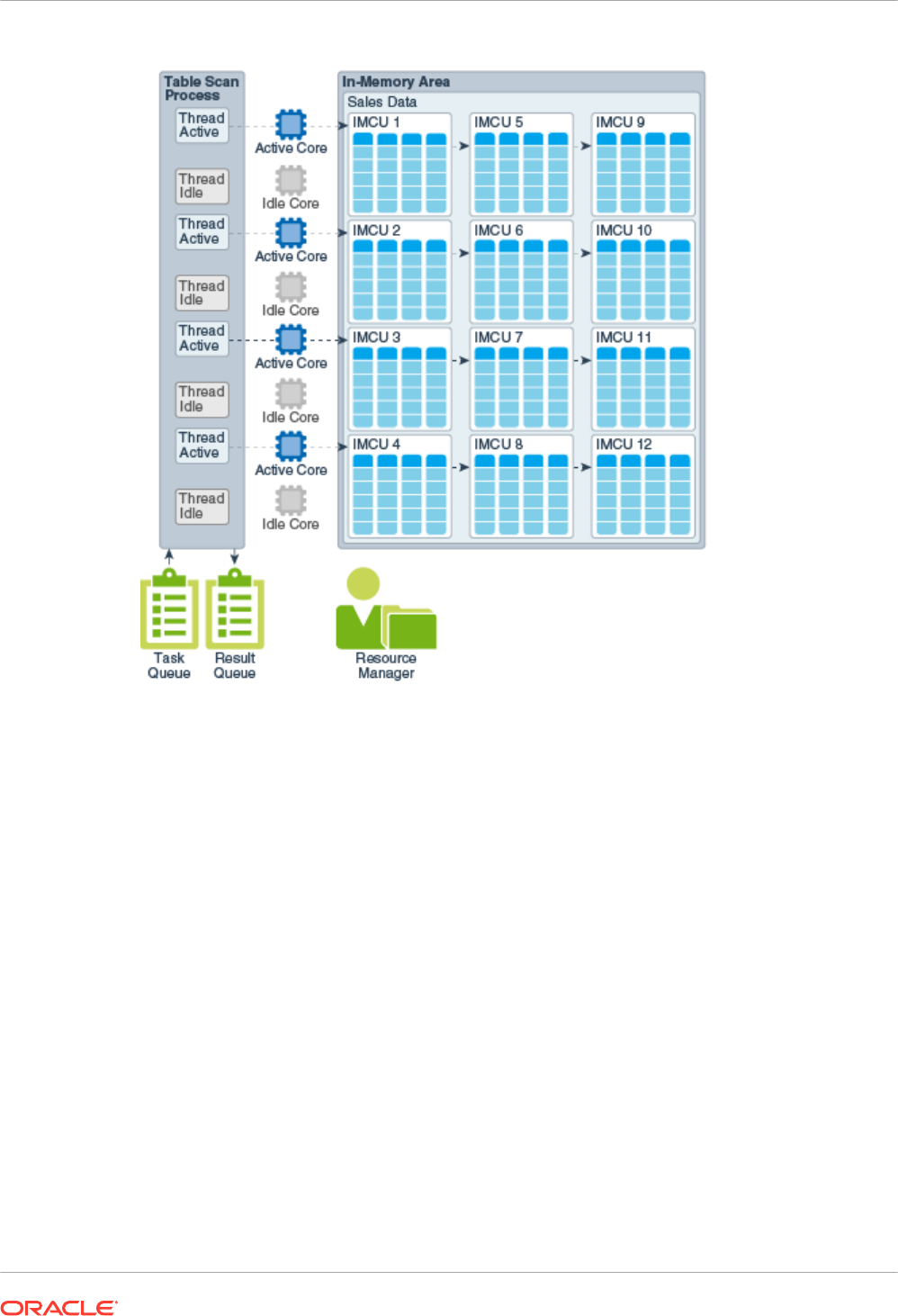
Figure 2-11 IM Dynamic Scan
In the preceding graphic, the database host has 8 CPU cores. Based on an internal algorithm,
Resource Manager assigns 4 threads to assist the table scan process. In this scenario, 4 CPU
cores remain idle for other concurrent database operations to use.
2.5.3.3 Interface for IM Dynamic Scans
IM dynamic scans are transparent, which means that they require no application changes and
are automatically controlled by the Resource Manager.
IM dynamic scans require the Resource Manager, which is automatically enabled when
INMEMORY_SIZE
is greater than
0
. No specific resource plan is required.
Several new session statistics track the usage of IM dynamic scans. Each thread writes trace
data to a separate trace file.
Execution plans are unchanged. The following figure shows a sample execution plan.
SQL> SELECT MAX(l_quantity) largest_order FROM lineitem;
LARGEST_ORDER
-------------
50
Elapsed: 00:00:03.41
Chapter 2
In-Memory Process Architecture
2-24

Execution Plan
----------------------------------------------------------
Plan hash value: 1885658499
-------------------------------------------------------------------------------------------
|Id| Operation | Name |Rows| Bytes |Cost(%CPU)| Time |Pstart| Pstop|
-------------------------------------------------------------------------------------------
|0| SELECT STATEMENT | | 1 | 3| 116K (4)| 00:00:05 | | |
|1| SORT AGGREGATE | | 1 | 3| | | | |
|2| PARTITION RANGE ALL | | 600M |1716M| 116K (4)| 00:00:05 | 1 | 84 |
|3| TABLE ACCESS INMEMORY FULL| LINEITEM | 600M |1716M| 116K (4)| 00:00:05 | 1 | 84 |
-------------------------------------------------------------------------------------------
NAME VALUE
-------------------------------------------------------
IM scan CUs memcompress for query low 1147
IM scan bytes in-memory 5.1790E+10
IM scan bytes uncompressed 7.6722E+10
IM scan CUs columns accessed 1147
IM scan rows 600037902
IM scan rows projected 29
IM scan (dynamic) rows 600037902
IM scan (dynamic) multi-threaded scans 1
IM scan (dynamic) tasks processed by thread 1146
Consider the characteristics of the plan:
1. The execution plan is unchanged.
Note that the plan does not mention IM dynamic scans in Step 3. However, clicking the
binocular icon in a SQL Monitor report would show “Dynamic Scan Tasks on Thread.”
2.
IM scan (dynamic) multi-threaded scans
is nonzero, which means that the database
used an IM dynamic scan.
3.
IM scan CUs memcompress for query low
indicates that 1147 IMCUs exist in the
lineitem
table.
4.
IM scan (dynamic) tasks processed by thread
indicates how many IMCUs were
processed in parallel.
The number is 1146, which is less than the total number of 1147 shown in
IM scan CUs
memcompress for query low
. The database analyzed the first IMCU without parallelization
to determine whether parallelization was worthwhile. Because the answer was yes, the
database proceeded to scan the remaining 1146 IMCUs in parallel.
5.
IM scan (dynamic) rows
and
IM scan rows are equal
, which means that the threads
retrieved all rows for the query.
See Also:
• Oracle Database Administrator’s Guide to learn more about the Resource
Manager
• Oracle Database Reference for descriptions of In-Memory statistics
Chapter 2
In-Memory Process Architecture
2-25
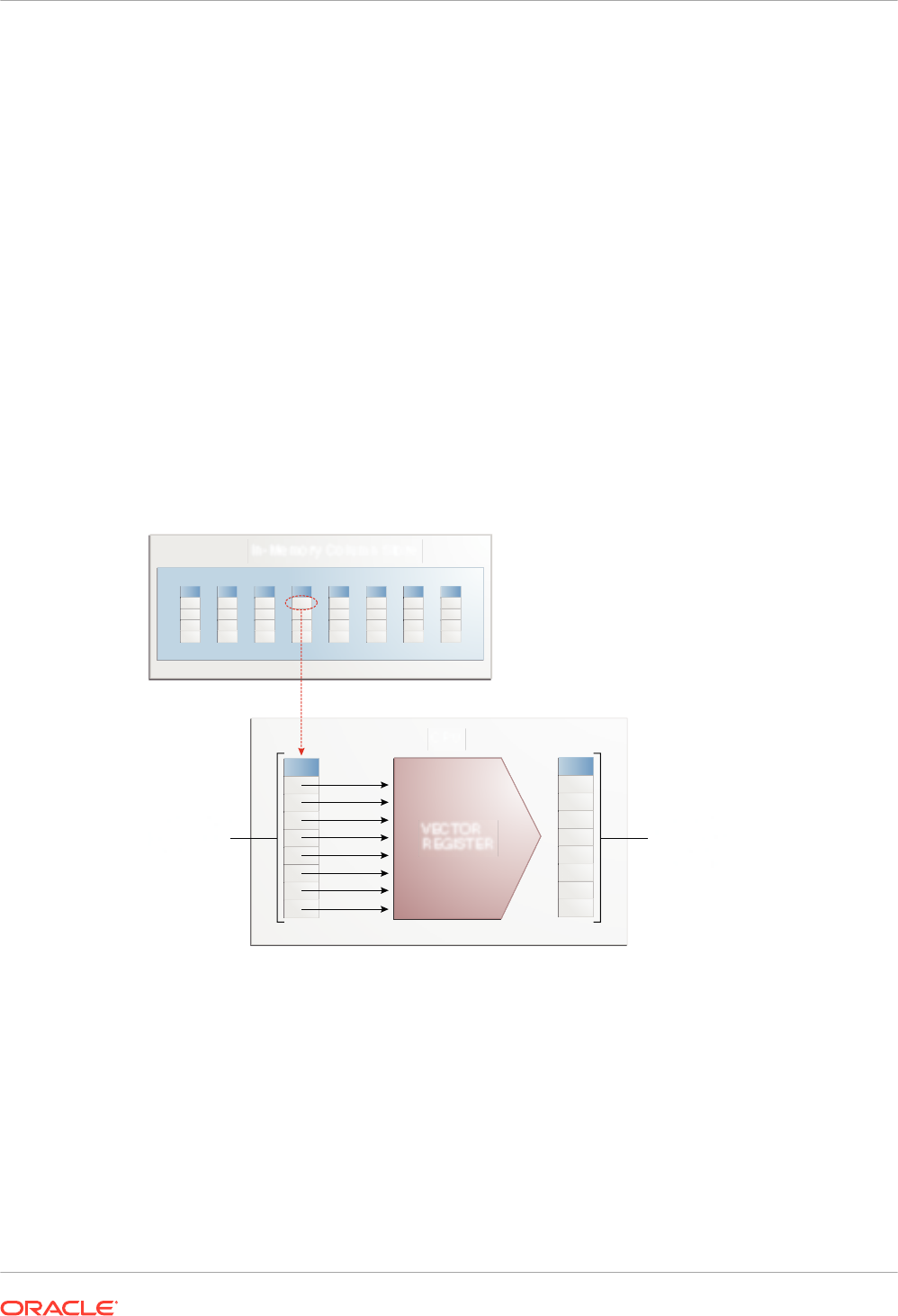
2.6 CPU Architecture: SIMD Vector Processing
For data that is populated in the IM column store, the database uses SIMD (single instruction,
multiple data) processing.
A SIMD unit is a processor that enables a single instruction to process data as a unit, called a
vector, rather than processing data in separate instructions. For example, instead of using a
loop to execute four addition operations, SIMD could load the four sets of numbers into vectors
and perform one addition operation. SIMD processing is sometimes called vectorization.
The IM column store maximizes the number of column entries that the CPU can load into the
vector registers and evaluate. Instead of evaluating each entry in the column one at a time, the
database evaluates a set of column values in a single CPU instruction. SIMD vector
processing enables the database to scan billions of rows per second.
For example, an application issues a query to find the total number of orders in the
sales
table
that use the
promo_id
value of
9999
. The
sales
table resides in the IM column store. The query
begins by scanning only the
sales.promo_id
column, as shown in the following diagram:
Figure 2-12 SIMD Vector Processing
In-Memory Column Store
Load Multiple
promo_id
Values
Use Vectors
to Compare
All Values in
One Cycle
CPU
9999
9999
9999
9999
Find Sales with
promo_id = 9999
VECTOR
REGISTER
Promo ID
The CPU evaluates the data as follows:
1. Loads the first 8 values (the number varies depending on data type and compression
mode) from the
promo_id
column into the SIMD register, and then compares them with the
value
9999
in a single instruction
2. Discards the entries.
3. Loads another 8 values into the SIMD register, and then continues in this way until it has
evaluated all entries.
Chapter 2
CPU Architecture: SIMD Vector Processing
2-26

2.6.1 SIMD and Non-JSON LOBs
Oracle Database 18c provides SIMD vector support for queries involving SQL operators on
LOB columns. This section describes LOBs that are not JSON.
When the LOBs are not JSON, the nature of the support depends on the type of LOB:
• Inline LOBs
The IM column store provides contiguous storage for inline LOBs, which are LOBs less
than 4 KB, within the IMCUs. Columnar storage enables faster query processing by
removing the overhead of assembling LOB data from the database buffer cache.
• Out-of-line LOBs
In this case, the IM column store only stores the LOB locator, which is 40 byes. Out-of-line
columns do not benefit from columnar optimization.
See Also:
Oracle Database SecureFiles and Large Objects Developer's Guide to learn more
about LOBs
2.6.2 SIMD Access for JSON Data
In-Memory columns can contain JSON data stored in either the
JSON
data type or in text-based
LOB columns.
Regardless of the data type of the In-Memory column (
VARCHAR2
,
CLOB
,
BLOB
, or
JSON
), JSON
data is stored in OSON, which is Oracle's optimized binary JSON format. The OSON format
can provide faster query performance using SIMD processing.
See Also:
• "Static Expressions: Binary JSON Columns" for complete details of how JSON
data is stored
• Oracle Database JSON Developer’s Guide for an overview of In-Memory JSON
Data
2.6.3 SIMD and Oracle Numbers
For tables compressed with
QUERY LOW
,
NUMBER
columns are encoded using an optimized
format that enables native calculations in hardware.
SIMD vector processing enables simple aggregations,
GROUP BY
aggregations, and arithmetic
operations to benefit significantly. The performance improvement depends on the amount of
time the aggregation spends on arithmetic computation. Some aggregations may benefit by up
to a factor of 9.
Chapter 2
CPU Architecture: SIMD Vector Processing
2-27

See Also:
• "Optimizing In-Memory Arithmetic"
• Oracle Database SQL Language Reference
2.6.4 SIMD and Exadata Smart Flash Cache
Besides storing data in Hybrid Columnar Compression format, Exadata Smart Flash Cache
can store data in pure columnar format.
Exadata Smart Scan supports SIMD predicates. The advantage is that In-Memory
performance extends from DRAM storage to secondary storage.
By default, Exadata Smart Flash Cache compresses data using the level
MEMCOMPRESS FOR
CAPACITY LOW
. To change the compression level or disable the columnar format altogether, use
the
ALTER TABLE ... NO CELLMEMORY
statement.
See Also:
• "In-Memory Support for Exadata Flash Cache"
• Oracle Exadata Database Machine System Overview
Chapter 2
CPU Architecture: SIMD Vector Processing
2-28

Part II
Configuring and Populating the IM Column
Store
You can enable and size the In-Memory Column Store (IM column store). You can also
configure In-Memory settings for objects, and populate these objects in the IM column store.

3
Enabling and Sizing the IM Column Store
To enable or disable the IM column store, specify a value for the
INMEMORY_SIZE
initialization
parameter.
3.1 Overview of Enabling the IM Column Store
Enable the IM column store size by setting the
INMEMORY_SIZE
initialization parameter.
By default,
INMEMORY_SIZE
is set to
0
, which means the IM column store is disabled. To enable
the IM column store, set the initialization parameter
INMEMORY_SIZE
to a value greater than
zero before restarting the database instance. You can dynamically increase the
INMEMORY_SIZE
size setting by using an
ALTER SYSTEM
statement.
For the Database In-Memory Base Level only, you can allocate up to 16 GB on any CDB or
any instance of an Oracle RAC database.
By default, you must specify candidates for population in the IM column store using the
INMEMORY
clause of a
CREATE
or
ALTER
statement for a table, tablespace, or materialized view.
See Also:
• "In-Memory Initialization Parameters"
• Oracle Database Reference to learn more about the
INMEMORY_SIZE
initialization
parameter
• Oracle Database SQL Language Reference for more information about the
INMEMORY
clause
• Oracle Database Licensing Information User Manual for details on which features
are supported for different editions and services
3.2 Estimating the Required Size of the IM Column Store
Estimate the size of the IM column store based on your requirements, and then resize the IM
column store to meet those requirements. Applying compression can reduce memory size.
The amount of memory required by the IM column store depends on the database objects
stored in it and the compression method applied on each object. When choosing a
compression method for the
INMEMORY
objects, balance the performance benefits against the
amount of available memory:
• To make the greatest reduction in memory size, choose the
FOR CAPACITY HIGH
or
FOR
CAPACITY LOW
compression methods. However, these options require additional CPU
during query execution to decompress the data.
• To get the best query performance, choose the
FOR QUERY HIGH
or
FOR QUERY LOW
compression methods. However, these options consume more memory.
3-1

When sizing the IM column store, consider the following guidelines:
1. For every object to be populated into the IM column store, estimate the amount of memory
it consumes.
Oracle Compression Advisor estimates the compression ratio that you can realize using
the
MEMCOMPRESS
clause. The advisor uses the
DBMS_COMPRESSION
interface.
2. Add the individual amounts to together.
Note:
After population,
V$IM_SEGMENTS
shows the actual size of the objects on disk and
their size in the IM column store. You can use this information to calculate the
compression ratio for the populated objects. However, if the objects were
compressed on disk, then this query does not show the correct compression
ratio.
3. If you configured In-Memory Optimized Arithmetic, and if In-Memory tables use
FOR QUERY
LOW
compression, then add roughly 15% to account for the dual storage of
NUMBER
columns.
4. Add space to account for the growth of database objects, and to store updated versions of
rows after DML operations.
The minimum amount for dynamic resizing is 1 granule.
See Also:
• "Compression Levels for In-Memory Objects"
• "Enabling the IM Column Store for a CDB or PDB"
• "Increasing the Size of the IM Column Store Dynamically"
• "About In-Memory Optimized Arithmetic"
• Oracle Database Administrator’s Guide to learn how to estimate compression
ratio using Compression Advisor
• Oracle Database Reference to learn about
V$IM_SEGMENTS
3.3 Enabling the IM Column Store for a CDB or PDB
Before tables or materialized views can be populated into the IM column store, you must
enable the IM column store.
In a CDB, the
INMEMORY_SIZE
setting in the CDB root determines the overall size of the IM
column store. By default, all PDBs have access to the IM column store.
Chapter 3
Enabling the IM Column Store for a CDB or PDB
3-2

Note:
For the Database In-Memory Base Level, the
INMEMORY_SIZE
size at the CDB level
must be less than or equal to
16G
.
Within an individual PDB, you can limit access to the shared In-Memory Area by setting
INMEMORY_SIZE
to a different value. For example, in a CDB with 100 PDBs, you could set
INMEMORY_SIZE
to
16G
at the CDB level, and then set
INMEMORY_SIZE
to
10G
in one PDB, to
6G
in a second PDB, and to
0
in the remaining PDBs.
Prerequisites
This task assumes that the following:
• The CDB is open.
• The
COMPATIBLE
initialization parameter is set to
12.1.0
or higher.
• The
INMEMORY_SIZE
initialization parameter is set to
0
(default).
• You want to use the Database In-Memory Base Level.
To enable the IM column store:
1. In SQL*Plus or SQL Developer, log in to the CDB root as a user with administrator
privileges.
2. Set the
INMEMORY_SIZE
initialization parameter to a nonzero value.
When you set this initialization parameter in a server parameter file (SPFILE) using the
ALTER SYSTEM
statement, you must specify
SCOPE=SPFILE
.
For example, the following statement sets the In-Memory Area size to 16 GB:
ALTER SYSTEM SET INMEMORY_SIZE = 16G SCOPE=SPFILE;
3. For the Database In-Memory Base Level, set the
INMEMORY_FORCE
initialization parameter
to
BASE_LEVEL
.
For example, the following statement specifies the Base Level:
ALTER SYSTEM SET INMEMORY_FORCE=BASE_LEVEL SCOPE=SPFILE;
You cannot set
INMEMORY_FORCE=BASE_LEVEL
at the PDB level. Also, you cannot set this
parameter dynamically.
4. Shut down the CDB, and then reopen it.
You must reopen the CDB to initialize the IM column store in the SGA.
5. Optionally, check the amount of memory currently allocated for the IM column store:
SHOW PARAMETER INMEMORY_SIZE
Chapter 3
Enabling the IM Column Store for a CDB or PDB
3-3

Note:
After the IM column store is enabled, you can increase its size dynamically
without shutting down and reopening the CDB.
Example 3-1 Enabling the IM Column Store
Assume that the
INMEMORY_SIZE
initialization parameter is set to
0
. The following SQL*Plus
example sets
INMEMORY_SIZE
to 10 GB, shuts down the database instance, and then reopens
the database so that the change can take effect:
SQL> SHOW PARAMETER INMEMORY_SIZE
NAME TYPE VALUE
------------------------------------ ----------- -----
inmemory_size big integer 0
SQL> ALTER SYSTEM SET INMEMORY_SIZE=10G SCOPE=SPFILE;
System altered.
SQL> SHUTDOWN IMMEDIATE
Database closed.
Database dismounted.
ORACLE instance shut down.
SQL> STARTUP
ORACLE instance started.
Total System Global Area 11525947392 bytes
Fixed Size 8213456 bytes
Variable Size 754977840 bytes
Database Buffers 16777216 bytes
Redo Buffers 8560640 bytes
In-Memory Area 10737418240 bytes
Database mounted.
Database opened.
SQL> SHOW PARAMETER INMEMORY_SIZE
NAME TYPE VALUE
------------------------------------ ----------- -----
inmemory_size big integer 10G
Chapter 3
Enabling the IM Column Store for a CDB or PDB
3-4

See Also:
• "Multiple IM Column Stores"
• Oracle Database Upgrade Guide for information about setting the database
compatibility level
• Oracle Database Reference for more information about the
INMEMORY_SIZE
initialization parameter
• Oracle Database Licensing Information User Manual for details on which features
are supported for different editions and services
3.4 Sizing the In-Memory Area
The size of the In-Memory area is set by the
INMEMORY_SIZE
initialization parameter. By default,
the size of the In-Memory Area is 0, which means the IM column store is disabled. The In-
Memory Area can also be resized dynamically, either through automatic memory management
or manually via an
ALTER SYSTEM
command.
Automatic In-Memory sizing can automatically grow or shrink the In-Memory Area based on
the benefits of the column store if the following are true:
•
SGA_TARGET
> 0.
•
INMEMORY_AUTOMATIC_LEVEL
=
MEDIUM
or
HIGH
.
•
VECTOR_MEMORY_SIZE
is not set or is set to 0.
The In-Memory Area and SGA_TARGET
The In-Memory area is subtracted from the
SGA_TARGET
initialization parameter setting. For
example, if you set
SGA_TARGET
to 10 GB, and if you set the
INMEMORY_SIZE
to 4 GB, then 40%
of the
SGA_TARGET
setting is allocated to the In-Memory area. The following graphic illustrates
the relationship.
Figure 3-1 INMEMORY_SIZE and SGA_TARGET
Unused
SGA
In-Memory Area
SGA_MAX_SIZE
SGA_TARGET
INMEMORY_SIZE
Dynamic
Static
Chapter 3
Sizing the In-Memory Area
3-5

The
INMEMORY_SIZE
parameter can be dynamically modified, but cannot be smaller than the
initial value that was specified during database startup.
In-Memory Area Sizing Under Automatic Shared Memory Management (ASMM)
In-Memory Column store sizing can now be managed with ASMM when the value of
sga_target
is greater than zero and
INMEMORY_AUTOMATIC_LEVEL
on a PDB is set to either
MEDIUM
or
HIGH
.
When ASMM is enabled, it controls the size of the In-Memory Area along with the other
components of the SGA, including the buffer cache and the shared pool. ASMM provides
dynamic resizing of the physical In-Memory column store based on demand and workload. It
automatically increases the size of the In-Memory column store when it runs out of space. It
also automatically shrinks the size of the column store and makes the free memory available to
other SGA components, with no database restart required. ASMM uses the statistics provided
by the view
V$INMEMORY_SIZE_ADVICE
to determine the optimal size of the column store.
The INMEMORY_SIZE parameter specifies the minimum IM area size for ASMM.
In Memory Area Sizing When ASMM is not Enabled
If ASMM is not enabled, then the In-Memory Area size is not controlled by automatic memory
management. The database does not automatically shrink the In-Memory Area when the buffer
cache or shared pool requires more memory, or increase the In-Memory Area when it runs out
of space.
Differences in the Effect of INMEMORY_SIZE When ASMM Enabled and When it is
Disabled
In Oracle Database 23ai and later, the CDB
INMEMORY_SIZE
parameter specifies the minimum
total column store size across all tenants when ASMM is in use (
SGA_TARGET > 0
). Automatic
In-Memory (AIM) also requires that the
INMEMORY_AUTOMATIC_LEVEL
parameter is set to
HIGH
.
This because SGA's decision to size the column store is global and applies to all PDBs
The
INMEMORY_SIZE
initialization parameter sets the minimum size at instance start up, but you
can also change it at runtime with an
ALTER
command. In the case where ASMM is not enabled
(
SGA_TARGET=0
), the
INMEMORY_SIZE
parameter sets the actual total size of the In-Memory area.
Note:
In releases prior to Oracle Database 23ai:
Prior to Oracle Database 23ai, the In-Memory area can be grown dynamically at the
CDB level, shrinking the In-Memory area dynamically at the CDB level while the
instance is running is not allowed. At the PDB level in prior releases, both growth and
shrinking are possible, although shrinking the size of the In-Memory Area dynamically
reduces the quota for In-Memory usage in the given PDB. In order to physically
shrink the column store and make the free memory available to other SGA
components in these earlier releases, you must restart the instance.
In-Memory Area Sizing When ASMM is Enabled, but INMEMORY_AUTOMATIC_LEVEL is
not Set to HIGH
In this case, the In-Memory area is managed the same way as described in the previous note
about pre-23ai releases of Oracle Database. On a CDB, dynamic growth of the In-Memory
Chapter 3
Sizing the In-Memory Area
3-6

area can occur, but dynamic shrinking cannot. Also, the same constraints described above
apply to the PDB.
Dynamically Setting Size Constraints for the In-Memory Area
Setting
INMEMORY_SIZE
dynamically using the
ALTER SYSTEM
statement establishes the lower
bound for any automatic resize operations performed when ASMM is enabled. If you increase
INMEMORY_SIZE
, the database allocates increased memory when the following conditions are
met:
• Free memory is available in the SGA.
• The new size for
INMEMORY_SIZE
is at least 1 granule.
Note:
– You cannot use
ALTER SYSTEM
to reduce
INMEMORY_SIZE
.
– The CDB
INMEMORY_SIZE
must be at least 100MB for In-Memory to be
enabled.
The
V$INMEMORY_AREA
and
V$SGA
views immediately reflect the change.
In-Memory Resource Management in a CDB
In a CDB, the size of the IM column store is set by the
INMEMORY_SIZE
parameter in the CDB
root. Note that by default, the IM column store is shared among the PDBs. This means that a
PDB can potentially "starve" other PDBs by consuming the available memory.
Within a PDB, you can limit memory consumption by using
ALTER SYSTEM SET INMEMORY_SIZE
.
For example, at the CDB level, you might set
INMEMORY_SIZE
to
20G
, and then configure the
PDBs as in this example:
• In
hrpdb
, set
INMEMORY_SIZE
to
0
• In
salespdb
, set
INMEMORY_SIZE
to
10G
• In
oepdb
, set
INMEMORY_SIZE
to
11G
In the preceding example, the
INMEMORY_SIZE
settings at the PDB level add up to
21G
, even
though
INMEMORY_SIZE
at the CDB level is only
20G
. Oversubscription ensures that valuable
space in the IM column store is not wasted if a PDB is shut down or unplugged.
PDB and CDB Behavior Under Automatic Shared Memory Management
These behaviors apply when
SGA_TARGET
is greater than zero, which means that ASMM is
possible. For ASMM to work, keep
INMEMORY_AUTOMATIC_LEVEL
on PDBs and CDBs
compatible as described.
• When the Automatic In-Memory
INMEMORY_AUTOMATIC_LEVEL
parameter is set to
HIGH
at
the CDB level:
The PDB inherits the
HIGH
setting for
INMEMORY_AUTOMATIC_LEVEL
. At the PDB level, you
can also change this setting to
LOW
or
MEDIUM
. An error occurs you change this setting to
OFF
on the PDB.
• If
INMEMORY_AUTOMATIC_LEVEL
is set to
OFF
at the CDB level and you attempt to change it
to
HIGH
on a CDB:
Chapter 3
Sizing the In-Memory Area
3-7

If on any PDB
INMEMORY_AUTOMATIC_LEVEL
is already explicitly set to
OFF
, then a user error
occurs.
See Also:
• "Increasing the Size of the IM Column Store Dynamically"
• Oracle Database Administrator’s Guide to learn more about automatic memory
management
• Oracle Database Reference to learn about
INMEMORY_SIZE
,
V$INMEMORY_AREA
,
and
V$SGA
3.4.1 Increasing the Size of the IM Column Store Dynamically
You can increase the size of IM column store at database run time by using SQL to reset
INMEMORY_SIZE
.
Note:
If ASMM is enabled, it automatically decreases or increases the IM column store size
dynamically as needed. If you want to set
INMEMORY_SIZE
to a value smaller than its
current setting, check the prerequisites listed here, then issue the
ALTER SYSTEM
statement with
SCOPE=SPFILE
as described below. Then restart the database to effect
the change.
Prerequisites
To increase the size of the IM column store dynamically using
ALTER SYSTEM
, the instance must
meet the following prerequisites:
• The IM column store must be enabled.
• The compatibility level must be
12.2.0
or higher.
• The database instances must be started with an SPFILE.
• The new size of the IM column store must be at least 1 granule.
Steps
1. In SQL*Plus or SQL Developer, log in to the database with administrative privileges.
2. Optionally, check the amount of memory currently allocated for the IM column store:
SHOW PARAMETER INMEMORY_SIZE
3. Set the
INMEMORY_SIZE
initialization parameter to a value greater than the current size of
the IM column store with an
ALTER SYSTEM
statement that specifies
SCOPE=BOTH
or
SCOPE=MEMORY
.
When you set this parameter dynamically, you must set it to a value that is higher than its
current value, and there must be enough memory available in the SGA to increase the size
of the IM column store dynamically to the new value.
Chapter 3
Sizing the In-Memory Area
3-8

For example, the following statement sets
INMEMORY_SIZE
to
500M
dynamically:
ALTER SYSTEM SET INMEMORY_SIZE = 500M SCOPE=BOTH;
See Also:
• "Enabling the IM Column Store for a CDB or PDB"
• Oracle Database Reference for more information about the
INMEMORY_SIZE
initialization parameter
3.5 Views for Working Automatic Sizing of the IM Column Store
V$INMEMORY_SIZE_ADVICE
estimates usage and performance statistics for different simulated
sizes of the In-Memory Column Store (IM Column Store).
For various sizes of the CDB In-Memory column store, this view forecasts the cumulative time
spent by database in processing user requests. This includes wait time and CPU time for all
non-idle user sessions
See Also:
V$INMEMORY_SIZE_ADVICE is described in the Oracle Database Reference.
3.6 Disabling the IM Column Store
You can disable the IM column store by setting the
INMEMORY_SIZE
initialization parameter to
zero, and then reopening the database.
Assumptions
This task assumes that the IM column store is enabled in an open database.
To disable the IM column store:
1. Set the
INMEMORY_SIZE
initialization parameter to
0
in the server parameter file (SPFILE).
2. Shut down the database.
3. Start a database instance, and then open the database.
See Also:
Oracle Database Reference for information about the
INMEMORY_SIZE
initialization
parameter
Chapter 3
Views for Working Automatic Sizing of the IM Column Store
3-9

4
Automating Management of In-Memory
Objects
Automatic In-Memory and Automatic Data Optimization (ADO) manage objects in the IM
column store dynamically, without user intervention.
Note:
Automatic In-Memory and ADO do not currently support external tables and hybrid
partitioned tables.
4.1 Configuring Automatic In-Memory
When
INMEMORY_AUTOMATIC_LEVEL
is
HIGH
, all objects are specified as
INMEMORY
by default.
Automatic In-Memory uses access tracking and column statistics to manage objects in the IM
column store.
Note:
If the
INMEMORY_FORCE
initialization parameter is set to
BASE_LEVEL
, then Automatic
In-Memory is disabled even if
INMEMORY_AUTOMATIC_LEVEL
is set. Even if tables have
a compression level of
AUTO
, Automatic In-Memory background operations do not
run.
4.1.1 Purpose of Automatic In-Memory
Automatic In-Memory optimizes the SQL workload as it changes, without manual intervention.
The working data set consists of the most frequently queried segments. Typically, the working
data set changes with time for many applications. Users must decide which segments to
enable as
INMEMORY
, monitor usage to decide which IM segments to populate and evict, and
create ADO IM policies. These tasks require a thorough understanding of the workload.
To free the DBA from manual maintenance chores, Automatic In-Memory uses frequently
updated internal statistics to maintain the working data set in the IM column store. Oracle
Database decides what to populate and what to evict, and when to do it. In a sense, the IM
column store becomes "self-driving."
4.1.2 How Automatic In-Memory Works
Automatic In-Memory uses segment level access tracking as well as internal statistics to
determine how frequently In-Memory objects and columns are accessed.
4-1
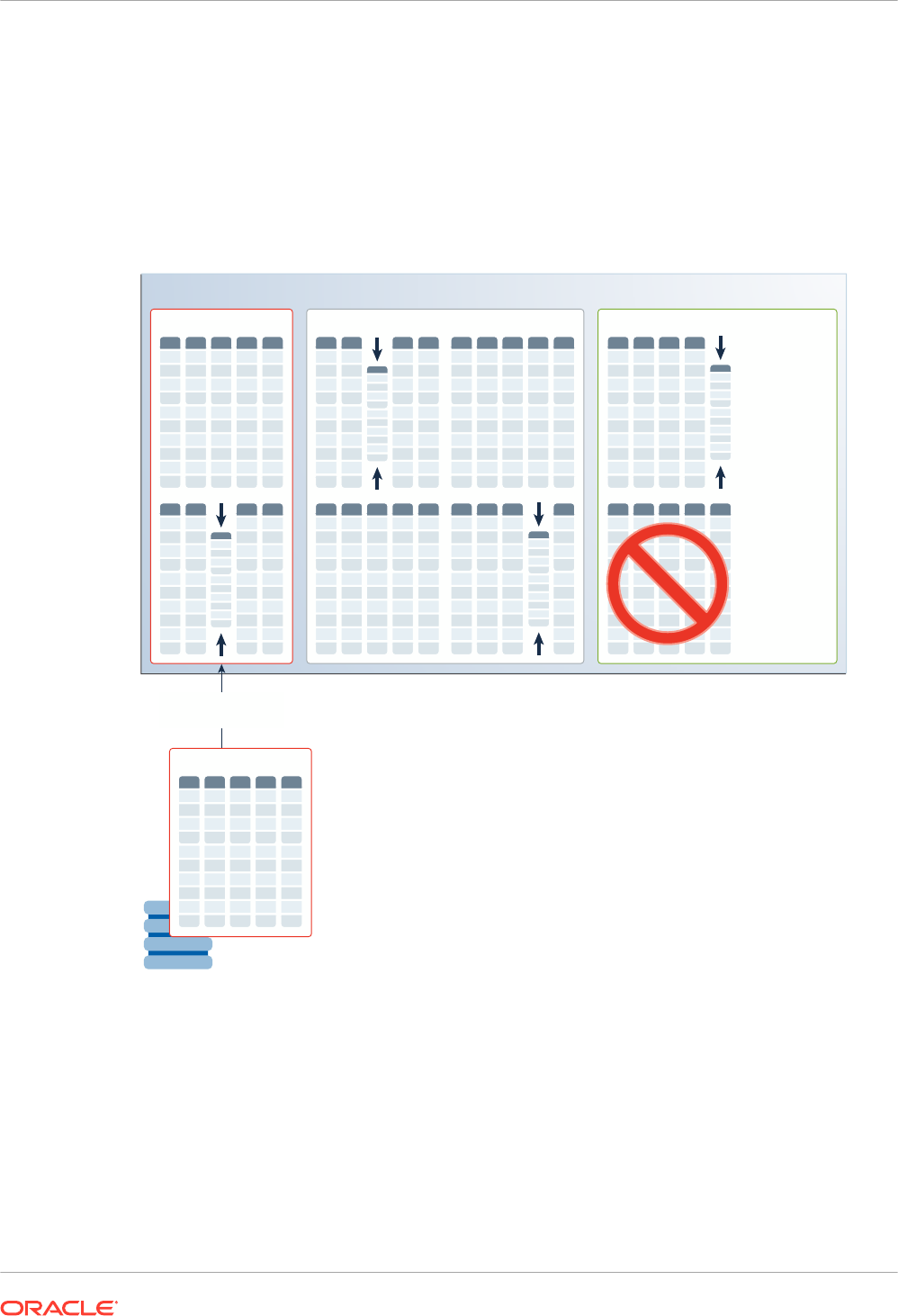
4.1.2.1 Automatic In-Memory Heat Level Statistics
Automatic In-Memory monitors segments using segment level access tracking in addition to a
column statistics infrastructure that is similar to a heat map.
As shown in the following diagram, Automatic In-Memory uses the heat level statistics to
determine which segments to populate and evict, and which columns to compress.
Figure 4-1 Automatic In-Memory
Intermediate DataHot Data Cool Data
Automatically
Evict Cold
Tables
Automatically
Compress
Cold Columns
In-Memory Column Store
Hot Data
Automatically
Populate Hot Data
When
INMEMORY_AUTOMATIC_LEVEL
is
HIGH
, Automatic In-Memory continuously monitors
column statistics in the IM store. The database identifies cold regions of the IM store through
internal column statistics, which are similar to those used by Heat Map but do not require
HEAT_MAP
to be set to
ON
. Using heat-level statistics, Automatic In-Memory optimizes storage by
populating and evicting objects and by compressing columns.
4.1.2.2 How Enabling Objects for Automatic In-Memory Works
Depending on the
INMEMORY_AUTOMATIC_LEVEL
setting, either the database or the user enables
specific objects for In-Memory access.
Chapter 4
Configuring Automatic In-Memory
4-2

When the
INMEMORY_AUTOMATIC_LEVEL
initialization parameter is set to
HIGH
, all segments that
do not have a pre-existing
INMEMORY
setting are automatically marked
INMEMORY MEMCOMPRESS
AUTO
. For partitioned tables, Oracle Database sets the compression level to
MEMCOMPRESS AUTO
for existing and new partitions. In all cases, if segments have a pre-existing
INMEMORY
setting,
then the previous setting is retained.
The
MEMCOMPRESS AUTO
setting means the segments are automatically enabled for In-Memory
access, with no DDL required. Note that In-Memory tables have overhead for DML. If you are
concerned about the
HIGH
level enabling
INMEMORY
for tables with moderate or high levels of
DML, then you can specify these tables as
NO INMEMORY
manually. You can re-enable the
NO
INMEMORY
tables by specifying the
INMEMORY MEMCOMPRESS AUTO
clause.
When
INMEMORY_AUTOMATIC_LEVEL
is not
HIGH
, all objects are
NO INMEMORY
by default. If you
set
INMEMORY_AUTOMATIC_LEVEL
to
HIGH
, and if you later set it to a different value, then the
database changes all segments that were previously
MEMCOMPRESS AUTO
to
NO INMEMORY
. In this
case, you must execute DDL to enable the desired segments for In-Memory access, as you
must do when Automatic In-Memory is not enabled.
Example 4-1 Setting Automatic In-Memory to HIGH
In this example, the IM column store is enabled, but no segments currently have a user-
specified
INMEMORY
setting, and Automatic In-Memory is disabled. You log in to
salespdb
as an
administrator, and then do the following:
1. Query the data dictionary to determine whether any tables are specified as
INMEMORY
:
SELECT TABLE_NAME, PARTITIONED, INMEMORY, INMEMORY_COMPRESSION
FROM DBA_TABLES
WHERE OWNER='SH' AND TABLE_NAME IN ('COUNTRIES', 'PRODUCTS', 'TIMES')
ORDER BY TABLE_NAME;
TABLE_NAME PAR INMEMORY INMEMORY_COMPRESS
-------------------------- --- -------- -----------------
COUNTRIES NO DISABLED
PRODUCTS NO DISABLED
TIMES NO DISABLED
2. Apply the
INMEMORY
attribute to the
countries
table:
ALTER TABLE sh.countries INMEMORY MEMCOMPRESS FOR CAPACITY HIGH;
3. Query the data dictionary to confirm the change:
SELECT TABLE_NAME, PARTITIONED, INMEMORY, INMEMORY_COMPRESSION
FROM DBA_TABLES
WHERE OWNER='SH' AND TABLE_NAME IN ('COUNTRIES', 'PRODUCTS', 'TIMES')
ORDER BY TABLE_NAME;
TABLE_NAME PAR INMEMORY INMEMORY_COMPRESS
-------------------------- --- -------- -----------------
COUNTRIES NO ENABLED FOR CAPACITY HIGH
PRODUCTS NO DISABLED
TIMES NO DISABLED
Chapter 4
Configuring Automatic In-Memory
4-3

4. Connect to the CDB root, and then set
INMEMORY_AUTOMATIC_LEVEL
to
HIGH
:
ALTER SYSTEM SET INMEMORY_AUTOMATIC_LEVEL = 'HIGH' SCOPE=SPFILE;
5. Shut down the CDB, and then re-open it:
SHUTDOWN IMMEDIATE
STARTUP
6. Log in to
salespdb
, and then query the data dictionary to determine the current
INMEMORY
compression settings:
SELECT TABLE_NAME, PARTITIONED, INMEMORY, INMEMORY_COMPRESSION
FROM DBA_TABLES
WHERE OWNER='SH' AND TABLE_NAME IN ('COUNTRIES', 'PRODUCTS', 'TIMES')
ORDER BY TABLE_NAME;
TABLE_NAME PAR INMEMORY INMEMORY_COMPRESS
-------------------------- --- -------- -----------------
COUNTRIES NO ENABLED FOR CAPACITY HIGH
PRODUCTS NO ENABLED AUTO
TIMES NO ENABLED AUTO
The
countries
table, which was manually specified as
INMEMORY
, retains its previous
settings. The other tables now have the compression level
AUTO
.
7. Apply the
INMEMORY MEMCOMPRESS AUTO
attribute to the
countries
table:
ALTER TABLE sh.countries INMEMORY MEMCOMPRESS AUTO;
8. Query the data dictionary to determine the current
INMEMORY
compression settings:
SELECT TABLE_NAME, PARTITIONED, INMEMORY, INMEMORY_COMPRESSION
FROM DBA_TABLES
WHERE OWNER='SH' AND TABLE_NAME IN ('COUNTRIES', 'PRODUCTS', 'TIMES')
ORDER BY TABLE_NAME;
TABLE_NAME PAR INMEMORY INMEMORY_COMPRESS
-------------------------- --- -------- -----------------
COUNTRIES NO ENABLED AUTO
PRODUCTS NO ENABLED AUTO
TIMES NO ENABLED AUTO
All tables now show the compression level
AUTO
.
See Also:
"Populating the IM Column Store Manually"
Chapter 4
Configuring Automatic In-Memory
4-4

4.1.2.3 How Automatic In-Memory Population Works
Depending on the
INMEMORY_AUTOMATIC_LEVEL
setting, population either occurs automatically
for objects in the working data set, or depends on the user-specified
INMEMORY
settings.
When
INMEMORY_AUTOMATIC_LEVEL
is set to
HIGH
, the database populates only objects that it
decides belong in the working data set. This decision is based on current usage statistics. For
example, if a specific partition of the
sales
table is "hot" (frequently queried), then Automatic
In-Memory may populate this partition and keeps in the IM column store as long as it is hot.
Automatic In-Memory may also decide to populate cold columns at a higher compression level.
The
MEDIUM
setting for
INMEMORY_AUTOMATIC_LEVEL
is similar to the
HIGH
setting. The only
difference is that at the
HIGH
setting, Oracle Database compresses cold columns. When
INMEMORY_AUTOMATIC_LEVEL
is
LOW
, the database populates objects according to their user-
specified
INMEMORY
settings. For example, if objects are set to
INMEMORY PRIORITY NONE
, then
you must manually force population of these objects using a scan or PL/SQL call.
4.1.2.4 How Automatic In-Memory Eviction Works
The unit of data eviction is an
INMEMORY
segment.
To ensure that the working data set is always populated, Automatic In-Memory automatically
evicts cold (infrequently accessed) segments. Memory pressure occurs when the size of the
INMEMORY
data set exceeds the available memory for the IM column store, and some populated
segments become inactive.
By automatically evicting cold segments, Automatic In-Memory provides the following benefits:
• Improved performance
Automatic In-Memory improves workload performance because the working data set
resides in the IM column store.
• Ease of management
Evicting cold segments manually involves significant user intervention. Automatic In-
Memory automates this process, requiring minimal user intervention.
When INMEMORY_AUTOMATIC_LEVEL Is HIGH
When the
INMEMORY_AUTOMATIC_LEVEL
initialization parameter is set to
HIGH
, Automatic In-
Memory uses internal statistics to decide when to evict a segment. Also, Automatic In-Memory
can recompress cold columns in
MEMCOMPRESS AUTO
segments to save space. Segments with a
PRIORITY
setting other than
NONE
are excluded from the automatic eviction algorithm.
When INMEMORY_AUTOMATIC_LEVEL Is LOW or MEDIUM
When
INMEMORY_AUTOMATIC_LEVEL
is
LOW
or
MEDIUM
, an
INMEMORY
segment is only eligible for
automatic eviction when its priority is
NONE
. The IM column store only removes a populated
segment if it is dropped or moved, the
INMEMORY
option is removed, or an IM ADO policy acts
on it. The basic process is as follows:
1. A population job fails, which means that IM column store space has been exhausted.
2. The database uses internal statistics of eligible populated segments to define the set of
objects to evict. The statistics are similar to those used by Heat Map, but do not require
Heat Map to be enabled.
Chapter 4
Configuring Automatic In-Memory
4-5

3. For each segment in the set, the database checks whether an ADO policy is enabled for
the segment:
• If an enabled policy requires that the segment remain populated, then the ADO policy
overrides Automatic In-Memory. The database does nothing.
• If no policy prevents eviction, then Automatic In-Memory submits tasks to evict the
segments.
4. The database evicts any segments that pass the preceding checks, freeing up space in the
IM column store.
The
INMEMORY
attribute is retained for evicted segments.
For example, a nightly batch job loads a
sales
partition (with priority
NONE
), and then queries
the partition to trigger population. Because the IM column store is almost at its maximum
capacity, only half the rows of the partition are populated. The failure to completely populate
the new partition triggers Automatic In-Memory, which evicts a cold segment. A subsequent
on-demand populate job for the new partition completely populates the new
sales
partition.
See Also:
"Space Management Worker Processes (Wnnn)"
4.1.3 User Interface for Automatic In-Memory
Enable and disable Automatic In-Memory using the initialization parameter
INMEMORY_AUTOMATIC_LEVEL
.
Initialization Parameters
The system-level initialization parameter
INMEMORY_AUTOMATIC_LEVEL
has the following
possible values:
•
OFF
(Default)
This option disables Automatic In-Memory, returning the IM column store to its Oracle
Database 12c Release 2 (12.2.0.1) behavior.
•
LOW
When under memory pressure, the database evicts cold segments from the IM column
store.
•
MEDIUM
This level includes an additional optimization that ensures that any hot segment that was
not populated because of memory pressure is populated first.
•
HIGH
Setting
INMEMORY_AUTOMATIC_LEVEL
to
HIGH
should improve query performance for all
reference workloads with low degradation in transactional throughput. At this level
Automatic In-Memory marks all user segments
INMEMORY COMPRESS AUTO
by default. Any
segments that were previously marked
INMEMORY
by the user retain their attributes.
The
HIGH
setting ensures that all database objects are candidates for population to the In-
Memory Column store except system-created objects and segments that are annotated
Chapter 4
Configuring Automatic In-Memory
4-6

with
NO INMEMORY
explicitly. When
INMEMORY_AUTOMATIC_LEVEL=HIGH
is set, these objects
are excluded from any Automatic In-Memory action, including marking them for In-Memory.
When changed from
HIGH
to any other value, segments set to
INMEMORY COMPRESS AUTO
change to
NO INMEMORY
.
Note:
Automatic In-Memory does not require the
HEAT_MAP
initialization parameter to be
enabled.
See Also:
Oracle Database Reference to learn more about
INMEMORY_AUTOMATIC_LEVEL
Additional Shared Pool Memory Requirements
Oracle recommends that you provision enough memory for the working data set to fit in the IM
column store. As a rule of thumb for sizing the additional Automatic In-Memory shared pool
requirement, multiply 5 KB by the number of
INMEMORY
segments of SGA memory. For
example, if 10,000 segments have the
INMEMORY
attribute, then reserve 50 MB of the shared
pool for Automatic In-Memory.
DBMS_AUTOIM
The DBMS_AUTOIM package provides APIs to manage the execution of the AIM features as
well as a reporting function.
Use the DBMS_AUTOIM package to control the time window in which Automatic In-Memory
considers statistics. For example, you can specify that Automatic In-Memory only consider the
past month or the past week.
The default value for
AIM_STATWINDOW_DAYS
is
1
day.
Use the
ACTIVITY_REPORT
function to generate a report on the automatic creation of IM
performance features. These features include Autonomous Join Groups, Autonomous Bloom
Filter Optimization, Autonomous Optimized Arithmetic, and Autonomous Vector Optimization.
Data Dictionary Views That Work With DBMS_AUTOIM
The
DBA_INMEMORY_AIMTASKS
view enables you to track decisions made by Automatic In-
Memory tasks. For example, the following query shows tasks ordered by creation date:
SELECT TASK_ID, TO_CHAR(CREATION_TIME,'DD-MON-YY hh24:mi:ss') AS CREATE_TIME,
STATE
FROM DBA_INMEMORY_AIMTASKS
ORDER BY CREATE_TIME;
TASK_ID CREATE_TIME STATE
---------- --------------------------- ----------
1 11-JUN-19 12:11:09 DONE
2 11-JUN-19 12:15:12 DONE
3 11-JUN-19 12:17:12 DONE
Chapter 4
Configuring Automatic In-Memory
4-7

4 11-JUN-19 12:19:12 DONE
5 11-JUN-19 12:21:14 DONE
...
The
DBA_INMEMORY_AIMTASKDETAILS
view describes details relating to the tasks. For example,
the following query shows the action and state for task 1 for schema
sh
:
COL TASK_ID FORMAT a99999
COL OBJECT_OWNER FORMAT a7
COL OBJECT_NAME FORMAT a19
COL SUBOBJECT_NAME FORMAT a13
COL ACTION FORMAT a13
COL STATE FORMAT a10
SELECT * FROM DBA_INMEMORY_AIMTASKDETAILS
WHERE OBJECT_OWNER = 'SH' and TASK_ID = 1;
TASK_ID OBJECT_ OBJECT_NAME SUBOBJECT_NAM ACTION STATE
---------- ------- ------------------ ------------- ------------- –--------
1 SH CAL_MONTH_SALES_MV EVICT DONE
1 SH CHANNELS EVICT DONE
1 SH COSTS COSTS_Q1_1998 POPULATE SCHEDULED
1 SH COSTS COSTS_Q1_1999 POPULATE SCHEDULED
...
See Also:
Oracle Database Reference to learn more about
DBA_INMEMORY_AIMTASKS
and
DBA_INMEMORY_AIMTASKDETAILS
The database reference describes the following additional views related to
DBMS_AIM_ADMIN:
• V_AUTO_IM_FEATURES, which identifies the various IM performance features
that are optimized by AIM.
• DBA_AIM_PERF_FEATURES shows you the table columns on which AIM
performance features are enabled.
• DBA_JOINGROUPS has been updated to include the
AUTO_CREATED
and
CREATION_DATE
columns in its table of join groups belonging to the user. The
automatic creation of join groups is an AIM feature that in certain queries enables
the database to eliminate the performance overhead of decompressing and
hashing column values.
4.1.4 Controlling Automatic In-Memory
Use the
INMEMORY_AUTOMATIC_LEVEL
initialization parameter to control Automatic In-Memory.
By default, Automatic In-Memory is set to
OFF
. Enable it by setting
INMEMORY_AUTOMATIC_LEVEL
to
MEDIUM
,
LOW
, or
HIGH
.
Chapter 4
Configuring Automatic In-Memory
4-8

Prerequisites
To set this parameter with
ALTER SYSTEM
, you must have the
ALTER SYSTEM
privilege.
To change the
INMEMORY_AUTOMATIC_LEVEL
setting:
1. In SQL*Plus or SQL Developer, log in to the database as a user with the necessary
privileges.
2. Show the current setting for
INMEMORY_AUTOMATIC_LEVEL
:
SQL> SHOW PARAMETER inmemory_automatic_level
NAME TYPE VALUE
------------------------------------ ----------- -----
inmemory_automatic_level string OFF
3. Specify
INMEMORY_AUTOMATIC_LEVEL
using the
ALTER SYSTEM
statement.
The following example sets Automatic In-Memory to its fully automated level:
ALTER SYSTEM SET
INMEMORY_AUTOMATIC_LEVEL
= 'HIGH' SCOPE=SPFILE;
4. Shut down the database, and then reopen it using the SPFILE.
See Also:
Oracle Database Reference to learn more about
INMEMORY_AUTOMATIC_LEVEL
4.1.5 Setting the Time Interval for Automatic In-Memory
Use the
DBMS_INMEMORY_ADMIN
package to set the time interval for the usage statistics checked
by Automatic In-Memory.
By default, Automatic In-Memory checks usage statistics for the past 24 hours. You can
change the current setting by supplying the
AIM_STATWINDOW_DAYS
parameter to
DBMS_INMEMORY_ADMIN.AIM_SET_PARAMETER
.
Prerequisites
You must have administrator privileges to execute the
DBMS_INMEMORY_ADMIN.AIM_SET_PARAMETER
and
DBMS_INMEMORY_ADMIN.AIM_GET_PARAMETER
procedures.
Assumptions
You want to set the interval to 7 days.
To change the Automatic In-Memory interval setting:
1. In SQL*Plus or SQL Developer, log in to the database as a user with administrative
privileges.
2. Optionally, check the current setting of the
aim_statwindow_days
parameter.
Chapter 4
Configuring Automatic In-Memory
4-9

The following example calls the
DBMS_INMEMORY_ADMIN.AIM_GET_PARAMETER
procedure:
VARIABLE b_interval NUMBER
BEGIN
DBMS_INMEMORY_ADMIN.AIM_GET_PARAMETER(
DBMS_INMEMORY_ADMIN.AIM_STATWINDOW_DAYS, :b_interval);
END;
/
PRINT b_interval
B_INTERVAL
-----------------------------
1
3. Change the
aim_statwindow_days
setting with the
DBMS_INMEMORY_ADMIN.AIM_SET_PARAMETER
procedure.
The following code changes the setting to 7 days:
BEGIN
DBMS_INMEMORY_ADMIN.AIM_SET_PARAMETER(
DBMS_INMEMORY_ADMIN.AIM_STATWINDOW_DAYS, 7);
END;
/
See Also:
Oracle Database PL/SQL Packages and Types Reference to learn more about the
DBMS_INMEMORY_ADMIN.AIM_SET_PARAMETER
and
DBMS_INMEMORY_ADMIN.AIM_GET_PARAMETER
procedures
4.2 Enabling ADO for the IM Column Store
Automatic Data Optimization (ADO) creates policies, and automates actions based on those
policies, to implement your ILM strategy.
ADO uses Heat Map, which tracks data access patterns for blocks and segments. ADO and
Heat Map are a part of Information Lifecycle Management (ILM), which is a set of processes
and policies for managing data from creation to archival or deletion. This chapter assumes that
you are familiar with ILM, ADO, and Heat Map.
See Also:
Oracle Database VLDB and Partitioning Guide for background about ILM, ADO, and
Heat Map
Chapter 4
Enabling ADO for the IM Column Store
4-10

4.2.1 About ADO Policies and the IM Column Store
ADO manages the IM column store through ADO policies. You can only create an ADO policy
with an
INMEMORY
clause at the segment level.
The database treats an ADO policy like an attribute of an object. ADO policies are at the
database level, not the instance level. Oracle Database supports the following types of ADO
policies for Database In-Memory:
•
INMEMORY
policy
This policy marks objects with the
INMEMORY
attribute, enabling them for population in the
IM column store. When set at the table level, the
INMEMORY
attribute applies to all partitions,
whether internal or external.
• Recompression policy
This policy changes the compression level on an
INMEMORY
object.
•
NO INMEMORY
policy
This policy removes an object from the IM column store and removes its
INMEMORY
attribute.
Oracle Database supports the following criteria to determine when policies apply:
• A specified number of days since the object was modified
Obtain this value from the column
SEGMENT_WRITE_TIME
in the
DBA_HEAT_MAP_SEGMENT
view.
• A specified number of days since the object was accessed
This value is the greater value in the columns
SEGMENT_WRITE_TIME
,
FULL_SCAN
, and
LOOKUP_SCAN
in the
DBA_HEAT_MAP_SEGMENT
view.
• A specified number of days since the object was created
Obtain this value from the
CREATED
column in
DBA_OBJECTS
.
• A user-defined function returns a Boolean value
See Also:
• Oracle Database Reference to learn about the
DBA_HEAT_MAP_SEGMENT
view
• Oracle Database SQL Language Reference to learn about the
INMEMORY
clause
4.2.2 Purpose of ADO and the IM Column Store
ADO manages the IM column store as a new data tier.
You can create policies to evict objects from the IM column store when they are being
accessed less often, and populate objects when they are being accessed more often and
would improve query performance. ADO manages the IM column store using Heat Map
statistics.
Chapter 4
Enabling ADO for the IM Column Store
4-11

Purpose of INMEMORY Policies
In many databases, segments undergo heavy modification after creation. To maximize
performance, ADO can populate these segments in the IM column store when write activity
subsides. For example, if you add a partition to a table every day, then you can create a policy
that populates the
sales_2016_d100
partition one day after creation:
ALTER TABLE sales MODIFY PARTITION sales_2016_d100
ILM ADD POLICY SET INMEMORY MEMCOMPRESS FOR QUERY
PRIORITY HIGH
AFTER 1 DAYS OF CREATION
Similarly, you may know that write activity on a table subsides two months after creation, and
want to populate this object when this time condition is met:
ALTER TABLE 2016_ski_sales
ILM ADD POLICY SET INMEMORY MEMCOMPRESS FOR QUERY
PRIORITY CRITICAL
AFTER 60 DAYS OF CREATION
The preceding policy causes all existing and new partitions of the
2016_ski_sales
table to
inherit the policy. When the segment qualifies for the policy, the database marks every partition
independently with the specified
INMEMORY
clause. If the segment already has an
INMEMORY
policy, then the database ignores the new policy.
Purpose of Recompression Policies
You may want to compress data in the IM column store based on access patterns. For
example, you may want to change a segment from DML compression to query compression 2
days after DML activity on the segment has ceased:
ALTER TABLE lineorders
ILM ADD POLICY MODIFY INMEMORY MEMCOMPRESS FOR QUERY HIGH
AFTER 2 DAYS OF NO MODIFICATION
If the object is not populated in IM column store, then this policy only changes the compression
attribute. If the object is populated in the IM column store, then ADO repopulates the object
using the new compression level. The database ignores the policy if the segment does not
already have the
INMEMORY
attribute.
Purpose of NO INMEMORY Policies
To optimize space in the IM column store, you may want to evict inactive segments using a
NO
INMEMORY
policy. This policy is also useful for preventing population of inactive segments by
infrequent queries. For example, if reports on a specific sales partition run frequently during the
year, but typically not every week, then you may want to may want to evict this partition after a
week of no access:
ALTER TABLE sales MODIFY PARTITION sales_2015_q1
ILM ADD POLICY NO INMEMORY AFTER 7 DAYS OF NO ACCESS;
Chapter 4
Enabling ADO for the IM Column Store
4-12

If the sales table for 1998 is rarely queried, then you may want to evict after 1 day of no
access:
ALTER TABLE sales_1998
ILM ADD POLICY NO INMEMORY AFTER 1 DAYS OF NO ACCESS;
Queries of an evicted segment are never blocked. The database can always access the data
through the traditional buffer cache mechanism.
See Also:
• "Row Data in the Database Buffer Cache"
• Oracle Database VLDB and Partitioning Guide
4.2.3 How ADO Works with Columnar Data
From the ADO perspective, the IM column store is another storage tier.
4.2.3.1 How Heat Map Works
When enabled, Heat Map automatically discovers data access patterns. ADO uses the Heat
Map data to implement user-defined policies at the database level.
Heat Map automatically tracks usage information at the row and segment levels. At the row
level, Heat Map tracks data modification times, and then aggregates these times to the block
level. At the segment level, Heat Map tracks times for modifications, full table scans, and index
lookups.
When an IM column store is enabled, Heat Map tracks access patterns for columnar data. For
example, the
sales
table may be “hot,” whereas the
locations
table may be “cold.” The ADO
algorithms work the same way for columnar data as for row-based data.
The database periodically writes Heat Map data to the data dictionary. The database exposes
Heat Map data in data dictionary views. For example, to obtain the read and write time for In-
Memory objects, query the
ALL_HEAT_MAP_SEGMENT
view.
See Also:
• Oracle Database VLDB and Partitioning Guide to learn more about Heat Map
• Oracle Database Reference to learn about the
ALL_HEAT_MAP_SEGMENT
view
4.2.3.2 How Policy Evaluation Works
The policy evaluation for IM column store policies uses the same infrastructure as the
evaluation of other ADO policies. The database evaluates and executes policies automatically
during the maintenance window.
Chapter 4
Enabling ADO for the IM Column Store
4-13

The database evaluates policies using Heat Map statistics, which are stored in the data
dictionary. Setting
INMEMORY
attributes is mostly a metadata operation, and thus minimally
affects performance.
ADO uses the Job Scheduler to perform population. The In-Memory Coordinator Process
(IMCO) performs the population.
Related Topics
• In-Memory Coordinator Process (IMCO)
The In-Memory Coordinator Process (IMCO) manages many tasks for the IM column store.
Its primary task is to initiate background population and repopulation of columnar data.
4.2.4 Controls for ADO and the IM Column Store
Enable Heat Map using the
HEAT_MAP
initialization parameter. Control ADO through a SQL and
PL/SQL interface.
ILM Clause in DDL Statements
No new SQL statements are required to create In-Memory policies, but the ILM clause has
new options. The following table describes SQL options for ADO and the IM column store.
Note that Automatic In-Memory does not support external tables and hybrid partitioned tables.
Table 4-1 ILM Clause for ADO and the IM Column Store
Clause Description Examples
SET INMEMORY
Sets the
INMEMORY
attribute for
the object
ALTER TABLE sh.sales
ILM ADD POLICY
SET INMEMORY
MEMCOMPRESS FOR QUERY LOW
PRIORITY HIGH
SEGMENT
AFTER 30 DAYS OF CREATION;
MODIFY INMEMORY
Modifies the compression level
for the object
ALTER TABLE sh.customers
ILM ADD POLICY
MODIFY INMEMORY
MEMCOMPRESS FOR QUERY HIGH
PRIORITY CRITICAL
SEGMENT
AFTER 30 DAYS OF CREATION;
NO INMEMORY
Sets the
NO INMEMORY
attribute
for the object
ALTER TABLE sh.products
ILM ADD POLICY
NO INMEMORY
SEGMENT
AFTER 30 DAYS OF CREATION;
Chapter 4
Enabling ADO for the IM Column Store
4-14

See Also:
Oracle Database SQL Language Reference to learn more about the
ilm_policy_clause of
CREATE TABLE
Initialization Parameters
The following table describes initialization parameters that are relevant for ADO and the IM
column store.
Table 4-2 Initialization Parameters for ADO and the IM Column Store
Initialization
Parameter
Description
COMPATIBLE
Specifies the release with which the database must maintain compatibility. For
ADO to manage the IM column store, set this parameter to
12.2.0
or higher.
HEAT_MAP
Enables both the Heat Map and ADO features. For ADO to manage the IM
column store, set this parameter to
ON
.
INMEMORY_SIZE
Enables the IM column store. This parameter must be set to a nonzero value.
PL/SQL Packages
The following table describes PL/SQL packages that are relevant for ADO and the IM column
store.
Table 4-3 PL/SQL Packages for ADO and the IM Column Store
Package Description
DBMS_HEAT_MAP
Displays detailed Heat Map data at the tablespace, segment, object, extent,
and block levels.
DBMS_ILM
Implements ILM strategies using ADO policies.
DBMS_ILM_ADMIN
Customizes ADO policy execution.
See Also:
Oracle Database PL/SQL Packages and Types Reference to learn more about
DBMS_HEAT_MAP
,
DBMS_ILM
, and
DBMS_ILM_ADMIN
packages
V$ and Data Dictionary Views
The following table describes views that are relevant for ADO and the IM column store.
Table 4-4 Views for ADO and the IM Column Store
View Description
DBA_HEAT_MAP_SEG_HISTOGRAM
Displays segment access information for all segments
visible to the user.
Chapter 4
Enabling ADO for the IM Column Store
4-15

Table 4-4 (Cont.) Views for ADO and the IM Column Store
View Description
DBA_HEAT_MAP_SEGMENT
Displays the latest segment access time for all segments
visible to the user.
DBA_HEATMAP_TOP_OBJECTS
Displays heat map information for the top 10000 objects by
default.
DBA_HEATMAP_TOP_TABLESPACES
Displays heat map information for the top 10000
tablespaces.
DBA_ILMDATAMOVEMENTPOLICIES
Displays information specific to data movement-related
attributes of an ADO policy in a database. The
ACTION_TYPE
column describes policies related to the IM
column store. Possible values are
COMPRESSION
,
STORAGE
,
EVICT
, and
ANNOTATE
.
V$HEAT_MAP_SEGMENT
Displays real-time segment access information.
See Also:
Oracle Database Reference to learn more about views
4.2.5 Creating an ADO Policy for the IM Column Store
You can use ADO policies to set, modify, or remove the
INMEMORY
clause for objects based on
Heat Map statistics.
To create an ADO IM column store policy, specify the
ILM ADD POLICY
clause in an
ALTER
TABLE
statement, followed by one of the following subclauses:
•
SET INMEMORY ... SEGMENT
This option is useful when you want to mark segments with the
INMEMORY
attribute only
when DML activity subsides.
•
MODIFY INMEMORY ... MEMCOMPRESS ... SEGMENT
Storing data uncompressed or at the
MEMCOMPRESS FOR DML
level is appropriate when it is
frequently modified. The alternative compression levels are more suited for queries. If the
activity on a segment transitions from mostly writes to mostly reads, then you can use the
MODIFY
clause to apply a different compression method.
•
NO INMEMORY ... SEGMENT
This option is useful when access to a segment decreases with time (it becomes “cold”),
and to prevent population of this segment as a result of random access.
Prerequisites
Before you can use an ADO IM column store policy, you must meet the following prerequisites:
• Enable the IM column store for the database by setting the
INMEMORY_SIZE
initialization
parameter to a nonzero value and restarting the database.
• The
HEAT_MAP
initialization parameter must be set to
ON
.
Chapter 4
Enabling ADO for the IM Column Store
4-16

Heat Map provides data access tracking at the segment-level and data modification
tracking at the segment and row level.
• The
COMPATIBLE
initialization parameter must be set to
12.2.0
or higher.
To create an ADO policy:
1. In SQL*Plus or SQL Developer, log in to the database as a user with the necessary
privileges.
2. Use an
ALTER TABLE
statement with the
ILM ADD POLICY ... INMEMORY
clause.
Example 4-2 Creating an Eviction Policy
In this example, you create a policy specifying that
oe.order_items
table is evicted from the IM
column store if it has not been accessed in three days. An ADO IM column store policy must
be a segment-level policy.
ALTER TABLE oe.order_items ILM ADD POLICY
NO INMEMORY SEGMENT
AFTER 3 DAYS OF NO ACCESS;
Example 4-3 Executing an ILM Policy Using DBMS_ILM
You can also evaluate and executes policies manually. Thus, you can programmatically decide
when you want an object compressed or tiered. The following example manually executes an
ADO task for
sh.sales
:
DECLARE
v_executonid NUMBER;
BEGIN
DBMS_ILM.EXECUTE_ILM ( owner => 'SH',
object_name => 'SALES',
execution_mode => DBMS_ILM.ILM_EXECUTION_OFFLINE,
task_id => v_executionid);
END;
/
See Also:
• Oracle Database SQL Language Reference for
CREATE TABLE
syntax and
semantics
• Oracle Database PL/SQL Packages and Types Reference to learn more about
the
DBMS_ILM
package
4.3 Allowing AIM to Automatically Enable and Manage
Performance Features
You can let the database automatically determine when to enable and manage certain In-
Memory features, based on data requirements.
Chapter 4
Allowing AIM to Automatically Enable and Manage Performance Features
4-17

Deciding whether or not your data can benefit from enabling In-Memory features can require
considerable analysis of the workload in order to understand the costs and benefits. For
example, join groups can provide a performance improvement if rightly applied. In previous
Oracle Database releases, you first study the workload to determine where join groups are
potentially beneficial, then create them, monitor performance, and then drop them if there is no
benefit or a performance regression.
When Automatic In-Memory is set to
HIGH
and
AIM_TASK
is enabled via
DBMS_AUTOIM.SET_PARAMETER ('AIM_TASK', 'ENABLE')
, the database can now do all of this
automatically for join groups, In-Memory optimized arithmetic, and vector optimizations. Auto-
tuning also automatically caches the hash of a join column when the join uses a bloom filter. It
also monitors this change and reverses it if not cost effective.
4.3.1 The DBMS_AUTOIM API
DBMS_AUTOIM
is a PL/SQL interface for controlling some AIM settings.
DBMS_AUTOIM
provides a
SET_PARAMETER
procedures for controlling some AIM settings. It also
includes an
ACTIVITY_REPORT
function for gathering data on a selected feature.
DBMS_AUTOIM.SET_PARAMETER
DBMS_AUTOIM.SET_PARAMETER(
parameter_name IN NUMBER,
parameter_value IN NUMBER);
• Enable or disable Automatic IM performance feature creation.
DBMS_AUTOIM.SET_PARAMETER('AIM_TASK', 'ENABLE');
DBMS_AUTOIM.SET_PARAMETER('AIM_TASK', 'DISABLE');
• Set Automatic IM performance feature creation task frequency, in seconds. The default is
900.
DBMS_AUTOIM.SET_PARAMETER('INTERVAL',900);
DBMS_AUTOIM.ACTIVITY_REPORT
DBMS_AUTOIM.ACTIVITY_REPORT(
feature_id IN number := NULL,
start_time IN timestamp with time zone := NULL,
end_time IN timestamp with time zone := NULL,
type IN varchar2 := 'TEXT',
level IN varchar2 := 'TYPICAL'
) return clob;
Chapter 4
Allowing AIM to Automatically Enable and Manage Performance Features
4-18

Table 4-5 DBMS_AUTOIM.ACTIVITY_REPORT Parameters
Name Description
feature_id
If NULL, a report is generated for all AIM features.
The default is NULL. You can use
V$AUTO_IM_FEATURES
to get a list of the feature
IDs.
SQL> select * from
v$auto_im_features;
start_time
Start time from which AIM activities are considered
for the report. If NULL,
start_time
defaults to the
start time of the last execution. The default is
NULL.
end_time
End time for which AIM activities are considered for
the report. If NULL,
end_time
defaults to the end
time of the last execution. The default is NULL.
type
Type of the report. Possible values:
'TEXT'
,
'HTML'
, and
'XML'
. The default is
'TEXT'
.
level
Level of verbosity of the report. Possible values:
'BASIC'
and
'DETAILED'
Default is
'BASIC'
.
Example
This example creates a typical report of AutoIM activity in last 24 hours.
SQL>set long 2000000
SQL>set heading off
SQL>select dbms_autoim.activity_report() from dual;
See Also:
The PL/SQL Packages and Types Reference provides more information about
DBMS_AUTOIM
.
4.3.2 Views for Inspecting AIM
Two views provide information about AIM performance features.
The following AIM views are available.
• V$AUTO_IM_FEATURES
Describes table columns on which AIM performance features are enabled.
• DBA_AIM_PERF_FEATURES
Describes the In-Memory Column Store performance features that are optimized by AIM.
Chapter 4
Allowing AIM to Automatically Enable and Manage Performance Features
4-19

See Also:
The links above to the Oracle Database Reference provide more information about
these views.
Chapter 4
Allowing AIM to Automatically Enable and Manage Performance Features
4-20

5
Enabling Objects for In-Memory Population
Manually
If
INMEMORY_AUTOMATIC_LEVEL
is not set to
HIGH
, then you must manually enable and disable
objects for population and set compression and priority options.
Note:
If
INMEMORY_AUTOMATIC_LEVEL
is set to
HIGH
, and if
INMEMORY_FORCE
is not set to
BASE_LEVEL
, then the database automatically enables all objects for In-Memory
population, and also populates and evicts them as needed. Manually specifying the
INMEMORY
clause in DDL statements is not necessary.
5.1 About Manually Enabling Objects for In-Memory Population
Only objects with the
INMEMORY
clause are eligible for population into the IM column store. To
apply this clause manually, you must use DDL statements such as
CREATE TABLE
or
ALTER
TABLE
.
5.1.1 Purpose of Enabling Objects for In-Memory Population
Unless objects have the
INMEMORY
attribute, they are not eligible for population.
When an object has the
INMEMORY
attribute, it can potentially reside in the IM column store. In-
Memory population is a separate step that occurs when the database reads existing row-
format data from disk, transforms it into columnar format, and then stores it in the IM column
store.
Note:
Population, which transforms existing data on disk into columnar format, is different
from repopulation, which transforms new data into columnar format. Because IMCUs
are read-only structures, Oracle Database does not populate them when rows
change. Rather, the database records the row changes in a transaction journal, and
then creates new IMCUs as part of repopulation.
When the
INMEMORY_AUTOMATIC_LEVEL
initialization parameter is set to
HIGH
, all objects are
INMEMORY
by default, and therefore automatically eligible for population. No manual DDL
statements to specify individual objects as
INMEMORY
are necessary. When
INMEMORY_AUTOMATIC_LEVEL
is not
HIGH
, then you must specify the
INMEMORY
clause manually.
5-1

Related Topics
• Optimizing Repopulation of the IM Column Store
The IM column store periodically refreshes objects that have been modified. You can
control this behavior using initialization parameters and the
DBMS_INMEMORY
package.
• In-Memory Compression Units (IMCUs)
An In-Memory Compression Unit (IMCU) is a compressed, read-only storage unit that
contains data for one or more columns.
5.1.2 Controls for In-Memory Objects
You can enable tablespaces, tables (internal and external), partitions, and materialized views
for In-Memory access. You can also specify options such as compression and population
priority.
5.1.2.1 The INMEMORY Subclause
INMEMORY
is a segment-level attribute, not a column-level attribute. However, you can apply the
INMEMORY
attribute to a subset of columns within a specific object.
To enable or disable an object for the IM column store, specify the
INMEMORY
clause in DDL
statements for tablespaces, tables, and materialized views. The
INMEMORY
column in the
DBA_TABLES
view indicates which tables have the
INMEMORY
attribute set (
ENABLED
) or not set
(
DISABLED
).
The following objects are not eligible for population in the IM column store:
• Indexes
• Index-organized tables
• Hash clusters
• Objects owned by the
SYS
user and stored in the
SYSTEM
or
SYSAUX
tablespace
5.1.2.1.1 In-Memory Tables
To make heap-organized tables eligible for population, specify the
INMEMORY
clause on the
CREATE TABLE
or
ALTER TABLE
statements.
Columns Eligible for Population
By default, the IM column store populates all nonvirtual columns in the table. You can specify
all or some columns of an internal table. For example, you might exclude the
weight_class
and
catalog_url
columns in
oe.product_information
from eligibility.
If you enable a table for the IM column store and it contains any of the following types of
columns, then they will not be populated in the IM column store:
• Out-of-line columns (varrays, nested table columns, and out-of-line LOBs)
Chapter 5
About Manually Enabling Objects for In-Memory Population
5-2

Note:
For inline LOB columns, the IM column store allocates up to 4 KB of contiguous
buffer storage, and up to 32 KB when the inline LOBs contain OSON (binary
JSON) data. For out-of-line LOBs, the IM column store allocates up to 40 bytes
for the locator, but does not store the LOB itself.
• Columns that use the
LONG
or
LONG RAW
data types
• Extended data type columns
Starting in Oracle Database 21c, the
INMEMORY TEXT
clause enables you specify In-Memory full
text columns. These are
CHAR
,
VARCHAR2
,
CLOB
,
BLOB
, or
JSON
columns that support fast In-
Memory queries using the
CONTAINS()
or
JSON_TEXTCONTAINS()
operators. The IM column
store stores the column data, such as a text, JSON, or XML document, in its domain-specific
IM format.
In-Memory Partitioned Tables
For a partitioned table, you can specify the
INMEMORY
clause at the table level. Partitioned
tables can have only external partitions, only internal partitions, or a hybrid mixture of both
internal and external partitions. By default, all partitions in a partitioned table inherit the table-
level
INMEMORY
clause. You can also specify this clause on individual partitions.
Column Storage in the Flash Cache on Oracle Exadata Storage Server
On Oracle Exadata Storage Server, the
CELLMEMORY
keyword (default) enables the flash cache
to store data in the In-Memory format. You can use
ALTER TABLE
to choose
FOR QUERY
or
FOR
CAPACITY
compression. Specifying
NO CELLMEMORY
disables columnar storage in the flash
cache.
Example 5-1 Specifying a Table as INMEMORY
Assume that you are connected to the database as user
sh
. You enable the
customers
table
for population in the IM column store, using the default compression level of
FOR QUERY LOW
:
SQL> SELECT TABLE_NAME, INMEMORY FROM USER_TABLES WHERE TABLE_NAME =
'CUSTOMERS';
TABLE_NAME INMEMORY
---------- --------
CUSTOMERS DISABLED
SQL> ALTER TABLE customers INMEMORY;
Table altered.
SQL> SELECT TABLE_NAME, INMEMORY, INMEMORY_COMPRESSION FROM USER_TABLES WHERE
TABLE_NAME='CUSTOMERS';
TABLE_NAME INMEMORY INMEMORY_COMPRESS
---------- -------- -----------------
CUSTOMERS ENABLED FOR QUERY LOW
Chapter 5
About Manually Enabling Objects for In-Memory Population
5-3

See Also:
• "About In-Memory Columns"
• "In-Memory Compression"
• "Enabling the IM Column Store for a CDB or PDB"
• Oracle Exadata System Software User's Guide to learn more about
ALTER
TABLE ... CELLMEMORY
• Oracle Database SQL Language Reference for information about
INMEMORY
clause of the
CREATE TABLE
statement
5.1.2.1.2 In-Memory External Tables
To make external tables eligible for population, specify the
EXTERNAL ... INMEMORY
clause in
CREATE TABLE
or
ALTER TABLE
.
Purpose of In-Memory External Tables
In-Memory external tables are useful in the following cases:
• Short-term data that must be scanned repeatedly in a short time span and does not require
retention in Oracle Database
• External data that must be joined to relational data for fast analytic processing
• Data that is accessed by analytic queries in both Oracle Database and external tools, and
which does not need to be materialized in database storage
How In-Memory External Tables Work
The IM column store manages the data for external tables in the same way as for heap-
organized tables. For example, a full table scan populates both internal tables and external
tables into the IM column store. The same drivers supported for external tables are supported
for In-Memory external tables.
User Interface for In-Memory External Tables
You can specify the
INMEMORY
clause at the top-level of a partitioned external or hybrid
partitioned table. This clause is inherited by every partition. You can also specify
INMEMORY
for
an individual partition, which enables different partitions within an external table to have
different In-Memory specifications.
Note:
If you specify
INMEMORY
clauses on a hybrid table that are not supported by IM
external tables, then those attributes are only be inherited by the internal partitions.
Note the following restrictions for In-Memory external tables:
• Subpartitions are not supported for In-Memory external tables.
• Some
INMEMORY
subclauses for external tables are not valid, including the column clause,
distribute clause, and priority clause.
Chapter 5
About Manually Enabling Objects for In-Memory Population
5-4

• Join groups are not supported for In-Memory external tables.
• In-Memory Optimized Arithmetic does not support external tables.
• IM expressions are not supported for In-Memory external tables.
• In-Memory external tables do not support the
DISTRIBUTE ... FOR SERVICE
clause for
Oracle Active Data Guard instances.
The following dictionary views for external tables have an
INMEMORY
and
INMEMORY_COMPRESSION
column:
•
DBA_XTERNAL_PART_TABLES
•
DBA_XTERNAL_TAB_PARTITIONS
•
DBA_XTERNAL_TAB_SUBPARTITIONS
Note:
Sessions that query In-Memory external tables must have the initialization parameter
QUERY_REWRITE_INTEGRITY
set to
stale_tolerated
.
It is important to keep in mind that if an external table is modified, then the results
from the IM column store are undefined. Results are also undefined if a partition is
altered (by dropping or adding values). This may lead to differences in results
between IM and non-IM based scans. You can run
DBMS_INMEMORY.REPOPULATE
to
refresh the IM store so that it is resynchronized with the table data.
See Also:
• "Populating an In-Memory External Table Using DBMS_INMEMORY.POPULATE:
Example"
• Oracle Database SQL Language Reference for information about
INMEMORY
clause of the
CREATE TABLE ... EXTERNAL
statement
• Oracle Database Licensing Information User Manual for details on which features
are supported for different editions and services
5.1.2.1.3 In-Memory Materialized Views
You can make materialized views eligible for population by specifying
INMEMORY
on the
CREATE
MATERIALIZED VIEW
or
ALTER MATERIALIZED VIEW
statements.
For a partitioned materialized view, you can populate all or a subset of the partitions in the IM
column store.
See Also:
Oracle Database SQL Language Reference for
ALTER MATERIALIZED VIEW
syntax
and semantics
Chapter 5
About Manually Enabling Objects for In-Memory Population
5-5

5.1.2.1.4 In-Memory Tablespaces
You can make permanent tablespaces eligible for population by specifying
INMEMORY
on the
CREATE TABLESPACE
or
ALTER TABLESPACE
statements.
By default, all tables and materialized views in the tablespace are enabled for the IM column
store. Individual tables and materialized views in the tablespace may have different
INMEMORY
attributes. The attributes for individual database objects override the attributes for the
tablespace.
Note:
Temporary tablespaces are not eligible for In-Memory population.
See Also:
Oracle Database SQL Language Reference for
ALTER TABLESPACE
syntax and
semantics
5.1.2.2 Priority Options for the Population of In-Memory Objects
When you enable an object for the IM column store, you can either let Oracle Database control
when the object is populated (default), or you can specify a level that determines the priority of
the object in the population queue.
Oracle SQL includes an
INMEMORY PRIORITY
clause that provides more control over the queue
for population. For example, it might be more important or less important to populate a
database object's data before populating the data for other database objects.
Video:
Video
The following table describes the supported priority levels.
Table 5-1 Priority Levels for Populating a Database Object in the IM Column Store
CREATE/ALTER Syntax Description
PRIORITY NONE
The database populates the object on demand only. A full scan of the database object
triggers the population of the object into the IM column store.
This is the default level when
PRIORITY
is not included in the
INMEMORY
clause.
Chapter 5
About Manually Enabling Objects for In-Memory Population
5-6

Table 5-1 (Cont.) Priority Levels for Populating a Database Object in the IM Column Store
CREATE/ALTER Syntax Description
PRIORITY LOW
The database assigns the object a low priority and populates it after startup based on
its position in the queue. Population does not depend on whether the object is
accessed.
The object is populated in the IM column store before database objects with the
following priority level:
NONE
. The database object's data is populated in the IM column
store after database objects with the following priority levels:
MEDIUM
,
HIGH
, or
CRITICAL
.
PRIORITY MEDIUM
The database assigns the object a medium priority and populates it after startup
based on its position in the queue. Population does not depend on whether the object
is accessed.
The database object is populated in the IM column store before database objects with
the following priority levels:
NONE
or
LOW
. The database object's data is populated in
the IM column store after database objects with the following priority levels:
HIGH
or
CRITICAL
.
PRIORITY HIGH
The database assigns the object a high priority and populates it after startup based on
its position in the queue. Population does not depend on whether the object is
accessed.
The database object's data is populated in the IM column store before database
objects with the following priority levels:
NONE
,
LOW
, or
MEDIUM
. The database object's
data is populated in the IM column store after database objects with the following
priority level:
CRITICAL
.
PRIORITY CRITICAL
The database assigns the object a low priority and populates it after startup based on
its position in the queue. Population does not depend on whether the object is
accessed.
The database object's data is populated in the IM column store before database
objects with the following priority levels:
NONE
,
LOW
,
MEDIUM
, or
HIGH
.
When more than one database object has a priority level other than
NONE
, Oracle Database
queues the data for objects to be populated based on priority level. Database objects with the
CRITICAL
priority level are populated first; database objects with the
HIGH
priority level are
populated next, and so on. If no space remains in the IM column store, then no additional
objects are populated in it until space becomes available.
Note:
If you specify all objects as
CRITICAL
, then the database does not consider any
object as more critical than any other.
When a database is restarted, all of the data for database objects with a priority level other
than
NONE
are populated in the IM column store during startup. For a database object with a
priority level other than
NONE
, an
ALTER
TABLE
or
ALTER MATERIALIZED VIEW
DDL statement
involving the database object does not return until the DDL changes are recorded in the IM
column store.
Chapter 5
About Manually Enabling Objects for In-Memory Population
5-7

Note:
• The priority level setting must apply to an entire table or to a table partition.
Specifying different IM column store priority levels for different subsets of
columns in a table is not permitted.
• If a segment on disk is 64 KB or less, then it is not populated in the IM column
store. Therefore, some small database objects that were enabled for the IM
column store might not be populated.
See Also:
• "Prioritization of In-Memory Population"
• Oracle Database SQL Language Reference for
CREATE TABLE ... INMEMORY
PRIORITY
syntax and semantics
5.1.2.3 Compression Levels for In-Memory Objects
Depending on your requirement, you can compress In-Memory objects at different levels.
Typically, compression is a space-saving mechanism. However, the IM column store can
compress data using algorithms that also improve query performance. If the columnar data
uses the
MEMCOMPRESS FOR DML
or
MEMCOMPRESS FOR QUERY
options, then SQL queries execute
directly on the compressed data. Thus, scanning and filtering operations execute on a smaller
amount of data. The database only decompresses data when required for the result set.
Video:
Video
The
V$IM_SEGMENTS
and
V$IM_COLUMN_LEVEL
views indicate the current compression level. You
can change compression levels by using the appropriate
ALTER
command. If a table is currently
populated in the IM column store, and if you change any
INMEMORY
attribute of the table other
than
PRIORITY
, then the database evicts the table from the IM column store. The repopulation
behavior depends on the
PRIORITY
setting.
If the
INMEMORY_FORCE
initialization parameter is set to
BASE_LEVEL
, then
INMEMORY
objects and
columns automatically use
QUERY LOW
compression. The data dictionary views may continue to
show pre-existing compression settings, but the Base Level always transparently compresses
objects and columns at the
QUERY LOW
level.
The following table summarizes the valid
INMEMORY MEMCOMPRESS
clauses.
Chapter 5
About Manually Enabling Objects for In-Memory Population
5-8

Table 5-2 IM Column Store Compression Levels
CREATE/ALTER … INMEMORY Syntax Description
NO MEMCOMPRESS
The data is not compressed.
MEMCOMPRESS FOR DML
This level results in the best DML performance.
This level compresses IM column store data the least, with the
exception of
NO MEMCOMPRESS
.
Note: This compression level is not supported for
CELLMEMORY
storage on Exadata flash cache.
MEMCOMPRESS FOR QUERY LOW
This level results in the best query performance.
This level compresses IM column store data more than
MEMCOMPRESS FOR DML
but less than
MEMCOMPRESS FOR QUERY
HIGH
.
This level is the default in the following scenarios:
• The
INMEMORY
clause is specified without a compression level
in a
CREATE
or
ALTER
SQL statement.
•
MEMCOMPRESS FOR QUERY
is specified without including
either
LOW
or
HIGH
.
• The
INMEMORY_FORCE
initialization parameter is set to
BASE_LEVEL
. In this case, the IM column store transparently
applies the
QUERY LOW
level regardless of any manual
compression settings.
MEMCOMPRESS FOR QUERY HIGH
This level results in good query performance, and saves space.
This level compresses IM column store data more than
MEMCOMPRESS FOR QUERY LOW
but less than
MEMCOMPRESS FOR
CAPACITY LOW
.
MEMCOMPRESS FOR CAPACITY LOW
This level balances space saving and query performance, with a
bias toward space saving.
This level compresses IM column store data more than
MEMCOMPRESS FOR QUERY HIGH
but less than
MEMCOMPRESS
FOR CAPACITY HIGH
. This level applies a proprietary
compression technique called Oracle Zip (OZIP) that offers
extremely fast decompression that is tuned specifically for Oracle
Database. That data must be decompressed before it can be
scanned.
This level is the default when
MEMCOMPRESS FOR CAPACITY
is
specified without including either
LOW
or
HIGH
.
MEMCOMPRESS FOR CAPACITY HIGH
This level results in the best space saving.
This level compresses IM column store data the most.
MEMCOMPRESS AUTO
This level only applies when
INMEMORY_AUTOMATIC_LEVEL
is set
to
HIGH
. In this case, the database automatically enables all
segments with
MEMCOMPRESS AUTO
. However, you may decide to
manually set specific segments to
NO INMEMORY
. If you later want
to reapply the
INMEMORY
attribute to these
NO INMEMORY
segments, then specify the
INMEMORY MEMCOMPRESS AUTO
clause.
Chapter 5
About Manually Enabling Objects for In-Memory Population
5-9

See Also:
• "Enabling the IM Column Store for a CDB or PDB" to learn about the Database
In-Memory Base Level
• "About Repopulation of the IM Column Store"
• Oracle Exadata System Software User's Guide to learn more about
ALTER
TABLE ... CELLMEMORY
• Oracle Database SQL Language Reference for
CREATE TABLE ... INMEMORY
PRIORITY
syntax and semantics
5.1.2.4 Oracle Compression Advisor
Oracle Compression Advisor estimates the compression ratio that you can realize using the
MEMCOMPRESS
clause. The advisor uses the
DBMS_COMPRESSION
interface.
When you run
DBMS_COMPRESSION.GET_COMPRESSION_RATIO
for a table, Oracle Database
analyzes a sample of the rows. For this reason, Oracle Compression Advisor provides a good
estimate of the compression results that a table achieves after it is populated into the IM
column store.
See Also:
Oracle Database PL/SQL Packages and Types Reference to learn about
DBMS_COMPRESSION.GET_COMPRESSION_RATIO
5.2 Enabling and Disabling Tables for the IM Column Store
Enable a table for the IM column store by including an
INMEMORY
clause in a
CREATE TABLE
or
ALTER TABLE
statement. Disable a table for the IM column store by including a
NO INMEMORY
clause in a
CREATE TABLE
or
ALTER TABLE
statement.
5.2.1 Enabling New Tables for the In-Memory Column Store
You enable a new table for the IM column store by including an
INMEMORY
clause in a
CREATE
TABLE
statement.
You can enable either internal or external tables for the IM column store. Some
INMEMORY
subclauses, including the columns and priority subclauses, are not valid for external tables.
Prerequisites
Ensure that the IM column store is enabled for the database. See "Enabling the IM Column
Store for a CDB or PDB".
To enable a new table for the IM column store:
1. Log in to the database as a user with the necessary privileges to create the table.
2. Run a
CREATE TABLE
statement with an
INMEMORY
clause.
Chapter 5
Enabling and Disabling Tables for the IM Column Store
5-10

See Also:
• "Enabling and Disabling Tables for the IM Column Store"
• "Enabling a Subset of Columns for the IM Column Store"
• Oracle Database SQL Language Reference for information about
INMEMORY
clause of the
CREATE TABLE
statement
5.2.2 Enabling and Disabling Existing Tables for the IM Column Store
Enable or disable an existing table for the IM column store by including an
INMEMORY
or
NO
INMEMORY
clause in an
ALTER TABLE
statement.
Prerequisites
Ensure that the IM column store is enabled for the database. See "Enabling the IM Column
Store for a CDB or PDB".
To enable or disable an existing table for the IM column store:
1. Log in to the database as a user with
ALTER TABLE
privileges.
2. Run an
ALTER TABLE
statement with an
INMEMORY
clause or a
NO INMEMORY
clause.
3. Optionally, to view metadata (size, priority, compression level) about the In-Memory
segment, query
V$IM_SEGMENTS
.
See Also:
• "Enabling and Disabling Tables for the IM Column Store"
• "Enabling a Subset of Columns for the IM Column Store"
• Oracle Database SQL Language Reference for information about the
ALTER
TABLE
statement
• Oracle Database Reference for information about the
V$IM_SEGMENTS
view
5.2.3 Enabling and Disabling Tables for the IM Column Store
The following examples illustrate how to enable or disable tables for the IM column store.
5.2.3.1 Creating an In-Memory Table: Example
This example creates the
test_inmem
table and enables it for the IM column store.
Chapter 5
Enabling and Disabling Tables for the IM Column Store
5-11

This example creates the test_inmem table and enables it for the IM column store. In
SQL*Plus, log in to the database as the user who will own the table, and then execute the
following SQL statement:
CREATE TABLE test_inmem ( id NUMBER(5) PRIMARY KEY, test_col VARCHAR2(15))
INMEMORY;
The preceding statement uses the defaults for the
INMEMORY
clause:
MEMCOMPRESS FOR QUERY
and
PRIORITY NONE
. Because
PRIORITY
is
NONE
, the database will not automatically populate
the table.
You can prepopulate a new table by creating it with a CTAS (
CREATE TABLE AS SELECT
)
statement and at the same time enable In-Memory on the new table with this statement, which
pulls data from the sh sample schema provided by Oracle:
CREATE TABLE test_inmem INMEMORY AS SELECT * FROM sh.sales;
You can also include
INMEMORY
subclauses:
CREATE TABLE test_inmem INMEMORY MEMCOMPRESS for capacity high AS SELECT *
FROM sh.sales;
Note that the following statement format is not correct. The
INMEMORY
clause and related
subclauses must precede the
SELECT
. Here it it added after the
SELECT
:
CREATE TABLE test_inmem AS SELECT * from sh.sales INMEMORY MEMCOMPRESS for
capacity high;
In this incorrect usage, INMEMORY is interpreted as keyword, not a reserved word. It is silently
ignored and INMEMORY remains disabled. Although
MEMCOMPRESS
, which is also interpreted as
a keyword, raises an error.
5.2.3.2 Creating a Table with In-Memory Partitions: Example
This example creates a partitioned table named
range_sales
, specifying a subset of the
partitions as
INMEMORY
.
Log in to SQL*Plus as the user that will own the new table, and then execute the following DDL
statement:
CREATE TABLE range_sales
( prod_id NUMBER(6)
, cust_id NUMBER
, time_id DATE
, channel_id CHAR(1)
, promo_id NUMBER(6)
, quantity_sold NUMBER(3)
, amount_sold NUMBER(10,2)
)
PARTITION BY RANGE (time_id)
(PARTITION SALES_Q4_1999
VALUES LESS THAN (TO_DATE('01-JAN-2015','DD-MON-YYYY'))
INMEMORY MEMCOMPRESS FOR DML,
Chapter 5
Enabling and Disabling Tables for the IM Column Store
5-12

PARTITION SALES_Q1_2000
VALUES LESS THAN (TO_DATE('01-APR-2015','DD-MON-YYYY'))
INMEMORY MEMCOMPRESS FOR QUERY,
PARTITION SALES_Q2_2000
VALUES LESS THAN (TO_DATE('01-JUL-2015','DD-MON-YYYY'))
INMEMORY MEMCOMPRESS FOR CAPACITY,
PARTITION SALES_Q3_2000
VALUES LESS THAN (TO_DATE('01-OCT-2015','DD-MON-YYYY'))
NO INMEMORY,
PARTITION SALES_Q4_2000
VALUES LESS THAN (MAXVALUE));
The preceding SQL specifies a different compression level for the first three partitions in the IM
column store. The last two partitions are not eligible for population in the IM column store.
5.2.3.3 Creating an In-Memory External Table: Example
This example creates an external table with the
INMEMORY
option.
This example assumes that the host has the directories
/tmp/data/
,
/tmp/log/
,
and
/tmp/bad/
.
The following SQL script creates the comma-delimited flat file
/tmp/data/sh_sales.csv
from
the
sh.sales
table. Execute the script as user
sh
.
SET HEAD OFF
SET TRIMSPOOL ON
SET PAGES 0
SET FEEDBACK OFF
SET TERMOUT OFF
SPOOL /tmp/data/sh_sales.csv
SELECT prod_id || ',' || cust_id || ',' || time_id || ',' ||
channel_id || ',' || promo_id || ',' ||
quantity_sold || ',' || amount_sold
FROM sales;
SPOOL OFF
Using the
sh_sales.csv
file, the following SQL script creates the external table
sh.admin_ext_sales
with the
INMEMORY
option:
CONNECT / AS SYSDBA;
-- Set up directories and grant access to sh
CREATE OR REPLACE DIRECTORY admin_dat_dir
AS '/tmp/data';
CREATE OR REPLACE DIRECTORY admin_log_dir
AS '/tmp/log';
CREATE OR REPLACE DIRECTORY admin_bad_dir
AS '/tmp/bad';
GRANT READ ON DIRECTORY admin_dat_dir TO sh;
GRANT WRITE ON DIRECTORY admin_log_dir TO sh;
GRANT WRITE ON DIRECTORY admin_bad_dir TO sh;
-- sh connects. Provide the user password (sh) when prompted.
CONNECT sh
-- create the external table
DROP TABLE admin_ext_sales;
Chapter 5
Enabling and Disabling Tables for the IM Column Store
5-13

CREATE TABLE admin_ext_sales
( prod_id NUMBER,
cust_id NUMBER,
time_id DATE,
channel_id NUMBER,
promo_id NUMBER,
quantity_sold NUMBER(10,2),
amount_sold NUMBER(10,2)
)
ORGANIZATION EXTERNAL
( TYPE ORACLE_LOADER
DEFAULT DIRECTORY admin_dat_dir
ACCESS PARAMETERS
( records delimited by newline
badfile admin_bad_dir:'empxt%a_%p.bad'
logfile admin_log_dir:'empxt%a_%p.log'
fields terminated by ','
missing field values are null
( prod_id, cust_id,
time_id char date_format date mask "dd-mon-yy",
channel_id, promo_id, quantity_sold, amount_sold
)
)
LOCATION ('sh_sales.csv')
)
REJECT LIMIT UNLIMITED
INMEMORY;
The following query of
ALL_EXTERNAL_TABLES
shows that the
admin_ext_sales
table is enabled
for
INMEMORY
:
COL OWNER FORMAT A10
COL TABLE_NAME FORMAT A15
SELECT OWNER, TABLE_NAME,
INMEMORY, INMEMORY_COMPRESSION
FROM ALL_EXTERNAL_TABLES
WHERE TABLE_NAME = 'ADMIN_EXT_SALES';
OWNER TABLE_NAME INMEMORY INMEMORY_COMPRESS
---------- --------------- -------- -----------------
SH ADMIN_EXT_SALES ENABLED FOR QUERY LOW
Related views include
ALL_XTERNAL_PART_TABLES
,
ALL_XTERNAL_TAB_PARTITIONS
, and
ALL_XTERNAL_TAB_SUBPARTITIONS
.
Chapter 5
Enabling and Disabling Tables for the IM Column Store
5-14

See Also:
• "Populating an In-Memory External Table Using DBMS_INMEMORY.POPULATE:
Example"
• Oracle Database Reference to learn about
ALL_EXTERNAL_TABLES
and the related
external table views
5.2.3.4 Creating an In-Memory Partitioned External Table: Example
This example creates an external partitioned table with the
INMEMORY
option.
This example assumes that the host has the directories
/tmp/data/
,
/tmp/log/
,
and
/tmp/bad/
.
1. Log in to the database as user
sh
.
2. Run following SQL script creates the comma-delimited flat files
/tmp/data/
sh_sales_98.csv
and
/tmp/data/sh_sales_99.csv
from the
sh.sales
table.
SET ECHO OFF
SET HEAD OFF
SET TAB OFF
SET PAGES 0
SET TRIMSPOOL ON
SET FEEDBACK OFF
SET TERMOUT OFF
SPOOL /tmp/data/sh_sales_98.csv
SELECT prod_id || ',' || cust_id || ',' || time_id || ',' ||
channel_id || ',' || promo_id || ',' ||
quantity_sold || ',' || amount_sold
FROM sales
WHERE time_id < TO_DATE('1999-01-01','SYYYY-MM-
DD','NLS_CALENDAR=GREGORIAN');
SPOOL OFF
SPOOL /tmp/data/sh_sales_99.csv
SELECT prod_id || ',' || cust_id || ',' || time_id || ',' ||
channel_id || ',' || promo_id || ',' ||
quantity_sold || ',' || amount_sold
FROM sales
WHERE time_id > TO_DATE('1998-12-31','SYYYY-MM-
DD','NLS_CALENDAR=GREGORIAN')
AND time_id < TO_DATE('2000-01-01','SYYYY-MM-
DD','NLS_CALENDAR=GREGORIAN');
SPOOL OFF
3. Run the following SQL script to create the external table
sh.admin_ext_pt_sales
with the
INMEMORY
option:
CONNECT / AS SYSDBA;
-- Set up directories and grant access to sh
CREATE OR REPLACE DIRECTORY admin_dat_dir
AS '/tmp/data';
CREATE OR REPLACE DIRECTORY admin_log_dir
Chapter 5
Enabling and Disabling Tables for the IM Column Store
5-15

AS '/tmp/log';
CREATE OR REPLACE DIRECTORY admin_bad_dir
AS '/tmp/bad';
GRANT READ ON DIRECTORY admin_dat_dir TO sh;
GRANT WRITE ON DIRECTORY admin_log_dir TO sh;
GRANT WRITE ON DIRECTORY admin_bad_dir TO sh;
-- sh connects. Provide the user password (sh) when prompted.
CONNECT sh
-- create the external partitioned table
DROP TABLE admin_ext_pt sales;
CREATE TABLE admin_ext_pt_sales
( prod_id NUMBER,
cust_id NUMBER,
time_id DATE,
channel_id NUMBER,
promo_id NUMBER,
quantity_sold NUMBER(10,2),
amount_sold NUMBER(10,2)
)
ORGANIZATION EXTERNAL
( TYPE ORACLE_LOADER
DEFAULT DIRECTORY admin_dat_dir
ACCESS PARAMETERS
( records delimited by newline
badfile admin_bad_dir:'empxt%a_%p.bad'
logfile admin_log_dir:'empxt%a_%p.log'
fields terminated by ','
missing field values are null
( prod_id, cust_id,
time_id char date_format date mask "dd-mon-yy",
channel_id, promo_id, quantity_sold, amount_sold
)
)
)
REJECT LIMIT UNLIMITED INMEMORY
PARTITION BY RANGE (time_id)
( PARTITION sales_1998 VALUES LESS THAN
(TO_DATE('1996-01-01 00:00:00','SYYYY-MM-DD
HH24:MI:SS','NLS_CALENDAR=GREGORIAN'))
LOCATION('sh_sales_98.csv'),
PARTITION sales_1999 VALUES LESS THAN
(TO_DATE('1997-01-01 00:00:00','SYYYY-MM-DD
HH24:MI:SS','NLS_CALENDAR=GREGORIAN'))
LOCATION('sh_sales_99.csv')
);
Note:
To apply the
INMEMORY
attribute to an individual partition rather than at the table
level, place it directly after the
PARTITION ... LOCATION('part_name')
clause.
Chapter 5
Enabling and Disabling Tables for the IM Column Store
5-16

4. Query
ALL_EXTERNAL_TABLES
to confirm that the
admin_ext_pt_sales
table is enabled for
INMEMORY
:
COL OWNER FORMAT A10
COL TABLE_NAME FORMAT A18
SELECT OWNER, TABLE_NAME,
INMEMORY, INMEMORY_COMPRESSION
FROM ALL_EXTERNAL_TABLES
WHERE TABLE_NAME = 'ADMIN_EXT_PT_SALES';
OWNER TABLE_NAME INMEMORY INMEMORY_COMPRESS
---------- ------------------ -------- -----------------
SH ADMIN_EXT_PT_SALES ENABLED FOR QUERY LOW
Related views include
ALL_XTERNAL_PART_TABLES
,
ALL_XTERNAL_TAB_PARTITIONS
, and
ALL_XTERNAL_TAB_SUBPARTITIONS
.
5. Populate
admin_ext_pt_sales
into the IM column store:
EXEC DBMS_INMEMORY.POPULATE('SH', 'ADMIN_EXT_PT_SALES');
6. Query the population status of the
admin_ext_pt_sales
partitions:
COL OWNER FORMAT a3
COL NAME FORMAT a18
COL PARTITION FORMAT a13
COL STATUS FORMAT a9
COL BNP FORMAT 99999
SELECT OWNER, SEGMENT_NAME NAME, PARTITION_NAME PARTITION,
POPULATE_STATUS STATUS, BYTES_NOT_POPULATED AS "BNP"
FROM V$IM_SEGMENTS;
OWN NAME PARTITION STATUS BNP
--- ------------------ ------------- --------- ------
SH ADMIN_EXT_PT_SALES SALES_1998 COMPLETED 0
SH ADMIN_EXT_PT_SALES SALES_1999 COMPLETED 0
The query shows that only the two external partitions were populated.
See Also:
• "Populating an In-Memory External Table Using DBMS_INMEMORY.POPULATE:
Example"
• Oracle Database Reference to learn about
ALL_EXTERNAL_TABLES
and the related
external table views
Chapter 5
Enabling and Disabling Tables for the IM Column Store
5-17

5.2.3.5 Creating and Populating a Hybrid External Table: Example
This example creates a hybrid external table with the
INMEMORY
option, and then populates both
the internal and external partitions.
This example assumes the existence of the
sh.sales
table. The goal is to create a hybrid
partitioned table
sales_hpt
with two internal partitions, one of which uses the data from
sh.sales
, and then add one external partition. When you apply the
INMEMORY
attribute to
sales_hpt
, this attribute applies to all partitions.
1. In Linux, create a temporary directory, and then create a text file with one row of sales
data.
rm -rf /tmp/sales_data
mkdir /tmp/sales_data
echo "1002,110,19-MAR-2016,12,18,150,4800" > /tmp/sales_data/
sales2016_data.txt
2. In SQL*Plus, log is with administrator privileges, and then create a directory object for the
sales data:
CONNECT / AS SYSDBA
CREATE DIRECTORY sales_data AS '/tmp/sales_data';
GRANT READ,WRITE ON DIRECTORY sales_data TO sh;
3. Log in as user
sh
, and then create the
sales_hpt
table:
CONNECT sh
DROP TABLE sales_hpt;
CREATE TABLE sales_hpt
( prod_id NUMBER NOT NULL,
cust_id NUMBER NOT NULL,
time_id DATE NOT NULL,
channel_id NUMBER NOT NULL,
promo_id NUMBER NOT NULL,
quantity_sold NUMBER(10,2) NOT NULL,
amount_sold NUMBER(10,2) NOT NULL
)
EXTERNAL PARTITION ATTRIBUTES (
TYPE ORACLE_LOADER
DEFAULT DIRECTORY sales_data
ACCESS PARAMETERS(
FIELDS TERMINATED BY ','
(prod_id,cust_id,time_id DATE 'dd-mm-
yyyy',channel_id,promo_id,quantity_sold,amount_sold)
)
REJECT LIMIT UNLIMITED
)
PARTITION BY RANGE (time_id)
(
PARTITION sales_2014 VALUES LESS THAN (TO_DATE('01-01-2015','dd-mm-
yyyy')),
PARTITION sales_2015 VALUES LESS THAN (TO_DATE('01-01-2016','dd-mm-
yyyy')),
Chapter 5
Enabling and Disabling Tables for the IM Column Store
5-18

PARTITION sales_2016 VALUES LESS THAN (TO_DATE('01-01-2017','dd-mm-
yyyy'))
EXTERNAL LOCATION ('sales2016_data.txt')
);
The preceding statement shows that the table has three partitions:
sales_2014
,
sales_2015
, and
sales_2016
. Only
sales_2016
is designated as external.
4. Query the data dictionary to confirm that the table is a hybrid (sample output included):
COL TABLE_NAME FORMAT a25
SELECT TABLE_NAME, HYBRID FROM USER_TABLES WHERE HYBRID = 'YES';
TABLE_NAME HYB
------------------------- ---
SALES_HPT YES
5. Insert rows into the internal partitions
sales_2014
and
sales_2015
:
INSERT INTO sh.sales_hpt (SELECT * FROM sales);
INSERT INTO sh.sales_hpt
VALUES (30, 21086, TO_DATE('2015-12-30','SYYYY-MM-DD'), 2, 999, 1,
10.19);
COMMIT;
The first of the preceding statements inserts all rows from the
sales
table. All dates in
sales
are before 2002, so all rows from
sales
are inserted into the
sales_2014
partition.
The second statement inserts a single row into the
sales_2015
partition.
6. Query the partitions to confirm that the correct data exists:
SQL> SELECT COUNT(*) FROM sales_hpt PARTITION(sales_2014);
COUNT(*)
----------
918843
SQL> SELECT COUNT(*) FROM sales_hpt PARTITION(sales_2015);
COUNT(*)
----------
1
SQL> SELECT COUNT(*) FROM sales_hpt PARTITION(sales_2016);
COUNT(*)
----------
1
7. Apply the
INMEMORY
attribute at the table level, and then force the database to populate the
table into the IM column store:
ALTER TABLE sales_hpt INMEMORY;
EXEC DBMS_INMEMORY.POPULATE('SH', 'SALES_HPT');
Chapter 5
Enabling and Disabling Tables for the IM Column Store
5-19

8. Query the population status of the
sales_hpt
partitions:
COL OWNER FORMAT a3
COL SEGMENT FORMAT a18
COL PARTITION FORMAT a13
COL STATUS FORMAT a9
COL BNP FORMAT 99999
SELECT OWNER, SEGMENT_NAME SEGMENT, PARTITION_NAME PARTITION,
IS_EXTERNAL AS EXT, POPULATE_STATUS STATUS,
BYTES_NOT_POPULATED AS "BNP"
FROM V$IM_SEGMENTS
WHERE SEGMENT_NAME = 'SALES_HPT'
ORDER BY PARTITION;
OWN SEGMENT PARTITION EXT STATUS BNP
--- ------------------ ------------- ----- --------- ------
SH SALES_HPT SALES_2014 FALSE COMPLETED 0
SH SALES_HPT SALES_2015 FALSE COMPLETED 0
SH SALES_HPT SALES_2016 TRUE COMPLETED 0
The query shows that all partitions, both internal and external, were populated.
5.2.3.6 Enabling an Existing Table for the IM Column Store: Example
This example enables the existing
sh.sales
table for the IM column store.
In SQL*Plus, log in to the database as the
sh
user, and then execute the following DDL
statement:
ALTER TABLE sales INMEMORY;
The preceding statement uses the defaults for the
INMEMORY
clause:
MEMCOMPRESS FOR QUERY
and
PRIORITY NONE
.
5.2.3.7 Setting In-Memory Compression to FOR CAPACITY LOW: Example
This example enables the existing
oe.product_information
table for the IM column store and
specifies the compression method
FOR CAPACITY LOW
.
In SQL*Plus, log in to the database as the
oe
user, and then execute the following DDL
statement:
ALTER TABLE product_information
INMEMORY
MEMCOMPRESS FOR CAPACITY LOW;
The preceding statement uses the default for the
PRIORITY
clause of
NONE
. Populate the table
by forcing a full table scan as follows (sample output included):
SELECT /*+ FULL(p) NO_PARALLEL(p) */ COUNT(*)
FROM product_information p;
COUNT(*)
Chapter 5
Enabling and Disabling Tables for the IM Column Store
5-20

----------
288
In a separate session, log in as a user with administrative privileges, and then calculate the
compression ratio by executing the following query (sample output included):
COL OWNER FORMAT a5
COL SEGMENT_NAME FORMAT a19
SET PAGESIZE 50000
SELECT OWNER, SEGMENT_NAME, BYTES ORIG_SIZE,
INMEMORY_SIZE IN_MEM_SIZE,
ROUND (BYTES / INMEMORY_SIZE, 2) COMP_RATIO
FROM V$IM_SEGMENTS
WHERE SEGMENT_NAME LIKE 'P%'
ORDER BY 4;
OWNER SEGMENT_NAME ORIG_SIZE IN_MEM_SIZE COMP_RATIO
----- ------------------- ---------- ----------- ----------
OE PRODUCT_INFORMATION 98304 1310720 .08
5.2.3.8 Setting In-Memory Priority to HIGH: Example
This example enables the
oe.product_information
table for the IM column store and
specifies
PRIORITY HIGH
for populating the table data in the IM column store.
In SQL*Plus, log in to the database as the
oe
user, and then execute the following DDL
statement:
ALTER TABLE
product_information
INMEMORY
PRIORITY HIGH;
5.2.3.9 Changing the Compression and Priority Settings for an In-Memory Table:
Example
This example alters the
oe.product_information
table to use
FOR CAPACITY HIGH
table
compression and a
LOW
priority setting.
In SQL*Plus, log in to the database as an administrative user, and then execute the following
query to show the current priority and compression setting for the
oe.product_information
table:
COL OWNER FORMAT a5
COL SEGMENT_NAME FORMAT a19
SET PAGESIZE 50000
SELECT v.OWNER, v.SEGMENT_NAME, v.INMEMORY_PRIORITY,
v.INMEMORY_COMPRESSION
FROM V$IM_SEGMENTS v
WHERE SEGMENT_NAME LIKE 'P%';
Chapter 5
Enabling and Disabling Tables for the IM Column Store
5-21

OWNER SEGMENT_NAME INMEMORY INMEMORY_COMPRESS
----- ------------------- -------- -----------------
OE PRODUCT_INFORMATION HIGH FOR CAPACITY LOW
The following DDL statement alters
oe.product_information
to use
FOR CAPACITY HIGH
table
compression and
PRIORITY LOW
:
ALTER TABLE oe.product_information
INMEMORY
MEMCOMPRESS FOR CAPACITY HIGH
PRIORITY LOW;
5.2.3.10 Disabling a Table for the IM Column Store: Example
To disable a table for the IM column store, specify the
NO INMEMORY
clause.
Log in to the database as the user
oe
, and then execute the following statement to disable the
product_information
table for the IM column store:
ALTER TABLE oe.product_information NO INMEMORY;
The
V$IM_SEGMENTS
view lists the database objects that are populated in the IM column store.
5.2.3.11 Disabling Columnar Format on Exadata Smart Flash Cache: Example
This example disables the columnar format for
oe.product_information
on Exadata Smart
Flash Cache storage.
By default, Exadata Smart Flash Cache compresses data using the level
MEMCOMPRESS FOR
CAPACITY LOW
. To change the compression level or disable the columnar format altogether, use
the
ALTER TABLE ... NO CELLMEMORY
statement.
Log in to the database as user
oe
, and execute the following DDL statement:
ALTER TABLE product_information NO CELLMEMORY;
5.3 Enabling and Disabling Columns for In-Memory Tables
You can specify the
INMEMORY
clause for individual columns in an internal table. External tables
do not support specifying
INMEMORY
at the column level.
5.3.1 About In-Memory Columns
For internal tables, both In-Memory virtual columns (IM virtual columns) and nonvirtual
columns are eligible for IM population. For external tables, only nonvirtual columns are eligible.
5.3.1.1 Selective Columns
By default, all columns in an
INMEMORY
table are enabled for the IM column store and therefore
eligible for population. To save memory, you may decide to make a subset of columns ineligible
for the IM column store.
Chapter 5
Enabling and Disabling Columns for In-Memory Tables
5-22

Note:
If the
INMEMORY_FORCE
initialization parameter is set to
BASE_LEVEL
, then
INMEMORY
objects and columns automatically use
QUERY LOW
compression. The data dictionary
views may continue to show pre-existing compression settings, but the Base Level
always transparently compresses objects and columns at the
QUERY LOW
level.
5.3.1.1.1 The NO INMEMORY Attribute
If some columns in an
INMEMORY
table are specified
NO INMEMORY
, then only the
INMEMORY
columns are eligible for population.
Note:
Excluded columns can be specified at the table level only. You cannot specify them
for partitions or sub-partitions.
To apply the
NO INMEMORY
attribute to a subset of columns, specify
ALTER TABLE table_name
INMEMORY ... NO INMEMORY excluded_columns
, where excluded_columns lists the
NO
INMEMORY
columns. Only the columns that do not have the
NO INMEMORY
attribute, that is,
columns that are not in the excluded columns list, inherit the segment-level
INMEMORY
attribute.
The following DDL statement enables all columns in
employees
for In-Memory, except for the
salary
column:
ALTER TABLE hr.employees INMEMORY NO INMEMORY (salary);
The following query of
V$IM_COLUMN_LEVEL
shows that salary is
NO INMEMORY
:
COL TABLE_NAME FORMAT a20
COL COLUMN_NAME FORMAT a20
SELECT TABLE_NAME, COLUMN_NAME, INMEMORY_COMPRESSION
FROM V$IM_COLUMN_LEVEL
WHERE TABLE_NAME = 'EMPLOYEES'
ORDER BY COLUMN_NAME;
TABLE_NAME COLUMN_NAME INMEMORY_COMPRESSION
-------------------- -------------------- --------------------------
EMPLOYEES COMMISSION_PCT DEFAULT
EMPLOYEES DEPARTMENT_ID DEFAULT
EMPLOYEES EMAIL DEFAULT
EMPLOYEES EMPLOYEE_ID DEFAULT
EMPLOYEES FIRST_NAME DEFAULT
EMPLOYEES HIRE_DATE DEFAULT
EMPLOYEES JOB_ID DEFAULT
EMPLOYEES LAST_NAME DEFAULT
EMPLOYEES MANAGER_ID DEFAULT
EMPLOYEES PHONE_NUMBER DEFAULT
EMPLOYEES SALARY NO INMEMORY
Chapter 5
Enabling and Disabling Columns for In-Memory Tables
5-23

See Also:
• "Enabling and Disabling Tables for the IM Column Store"
• Oracle Database SQL Language Reference for the syntax and semantics of the
INMEMORY
clause
• https://blogs.oracle.com/in-memory/what-happens-if-a-column-is-not-populated
for a blog entry on accessing columns that are not populated
5.3.1.1.2 In-Memory Hybrid Scans
An In-Memory hybrid scan accesses a table in the IM column store when not all columns are
populated.
Before Oracle Database 21c, if a query referenced any column with the
NO INMEMORY
setting,
then the query accessed all data from the row store. Therefore, the table scan could not take
advantage of columnar formats, predicate pushdown, and other In-Memory features. Starting
in Oracle Database 21c, queries that reference both
INMEMORY
and
NO INMEMORY
columns can
access columnar data.
In some cases, an In-Memory hybrid scan can improve performance by orders of magnitude.
The greatest performance benefits occur when a query has selective filters. In this case, the IM
column store can quickly filter out most rows so that the row store projects only a small number
of rows.
To achieve optimal performance, the optimizer compares different access methods. If the
optimizer chooses a table scan, then the storage engine automatically determines whether an
In-Memory hybrid scan performs better than a regular row store scan. The optimizer considers
hybrid scans when the following conditions are met:
• The predicate contains only
INMEMORY
columns.
• The
SELECT
list contains an arbitrary combination of
INMEMORY
and
NO INMEMORY
columns.
For example, assume that the
salary
and
commission_pct
columns in the
employees
table are
specified as
INMEMORY
. The
first_name
column is
NO INMEMORY
because it is rarely referenced.
The following queries are eligible for hybrid IM scans because they reference both
NO
INMEMORY
and
INMEMORY
columns:
SELECT first_name FROM employees WHERE salary=6000 ORDER BY first_name;
SELECT first_name, salary AS base_sal, ((salary*commission_pct)+salary) AS
total_sal
FROM employees
WHERE commission_pct=.1
ORDER BY total_sal DESC;
An In-Memory hybrid scan logically divides the work into two: one part processes the query on
the IM column store, and the other part processes the query on the row store. In the execution
plan, the operation named
TABLE ACCESS INMEMORY FULL (HYBRID)
indicates a hybrid scan.
Note that if runtime statistics indicate that performance will be faster by accessing the row
store only, then the database can disable the In-Memory hybrid scan at runtime.
Chapter 5
Enabling and Disabling Columns for In-Memory Tables
5-24

Example 5-2 In-Memory Hybrid Scan
In this example, you enable all
sales
columns for In-Memory access except for
amount_sold
:
SH@21c:21c> ALTER TABLE sales INMEMORY NO INMEMORY (amount_sold);
Table altered.
You populate the table into the IM column store:
SH@21c:21c> SELECT /*+ FULL(sales) NO_PARALLEL(sales) */ COUNT(*) FROM sales;
COUNT(*)
----------
918843
You apply the
SUM
function to
amount_sold
, which is a
NO INMEMORY
column, and then reference
only
INMEMORY
columns in the predicate:
SELECT SUM(amount_sold) AS revenue
FROM sales
WHERE time_id >= TO_DATE('1994-01-01', 'YYYY-MM-DD')
AND prod_id BETWEEN 30 and 40
AND quantity_sold < 2;
REVENUE
----------
7695555.89
Step 3 of the following execution plan shows that the optimizer chose an In-Memory hybrid
scan:
SH@21c> SELECT * FROM TABLE(DBMS_XPLAN.DISPLAY_CURSOR);
SQL_ID 6nz5k0y07akx8, child number 0
-------------------------------------
SELECT SUM(amount_sold) as revenue FROM sales WHERE time_id >=
TO_DATE('1994-01-01', 'YYYY-MM-DD') AND prod_id BETWEEN 30 and 40
AND quantity_sold < 2
Plan hash value: 3519235612
-------------------------------------------------------------------------------------------
|Id | Operation |Name|Rows|Bytes|Cost (%CPU)|Time|Pstart|Pstop|
-------------------------------------------------------------------------------------------
| 0 | SELECT STATEMENT | | | |463 (100)| | | |
| 1 | SORT AGGREGATE | | 1 | 20 | | | | |
| 2 | PARTITION RANGE ALL | |196K|3834K|463 (2)|00:00:01| 1 | 28 |
|*3 | TABLE ACCESS INMEMORY FULL (HYBRID)| SALES|196K|3834K|463 (2)|00:00:01| 1 | 28 |
-------------------------------------------------------------------------------------------
Predicate Information (identified by operation id):
---------------------------------------------------
3 - filter(("PROD_ID"<=40 AND "PROD_ID">=30 AND
Chapter 5
Enabling and Disabling Columns for In-Memory Tables
5-25

"TIME_ID">=TO_DATE(' 1994-01-01 00:00:00','syyyy-mm-dd hh24:mi:ss')
AND "QUANTITY_SOLD"<2))
5.3.1.2 IM Virtual Columns
An IM virtual column is like any other column, except that its value is derived by evaluating an
expression.
Purpose of IM Virtual Columns
Storing the precalculated IM virtual column values in the IM column store can improve
query performance. The expression can include columns from the same table, constants, SQL
functions, and user-defined PL/SQL functions (
DETERMINISTIC
only). You cannot explicitly write
to an IM virtual column.
Virtual columns have uses in a variety of contexts. For example, you can add virtual columns to
an
INMEMORY
spatial table, and then use operators such as
SDO_FILTER
to query that table
without using a spatial index.
User Interface for IM Virtual Columns
To populate IM virtual columns in the IM column store, set the
INMEMORY_VIRTUAL_COLUMNS
initialization parameter to one of the following values:
•
MANUAL
(default): If a table is enabled for the IM column store, then no IM virtual columns
defined on this table are eligible for population, unless they are explicitly set as
INMEMORY
.
•
ENABLE
: If a table is enabled for the IM column store, then all IM virtual columns defined on
this table are eligible for population, unless they are explicitly set as
NO INMEMORY
.
By default, the compression level of the column in the IM column store is the same as the
table or partition in which it is stored. However, when a different compression level is
specified for the IM virtual column, it is populated at the specified compression level.
Note:
A virtual column or IM expression counts toward the limit allowed in a table. This limit
is by default 1000, but if
MAX_COLUMNS
is enabled, can be extended to 4096 columns
per populated object.
See Also:
You can set the value of MAX_COLUMNS to change the maximum number of
columns.
To specify that no IM virtual columns are populated in the IM column store, set this initialization
parameter to
DISABLE: INMEMORY_VIRTUAL_COLUMNS = "DISABLE"
.
The underlying storage structures for IM virtual columns and IM expressions are the same.
However, different mechanisms control IM expressions and IM virtual columns.
Chapter 5
Enabling and Disabling Columns for In-Memory Tables
5-26

Note:
• The IM column store only populates virtual columns for tables marked
INMEMORY
.
• To populate IM virtual columns in the IM column store, the value for the
initialization parameter
COMPATIBLE
must be set to 12.1.0 or higher.
See Also:
• "IM Expressions Infrastructure"
• "In-Memory Initialization Parameters"
5.3.1.3 IM Full Text Columns
You specify an In-Memory full text column with the
INMEMORY TEXT
clause.
Purpose of IM Full Text Columns
In previous releases, the IM column store did not support predicates for non-scalar document
objects such as text, XML, and JSON. These types have their own domain-specific predicate
and projection query constructs, such as
CONTAINS()
for
CLOB
columns. Fast predicate
evaluations required domain indexes such as Oracle full text index, XML Search Index, or
JSON Search Index. Optimized In-Memory searching occurs when a
CONTAINS()
or
JSON_TEXTCONTAINS()
operator appears in a predicate.
An IM table scan can evaluate both scalar and non-scalar data. When the IM column store
contains both scalar and non-scalar columns.
How Full Text Columns Work
Every domain-specific data object is stored in the IM column store in its domain-specific
format. The IM full text feature supports the following data types:
•
CHAR
•
VARCHAR2
•
CLOB
•
BLOB
•
JSON
In previous releases, queries using
CONTAINS()
and
JSON_TEXTCONTAINS()
were only
evaluated with a text index and JSON search index. Starting in Oracle Database 20, when the
underlying columns that store the documents are specified as
INMEMORY TEXT
, queries
evaluate these operators in SQL predicates. Domain-specific indexes are optional.
Both JSON and non-JSON columns support a custom indexing policy created with the
CTX_DDL.CREATE_POLICY
procedure, which requires the
CTXAPP
role or execute privileges on
the
CTXSYS.CTX_DDL
package. If the column data type is
JSON
, then the IM full text version of
this column enables path-aware search using
JSON_TEXTCONTAINS()
when the column uses
either of the following:
Chapter 5
Enabling and Disabling Columns for In-Memory Tables
5-27

• A default policy
• A custom policy with a
PATH_SECTION_GROUP
having
JSON_ENABLED
attribute set to
TRUE
User Interface for Full Text Columns
Both
CREATE TABLE
and
ALTER TABLE
support the
INMEMORY TEXT
clause. The
PRIORITY
clause
has the same effect on population of IM full text columns as standard In-Memory columns. The
default priority is
NONE
. The
MEMCOMPRESS
clause is not valid with
INMEMORY TEXT
.
Table 5-3 INMEMORY TEXT Clause
Syntax Description
INMEMORY TEXT (col1, col2, …)
Specifies the list of columns to be enabled as IM full text. The
columns must be of type
CHAR
,
VARCHAR2
,
CLOB
,
BLOB
, or
JSON
.
JSON
columns have
JSON_TEXTCONTAINS()
automatically enabled.
INMEMORY TEXT (col1 USING
policy1, col2 USING policy2, …)
Specifies the list of columns to be enabled as IM full text
along with custom indexing policies. The columns must be of
type
CHAR
,
VARCHAR2
,
CLOB
,
BLOB
.
Table 5-4 Initialization Parameters Relating to IM Full Text
Syntax Description
MAX_STRING_SIZE
Controls the maximum size of
VARCHAR2
,
NVARCHAR2
, and
RAW
data
types in SQL. IM full text columns require that you set to
MAX_STRING_SIZE
to
EXTENDED
, thus raising the byte limit to
32767
.
INMEMORY_VIRTUAL_COLUMN
S
Controls which user-defined virtual columns are stored as IM virtual
columns. IM full text columns require that you set to
INMEMORY_VIRTUAL_COLUMNS
to
ENABLE
.
See Also:
• "Enabling IM Full Text Columns"
• Oracle Text Application Developer's Guide and Oracle Database JSON
Developer’s Guide to learn more about using full text search with Oracle Text and
JSON
• Oracle Text Reference to learn about
CTX_DDL.CREATE_POLICY
• Oracle Database SQL Language Reference for the syntax and semantics of the
INMEMORY
clause
Chapter 5
Enabling and Disabling Columns for In-Memory Tables
5-28

5.3.2 Enabling IM Virtual Columns
IM virtual columns improve query performance by avoiding repeated calculations. Also, the
database can scan and filter IM virtual columns using techniques such as SIMD vector
processing.
Prerequisites
To enable IM virtual columns, the following conditions must be true:
• The IM column store is enabled for the database.
See "Enabling the IM Column Store for a CDB or PDB".
• The table that contains the virtual columns is internal and has the
INMEMORY
attribute.
See "Enabling and Disabling Tables for the IM Column Store".
• The
INMEMORY_VIRTUAL_COLUMNS
initialization parameter is not set to
DISABLE
.
• The value for the initialization parameter
COMPATIBLE
is set to
12.1.0
or higher.
To enable IM virtual columns:
1. In SQL*Plus or SQL Developer, log in to the database as a user with the necessary
privileges.
2. Either set the
INMEMORY_VIRTUAL_COLUMNS
initialization parameter to
ENABLE
, or enable
specific virtual columns for the IM column store.
Example 5-3 Enabling Virtual Columns for the IM Column Store
In this example, you are logged in to the database as
SYSTEM
. The IM column store is enabled,
but population of virtual columns is currently disabled:
SQL> SHOW PARAMETER INMEMORY_SIZE
NAME TYPE VALUE
------------------------------------ ----------- -----
inmemory_size big integer 200M
SQL> SHOW PARAMETER INMEMORY_VIRTUAL_COLUMNS
NAME TYPE VALUE
------------------------------------ ----------- -------
inmemory_virtual_columns string DISABLE
You add a virtual column to the
hr.employees
table, and then specify that the table is
INMEMORY
:
SQL> ALTER TABLE hr.employees ADD (weekly_sal AS (ROUND(salary*12/52,2)));
Table altered.
SQL> ALTER TABLE hr.employees INMEMORY;
Table altered.
Chapter 5
Enabling and Disabling Columns for In-Memory Tables
5-29

At this stage,
weekly_sal
is not eligible for population, although the non-virtual columns in
hr.employees
are eligible for population. The following statement enables
weekly_sal
, and
any other virtual columns in
hr.employees
, to be populated:
SQL> ALTER SYSTEM SET INMEMORY_VIRTUAL_COLUMNS=ENABLE SCOPE=BOTH;
System altered.
Note that you could also use
SCOPE=SPFILE
, but in that case the change will not take effect until
the next database restart. When
SCOPE=BOTH
is used, the alteration takes place immediately. A
restart is not required.
Example 5-4 Enabling a Specific IM Virtual Column for the IM Column Store
This example assumes that the
INMEMORY_VIRTUAL_COLUMNS
initialization parameter is set to
MANUAL
, which means that IM virtual columns must be added to the IM column store explicitly.
This example first creates the
hr.admin_emp
table:
CREATE TABLE hr.admin_emp (
empno NUMBER(5) PRIMARY KEY,
ename VARCHAR2(15) NOT NULL,
job VARCHAR2(10),
sal NUMBER(7,2),
hrly_rate NUMBER(7,2) GENERATED ALWAYS AS (sal/2080),
deptno NUMBER(3) NOT NULL)
INMEMORY;
At this stage, the
hrly_rate
virtual column is not eligible for population. The following
statement explicitly specifies the virtual column as
INMEMORY
:
ALTER TABLE hr.admin_emp INMEMORY(hrly_rate);
Example 5-5 Adding Virtual Columns to an In-Memory Spatial Table
In this example, create a table that contains location data, but initially does not include a spatial
geometry column. Then, add a spatial geometry column. Update the table to populate
geometry objects based on the existing latitude and longitude coordinates. Also update the
spatial metadata. Finally, convert the table to INMEMORY, specifying the spatial column as
INMEMORY SPATIAL
to create the inmemory spatial index.
1. Create the sample table
city_points
and insert a set of coordinates (
latitude
and
longitude
) for a location in or near each city.
CREATE TABLE city_points (
city_id NUMBER PRIMARY KEY,
city_name VARCHAR2(25),
latitude NUMBER,
longitude NUMBER);
INSERT INTO city_points (city_id, city_name, latitude, longitude)
VALUES (1, 'Boston', 42.207905, -71.015625);
INSERT INTO city_points (city_id, city_name, latitude, longitude)
VALUES (2, 'Raleigh', 35.634679, -78.618164);
INSERT INTO city_points (city_id, city_name, latitude, longitude)
Chapter 5
Enabling and Disabling Columns for In-Memory Tables
5-30

VALUES (3, 'San Francisco', 37.661791, -122.453613);
INSERT INTO city_points (city_id, city_name, latitude, longitude)
VALUES (4, 'Memphis', 35.097140, -90.065918);
2. Add a spatial geometry column to the
city_points
table.
ALTER TABLE city_points ADD (shape SDO_GEOMETRY);
3. Populate the new column with geometry objects based on the location coordinates that you
inserted.
UPDATE city_points SET shape =
SDO_GEOMETRY(
2001,
8307,
SDO_POINT_TYPE(LONGITUDE, LATITUDE, NULL),
NULL,
NULL
);
4. Update the spatial metadata in the
user_sdo_geom_metadata
view.
INSERT INTO user_sdo_geom_metadata VALUES (
'city_points',
'SHAPE',
SDO_DIM_ARRAY(
SDO_DIM_ELEMENT('Longitude',-180,180,0.5),
SDO_DIM_ELEMENT('Latitude',-90,90,0.5)
),
8307
);
commit;
5. Alter the
city_points
table to make it a candidate for population in the IM column store.
Specify the table as INMEMORY. Also include the
INMEMORY SPATIAL
keywords since this
table includes the
shape
spatial geometry column.
ALTER TABLE city_points INMEMORY PRIORITY high INMEMORY SPATIAL (shape);
You can then use
DBMS_INMEMORY.POPULATE
to populate the
city_points
table in the IM
column store.
EXEC DBMS_INMEMORY.POPULATE('chicago','city_points');
Note:
Virtual columns are created as part of the spatial geometry column. This is not
related to the In-Memory feature. With the use of the
INMEMORY SPATIAL
keywords,
one or more IME columns are created.
Chapter 5
Enabling and Disabling Columns for In-Memory Tables
5-31

See Also:
The Spatial and Graph Developer's Guide, where this same example is used in a
broader discussion of spatial concepts.
Example 5-6 Using Spatial Digest (MIN/MAX Value IME in IM Column Store)
SELECT city_name
FROM city_points c
where
sdo_filter(c.shape,
sdo_geometry(2001,8307,sdo_point_type(-122.453613,37.661791,null),null,null)
) = 'TRUE';
SELECT * FROM TABLE(DBMS_XPLAN.DISPLAY_CURSOR());
Example 5-7 Using DBIM With no Spatial Enhancements
SELECT * FROM city_points c where c.shape.sdo_point.x = -122.453613; SELECT *
FROM TABLE(DBMS_XPLAN.DISPLAY_CURSOR());
Example 5-8 Verifying Virtual Column Creation
col table_name format a20
col column_name format a30
col data_type format a20
col data_default format a30 word_wrapped;
select
table_name, column_name, data_type, DATA_LENGTH, DATA_DEFAULT
from user_tab_cols
where column_name like 'SYS%';
SELECT * FROM city_points c;
If you want to clean up, delete the related metadata and then drop and purge the
city_points
sample table.
delete from user_sdo_geom_metadata where table_name = 'CITY_POINTS'; drop
table city_points purge;
5.3.3 Enabling IM Full Text Columns
To enable IM full text columns, specify the
INMEMORY TEXT
clause on the
CREATE TABLE
and
ALTER TABLE
statement.
Prerequisites
To enable IM full text columns, the following conditions must be true:
• The IM column store must be enabled for the database.
See "Enabling the IM Column Store for a CDB or PDB".
Chapter 5
Enabling and Disabling Columns for In-Memory Tables
5-32

• IM virtual columns must be enabled.
See "Enabling IM Virtual Columns".
• The initialization parameter
MAX_STRING_SIZE
must be set to
EXTENDED
.
• If you specify a custom indexing policy, then the policy must exist.
You can create a policy with
CTX_DDL.CREATE_POLICY
. This procedure requires the
CTXAPP
role or be
EXECUTE
privileges on the
CTXSYS.CTX_DDL
package.
To enable IM full text columns:
1. In SQL*Plus or SQL Developer, log in to the database as a user with the necessary
privileges.
2. Specify either the
CREATE TABLE
or
ALTER TABLE
statement with the
INMEMORY TEXT
clause,
using either of the following forms:
•
INMEMORY TEXT (col1, col2, …)
•
INMEMORY TEXT (col1 USING policy1, col2 USING policy2, …)
Example 5-9 Enabling IM Full Text Columns
In this example, you log in with the
biblio
user account, which has the
CTXAPP
role. You create
a table with two IM full text search columns:
text_doc
and
json_doc
:
CREATE TABLE books (id NUMBER, createTime DATE, text_doc CLOB, json_doc JSON)
INMEMORY TEXT(text_doc, json_doc);
You create a custom policy for text search, and then apply it to the
text_doc
column as follows:
EXEC CTX_DDL.CREATE_POLICY('book_search_policy');
ALTER TABLE books INMEMORY TEXT (text_doc USING 'book_search_policy');
Note that the
books.json_doc
column, which uses the
JSON
data type, uses a default policy.
Example 5-10 Replacing a Custom Policy on an INMEMORY TEXT Column
In this example, the table
books
is enabled with two IM full text search columns:
text_doc
and
json_doc
. The
text_doc
column uses the custom policy
book_search_policy
. Your goal is
replace the existing policy with a policy named
book_search_policy2
. You must apply the
NO
INMEMORY
attribute and then apply
INMEMORY
as follows:
ALTER TABLE books NO INMEMORY TEXT(text_doc);
ALTER TABLE books INMEMORY TEXT (text_doc USING 'book_search_policy2');
See Also:
• "IM Full Text Columns"
• Oracle Text Reference to learn about
CTX_DDL.CREATE_POLICY
• Oracle Database SQL Language Reference for the syntax and semantics of the
INMEMORY
clause
Chapter 5
Enabling and Disabling Columns for In-Memory Tables
5-33

5.3.4 Enabling a Subset of Columns for the IM Column Store
This example enables all columns in the
oe.product_information
table for the IM column
store except
weight_class
and
catalog_url
.
The following statement also specifies different IM column store compression methods for the
columns enabled for the IM column store:
ALTER TABLE oe.product_information
INMEMORY MEMCOMPRESS FOR QUERY (
product_id, product_name, category_id, supplier_id, min_price)
INMEMORY MEMCOMPRESS FOR CAPACITY HIGH (
product_description, warranty_period, product_status, list_price)
NO INMEMORY (
weight_class, catalog_url);
Note the following:
• The columns
product_id
,
product_name
,
category_id
,
supplier_id
, and
min_price
are
enabled for the IM column store with the
MEMCOMPRESS FOR QUERY
compression method.
• The columns
product_description
,
warranty_period
,
product_status
, and
list_price
are enabled for the IM column store with the
MEMCOMPRESS FOR CAPACITY HIGH
compression method.
• The
weight_class
and
catalog_url
columns are not enabled for the IM column store.
Consequently, any query that references these two columns, either in the
SELECT
list or in
the predicate, must use the row store rather than the IM column store.
• The table uses the default for the
PRIORITY
clause, which is
PRIORITY NONE
.
Note:
The priority level setting must apply to an entire table or partition. Specifying different
IM column store priority levels for different subsets of columns in a table is not
allowed.
To determine the selective column compression levels defined for a database object, query the
V$IM_COLUMN_LEVEL
view, as shown in the following example:
COL TABLE_NAME FORMAT a20
COL COLUMN_NAME FORMAT a20
SELECT TABLE_NAME, COLUMN_NAME, INMEMORY_COMPRESSION
FROM V$IM_COLUMN_LEVEL
WHERE TABLE_NAME = 'PRODUCT_INFORMATION'
ORDER BY COLUMN_NAME;
TABLE_NAME COLUMN_NAME INMEMORY_COMPRESSION
-------------------- -------------------- --------------------------
PRODUCT_INFORMATION CATALOG_URL NO INMEMORY
PRODUCT_INFORMATION CATEGORY_ID FOR QUERY LOW
PRODUCT_INFORMATION LIST_PRICE FOR CAPACITY HIGH
Chapter 5
Enabling and Disabling Columns for In-Memory Tables
5-34

PRODUCT_INFORMATION MIN_PRICE FOR QUERY LOW
PRODUCT_INFORMATION PRODUCT_DESCRIPTION FOR CAPACITY HIGH
PRODUCT_INFORMATION PRODUCT_ID FOR QUERY LOW
PRODUCT_INFORMATION PRODUCT_NAME FOR QUERY LOW
PRODUCT_INFORMATION PRODUCT_STATUS FOR CAPACITY HIGH
PRODUCT_INFORMATION SUPPLIER_ID FOR QUERY LOW
PRODUCT_INFORMATION WARRANTY_PERIOD FOR CAPACITY HIGH
PRODUCT_INFORMATION WEIGHT_CLASS NO INMEMORY
See Also:
• "In-Memory Compression"
• Oracle Database Reference for more information about the
V$IM_COLUMN_LEVEL
view
5.3.5 Specifying INMEMORY Column Attributes on a NO INMEMORY Table
You can specify the
INMEMORY
clause at the column level on an object that is not yet marked as
INMEMORY
.
If you specify the
INMEMORY
clause at the column level, then the database records the attributes
of the specified column. If the table is
NO INMEMORY
(default), then the column-level attributes
do not affect how the table is queried until the table or partition is specified as
INMEMORY
. If you
mark the table itself as
NO INMEMORY
, then the database drops any existing column-level
attributes.
In this example, your goal is to ensure that column
c3
in a partitioned table is never populated
in the IM column store. You perform the following steps:
1. Create a partitioned table
t
as follows:
CREATE TABLE t (c1 NUMBER, c2 NUMBER, c3 NUMBER)
NO INMEMORY -- this clause specifies the table itself as NO INMEMORY
PARTITION BY LIST (c1)
( PARTITION p1 VALUES (0),
PARTITION p2 VALUES (1),
PARTITION p3 VALUES (2) );
Table
t
is
NO INMEMORY
. The table is partitioned by list on column
c1
, and has three
partitions:
p1
,
p2
, and
p3
.
2. Query the compression of the columns in the table (sample output included):
COL TABLE_NAME FORMAT a20
COL COLUMN_NAME FORMAT a20
SELECT TABLE_NAME, COLUMN_NAME, INMEMORY_COMPRESSION
FROM V$IM_COLUMN_LEVEL
WHERE TABLE_NAME = 'T'
ORDER BY COLUMN_NAME;
Chapter 5
Enabling and Disabling Columns for In-Memory Tables
5-35

no rows selected
As shown by the output, no column-level
INMEMORY
attributes are set.
3. To ensure that column
c3
is never populated, apply the
NO INMEMORY
attribute to column
c3
:
ALTER TABLE t NO INMEMORY (c3);
4. Query the compression of the columns in the table (sample output included):
SELECT TABLE_NAME, COLUMN_NAME, INMEMORY_COMPRESSION
FROM V$IM_COLUMN_LEVEL
WHERE TABLE_NAME = 'T'
ORDER BY COLUMN_NAME;
TABLE_NAME COLUMN_NAME INMEMORY_COMPRESSION
-------------------- -------------------- --------------------
T C1 DEFAULT
T C2 DEFAULT
T C3 NO INMEMORY
The database has recorded the
NO INMEMORY
attribute for
c3
. The other columns use the
default compression.
5. Specify partition
p3
as
INMEMORY
:
ALTER TABLE t
MODIFY PARTITION p3
INMEMORY PRIORITY CRITICAL;
Because column
c3
was previously specified as
NO INMEMORY
, initial population of partition
p3
will not include column
c3
.
6. Specify the entire table as
INMEMORY
:
ALTER TABLE t INMEMORY;
7. Query the compression of the columns in the table (sample output included):
SELECT TABLE_NAME, COLUMN_NAME, INMEMORY_COMPRESSION
FROM V$IM_COLUMN_LEVEL
WHERE TABLE_NAME = 'T'
ORDER BY COLUMN_NAME;
TABLE_NAME COLUMN_NAME INMEMORY_COMPRESSION
-------------------- -------------------- --------------------------
T C1 DEFAULT
T C2 DEFAULT
T C3 NO INMEMORY
The database has retained the
NO INMEMORY
setting for column
c3
. The other columns use
the default compression.
Chapter 5
Enabling and Disabling Columns for In-Memory Tables
5-36

8. Apply different compression levels to columns
c1
and
c2
:
ALTER TABLE t
INMEMORY MEMCOMPRESS FOR CAPACITY HIGH (c1)
INMEMORY MEMCOMPRESS FOR CAPACITY LOW (c2);
9. Query the compression of the columns in the table (sample output included):
SELECT TABLE_NAME, COLUMN_NAME, INMEMORY_COMPRESSION
FROM V$IM_COLUMN_LEVEL
WHERE TABLE_NAME = 'T'
ORDER BY COLUMN_NAME;
TABLE_NAME COLUMN_NAME INMEMORY_COMPRESSION
-------------------- -------------------- --------------------------
T C1 FOR CAPACITY HIGH
T C2 FOR CAPACITY LOW
T C3 NO INMEMORY
Each column now has a different compression level.
10. Specify the entire table as
NO INMEMORY
:
ALTER TABLE t NO INMEMORY;
11. Query the compression of the columns in the table (sample output included):
SELECT TABLE_NAME, COLUMN_NAME, INMEMORY_COMPRESSION
FROM V$IM_COLUMN_LEVEL
WHERE TABLE_NAME = 'T'
ORDER BY COLUMN_NAME;
no rows selected
Because the entire table was specified as
NO INMEMORY
, the database dropped all column-
level
INMEMORY
attributes.
See Also:
Oracle Database SQL Language Reference for
ALTER TABLE
syntax and semantics
5.3.6 INMEMORY(ALL) and NO INMEMORY(ALL) Subclauses
You can use
INMEMORY(ALL)
or
NO INMEMORY(ALL)
if you want to include or exclude all columns
of the table.
As of Oracle Database 23ai, you can use INMEMORY(ALL) and NO IMEMORY(ALL) followed
by an inclusion or exclusion list to specify columns to be enabled or disabled from In-Memory.
This reduces the need for very long strings of columns and makes configuring in-memory
enabled tables easier than in previous releases.
Chapter 5
Enabling and Disabling Columns for In-Memory Tables
5-37

NO INMEMORY(ALL)
NO INMEMORY(ALL)
marks all columns
NO INMEMORY
.
In a
CREATE TABLE
or
ALTER TABLE
statement prior to the introduction of these subclauses, if
you wanted to add only a subset of table columns to the In-Memory column store, you had to
declare the table
INMEMORY
and then specify
NO INMEMORY
followed by a list all columns. The
exclusion list can be long in some cases.
The
NO INMEMORY(ALL)
clause enables you to set all columns to
NO INMEMORY
and then specify
INMEMORY
and an inclusion list for the subset of columns you want to add to the In-Memory
column store.
For example, suppose table
foo
below is created with several dozen columns, but you only
want to add the first three to the In-Memory column store:
CREATE TABLE foo ... NO INMEMORY(ALL) INMEMORY(c1, C2, C3);
INMEMORY(ALL)
INMEMORY(ALL)
marks all columns
INMEMORY
. You then have the option of adding an exclusion
list.
Suppose you want to add most of the columns in table foo to the In-Memory column store but
want to exclude a subset of columns. In this case you can specify
INMEMORY(ALL)
and then
follow this clause with the
NO INMEMORY
clause and an exclusion list:
CREATE TABLE foo ... INMEMORY(ALL) NO INMEMORY(c1, C2, C3);
5.4 Enabling and Disabling Tablespaces for the IM Column Store
You can enable or disable tablespaces for the IM column store.
Enable a tablespace for the IM column store during tablespace creation with a
CREATE
TABLESPACE
statement that includes the
INMEMORY
clause. You can also alter a tablespace to
enable it for the IM column store with an
ALTER TABLESPACE
statement that includes the
INMEMORY
clause.
Disable a tablespace for the IM column store by including a
NO INMEMORY
clause in a
CREATE
TABLESPACE
or
ALTER TABLESPACE
statement.
When a tablespace is enabled for the IM column store, all tables and materialized views in the
tablespace are enabled for the IM column store by default. The
INMEMORY
clause is the same
for tables, materialized views, and tablespaces. The
DEFAULT
storage clause is required before
the
INMEMORY
clause when enabling a tablespace for the IM column store and before the
NO
INMEMORY
clause when disabling a tablespace for the IM column store.
When a tablespace is enabled for the IM column store, individual tables and materialized views
in the tablespace can have different in-memory settings, and the settings for individual
database objects override the settings for the tablespace. For example, if the tablespace is set
to
PRIORITY LOW
for populating data in memory, and if a table in the tablespace is set to
PRIORITY HIGH
, then the table uses
PRIORITY HIGH
.
Chapter 5
Enabling and Disabling Tablespaces for the IM Column Store
5-38

Prerequisites
Ensure that the IM column store is enabled for the database. See "Enabling the IM Column
Store for a CDB or PDB".
To enable or disable tablespaces for the IM column store:
1. In SQL*Plus or SQL Developer, log in to the database as a user with the necessary
privileges.
2. Run a
CREATE TABLESPACE
or
ALTER TABLESPACE
statement with an
INMEMORY
clause or a
NO INMEMORY
clause.
Example 5-11 Creating a Tablespace and Enabling It for the IM Column Store
The following example creates the
users01
tablespace and enables it for the IM column store:
CREATE TABLESPACE users01
DATAFILE 'users01.dbf' SIZE 40M
ONLINE
DEFAULT INMEMORY;
This example uses the defaults for the
INMEMORY
clause. Therefore,
MEMCOMPRESS FOR QUERY
is
used, and
PRIORITY NONE
is used.
Example 5-12 Altering a Tablespace to Enable It for the IM Column Store
The following example alters the
users01
tablespace to enable it for the IM column store and
specifies
FOR CAPACITY HIGH
compression for the database objects in the tablespace and
PRIORITY LOW
for populating data in memory:
ALTER TABLESPACE users01 DEFAULT INMEMORY
MEMCOMPRESS FOR CAPACITY HIGH
PRIORITY LOW;
5.5 Enabling and Disabling Materialized Views for the IM Column
Store
You can enable and disable materialized views for the IM column store.
Enable a materialized view for the IM column store by including an
INMEMORY
clause in a
CREATE MATERIALIZED VIEW
or
ALTER MATERIALIZED VIEW
statement. Disable a materialized
view for the IM column store by including a
NO INMEMORY
clause in a
CREATE MATERIALIZED
VIEW
or
ALTER MATERIALIZED VIEW
statement.
Prerequisites
Ensure that the IM column store is enabled for the database. See "Enabling the IM Column
Store for a CDB or PDB".
To enable or disable a materialized view for the IM column store:
1. In SQL*Plus or SQL Developer, log in to the database as a user with the necessary
privileges.
Chapter 5
Enabling and Disabling Materialized Views for the IM Column Store
5-39

2. Run a
CREATE MATERIALIZED VIEW
or
ALTER MATERIALIZED VIEW
statement with either an
INMEMORY
clause or a
NO INMEMORY
clause.
Example 5-13 Creating a Materialized View and Enabling It for the IM Column Store
The following statement creates the
oe.prod_info_mv
materialized view and enables it for the
IM column store:
CREATE MATERIALIZED VIEW oe.prod_info_mv INMEMORY
AS SELECT * FROM oe.product_information;
This example uses the defaults for the
INMEMORY
clause:
MEMCOMPRESS FOR QUERY LOW
and
PRIORITY
NONE
.
Example 5-14 Enabling a Materialized View for the IM Column Store with HIGH Data
Population Priority
The following statement enables the
oe.prod_info_mv
materialized view for the IM column
store:
ALTER MATERIALIZED VIEW oe.prod_info_mv INMEMORY PRIORITY HIGH;
This example uses the default compression:
MEMCOMPRESS FOR QUERY LOW
.
See Also:
Oracle Database SQL Language Reference to learn more about the
CREATE
or
ALTER
MATERIALIZED VIEW
statements
Chapter 5
Enabling and Disabling Materialized Views for the IM Column Store
5-40

6
Populating the IM Column Store Manually
The database does not automatically populate In-Memory objects whose
PRIORITY
setting is
NONE
. To populate these objects, you must execute SQL or PL/SQL.
6.1 About Manual Population of In-Memory Objects
If you enabled an object with
PRIORITY
set to
NONE
, and if you want to populate it immediately,
then you can use a query or a PL/SQL call.
6.1.1 How Manual In-Memory Population Works
Population is either on-demand or priority-based. The population algorithm also depends on
whether you use single-instance or Oracle RAC.
Note:
• When
INMEMORY_AUTOMATIC_LEVEL
is set to
HIGH
, Oracle Database automatically
enables all objects for In-Memory population, and populates and evicts them as
needed. No manual population is necessary.
• It is recommended that you run queries against text columns only when In-
Memory population is complete in order to avoid slow query performance.
See Also:
"Configuring Automatic In-Memory"
6.1.1.1 Prioritization of In-Memory Population
DDL statements include an
INMEMORY PRIORITY
subclause that provides more control over the
population queue.
Note:
The
INMEMORY PRIORITY
subclause controls the priority of population, but not the
speed of population.
The priority level setting applies to an entire table, partition, or subpartition, not to different
column subsets. Setting the
INMEMORY
attribute on an object means that this object is a
6-1

candidate for population in the IM column store. It does not mean that the database
immediately populates the object.
Note:
If a segment on disk is 64 KB or less, then it is not populated in the IM column store.
Therefore, some small database objects that were enabled for the IM column store
might not be populated.
Oracle Database manages prioritization as follows:
• On-demand population
By default, the
INMEMORY PRIORITY
parameter is set to
NONE
. In this case, the database
only populates the object when it is accessed through a full table scan. If the object is
never accessed, or if it is accessed only through an index scan or fetch by rowid, then
population never occurs.
• Priority-based population
When
PRIORITY
is set to a value other than
NONE
, Oracle database automatically populates
the objects using an internally managed priority queue. In this case, a full scan is not a
necessary condition for population. The database does the following:
– Populates columnar data in the IM column store automatically after the database
instance restarts
– Queues population of
INMEMORY
objects based on the specified priority level
For example, a table altered with
INMEMORY PRIORITY CRITICAL
takes precedence
over a table altered with
INMEMORY PRIORITY HIGH
, which in turn takes precedence
over a table altered with
INMEMORY PRIORITY LOW
. If the IM column store has
insufficient space, then Oracle Database does not populate additional objects until
space is available.
– Waits to return from
ALTER TABLE
or
ALTER MATERIALIZED VIEW
statements until the
changes to the object are recorded in the IM column store
After a segment is populated in the IM column store, the database only evicts it when the
segment is dropped or moved, or the segment is updated with the
NO INMEMORY
attribute. You
can evict a segment manually or by means of an ADO policy.
Example 6-1 Population of an Object in the IM Column Store
Before completing this example, the IM column store must be enabled for the database.
1. Log in to the database as an administrator, and then query the
customers
table as follows:
SELECT cust_id, cust_last_name, cust_first_name
FROM sh.customers
WHERE cust_city = 'Hyderabad'
AND cust_income_level LIKE 'C%'
AND cust_year_of_birth > 1960;
2. Display the execution plan for the query:
SQL> SELECT * FROM TABLE(DBMS_XPLAN.DISPLAY_CURSOR(FORMAT=>'+ALLSTATS'));
SQL_ID frgk9dbaftmm9, child number 0
Chapter 6
About Manual Population of In-Memory Objects
6-2

-------------------------------------
SELECT cust_id, cust_last_name, cust_first_name FROM sh.customers
WHERE cust_city = 'Hyderabad' AND cust_income_level LIKE 'C%' AND
cust_year_of_birth > 1960
Plan hash value: 2008213504
---------------------------------------------------------------------------
----
| Id| Operation | Name |Starts|E-Rows|A-Rows| A-Time |
Buffers|
---------------------------------------------------------------------------
----
| 0| SELECT STATEMENT | | 1| | 6 |00:00:00.01 |
1523|
|* 1| TABLE ACCESS FULL| CUSTOMERS | 1| 6 | 6 |00:00:00.01 |
1523|
---------------------------------------------------------------------------
----
Predicate Information (identified by operation id):
---------------------------------------------------
1 - filter(("CUST_CITY"='Hyderabad' AND "CUST_YEAR_OF_BIRTH">1960 AND
"CUST_INCOME_LEVEL" LIKE 'C%'))
3. Enable the
sh.customers
table for population in the IM column store:
ALTER TABLE sh.customers INMEMORY;
The preceding statement uses the default priority of
NONE
. A full scan is required to
populate objects with no priority.
4. To determine whether data from the
sh.customers
table has been populated in the IM
column store, execute the following query (sample output included):
SELECT SEGMENT_NAME, POPULATE_STATUS
FROM V$IM_SEGMENTS
WHERE SEGMENT_NAME = 'CUSTOMERS';
no rows selected
In this case, no segments are populated in the IM column store because the
sh.customers
table has not yet been scanned.
5. Query
sh.customers
using the same statement as in Step 1:
SELECT cust_id, cust_last_name, cust_first_name
FROM sh.customers
WHERE cust_city = 'Hyderabad'
AND cust_income_level LIKE 'C%'
AND cust_year_of_birth > 1960;
Chapter 6
About Manual Population of In-Memory Objects
6-3

6. Querying the cursor shows that the database performed a full scan and accessed the IM
column store:
SQL> SELECT * FROM TABLE(DBMS_XPLAN.DISPLAY_CURSOR(FORMAT=>'+ALLSTATS'));
SQL_ID frgk9dbaftmm9, child number 0
-------------------------------------
SELECT cust_id, cust_last_name, cust_first_name FROM sh.customers
WHERE cust_city = 'Hyderabad' AND cust_income_level LIKE 'C%' AND
cust_year_of_birth > 1960
Plan hash value: 2008213504
---------------------------------------------------------------------------
------
| Id| Operation | Name |Starts|E-Rows|A-Rows|A-Time|
Buffers|
---------------------------------------------------------------------------
------
| 0| SELECT STATEMENT | | 1| | 6 |00:00:00.02|
1523 |
|* 1| TABLE ACCESS INMEMORY FULL| CUSTOMERS | 1| 6| 6 |00:00:00.02|
1523 |
---------------------------------------------------------------------------
------
Predicate Information (identified by operation id):
---------------------------------------------------
1 - inmemory(("CUST_CITY"='Hyderabad' AND "CUST_YEAR_OF_BIRTH">1960 AND
"CUST_INCOME_LEVEL" LIKE 'C%'))
filter(("CUST_CITY"='Hyderabad' AND "CUST_YEAR_OF_BIRTH">1960 AND
"CUST_INCOME_LEVEL" LIKE 'C%'))
7. Query
V$IM_SEGMENTS
again (sample output included):
COL SEGMENT_NAME FORMAT a20
SELECT SEGMENT_NAME, POPULATE_STATUS
FROM V$IM_SEGMENTS
WHERE SEGMENT_NAME = 'CUSTOMERS';
SEGMENT_NAME POPULATE_STATUS
-------------------- ---------------
CUSTOMERS COMPLETED
The value
COMPLETED
in
POPULATE_STATUS
means that the table is populated in the IM
column store.
8. The
DBA_FEATURE_USAGE_STATISTICS
view confirms that the database used the IM column
store to retrieve the results:
COL NAME FORMAT a25
SELECT ul.NAME, ul.DETECTED_USAGES
FROM DBA_FEATURE_USAGE_STATISTICS ul
WHERE ul.VERSION= (SELECT MAX(u2.VERSION)
Chapter 6
About Manual Population of In-Memory Objects
6-4

FROM DBA_FEATURE_USAGE_STATISTICS u2
WHERE u2.NAME = ul.NAME
AND ul.NAME LIKE '%Column Store%');
NAME DETECTED_USAGES
------------------------- ---------------
In-Memory Column Store 1
See Also:
"Priority Options for the Population of In-Memory Objects"
Oracle Database SQL Language Reference to learn about the
INMEMORY PRIORITY
clause
6.1.1.2 How Background Processes Populate IMCUs
During population, the database reads data from disk in its row format, pivots the rows to
create columns, and then compresses the data into In-Memory Compression Units (IMCUs).
Worker processes (Wnnn) populate the data in the IM column store. Each worker process
operates on a subset of database blocks from the object. Population is a streaming
mechanism, simultaneously compressing the data and converting it into columnar format.
The
INMEMORY_MAX_POPULATE_SERVERS
initialization parameter specifies the maximum number
of worker processes to use for IM column store population. By default, the setting is one half of
CPU_COUNT
. Set this parameter to an appropriate value for your environment. More worker
processes result in faster population, but they use more CPU resources. Fewer worker
processes result in slower population, which reduces CPU overhead.
Note:
If
INMEMORY_MAX_POPULATE_SERVERS
is set to
0
, then population is disabled.
See Also:
Oracle Database Reference for more information about the
INMEMORY_MAX_POPULATE_SERVERS
initialization parameter
6.1.2 User Interface for Manual In-Memory Population
Populate objects manually using either a full table scan,
DBMS_INMEMORY
program units, or
DBMS_INMEMORY_ADMIN.POPULATE_WAIT
.
6.1.2.1 Population Using SELECT
You can initiate population by issuing a
SELECT
statement that forces a full table scan.
Chapter 6
About Manual Population of In-Memory Objects
6-5

In this case, the database reads each row in the object and converts it to columnar format.
Note that the following statement does not guarantee a full table scan:
SELECT COUNT(*) FROM object
The reason is that the optimizer may choose to scan an index. Therefore, Oracle recommends
forcing a full table scan by using the
FULL
hint for
SELECT COUNT(*)
queries, as in the following
example:
SELECT /*+ FULL(customers) NO_PARALLEL(customers) */ COUNT(*) FROM customers;
See Also:
• "Populating an In-Memory Table Using a Full Table Scan: Example"
• Oracle Database SQL Language Reference to learn more about the
FULL
hint
6.1.2.2 Population Using DBMS_INMEMORY.POPULATE
The
DBMS_INMEMORY.POPULATE
procedure achieves the same goal as a full scan.
The database reads every row in the specified object, converts it from row format to columnar
format, and then populates it in the IM column store. The following PL/SQL block initiates
population of the
customer
table:
BEGIN
DBMS_INMEMORY.POPULATE( schema_name => 'SH', table_name => 'CUSTOMERS');
END;
/
See Also:
• "Populating a Table Using the POPULATE Procedure: Example"
• Oracle Database PL/SQL Packages and Types Reference to learn about the
DBMS_INMEMORY
package
6.1.2.3 Population Using DBMS_INMEMORY_ADMIN.POPULATE_WAIT
The
DBMS_INMEMORY_ADMIN.POPULATE_WAIT
function initiates population of all
INMEMORY
objects
that have a priority greater than or equal to the specified priority, and returns a status value for
the population. A user-specified interval specifies the maximum time that the function waits
before returning the value to the caller.
Sample use cases for ensuring that objects are populated include:
• When the database is closed, open the database with
STARTUP RESTRICT
so that only
administrators can access the database, and then execute
POPULATE_WAIT
with the desired
timeout setting. If
POPULATE_WAIT
returns
-1
, indicating a timeout, then reexecute
Chapter 6
About Manual Population of In-Memory Objects
6-6

POPULATE_WAIT
. When the function returns
0
, disable the restricted session so that non-
administrative users can query the database.
• Block database connections by using services or an application tier technique. When no
analytic indexes exists, and when the application depends on the IM column store to
provide reasonable performance, these techniques prevent runaway queries.
The
POPULATE_WAIT
function does not accept a table name as input. Rather, the function
submits population tasks for all
INMEMORY
objects with a
PRIORITY
setting greater than or equal
to the
priority
specified (the default is
LOW
). If priority is
NONE
, then the function initiates
population for all
INMEMORY
objects.
POPULATE_WAIT
does not apply to external tables, which
have no priority setting.
The function accepts a population percentage as input, which defaults to
100
, and a timeout
interval, which defaults to
99999999
seconds (115.74 days). When you execute the function,
the database attempts to populate the objects that meet the specified
PRIORITY
criteria within
the timeout interval, and then returns a value indicating the population status.
The following table describes the possible return values for
POPULATE_WAIT
. The function
returns the values
0
,
1
,
2
, and
3
only if the condition is met before the end of the interval
specified by
timeout
. For example, if
timeout
is
600
, then the function returns
1
only if an out-
of-memory error occurs before 600 seconds pass. The function returns
-1
only if the end of the
timeout interval occurs before the database completes the requested operation.
Table 6-1 Return Values for POPULATE_WAIT
Constant Value Description
POPULATE_TIMEOUT -1
The function timed out while waiting for
population to complete.
Existing population jobs continue
running in the background after
-1
is
returned. Reissuing
POPULATE_TIMEOUT
after
-1
is returned
reinitiates population; segments that are
already populated are not dropped.
POPULATE_SUCCESS 0
All objects that met the
priority
criteria were populated to the specified
percentage
of completion.
POPULATE_OUT_OF_MEMORY 1
The In-Memory pool had insufficient
memory to populate the objects that met
the
priority
criteria to the specified
percentage
of completion.
POPULATE_NO_INMEMORY_OBJECTS 2
No
INMEMORY
objects met the specified
priority
criteria.
POPULATE_INMEMORY_SIZE_ZERO 3
The In-Memory column store is not
enabled.
Chapter 6
About Manual Population of In-Memory Objects
6-7

See Also:
• "Setting a Timeout Using the POPULATE_WAIT Function: Example"
• Oracle Database PL/SQL Packages and Types Reference to learn about the
DBMS_INMEMORY_ADMIN
package
6.1.2.4 Population Using DBMS_INMEMORY.REPOPULATE
DBMS_INMEMORY.REPOPULATE
forces repopulation of a table, partition, or subpartition that is
currently populated in the IM column store.
If you use this procedure on an In-Memory object that is not currently populated, then this
procedure is functionally equivalent to
DBMS_INMEMORY.POPULATE
.
See Also:
• "Refreshing an In-Memory External Table Using the REPOPULATE Procedure:
Example"
• Oracle Database PL/SQL Packages and Types Reference to learn about the
DBMS_INMEMORY
package
• Oracle Database SQL Language Reference to learn more about the
FULL
hint
6.2 Forcing Initial Population of an In-Memory Object
You can force population of an object using a full table scan, the
POPULATE
procedure, the
POPULATE_WAIT
function, or the
REPOPULATE
procedure.
Assumptions
This task assumes the following:
• The IM column store is enabled.
• You want to enable a table for In-Memory population.
• You want to force the immediate population of the table into the IM column store.
Note:
You should run Text column based queries only after the IMEU (In-Memory
Expression Unit) population has finished. Queries executed while IMEU population is
in progress can run much more slowly than usual.
To force population of an INMEMORY table:
1. In SQL*Plus or SQL Developer, log in to the database as a user with administrative
privileges.
Chapter 6
Forcing Initial Population of an In-Memory Object
6-8

2. Apply the
INMEMORY
attribute to the table.
For example, enable
sh.customers
for IM population as follows:
ALTER TABLE sh.customers INMEMORY;
In the preceding example, the default priority is
NONE
.
3. Optionally, check the population status by querying
V$IM_SEGMENTS
.
For example, use the following statement (sample output included):
COL OWNER FORMAT a10;
COL NAME FORMAT a25;
COL STATUS FORMAT a10;
SELECT OWNER, SEGMENT_NAME NAME,
POPULATE_STATUS STATUS
FROM V$IM_SEGMENTS
WHERE SEGMENT_NAME = 'CUSTOMERS';
no rows selected
The preceding output shows that the object is not yet populated in the IM column store.
4. Initiate population using one of the following techniques:
• Query all rows in the table using
SELECT
with the
FULL
hint.
For example, issue the following statement:
SELECT /*+ FULL(customers) NO_PARALLEL(customers) */ COUNT(*) FROM
sh.customers;
• Execute the
DBMS_INMEMORY.POPULATE
procedure.
For example, execute this procedure for
sh.customers
as follows:
EXEC DBMS_INMEMORY.POPULATE('SH', 'CUSTOMERS');
• Execute the
DBMS_INMEMORY.REPOPULATE
procedure.
For unpopulated tables, this procedure is functionally equivalent to
POPULATE
. For
example, execute this procedure for
sh.customers
as follows:
EXEC DBMS_INMEMORY.REPOPULATE('SH', 'CUSTOMERS');
• Execute the
DBMS_INMEMORY_ADMIN.POPULATE_WAIT
function.
The following code example populates all
INMEMORY
objects, regardless of
PRIORITY
setting. The example specifies that the function should wait until all objects are 100%
populated, and it should time out with an error if success is not achieved within 1800
seconds (30 minutes).
VARIABLE b_pop_status NUMBER
BEGIN
SELECT DBMS_INMEMORY_ADMIN.POPULATE_WAIT(
priority => 'NONE' ,
Chapter 6
Forcing Initial Population of an In-Memory Object
6-9

percentage => 100 ,
timeout => 1800 ,
force => FALSE )
INTO :b_pop_status
FROM dual;
END;
/
PRINT b_pop_status
5. Optionally, to check the population status, query
V$IM_SEGMENTS
.
For example, use the following statement (sample output included):
SELECT OWNER, SEGMENT_NAME NAME,
POPULATE_STATUS STATUS
FROM V$IM_SEGMENTS
WHERE SEGMENT_NAME = 'CUSTOMERS';
OWN NAME STATUS
--- ---------- --------------------
SH CUSTOMERS COMPLETED
The table is now populated in the IM column store.
See Also:
• Oracle Database Reference to learn about
V$IM_SEGMENTS
• Oracle Database PL/SQL Packages and Types Reference to learn about
DBMS_INMEMORY
subprograms
6.3 Populating In-Memory Tables Manually: Examples
The following examples illustrate how to populate In-Memory tables manually.
See Also:
"Enabling and Disabling Tables for the IM Column Store"
6.3.1 Populating an In-Memory Table Using a Full Table Scan: Example
This example using a full table scan to populate the
sh.sales
table into the IM column store.
Assume that you are logged in to the database as an administrator, and that you have issued
the following DDL statement to add the
INMEMORY
clause to the
sh.sales
table:
ALTER TABLE sh.sales INMEMORY;
Chapter 6
Populating In-Memory Tables Manually: Examples
6-10

The preceding statement uses the defaults for the
INMEMORY
clause:
MEMCOMPRESS FOR QUERY
and
PRIORITY NONE
. Because
PRIORITY
is
NONE
, the database will not automatically populate
the table into the IM column store. The following query confirms that the
sh.sales
table is not
currently populated:
COL OWNER FORMAT a10;
COL NAME FORMAT a25;
COL STATUS FORMAT a10;
SELECT OWNER, SEGMENT_NAME NAME,
POPULATE_STATUS STATUS
FROM V$IM_SEGMENTS
WHERE SEGMENT_NAME = 'SALES';
no rows selected
The following query uses the
FULL
hint to force a full table scan of
sales
, thereby initiating
population (sample output included):
SELECT /*+ FULL(sales) NO_PARALLEL(sales) */ COUNT(*) FROM sh.sales;
COUNT(*)
----------
918843
The following query shows the population status of
sales
(sample output included):
SET PAGESIZE 50000
COL OWNER FORMAT a3
COL NAME FORMAT a10
COL STATUS FORMAT a20
SELECT OWNER, SEGMENT_NAME NAME,
POPULATE_STATUS STATUS
FROM V$IM_SEGMENTS
WHERE SEGMENT_NAME = 'SALES';
OWN NAME STATUS
--- ---------- --------------------
SH SALES COMPLETED
SH SALES COMPLETED
SH SALES COMPLETED
SH SALES COMPLETED
SH SALES COMPLETED
SH SALES COMPLETED
SH SALES COMPLETED
SH SALES COMPLETED
SH SALES COMPLETED
SH SALES COMPLETED
SH SALES COMPLETED
SH SALES COMPLETED
SH SALES COMPLETED
SH SALES COMPLETED
SH SALES COMPLETED
Chapter 6
Populating In-Memory Tables Manually: Examples
6-11

SH SALES COMPLETED
16 rows selected.
The following query calculates the compression ratio of the table. The query assumes that the
tables are not further compressed on disk.
COL OWNER FORMAT a5
COL SEGMENT_NAME FORMAT a5
SET PAGESIZE 50000
SELECT v.OWNER, v.SEGMENT_NAME, v.BYTES ORIG_SIZE,
v.INMEMORY_SIZE IN_MEM_SIZE,
ROUND(v.BYTES / v.INMEMORY_SIZE, 2) COMP_RATIO
FROM V$IM_SEGMENTS v
ORDER BY 4;
OWNER SEGME ORIG_SIZE IN_MEM_SIZE COMP_RATIO
----- ----- ---------- ----------- ----------
SH SALES 851968 1310720 .65
SH SALES 835584 1310720 .64
SH SALES 925696 1310720 .71
SH SALES 958464 1310720 .73
SH SALES 950272 1310720 .73
SH SALES 786432 1310720 .6
SH SALES 876544 1310720 .67
SH SALES 753664 1310720 .58
SH SALES 1081344 1310720 .83
SH SALES 901120 1310720 .69
SH SALES 925696 1310720 .71
SH SALES 933888 1310720 .71
SH SALES 843776 1310720 .64
SH SALES 999424 1310720 .76
SH SALES 581632 1507328 .39
SH SALES 696320 1507328 .46
16 rows selected.
6.3.2 Populating a Table Using the POPULATE Procedure: Example
This example uses
DBMS_INMEMORY.POPULATE
to initiate population of the
sh.customers
table
into the IM column store.
Assume that you are logged in to the database as an administrator, and that you have issued
the following DDL statement to add the
INMEMORY
clause to the
sh.customers
table:
ALTER TABLE sh.customers INMEMORY;
The preceding statement uses the defaults for the
INMEMORY
clause:
MEMCOMPRESS FOR QUERY
and
PRIORITY NONE
. Because
PRIORITY
is
NONE
, the database will not automatically populate
Chapter 6
Populating In-Memory Tables Manually: Examples
6-12

the table into the IM column store. The following query confirms that the
sh.customers
table is
not currently populated:
COL OWNER FORMAT a10;
COL NAME FORMAT a25;
COL STATUS FORMAT a10;
SELECT OWNER, SEGMENT_NAME NAME,
POPULATE_STATUS STATUS
FROM V$IM_SEGMENTS
WHERE SEGMENT_NAME = 'CUSTOMERS';
no rows selected
The following PL/SQL code uses the
POPULATE
procedure to initiative population:
EXEC DBMS_INMEMORY.POPULATE('SH', 'CUSTOMERS');
The following query shows the population status of
customers
(sample output included):
SELECT OWNER, SEGMENT_NAME NAME,
POPULATE_STATUS STATUS
FROM V$IM_SEGMENTS
WHERE SEGMENT_NAME = 'CUSTOMERS';
OWN NAME STATUS
--- ---------- --------------------
SH CUSTOMERS COMPLETED
6.3.3 Setting a Timeout Using the POPULATE_WAIT Function: Example
This example uses
DBMS_INMEMORY_ADMIN.POPULATE_WAIT
to populate all In-Memory tables,
regardless of priority setting.
Example 6-2 Specifying a Timeout Interval for In-Memory Population
In this example, the database contains a number of In-Memory tables with a variety of priority
settings. Your goal is to populate every In-Memory table to 100% completion in a restricted
database session, and then disable the restricted session so that the application can be
guaranteed of querying only the In-Memory representations.
Assume that the database is shut down. In SQL*Plus, you connect to an idle instance as
SYSDBA
, and then execute the following command (sample output included):
SQL> STARTUP RESTRICT
ORACLE instance started.
Total System Global Area 1157624280 bytes
Fixed Size 8839640 bytes
Variable Size 754974720 bytes
Database Buffers 16777216 bytes
Redo Buffers 7933952 bytes
In-Memory Area 369098752 bytes
Chapter 6
Populating In-Memory Tables Manually: Examples
6-13

Database mounted.
Database opened.
The database is open, but is accessible only to administrative users. You execute the following
statements in SQL*Plus (sample output shown in bold):
VARIABLE b_pop_status NUMBER
SELECT DBMS_INMEMORY_ADMIN.POPULATE_WAIT(
priority => 'NONE' ,
percentage => 100 ,
timeout => 300 )
INTO b_pop_status
FROM DUAL;
PRINT b_pop_status
-1
After 5 minutes, the function returns the number
–1
. This code indicates that the function timed
out while waiting for population to complete. 5 minutes is not long enough to populate all
INMEMORY
tables. You re-execute the
SELECT
statement, specifying a 30-minute timeout:
SELECT DBMS_INMEMORY_ADMIN.POPULATE_WAIT(
priority => 'NONE' ,
percentage => 100 ,
timeout => 1800 )
INTO b_pop_status
FROM DUAL;
PRINT b_pop_status
0
After 8 minutes, the function returns the number
0
. This code indicates that all tables are
completely populated. You now disable the restricted session so that the application can start
query In-Memory objects with full confidence that only In-Memory representations will be
accessed:
ALTER SYSTEM DISABLE RESTRICTED SESSION;
6.3.4 Populating an In-Memory External Table Using
DBMS_INMEMORY.POPULATE: Example
This example populates an external table that has the
INMEMORY
option.
This example assumes that you created the external table
sh.admin_ext_sales
with the
INMEMORY
option using the
sh_sales.csv
file.
The
admin_ext_sales
table is not yet populated. Starting in Oracle Database 19c, a full table
scan populates an external table just as it populates a standard table. However, in this
scenario, you choose to initiate population by using the
DBMS_INMEMORY
package.
Chapter 6
Populating In-Memory Tables Manually: Examples
6-14

Note:
Sessions that query In-Memory external tables must have the initialization parameter
QUERY_REWRITE_INTEGRITY
set to
stale_tolerated
.
It is important to keep in mind that if an external table is modified, then the results
from the IM column store are undefined. Results are also undefined if a partition is
altered (by dropping or adding values). This may lead to differences in results
between IM and non-IM based scans. You can run
DBMS_INMEMORY.REPOPULATE
to
refresh the IM store so that it is resynchronized with the table data.
To populate the table, you perform the following steps:
1. Log in as user
sh
.
2. Set
QUERY_REWRITE_INTEGRITY
in the database session:
ALTER SESSION SET QUERY_REWRITE_INTEGRITY=stale_tolerated;
3. Execute the following PL/SQL program:
EXEC DBMS_INMEMORY.POPULATE('SH', 'ADMIN_EXT_SALES');
4. Check the population status by querying
V$IM_SEGMENTS
:
COL OWNER FORMAT a3
COL NAME FORMAT a15
COL STATUS FORMAT a9
SELECT OWNER, SEGMENT_NAME NAME,
POPULATE_STATUS STATUS
FROM V$IM_SEGMENTS;
OWN NAME STATUS
--- --------------- ---------
SH ADMIN_EXT_SALES COMPLETED
The preceding output shows that the
admin_ext_sales
table has been populated
See Also:
• "In-Memory Views"
• Oracle Database PL/SQL Packages and Types Reference to learn more about
DBMS_INMEMORY.POPULATE
• Oracle Database Reference to learn about the
QUERY_REWRITE_INTEGRITY
initialization parameter
Chapter 6
Populating In-Memory Tables Manually: Examples
6-15

6.3.5 Refreshing an In-Memory External Table Using the REPOPULATE
Procedure: Example
This example repopulates a currently populated In-Memory external table.
This example assumes that you used the comma-delimited flat file
/tmp/data/sh_sales.csv
to
create the
sh.admin_ext_sales
table with the
INMEMORY
option, and that you populated this
table into the IM column store.
Assume you add a record to
/tmp/data/sh_sales.csv
as follows:
echo "148,8787,23-NOV-01,2,999,1,23.43" >> /tmp/data/sh_sales.csv
Unlike internal tables, external tables do not use the automatic repopulation mechanism. To
refresh external tables, you must use one of the following techniques:
• Call the
DBMS_INMEMORY.REPOPULATE
procedure
• Specify the table as
NO INMEMORY
, specify it as
INMEMORY
, and then perform a full table
scan
The following example uses the
REPOPULATE
procedure to force the IM column store to refresh
admin_ext_sales
:
EXEC DBMS_INMEMORY.REPOPULATE('SH', 'ADMIN_EXT_SALES');
See Also:
• "Creating an In-Memory External Table: Example"
• "Controls for Repopulation of the IM Column Store"
• Oracle Database PL/SQL Packages and Types Reference to learn more about
DBMS_INMEMORY.REPOPULATE
Chapter 6
Populating In-Memory Tables Manually: Examples
6-16

Part III
Optimizing In-Memory Queries
This Part explains how to optimize queries using In-Memory Expressions, join groups, and In-
Memory aggregation. It also explains how the IM column store repopulates modified data.

7
Optimizing Queries with In-Memory
Expressions
In the context of the IM column store, an expression is a combination of one or more values,
operators, and SQL or PL/SQL functions (
DETERMINISTIC
only) that resolve to a value.
The Expression Statistics Store (ESS) automatically tracks the results of frequently evaluated
(“hot”) expressions. You can use the
DBMS_INMEMORY_ADMIN
package to capture hot
expressions and populate them as hidden virtual columns, or drop some or all of them.
7.1 About IM Expressions
By default, the
DBMS_INMEMORY_ADMIN.IME_CAPTURE_EXPRESSIONS
procedure identifies and
populates “hot” expressions, called In-Memory Expressions (IM expressions).
An IM expression is materialized as a hidden virtual column in a heap-organized table, but is
accessed in the same way as a non-virtual column. To store the materialized expressions, the
IM column store uses special compression formats such as fixed-width vectors and dictionary
encoding with fixed-width codes.
Note:
IM expressions are not supported for external tables.
Oracle Database automatically identifies the expressions that are candidates for population in
the IM column store. In
DBA_IM_EXPRESSIONS.COLUMN_NAME
, IM expression columns have the
prefix
SYS_IME
. You cannot create
SYS_IME
columns directly. For example, consider the
following query, which specifies two expressions, aliased
weekly_sal
and
ann_comp
:
SELECT employee_id, last_name, salary, commission_pct,
ROUND(salary*12/52,2) as "weekly_sal",
12*(salary*NVL(commission_pct,0)+salary) as "ann_comp"
FROM employees
ORDER BY ann_comp;
The arithmetical expressions
ROUND(salary*12/52,2)
and
12*(salary*NVL(commission_pct,0)+salary)
are computationally intensive and frequently
accessed, which makes them candidates for hidden IM expression columns.
The
DBMS_INMEMORY_ADMIN
package is the primary interface for managing IM expressions:
• To induce the database to identify IM expressions and add them to their respective tables
during the next repopulation, use
IME_CAPTURE_EXPRESSIONS
.
• To force immediate population of IM expressions, use
IME_POPULATE_EXPRESSIONS
.
7-1

• To drop
SYS_IME
columns, use
DBMS_INMEMORY_ADMIN.IME_DROP_ALL_EXPRESSIONS
or
DBMS_INMEMORY.IME_DROP_EXPRESSIONS
.
See Also:
• "In-Memory External Tables"
• Oracle Database SQL Language Reference to learn more about expressions
• Oracle Database PL/SQL Packages and Types Reference to learn more about
DBMS_INMEMORY_ADMIN
• Oracle Database Reference to learn more about the
DBA_IM_EXPRESSIONS
view
7.1.1 Purpose of IM Expressions
IM expressions speed queries of large data sets by precomputing computationally intensive
expressions.
IM expressions especially benefit frequently executed table joins, projections, and predicate
evaluations. The primary advantages of IM expressions are as follows:
• A query does not need to recalculate the expressions every time. If the IM column store
does not populate the expression results, then the database must compute them for every
row, which can be resource intensive. The database incurs the CPU overhead during the
population.
• The materialization of IM expressions enables the database to take advantage of
performance-enhancing features such as SIMD vector processing and IMCU pruning.
• The database, rather than the user, tracks which expressions are most active within a
user-specified expression capture window.
IM expressions and materialized views address the same problem: how to avoid repeatedly
evaluating expressions. However, IM expressions have advantages over materialized views:
• IM expressions can capture data that is not persistently stored.
For example, the IM column store can automatically cache internal computations based on
expressions in the query.
• To be used effectively, a materialized view must have all columns listed in the query, or the
query must join the view and the base tables. In contrast, any query containing an IM
expression can benefit.
• The database identifies and creates IM expressions automatically, unlike materialized
views, which are user-created objects.
See Also:
• "In-Memory Storage Indexes"
• "Expression Statistics Store (ESS)"
• Oracle Database Data Warehousing Guide to learn more about materialized
views
Chapter 7
About IM Expressions
7-2

7.1.2 How IM Expressions Work
To identify expressions as candidates for IM expressions, the database queries the ESS. The
optimizer uses the ESS to maintain statistics about expression evaluation for a heap-organized
table.
7.1.2.1 IM Expressions Infrastructure
The IM expressions infrastructure computes and populates the results of IM expressions, IM
virtual columns, and other internal computations in the IM column store. These optimizations
primarily benefit analytic queries.
Populated results can include function evaluations on columns used in project, scan, or join
expressions. The IM column store can automatically cache internal computations based on the
expressions evaluated by the SQL runtime engine during query evaluation.
7.1.2.1.1 IM Virtual Columns
Besides populating an IM expression, the IM column store can populate an In-Memory virtual
column in an internal table.
The underlying mechanism is the same: an IM expression is a virtual column. However, IM
virtual columns are user-created and exposed, whereas IM expressions are system-created
and hidden.
See Also:
"Enabling and Disabling Columns for In-Memory Tables"
7.1.2.1.2 Static Expressions: Binary JSON Columns
The IM expressions infrastructure supports both dynamic and static expressions.
The IM expressions capture framework detects dynamic expressions automatically. Static
expressions are optimized representations for specific column types. The
INMEMORY_EXPRESSIONS_USAGE
initialization parameter controls the behavior of both dynamic
and static expressions.
IM columns can store JSON documents using the
VARCHAR2
,
BLOB
,
CLOB
,
JSON
data types.
Oracle Database automatically creates an associated IM expression column for every column
containing JSON data when the following conditions are met:
• JSON data resides in an In-Memory table.
• The initialization parameter
MAX_STRING_SIZE
is set to
EXTENDED
. When the data type is
JSON
, this restriction does not apply.
In-Memory JSON data is stored in OSON, which is Oracle's optimized binary JSON format.
OSON can provide faster query performance using SIMD processing. SQL functions and
conditions
JSON_TABLE
,
JSON_QUERY
,
JSON_VALUE
,
JSON_EXISTS
, and
JSON_TEXTCONTAINS
all
accept a SQL/JSON path argument and can benefit from In-Memory access.
Chapter 7
About IM Expressions
7-3

The In-Memory infrastructure stores the JSON columns in different formats depending on the
data type used to define the JSON column. The following table explains the storage
differences.
Table 7-1 How Oracle Database Stores JSON
Data Type Row Store IMCU JSON-Related
IMCU Operations
IMEU JSON-Related
IMEU Operations
VARCHAR2
,
CLOB
, and
BLOB
with
IS JSON
constraint
Stores JSON in text
format, leveraging
LOB semantics.
Stores up to 4 KB
inline in the data
block, and stores
larger amounts in
out-of-line LOB
segments.
Stores up to 4 KB
contiguous storage
for
VARCHAR2
columns. Stores 4
KB locator inline for
CLOB
and
BLOB
columns. The data is
stored in textual
form.
If a JSON document
is larger than 4 KB,
and if In-Memory
expressions are not
enabled, then the
query must access
the row store.
•
JSON_TABLE
query
•
JSON_VALUE
that appears in
both
SELECT
and predicate
list
•
JSON_EXISTS
expression in
predicates
Stores up to 32 KB
contiguous storage
for
VARCHAR2
in
OSON format.
If a JSON document
is larger than 32 KB,
then the query must
access the row
store.
Same as operations
for IMCUs.
JSON
Stores JSON in
OSON format with
special semantics.
Stores up to 8 KB
inline in the data
block, and stores
larger amounts in an
out-of-line LOB
segment.
Stores up to 8 KB
inline in OSON
format. For larger
JSON objects, the
column stores a LOB
locator to the out-of-
line LOB segment
Supported queries:
•
JSON_TABLE
query
•
JSON_VALUE
that appears in
both
SELECT
and predicate
list
•
JSON_EXISTS
in predicates
Stores optimized In-
Memory JSON
indexing structures.
Note that this
column does not
store OSON data.
Supports
JSON_EXISTS
or
JSON_VALUE
expressions on
paths that were
indexed.
See Also:
• "SIMD Access for JSON Data"
• Oracle Database JSON Developer’s Guide to learn more about using JSON with
Database In-Memory
• Oracle Database Reference to learn about
INMEMORY_EXPRESSIONS_USAGE
,
ALL_JSON_COLUMNS
, and
MAX_STRING_SIZE
7.1.2.2 Capture of IM Expressions
When you invoke the
IME_CAPTURE_EXPRESSIONS
procedure, the database queries the ESS,
and identifies the 20 most frequently accessed (“hottest”) expressions in the specified time
range.
The time range is either a user-specified time window, the past 24 hours, or since database
creation. The database only considers expressions on tables that are at least partially
populated in the IM column store.
Chapter 7
About IM Expressions
7-4

7.1.2.2.1 Expression Capture Interval
The expression capture interval is the period in which the database evaluates expressions
for possible capture.
Starting in Oracle Database 18c, the
snapshot
parameter of the
DBMS_INMEMORY_ADMIN.IME_CAPTURE_EXPRESSIONS
procedure accepts the following values that
define the expression capture interval:
•
CUMULATIVE
The database considers all expression statistics since the creation of the database.
•
CURRENT
The database considers only expression statistics from the past 24 hours.
•
WINDOW
The database adds hidden virtual columns for expressions tracked in the most recent user-
specified expression capture window. This window opens with the manual invocation of the
IME_OPEN_CAPTURE_WINDOW
procedure, and then closes with the manual invocation of the
IME_CLOSE_CAPTURE_WINDOW
procedure.
If the capture window is currently open, then the database considers all expressions
tracked in the current window up until this point, and then materializes the hottest
expressions. To list the expressions that have been tracked in the current window, query
DBA_EXPRESSION_STATISTICS
with
SNAPSHOT = 'WINDOW'
.
A user-defined time interval (
snapshot='WINDOW'
) is useful for ensuring that only expressions
occurring within this window are considered for materialization. This mechanism is especially
useful when a short interval is representative of the entire workload. For example, during the
trading window, a brokerage firm can gather the set of expressions, and materialize them in the
IM column store to speed-up future query processing for the entire workload.
See Also:
Oracle Database PL/SQL Packages and Types Reference to learn more about
IME_OPEN_CAPTURE_WINDOW
,
IME_CLOSE_CAPTURE_WINDOW
, and
IME_CAPTURE_EXPRESSIONS
7.1.2.2.2 Hidden SYS_IME Virtual Columns
During capture, the database adds the 20 hottest expressions to their respective tables as
hidden
SYS_IME
virtual columns and applies the default
INMEMORY
column compression clause.
If
SYS_IME
columns added during a previous invocation no longer appear in the latest
expression list, then their attribute changes to
NO INMEMORY
.
Chapter 7
About IM Expressions
7-5

Figure 7-1 Defining Hidden SYS_IME Virtual Columns
ESS Define Hidden
Virtual Columns
IM Column
Store
Top n
Expressions
Use
IME_CAPTURE_EXPRESSIONS
The maximum number of
SYS_IME
columns for a table is 50, regardless of whether the attribute
is
INMEMORY
. After a table reaches the 50-expression limit, the database does not add new
SYS_IME
columns. To permit new expressions, you must drop
SYS_IME
columns with the
DBMS_INMEMORY.IME_DROP_EXPRESSIONS
or
DBMS_INMEMORY_ADMIN.IME_DROP_ALL_EXPRESSIONS
procedures.
Both
SYS_IME
virtual columns and user-defined virtual columns count toward the 4096-column
limit for a table. For example, if a table contains 1096 non-virtual (on-disk) columns, then you
can add up to 3000 virtual columns.
See Also:
Oracle Database PL/SQL Packages and Types Reference to learn more about
DBMS_INMEMORY_ADMIN
7.1.2.3 How the ESS Works
The ESS is a repository maintained by the optimizer to store statistics about expression
evaluation.
For each table, the ESS maintains expression statistics such as frequency of execution and
cost of evaluation. When evaluating predicates, Oracle Database tracks and provides run-time
feedback on evaluation counts and the dynamic costs of expressions. Based on the ESS
statistics, the database may decide that queries would perform better if a specific expression
were an IM expression.
Note:
Expressions cached in the ESS for a specific table only involve columns of this table.
This rule is especially important when Oracle Database identifies deterministic
PL/SQL functions as candidates for IM expressions.
Figure 7-2 ESS and IM Expressions
In this graphic, the ESS has determined two commonly used expressions on the
employees
table:
ROUND(salary*12/52,2)
and
12*(salary*NVL(commission_pct,0)+salary)
. When the database populates
employees
in the IM column store, two IMCUs store the columnar data. Each IMCU is associated with its only
IMEU, which contains the derived values for the two commonly used expressions for the rows in that IMCU.
Chapter 7
About IM Expressions
7-6

SGA
employees
employee_id ROUND(salary*12/52,2)12*(salary*NVL(commission_pct,0)+salary)
IMCU 1
IMEU 1
IMEU 2
IMCU 2
In-Memory Column Store
Optimizer
Expression
Statistics Store
1 0 1 1 0 1 0 0 0 1
0 1 1 0 1 0 1 1 0 1
0 0 0 1 0 1 0 0 1 0
1 0 1 1 0 1 0 0 0 1
0 1 1 0 1 0 1 1 0 1
0 0 0 1 0 1 0 0 1 0
Not every expression is a candidate for an IM expression. The database only considers
expressions that will be accessed frequently. Because IM expressions are implemented as
hidden virtual columns, they must also meet the restrictions for virtual columns.
Although the IM column store is a client of the ESS, the ESS is independent of Database In-
Memory features. Other clients can also use ESS statistics, including the optimizer itself.
See Also:
• "Expression Statistics Store (ESS)"
• Oracle Database Administrator’s Guide to learn more about virtual columns
7.1.2.4 How the Database Populates IM Expressions
Under the direction of In-Memory Coordinator Process (IMCO), Space Management Worker
Processes (Wnnn) load IM expressions into IMEUs automatically.
The database augments every In-Memory Compression Unit (IMCU) population or
repopulation task with information about which virtual columns, either user-defined or IM
Chapter 7
About IM Expressions
7-7

expressions, to populate. The decision depends on the settings of the
INMEMORY_EXPRESSION_USAGE
and
INMEMORY_VIRTUAL_COLUMNS
initialization parameters.
Note:
The
DBMS_INMEMORY.IME_CAPTURE_EXPRESSIONS
procedure adds automatically
detected expressions as hidden virtual columns.
The Wnnn processes create the IMCUs. To create the IMEUs, the processes perform the
following additional steps:
1. Create the expression values
2. Convert the values into columnar format, and compress them into In-Memory Expression
Units (IMEUs)
3. Link each IMEU to its associated IMCU
Note:
As the number of expressions to store in IMEUs goes up, the worker processes may
consume slightly more CPU to compute the expression values. This overhead may
increase population time.
See Also:
• "Expression Statistics Store (ESS)"
• "Space Management Worker Processes (Wnnn)"
• "In-Memory Expression Units (IMEUs)"
• Oracle Database PL/SQL Packages and Types Reference to learn more about
the
DBMS_INMEMORY.IME_CAPTURE_EXPRESSIONS
procedure
7.1.2.5 How IMEUs Relate to IMCUs
For any row, the physical columns reside in the IMCU, and the virtual columns reside in an
associated IMEU. The IMEU is read-only and columnar, just like the IMCU.
Because IMEUs are logical extensions of IMCUs created for a particular
INMEMORY
segment, by
default they inherit the
INMEMORY
clause, and Oracle Real Applications Cluster (Oracle RAC)
properties such as
DISTRIBUTE
and
DUPLICATE
. An IMEU is associated with one and only one
IMCU. The database manages IMEUs as separate structures, making them easier to add and
drop.
Chapter 7
About IM Expressions
7-8

Note:
The IMEUs also contain user-created IM virtual columns.
If the source data changes, then the database changes the derived data in the IM expression
during repopulation. For example, if a transaction updates 100 salary values in a table, then
the Space Management Worker Processes (Wnnn) automatically update all IM expression
values that are derived from these 100 changed values. The database repopulates an IMCU
and its associated IMEUs together rather than first repopulating all IMCUs and then
repopulating all IMEUs. IMEUs remain available for queries during IMCU repopulation.
7.1.3 User Interfaces for IM Expressions
The
DBMS_INMEMORY_ADMIN
package,
DBMS_INMEMORY
package, and
INMEMORY_EXPRESSIONS_USAGE
initialization parameter control the behavior of IM expressions.
7.1.3.1 INMEMORY_EXPRESSIONS_USAGE
The
INMEMORY_EXPRESSIONS_USAGE
initialization parameter determines which type of IM
expression is populated. The
INMEMORY_VIRTUAL_COLUMNS
initialization parameter controls the
population of normal (non-hidden) virtual columns.
When the IM column store is enabled (
INMEMORY_SIZE
is nonzero),
INMEMORY_EXPRESSIONS_USAGE
controls the type of IM expression that the database populates.
The
INMEMORY_EXPRESSIONS_USAGE
initialization parameter has the following options:
•
ENABLE
The database populates both static and dynamic IM expressions into the IM column store.
Setting this value increases the In-Memory footprint for some tables. This is the default.
•
STATIC_ONLY
A static configuration enables the IM column store to cache OSON (binary JSON)
columns, which are marked with an
IS_JSON
check constraint. Internally, an OSON column
is a hidden virtual column named
SYS_IME_OSON
.
•
DYNAMIC_ONLY
The database only populates frequently used or “hot” expressions that have been added to
the table as
SYS_IME
hidden virtual columns. Setting this value increases the In-Memory
footprint for some tables.
•
DISABLE
The database does not populate any IM expressions, whether static or dynamic, into the
IM column store.
Changing the value of
INMEMORY_EXPRESSIONS_USAGE
does not have an immediate effect on the
IM expressions currently populated in the IM column store. For example, if you change
INMEMORY_EXPRESSIONS_USAGE
from
DYNAMIC_ONLY
to
DISABLE
, then the database does not
immediately remove the stored IM expressions. Rather, the next repopulation excludes the
disabled IM expressions, which effectively removes them.
Chapter 7
About IM Expressions
7-9

See Also:
• Oracle Database JSON Developer's Guide to learn more about using JSON with
Database In-Memory
• Oracle Database Reference to learn about
INMEMORY_EXPRESSIONS_USAGE
and
ALL_JSON_COLUMNS
7.1.3.2 DBMS_INMEMORY_ADMIN and DBMS_INMEMORY
To manage IM expressions, use the
DBMS_INMEMORY_ADMIN
and
DBMS_INMEMORY
packages.
PL/SQL Procedures for Managing IM Expressions
Package Procedure Description
DBMS_INMEMORY_ADMIN IME_OPEN_CAPTURE_WINDOW
This procedure signals the
beginning of an expression
capture window.
DBMS_INMEMORY_ADMIN IME_CLOSE_CAPTURE_WINDOW
This procedure signals the
end of the current expression
capture window.
DBMS_INMEMORY_ADMIN IME_GET_CAPTURE_STATE
This procedure returns the
current capture state of the
expression capture window
and the timestamp of the
most recent modification.
DBMS_INMEMORY_ADMIN IME_CAPTURE_EXPRESSIONS
This procedure captures the
20 most frequently accessed
(“hottest”) expressions in the
database in the specified time
range.
DBMS_INMEMORY_ADMIN IME_POPULATE_EXPRESSIONS
This procedure forces the
population of IM expressions
captured in the latest
invocation of the
IME_CAPTURE_EXPRESSIONS
procedure.
DBMS_INMEMORY_ADMIN IME_DROP_ALL_EXPRESSIONS
This procedure drops all
SYS_IME
virtual columns in
the database.
DBMS_INMEMORY IME_DROP_EXPRESSIONS
This procedure drops a
specified set of
SYS_IME
virtual columns from a table.
See Also:
Oracle Database PL/SQL Packages and Types Reference to learn more about the
DBMS_INMEMORY
and
DBMS_INMEMORY_ADMIN
packages
Chapter 7
About IM Expressions
7-10

7.1.4 Basic Tasks for IM Expressions
The default setting of
INMEMORY_EXPRESSIONS_USAGE
enables the database to use both
dynamic and static IM expressions. You must use
DBMS_INMEMORY_ADMIN
to populate the
expressions in the IM column store.
Typically, you perform IM expression tasks in the following sequence:
1. Optionally, change the type of IM expression that the database can use.
See "Configuring IM Expression Usage".
2. Capture and populate IM expressions.
See "Capturing and Populating IM Expressions".
3. Optionally, drop some or all IM expressions.
See "Dropping IM Expressions".
7.2 Configuring IM Expression Usage
Optionally, use
INMEMORY_EXPRESSIONS_USAGE
to choose which types of IM expressions are
eligible for population, or to disable population of all IM expressions.
Prerequisites
To enable the database to use IM expressions, the following conditions must be true:
• The
INMEMORY_SIZE
initialization parameter is set to a non-zero value.
• The value for the initialization parameter
COMPATIBLE
is set to 12.2.0 or higher.
Note:
In an Oracle Real Applications Cluster (RAC) database, the
INMEMORY_EXPRESSIONS_USAGE
initialization parameter does not require the same
value on every database instance. Each IMCU independently lists virtual columns.
Each IMCU could materialize different expressions based on the initialization
parameter value and the virtual columns that existed when the IMCU was populated
or repopulated.
To configure IM expression usage:
1. Log in to the database as a user with the appropriate privileges.
2. To configure IM expression usage, use an
ALTER SYSTEM
statement to set
INMEMORY_EXPRESSIONS_USAGE
to any of the following values:
•
ENABLE
(default) — Enable dynamic and static IM expressions
•
STATIC_ONLY
— Enable only static IM expressions
•
DYNAMIC_ONLY
— Enable only dynamic IM expressions
•
DISABLE
— Disable all IM expressions
Chapter 7
Configuring IM Expression Usage
7-11

Example 7-1 Disabling IM Expressions
The following statement disables storage of IM expressions in the IM column store:
ALTER SYSTEM SET INMEMORY_EXPRESSIONS_USAGE='DISABLE' SCOPE=BOTH;
See Also:
Oracle Database Reference to learn more about
INMEMORY_EXPRESSIONS_USAGE
7.3 Capturing and Populating IM Expressions
The
IME_CAPTURE_EXPRESSIONS
procedure captures the 20 most frequently accessed (“hottest”)
expressions in the database in the specified time interval. The
IME_POPULATE_EXPRESSIONS
procedure forces the population of expressions captured in the latest invocation of
DBMS_INMEMORY_ADMIN.IME_CAPTURE_EXPRESSIONS
.
Whenever you invoke the
IME_CAPTURE_EXPRESSIONS
procedure, the database queries the
Expression Statistics Store (ESS), and considers only expressions on heap-organized tables
that are at least partially populated in the IM column store. The database adds the 20 hottest
expressions to their respective tables as hidden virtual columns, prefixed with the string
SYS_IME
, and applies the default
INMEMORY
column compression clause. If
SYS_IME
columns
added during a previous invocation are no longer in the latest top 20 list, then their attribute
changes to
NO INMEMORY
.
If you do not invoke
IME_POPULATE_EXPRESSIONS
, then the database gradually repopulates
SYS_IME
columns when their parent IMCUs are repopulated. If a table is not repopulated, then
the database does not repopulate new
SYS_IME
columns captured by the
IME_CAPTURE_EXPRESSIONS
procedure.
IME_POPULATE_EXPRESSIONS
solves this problem by
forcing repopulation.
Internally, the
IME_POPULATE_EXPRESSIONS
procedure invokes
DBMS_INMEMORY.REPOPULATE
for
all tables that have
SYS_IME
columns with the
INMEMORY
attribute. To populate
SYS_IME
columns
in a specified subset of tables, use
DBMS_INMEMORY.REPOPULATE
instead of
DBMS_INMEMORY_ADMIN.IME_POPULATE_EXPRESSIONS
.
Prerequisites
To enable the database to capture IM expressions, the following conditions must be true:
• The
INMEMORY_EXPRESSIONS_USAGE
initialization parameter must be set to a value other
than
DISABLE
.
• The
INMEMORY_SIZE
initialization parameter is set to a non-zero value.
• The value for the initialization parameter
COMPATIBLE
must be set to 12.2.0 or higher.
• To specify an expression capture window of arbitrary length (rather than the predetermined
time span of 24 hours or forever), you must open the window with
DBMS_INMEMORY_ADMIN.IME_OPEN_CAPTURE_WINDOW
and close it with
IME_CLOSE_CAPTURE_WINDOW
. The window is global across all instances in an Oracle RAC
database.
Chapter 7
Capturing and Populating IM Expressions
7-12

To capture and populate IM expressions:
1. In SQL*Plus or SQL Developer, log in to the database as a user with the necessary
privileges.
2. If you want to specify the length of the window (rather than a predetermined time span),
then execute
DBMS_INMEMORY_ADMIN.IME_OPEN_CAPTURE_WINDOW
as follows:
EXEC DBMS_INMEMORY_ADMIN.IME_OPEN_CAPTURE_WINDOW();
Note:
To check whether any expression capture windows are currently open, execute
DBMS_INMEMORY_ADMIN.IME_GET_CAPTURE_STATE
.
3. If you opened a window with
IME_OPEN_CAPTURE_WINDOW
in the preceding step, then close it
with
IME_CLOSE_CAPTURE_WINDOW
as follows:
EXEC DBMS_INMEMORY_ADMIN.IME_CLOSE_CAPTURE_WINDOW();
4. Execute
DBMS_INMEMORY_ADMIN.IME_CAPTURE_EXPRESSIONS
, setting the
interval
parameter to any of the following values:
•
CUMULATIVE
The database considers all expression statistics since the creation of the database.
•
CURRENT
The database considers only expression statistics from the past 24 hours.
•
WINDOW
The database adds hidden virtual columns for expressions tracked in the most recent
user-specified expression capture window. This window opens with the manual
invocation of the
IME_OPEN_CAPTURE_WINDOW
procedure, and then closes with the
manual invocation of the
IME_CLOSE_CAPTURE_WINDOW
procedure.
If the capture window is currently open, then the database considers all expressions
tracked in the current window up until this point, and then materializes the hottest
expressions. To list the expressions that have been tracked in the current window,
query
DBA_EXPRESSION_STATISTICS
with
SNAPSHOT = 'WINDOW'
.
5. Optionally, to force immediate population of all captured IM expressions, execute
DBMS_INMEMORY_ADMIN.IME_POPULATE_EXPRESSIONS
as follows:
EXEC DBMS_INMEMORY_ADMIN.IME_POPULATE_EXPRESSIONS();
Example 7-2 Capturing Expressions in a User-Defined Window
This example demonstrates use of the
WINDOW
capture mode. Your goal is to open and close an
expression capture window, and then capture all expressions that the database tracked during
this window. You perform the following steps:
Chapter 7
Capturing and Populating IM Expressions
7-13

1. Open an expression capture window, generate expressions, and then close the window:
EXEC DBMS_INMEMORY_ADMIN.IME_OPEN_CAPTURE_WINDOW();
-- Generate expressions for the database to track
EXEC DBMS_INMEMORY_ADMIN.IME_CLOSE_CAPTURE_WINDOW();
2. Query
DBA_EXPRESSION_STATICS
(sample output included):
COL OWNER FORMAT A6
COL TABLE_NAME FORMAT A9
COL COUNT FORMAT 99999
COL CREATED FORMAT A10
COL EXPRESSION_TEXT FORMAT A29
SELECT OWNER, TABLE_NAME, EVALUATION_COUNT AS COUNT,
CREATED, EXPRESSION_TEXT
FROM DBA_EXPRESSION_STATISTICS
WHERE SNAPSHOT = 'WINDOW'
AND OWNER = 'SH';
OWNER TABLE_NAM COUNT CREATED EXPRESSION_TEXT
------ --------- ------ ---------- -------------------------
SH SALES 4702 09-OCT-17 "QUANTITY_SOLD"
SH SALES 4702 09-OCT-17 "QUANTITY_SOLD"*"AMOUNT_SOLD"
SH SALES 4702 09-OCT-17 "PROD_ID"
SH SALES 4702 09-OCT-17 "CUST_ID"
SH SALES 4702 09-OCT-17 "CHANNEL_ID"
SH SALES 4702 09-OCT-17 "AMOUNT_SOLD"
The preceding query shows both the columns tracked in the ESS and the expressions
captured during the window for queries in the
sh
schema. During the most recent window,
the database captured one expression:
QUANTITY_SOLD*AMOUNT_SOLD
.
3. Use
IME_CAPTURE_EXPRESSIONS
to make the database consider all expressions in the
current window for materialization:
EXEC DBMS_INMEMORY_ADMIN.IME_CAPTURE_EXPRESSIONS('WINDOW');
4. Query
DBA_IM_EXPRESSIONS
(sample output included):
COL OWNER FORMAT a6
COL TABLE_NAME FORMAT a9
COL COLUMN_NAME FORMAT a25
SET LONG 50
SET LINESIZE 150
SELECT OWNER, TABLE_NAME, COLUMN_NAME, SQL_EXPRESSION
FROM DBA_IM_EXPRESSIONS;
OWNER TABLE_NAM COLUMN_NAME SQL_EXPRESSION
------ --------- ------------------------- -----------------------------
SH SALES SYS_IME000100000025201B "QUANTITY_SOLD"*"AMOUNT_SOLD"
The preceding output shows all virtual columns that were added to the table and marked
INMEMORY
as part of the latest
IME_CAPTURE_EXPRESSIONS
invocation. The database
Chapter 7
Capturing and Populating IM Expressions
7-14

gradually populates the captured expressions into the IM column store when it repopulates
different IMCUs of the table.
5. Execute the following procedure to explicitly force a population of all captured IM
expressions:
EXEC DBMS_INMEMORY_ADMIN.IME_POPULATE_EXPRESSIONS();
Note that you can populate IM expressions from a specific table by executing the
DBMS_INMEMORY.REPOPULATE
procedure with the
force
parameter set to
TRUE
.
Example 7-3 Determining the State of an Expression Capture Window
This example opens an expression capture window, and then determines its capture state.
EXEC DBMS_INMEMORY_ADMIN.IME_OPEN_CAPTURE_WINDOW();
VARIABLE b_state VARCHAR2(25)
VARIABLE b_time VARCHAR2(10)
EXECUTE DBMS_INMEMORY_ADMIN.IME_GET_CAPTURE_STATE(:b_state, :b_time)
PRINT b_state b_time
The following sample output indicates that an expression capture window is currently open:
B_STATE
--------------------------------------------------
OPEN
B_TIME
--------------------------------------------------
09-OCT-17
Example 7-4 Capturing the Top 20 IM Expressions in the Past 24 Hours
This example captures IM expressions using only the statistics gathered during the last day,
and then forces immediate population:
EXEC DBMS_INMEMORY_ADMIN.IME_CAPTURE_EXPRESSIONS('CURRENT');
EXEC DBMS_INMEMORY_ADMIN.IME_POPULATE_EXPRESSIONS();
The following query of
DBA_IM_EXPRESSIONS
shows all IME virtual columns that are marked
INMEMORY
(sample output provided):
COL OWNER FORMAT a6
COL TABLE_NAME FORMAT a9
COL COLUMN_NAME FORMAT a25
SET LONG 50
SET LINESIZE 150
SELECT OWNER, TABLE_NAME,
COLUMN_NAME, SQL_EXPRESSION
FROM DBA_IM_EXPRESSIONS;
OWNER TABLE_NAM COLUMN_NAME SQL_EXPRESSION
------ --------- ------------------------- ---------------------------------------------
Chapter 7
Capturing and Populating IM Expressions
7-15

HR EMPLOYEES SYS_IME00010000001746FD 12*("SALARY"*NVL("COMMISSION_PCT",0)+"SALARY")
HR EMPLOYEES SYS_IME00010000001746FE ROUND("SALARY"*12/52,2)
See Also:
• Oracle Database PL/SQL Packages and Types Reference to learn more about
IME_CAPTURE_EXPRESSIONS
and
IME_POPULATE_EXPRESSIONS
• Oracle Database Reference to learn more about the
DBA_IM_EXPRESSIONS
view
7.4 Accelerating DATE Queries with In-Memory Optimized Dates
For date-based analytic queries, In-Memory can run date queries much faster by leveraging
the In-Memory Expressions framework.
As of Oracle Database 23ai, In-Memory Optimized Dates are available. The IME (In-Memory
Expressions) feature is available when the
INMEMORY_OPTIMIZED_DATE
initialization parameter
set to
ENABLE
. If enabled, then at population time the
DATE
fields are populated with
MONTH
and
YEAR
In-Memory expressions. Then these fields can be accessed using the
EXTRACT
function in
SQL. IMEs are not created for other datetime or interval expressions or for infrequently
accessed
MONTH
or
YEAR
fields.
Consider a query to find the total sales amount for every month in 2022.
SELECT
EXTRACT(month from order_date) MONTH,
SUM(order_amount) TOTAL_SALES
FROM SALES
WHERE extract(year from order_date) = 2022
GROUP BY extract(month from order_date);
In-Memory can significantly boost the performance of such queries by leveraging the In-
Memory Expressions framework. In addition, In-Memory overhead is low. Each extracted
component (such
MONTH
) adds only a 1B per-row.
Let's take a look at a date-intensive SQL statement, the relevant parts of the execution plan,
and the resulting IME usage information.
• Sample SQL statement:
SELECT d.d_year, p.p_brand1,SUM(lo_revenue) rev
FROM lineorder l, date_dim d, part p, supplier s
WHERE l.lo_orderdate = d.d_datekey AND l.lo_partkey = p.p_partkey
AND l.lo_suppkey = s.s_suppkey AND p.p_category = 'MFGR#12'
AND s.s_region = 'AMERICA'
AND EXTRACT(year from d.d_datekey) = 2022
GROUP BY d.d_year,p.p_brand1;
Chapter 7
Accelerating DATE Queries with In-Memory Optimized Dates
7-16

• Related filter predictate information from the execution plan. (Identified by operation ID.
Other rows are deleted):
2 - access("L"."LO_ORDERDATE"="D"."D_DATEKEY")
4 - inmemory(EXTRACT(YEAR FROM INTERNAL_FUNCTION("D_DATEKEY"))=2022)
filter(EXTRACT(YEAR FROM INTERNAL_FUNCTION("D_DATEKEY"))=2022)
• IME usage information:
NAME VALUE
----------------------------------------- -------------
IM scan EU rows 5112
IM scan EUs columns accessed 2
IM scan EUs memcompress for query low 2
Note:
The
INMEMORY_EXPRESSIONS_USAGE
initialization parameter enables and disables
IMEs. It also specifies what kind of IM expressions (dynamic only, static only, or both)
are populated into the IM column store and are available for queries. See the
Prerequisites for using IMEs under Capturing and Populating IM Expressions for
instructions on how to enable and configure IMEs.
See Also:
INMEMORY_OPTIMIZED_DATE in the Oracle Database Reference.
7.5 Dropping IM Expressions
The
DBMS_INMEMORY_ADMIN.IME_DROP_ALL_EXPRESSIONS
procedure drops all
SYS_IME
expression virtual columns in the database. The
DBMS_INMEMORY.IME_DROP_EXPRESSIONS
procedure drops a specified set of
SYS_IME
virtual columns from a table.
Typical reasons for dropping
SYS_IME
columns are space and performance. The maximum
number of
SYS_IME
columns for a table, regardless of whether the attribute is
INMEMORY
or
NO
INMEMORY
, is 50. After the 50-expression limit is reached for a table, the database will not add
new
SYS_IME
columns. To make space for new expressions, you must manually drop
SYS_IME
columns with the
DBMS_INMEMORY.IME_DROP_EXPRESSIONS
or
DBMS_INMEMORY_ADMIN.IME_DROP_ALL_EXPRESSIONS
procedures.
The
IME_DROP_ALL_EXPRESSIONS
procedure drops all
SYS_IME
columns from all tables,
regardless of whether they have the
INMEMORY
attribute. In effect, the procedure acts as a
database-wide reset button.
Using
IME_DROP_ALL_EXPRESSIONS
triggers a drop of all IMEUs and IMCUs for segments that
have
SYS_IME
columns. For example, if 50 populated tables have one
SYS_IME
column each,
then
IME_DROP_ALL_EXPRESSIONS
removes all 50 tables from the IM column store. To populate
these segments again, you must use the
DBMS_INMEMORY.POPULATE
procedure or perform a full
table scan.
Chapter 7
Dropping IM Expressions
7-17

Prerequisites
To drop IM expressions, the following conditions must be true:
• The
INMEMORY_EXPRESSIONS_USAGE
initialization parameter is set to a value other than
DISABLE
.
• The
INMEMORY_SIZE
initialization parameter is set to a nonzero value.
• The
COMPATIBLE
initialization parameter is set to 12.2.0 or higher.
To drop IM expressions:
1. In SQL*Plus or SQL Developer, log in to the database as a user with the necessary
privileges.
2. Execute either
DBMS_INMEMORY_ADMIN.IME_DROP_ALL_EXPRESSIONS
or
DBMS_INMEMORY.IME_DROP_EXPRESSIONS
.
If you execute
IME_DROP_EXPRESSIONS
, then specify the following parameters:
•
schema_name
— The name of the schema that contains the In-Memory table
•
table_name
— The name of the In-Memory table
•
column_name
— The name of the
SYS_IME
column. By default, this value is null, which
specifies all
SYS_IME
columns in this table.
Example 7-5 Dropping All IM Expressions in a Table
This example drops all IM expressions in the
hr.employees
table:
EXEC DBMS_INMEMORY.IME_DROP_EXPRESSIONS('hr', 'employees');
See Also:
• Oracle Database Reference to learn more about the
INMEMORY_EXPRESSIONS_USAGE
initialization parameter
• Oracle Database PL/SQL Packages and Types Reference to learn more about
DBMS_INMEMORY.IME_DROP_EXPRESSIONS
and
DBMS_INMEMORY_ADMIN.IME_DROP_ALL_EXPRESSIONS
• Oracle Database Reference to learn more about the
DBA_IM_EXPRESSIONS
data
dictionary view
Chapter 7
Dropping IM Expressions
7-18

8
Optimizing In-Memory Joins
Database In-Memory supports multiple features to improve the performance of In-Memory
joins.
8.1 About In-Memory Joins
Joins are an integral part of data warehousing workloads. The IM column store enhances the
performance of joins when the tables being joined are stored in memory.
Because of faster scan and join processing, complex multitable joins and simple joins that use
Bloom filters benefit from the IM column store. In a data warehousing environment, the most
frequently-used joins involved a fact table and one or more dimension tables.
The following joins run faster when the tables are populated in the IM column store:
• Joins that are amenable to using Bloom filters
• Joins of multiple small dimension tables with one fact table
• Joins between two tables that have a primary key-foreign key relationship
8.2 Optimizing Joins with Join Groups
You can optimizing In-Memory joins by creating join groups using the
CREATE INMEMORY JOIN
GROUP
statement.
Tip:
Automatic In-Memory Management AIM now automatically analyzes a workload to
determine where a join group may be beneficial. It then creates the join group,
monitors its impact on performance, and reverts change there is if no improvement.
AIM is enabled by default.
8.2.1 About Join Groups
A join group is a group of between 1 and 255 columns that are frequently joined.
The table set for the join group includes one or more internal tables. External tables are not
supported. When the IM column store is enabled, the database can use join groups to optimize
joins of populated tables.
The columns in the join group can be in the same or different tables. For example, if the
sales
and
times
tables frequently join on the
time_id
column, then you might create a join group for
(times(time_id), sales(time_id))
. If the
employees
table often joins to itself on the
employee_id
column, then you could create the join group
(employees(employee_id))
.
8-1

Note:
The same column cannot be a member of multiple join groups.
When you create a join group, the database invalidates the current In-Memory contents of the
tables referenced in the join group. Subsequent repopulation causes the database to re-
encode the IMCUs of the tables with the common dictionary. For this reason, Oracle
recommends that you first create the join group, and then populate the tables.
Create join groups using the
CREATE INMEMORY JOIN GROUP
statement. To add columns to or
drop columns from a join group, use an
ALTER INMEMORY JOIN GROUP
statement. Drop a join
group using the
DROP INMEMORY JOIN GROUP
statement.
Note:
In Oracle Active Data Guard, a standby database ignores join group definitions. A
standby database does not use common dictionaries, and executes queries as if join
groups did not exist.
Example 8-1 Creating a Join Group
This example creates a join group named
deptid_jg
that includes the
department_id
column
in the
hr.employees
and
hr.departments
tables.
CREATE INMEMORY JOIN GROUP deptid_jg
(hr.employees(department_id),hr.departments(department_id));
8.2.2 Purpose of Join Groups
In certain queries, join groups eliminate the performance overhead of decompressing and
hashing column values.
Without join groups, if the optimizer uses a hash join but cannot use a Bloom filter, or if the
Bloom filter does not filter rows effectively, then the database must decompress IMCUs and
use an expensive hash join. To illustrate the problem, assume a star schema has a
sales
fact
table and a
vehicles
dimension table. The following query joins these tables, but does not
filter the output, which means that the database cannot use a Bloom filter:
SELECT v.year, v.name, s.sales_price
FROM vehicles v, sales s
WHERE v.name = s.name;
The following figure illustrates how the database joins the two data sets.
Chapter 8
Optimizing Joins with Join Groups
8-2
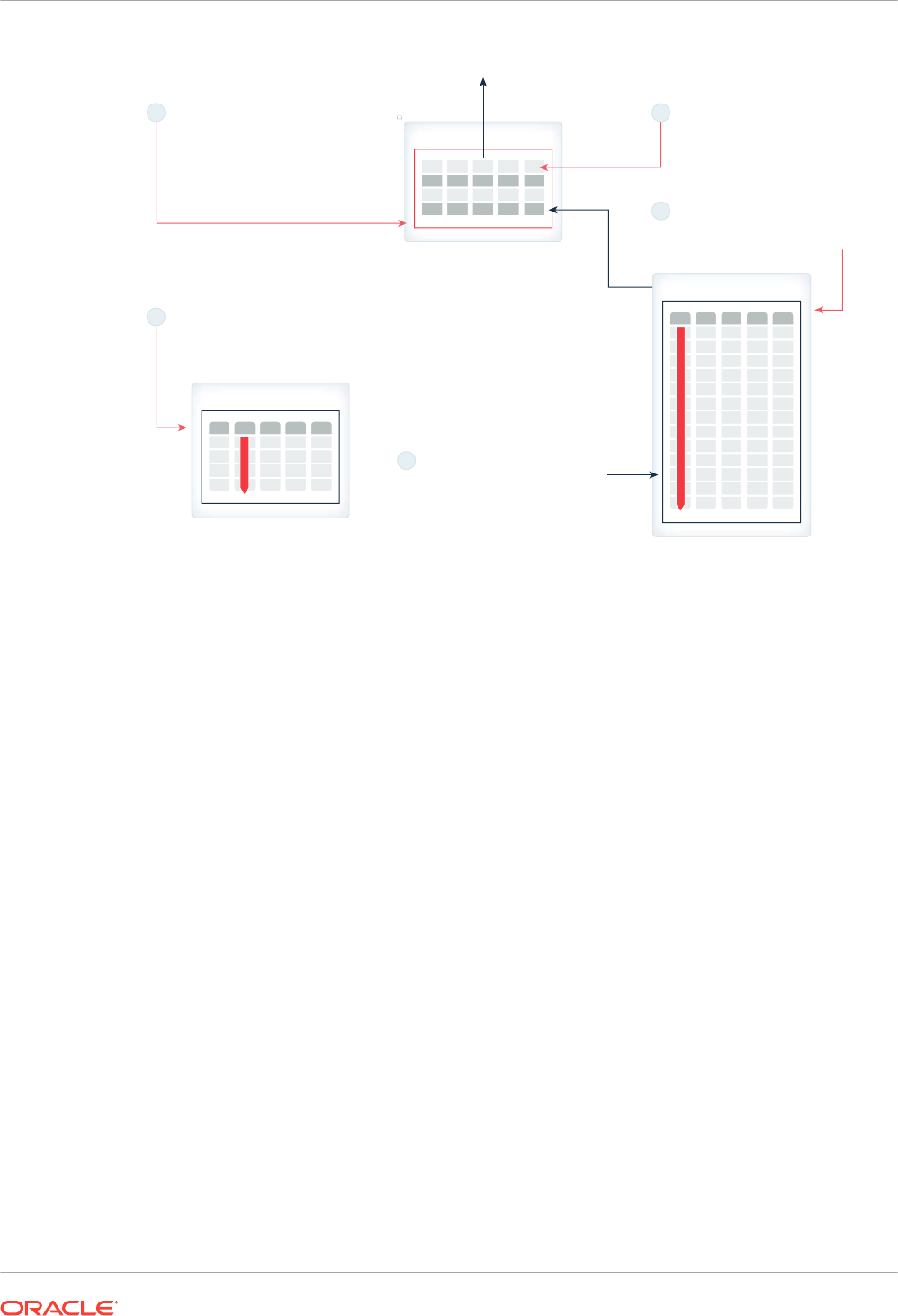
Figure 8-1 Hash Join without Join Group
Vehicles Table
1
2
Table Scan
Scan the table, decompress
matching rows, and then
send them to the hash join
Hash Table
Build a hash table using
uncompressed join column
values from VEHICLES
5
PGA
Hash Join
Use the vehicle ID to
probe the hash table
and find matching
rows
4
Row Sent to Hash Join
Decompress only matching
rows, hash them, and then
send to hash join
Sales
3
Table Scan
Scan SALES, and filter rows
based on query predicates
The database performs a hash join as follows:
1. Scans the
vehicles
table, decompresses the rows that satisfy the predicate (in this case,
all rows satisfy the predicate because no filters exist), and sends the rows to the hash join
2. Builds a hash table in the PGA based on the decompressed rows
3. Scans the
sales
table and applies any filters (in this case, the query does not specify
filters)
4. Processes matching rows from the IMCUs and then sends the rows to the join
When the hash join can consume row sets from the probe side (in this case, the
sales
table), the row sets sent by the table scan are in compressed form. Depending on whether
the local dictionary or join group is leveraged to find matching rows from the build side, the
hash join either decompresses the rows or leaves them uncompressed.
5. Probes the hash table using the join column, which in this case is the vehicle name
If a join group exists on the
v.name
and
s.name
columns, then the database can make the
preceding steps more efficient, eliminating the decompression and filtering overhead. The
benefits of join groups are:
• The database operates on compressed data.
• The database avoids hashing on the join key and probing the hash table, which requires
comparing the join keys of the probe rows and hashed rows.
When a join group exists, the database stores codes for each join column value in a
common dictionary. The database builds a join group array using dictionary codes. Every
array element points to a build-side row stored in the hash area (typically, PGA memory).
During the probe, each probe row has a code associated with the join key. The database
uses this code to search the array to determine whether a pointer exists in the array
element. If a pointer exists, then there is a match; otherwise, there is no match.
Chapter 8
Optimizing Joins with Join Groups
8-3

• The dictionary codes are dense and have a fixed length, which makes them space
efficient.
• Optimizing a query with a join group is sometimes possible when it is not possible to use a
Bloom filter.
8.2.3 How Join Groups Work
In a join group, the database compresses all columns in the join group using the same
common dictionary.
8.2.3.1 How a Join Group Uses a Common Dictionary
A common dictionary is a table-level set of dictionary codes.
A common dictionary is instance-specific on single-instance Oracle databases and on Oracle
RAC One Node databases. On an Oracle RAC cluster it is a global dictionary distributed
across all nodes of the cluster.
The database automatically creates a common dictionary in the IM column store when a join
group is defined on the underlying columns. The common dictionary enables the join columns
to share the same dictionary codes.
A common dictionary provides the following benefits:
• Encodes the values in the local dictionaries with codes from the common dictionary, which
provides compression and increases the cache efficiency of the IMCU
• Enables joins to use dictionary codes to construct and probe the data structures used
during hash joins
• Enables the optimizer to obtain statistics such as cardinality, distribution of column values,
and so on
The following figure illustrates a common dictionary that corresponds to a join group created on
the
sales.name
and
vehicles.name
columns.
Chapter 8
Optimizing Joins with Join Groups
8-4

Figure 8-2 Common Dictionary for a Join Group
6
3
0
5
IMCU
2
3
4
1
IMCU
Vehicles Table
4
3
0
5
IMCU
4
3
6
5
IMCU
Sales Table
2
3
4
1
IMCU
4
6
3
1
IMCU
0
3
2
4
IMCU
4
2
3
1
IMCU
4
6
3
1
IMCU
0
3
2
4
IMCU
1
3
5
6
IMCU
2
0
4
5
IMCU
1
2
5
0
IMCU
1
6
5
5
IMCU
2
1
4
5
IMCU
2
3
4
6
IMCU
1
5
4
0
IMCU
6
3
4
2
IMCU
2
3
4
2
IMCU
1
5
4
0
IMCU
Audi
BMW
CADILLAC
PORSCHE
TESLA
VW
0
Name ID
1
2
4
5
6
Common Dictionary
FORD 3
When the database uses a common dictionary, the local dictionary for each CU does not store
the original values:
AUDI
,
BMW
,
CADILLAC
,
FORD
, and so on. Instead, the local dictionary stores
references to the values stored in the common dictionary. For example, the local dictionary
might store the value
101
for
Audi
and
220
for
BMW
. The common dictionary might store the
value
0
for
Audi
and
1
for
BMW
. The
101
(AUDI) in the local dictionary is a pointer to the
0
(AUDI) in the common dictionary.
8.2.3.2 How a Join Group Optimizes Scans
The key optimization is joining on common dictionary codes instead of column values, thereby
avoiding the use of a hash table for the join.
Consider the following query, which uses a join group to join
vehicles
and
sales
on the
name
column:
SELECT v.year, v.name, s.sales_price
FROM vehicles v, sales s
WHERE v.name = s.name
AND v.name IN ('Audi', 'BMW', 'Porsche', 'VW');
The following figure illustrates how the join benefits from the common dictionary created on the
join group.
Chapter 8
Optimizing Joins with Join Groups
8-5
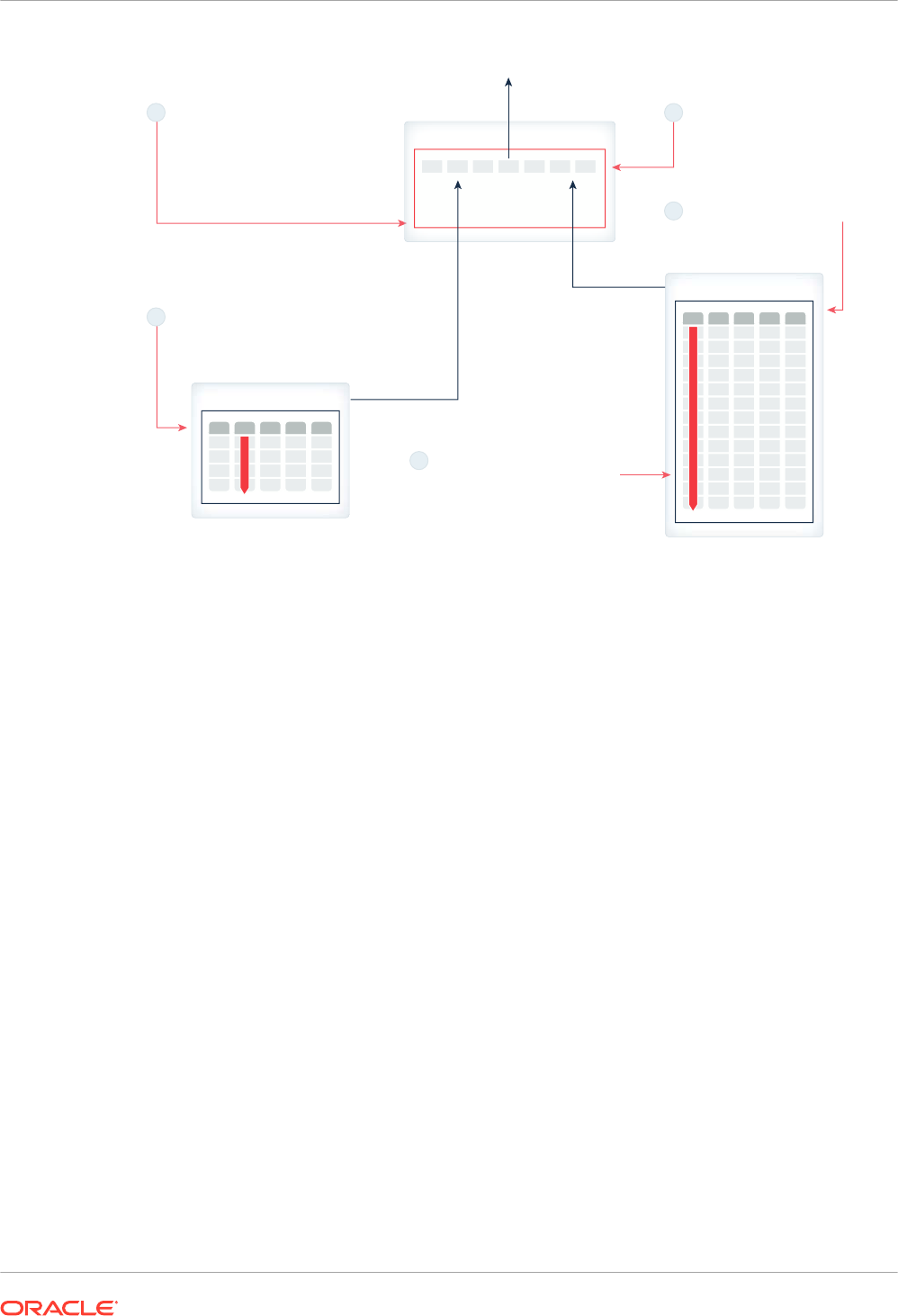
Figure 8-3 Hash Join with Join Group
Vehicles Table
1
2
Table Scan
Scan VEHICLES, and send
matching join column values
in compressed format
Array of compressed values
Create an array of distinct
values from the compressed
values
5
PGA
Hash Join
Complete join by
looking up compressed
values in the array
4
Row Sent to Hash Join
Send matching rows to
join in compressed
format
Sales
3
Table Scan
Scan SALES, and filter rows
based on query predicates
1 1 0 0 1 0 1
As illustrated in the preceding diagram, the database performs a hash join on the compressed
data as follows:
1. Scans the
vehicles
table, and sends the dictionary codes (not the original column values)
to the hash join:
0
(Audi),
1
(BMW),
2
(Cadillac), and so on
2. Builds an array of distinct common dictionary codes in the PGA
3. Scans the
sales
table and applies any filters (in this case, the filter is for German cars
only)
4. Sends matching rows to the join in compressed format
5. Looks up corresponding values in the array rather than probing a hash table, thus avoiding
the need to compute a hash function on the join key columns
In this example, the
vehicles
table has only seven rows. The
vehicles.name
column has the
following values:
Audi
BMW
Cadillac
Ford
Porsche
Tesla
VW
Chapter 8
Optimizing Joins with Join Groups
8-6

The common dictionary assigns a dictionary code to each distinct value. Conceptually, the
common dictionary looks as follows:
Audi 0
BMW 1
Cadillac 2
Ford 3
Porsche 4
Tesla 5
VW 6
The database scans
vehicles.name
, starting at the first dictionary code in the first IMCU and
ending at the last code in the last IMCU. It stores a
1
for every row that matches the filter
(German cars only), and
0
for every row that does not match the filter. Conceptually, the array
might look as follows:
array[0]: 1
array[1]: 1
array[2]: 0
array[3]: 0
array[4]: 1
array[5]: 0
array[6]: 1
The database now scans the
sales
fact table. To simplify the example, assume that the
sales
table only has 6 rows. The database scans the rows as follows (the common dictionary code
for each value is shown in parentheses):
Cadillac (2)
Cadillac (2)
BMW (1)
Ford (3)
Audi (0)
Tesla (5)
The database then proceeds through the
vehicles.name
array, looking for matches. If a row
matches, then the database sends the matching row with its associated common dictionary
code, and retrieves the corresponding column value from the
vehicles.name
and
sales.name
IMCUs:
2 -> array[2] is 0, so no join
2 -> array[2] is 0, so no join
1 -> array[1] is 1, so join
3 -> array[3] is 0, so no join
0 -> array[0] is 1, so join
5 -> array[5] is 0, so no join
8.2.4 When a Hash Join Uses Common Dictionary Encodings
Joins on columns in a join group typically see a performance benefit.
At join group creation, the database does the following:
Chapter 8
Optimizing Joins with Join Groups
8-7

• Caches the hash of the dictionary values for the join key columns
• Caches the binary representation of the
NUMBER
data for the join key columns
• Encodes columns with the same common dictionary
A join on columns in a join group always uses the first two optimizations to improve
performance. For example, if the optimizer chooses a hash join, then the query uses the
cached hash values to probe the bloom filter. If the query uses an IM aggregation join, then the
query uses the cached binary number to index into the key vector.
A hash join may or may not use dictionary encodings. When dictionary encodings are present
in at least one column of the hash join, the query can leverage the encodings in the following
ways:
• Join group-aware hash join
Both columns in the hash join carry common dictionary encoding data during runtime. The
execution plan must show either a parallel hash join plan without any distribution involved
from both sides of the hash join, or a serial hash join plan.
• Encoding-aware hash join
One fact table column in the hash join carries dictionary encoding data during runtime. The
execution plan must show either a parallel hash join without any distribution from the right
side of the hash join, or a serial hash join plan. In some cases, if the common dictionary
has good compression ratio, and if a parallel hash join plan cannot leverage a join group-
aware hash join (for example, in a parallel broadcast-none plan), then the query can use
an encoding-aware hash join for the common dictionary.
In a SQL Monitor report, the following fields show dictionary usage:
Columnar Encodings
Observed
, and
Columnar Encodings Leveraged
. The statistics are cumulative. In a parallel
hash join, the fields summarize statistics collected from all child processes involved in
executing a row source. In the context of the local dictionary in an IMCU, the statistics show
the number of encoding IDs observed from the right child row source and the number of
encodings leveraged by the join. If a hash join on a single process leverages the common
dictionary, then
Columnar Encodings Leveraged
shows the number of encodings leveraged in
the join.
The following table indicates the possible values for
Columnar Encodings Observed
and
Columnar Encodings Leveraged
, and what the combinations mean.
Table 8-1 Join Group Usage in a SQL Monitor Report
Columnar Encodings
Observed
Columnar Encodings
Leveraged
Encoding-Aware Hash
Join Used?
Join Group-Aware
Hash Join Used?
Not present Not present No No
Positive value Not present No No
Positive value Positive value Yes No
Not present Positive value No Yes
For example, if the report shows that the
Columnar Encodings Leveraged
field is
4
(for
example, because the parallel degree is 4) but the
Columnar Encodings Observed
field is
absent, then the query leveraged the join group for the hash join. If the
Columnar Encodings
Observed
field is
4
but the
Columnar Encodings Leveraged
field is absent, then dictionary
encodings existed, but the query did not use them.
Chapter 8
Optimizing Joins with Join Groups
8-8

Various factors can prevent a query from engaging an encoding-aware hash join. Factors
include the following:
• The compression ratio of the common dictionary is suboptimal.
• The query observes too many row sets passed from the table scan without a common
dictionary.
• The build-side row length is too large.
• The build-side rows cannot fit into PGA memory.
• The build side has duplicate join keys.
See Also:
"Monitoring Join Group Usage"
8.2.5 Creating Join Groups
Define join groups using the
CREATE INMEMORY JOIN GROUP
statement.
Candidates for join groups are columns that are frequently paired in a join predicate. Typical
examples include a column joining a fact and dimension table, or a column joining a table to
itself.
The
CREATE INMEMORY JOIN GROUP
statement immediately defines a join group, which means
that its metadata is visible in the data dictionary. The database does not immediately construct
the common dictionary. Rather, the database builds the common dictionary the next time that a
table referenced in the join group is populated or repopulated in the IM column store.
Guidelines
Creating, modifying, or dropping a join group typically invalidates all the underlying tables
referenced in the join group. Thus, Oracle recommends that you create join groups before
initially populating the tables.
To create a join group:
1. In SQL*Plus or SQL Developer, log in to the database as a user with the necessary
privileges.
2. Create a join group by using a statement in the following form:
CREATE INMEMORY JOIN GROUP join_group_name ( table1(col1), table2(col2) );
For example, the following statement creates a join group named
sales_products_jg
:
CREATE INMEMORY JOIN GROUP sales_products_jg (sales(prod_id),
products(prod_id));
3. Optionally, view the join group definition by querying the data dictionary (sample output
included):
COL JOINGROUP_NAME FORMAT a18
COL TABLE_NAME FORMAT a8
Chapter 8
Optimizing Joins with Join Groups
8-9

COL COLUMN_NAME FORMAT a7
SELECT JOINGROUP_NAME, TABLE_NAME, COLUMN_NAME, GD_ADDRESS
FROM DBA_JOINGROUPS;
JOINGROUP_NAME TABLE_NA COLUMN_ GD_ADDRESS
------------------ -------- ------- ----------------
SALES_PRODUCTS_JG SALES PROD_ID 00000000A142AE50
SALES_PRODUCTS_JG PRODUCTS PROD_ID 00000000A142AE50
4. Populate the tables referenced in the join group, or repopulate them if they are currently
populated.
Example 8-2 Optimizing a Query Using a Join Group
In this example, you log in to the database as
SYSTEM
, and then create a join group on the
prod_id
column of
sales
and
products
, which are not yet populated in the IM column store:
CREATE INMEMORY JOIN GROUP
sh.sales_products_jg (sh.sales(prod_id), sh.products(prod_id));
You enable the
sh.sales
and
sh.products
tables for population in the IM column store:
ALTER TABLE sh.sales INMEMORY;
ALTER TABLE sh.products INMEMORY;
The following query indicates the tables are not yet populated in the IM column store (sample
output included):
COL OWNER FORMAT a3
COL NAME FORMAT a10
COL STATUS FORMAT a20
SELECT OWNER, SEGMENT_NAME NAME,
POPULATE_STATUS STATUS
FROM V$IM_SEGMENTS;
no rows selected
Query both tables to populate them in the IM column store:
SELECT /*+ FULL(s) NO_PARALLEL(s) */ COUNT(*) FROM sh.sales s;
SELECT /*+ FULL(p) NO_PARALLEL(p) */ COUNT(*) FROM sh.products p;
The following query indicates the tables are now populated in the IM column store (sample
output included):
COL OWNER FORMAT a3
COL NAME FORMAT a10
COL PARTITION FORMAT a13
COL STATUS FORMAT a20
SELECT OWNER, SEGMENT_NAME NAME, PARTITION_NAME PARTITION,
POPULATE_STATUS STATUS, BYTES_NOT_POPULATED
Chapter 8
Optimizing Joins with Join Groups
8-10

FROM V$IM_SEGMENTS;
OWN NAME PARTITION STATUS BYTES_NOT_POPULATED
--- ---------- ------------- -------------------- -------------------
SH SALES SALES_Q3_1998 COMPLETED 0
SH SALES SALES_Q4_2001 COMPLETED 0
SH SALES SALES_Q4_1999 COMPLETED 0
SH PRODUCTS COMPLETED 0
SH SALES SALES_Q1_2001 COMPLETED 0
SH SALES SALES_Q1_1999 COMPLETED 0
SH SALES SALES_Q2_2000 COMPLETED 0
SH SALES SALES_Q2_1998 COMPLETED 0
SH SALES SALES_Q3_2001 COMPLETED 0
SH SALES SALES_Q3_1999 COMPLETED 0
SH SALES SALES_Q4_2000 COMPLETED 0
SH SALES SALES_Q4_1998 COMPLETED 0
SH SALES SALES_Q1_2000 COMPLETED 0
SH SALES SALES_Q1_1998 COMPLETED 0
SH SALES SALES_Q2_2001 COMPLETED 0
SH SALES SALES_Q2_1999 COMPLETED 0
SH SALES SALES_Q3_2000 COMPLETED 0
Query
DBA_JOINGROUPS
to get information about the join group (sample output included):
COL JOINGROUP_NAME FORMAT a18
COL TABLE_NAME FORMAT a8
COL COLUMN_NAME FORMAT a7
SELECT JOINGROUP_NAME, TABLE_NAME, COLUMN_NAME, GD_ADDRESS
FROM DBA_JOINGROUPS;
JOINGROUP_NAME TABLE_NA COLUMN_ GD_ADDRESS
------------------ -------- ------- ----------------
SALES_PRODUCTS_JG SALES PROD_ID 00000000A142AE50
SALES_PRODUCTS_JG PRODUCTS PROD_ID 00000000A142AE50
The preceding output shows that the join group
sales_products_jg
joins on the same
common dictionary address.
See Also:
• Oracle Database SQL Language Reference to learn about the
CREATE INMEMORY
JOIN GROUP
statement
• Oracle Database Reference to learn about the
DBA_JOINGROUPS
view
Chapter 8
Optimizing Joins with Join Groups
8-11

8.2.6 Monitoring Join Group Usage
To determine whether queries are using the join group, you can use either a graphical SQL
Monitor report (recommended) or a SQL query that uses the
DBMS_SQLTUNE.REPORT_SQL_MONITOR_XML
function.
"When a Hash Join Uses Common Dictionary Encodings" explains how to interpret the SQL
Monitor output.
Prerequisites
To monitor join groups, you must meet the following prerequisites:
• A join group must exist.
• The columns referenced by the join group must have been populated after join group
creation.
• You must execute a join query that could potentially use the join group.
To monitor join group usage:
1. Log in to the database as a user with the necessary privileges.
2. Create a SQL*Plus variable to store the SQL ID as follows:
VAR b_sqlid VARCHAR2(13)
3. Execute a query that joins on the columns in the join group.
4. Use either following techniques:
• Graphical SQL Monitor Report
SQL Monitor reports are available in Enterprise Manager. In SQL*Plus, you can use
DBMS_SQL_MONITOR.REPORT_SQL_MONITOR
to generate a SQL Monitor report as follows:
SET TRIMSPOOL ON
SET TRIM ON
SET PAGES 0
SET LINESIZE 1000
SET LONG 1000000
SET LONGCHUNKSIZE 1000000
SPOOL /tmp/long_sql.htm
SELECT DBMS_SQL_MONITOR.REPORT_SQL_MONITOR(
sql_id => :b_sqlid,
report_level => 'ALL',
TYPE => 'active')
FROM DUAL;
SPOOL OFF
Access the report in a browser, and then click the binoculars icon on the hash join to
view the join group statistics.
• Command-Line Query
Chapter 8
Optimizing Joins with Join Groups
8-12

Use the
DBMS_SQLTUNE.REPORT_SQL_MONITOR_XML
function in a query, as shown in the
following example:
SELECT
encoding_hj.rowsource_id row_source_id,
CASE
WHEN encoding_hj.encodings_observed IS NULL
AND encoding_hj.encodings_leveraged IS NOT NULL
THEN
'join group was leveraged on ' ||
encoding_hj.encodings_leveraged || ' processes'
ELSE
'join group was NOT leveraged'
END columnar_encoding_usage_info
FROM
(SELECT
DBMS_SQLTUNE.REPORT_SQL_MONITOR_XML(session_id=>-1,sql_id=>:b_sqlid).
EXTRACT(q'#//operation[@name='HASH JOIN' and @parent_id]#')
xmldata
FROM DUAL) hj_operation_data,
XMLTABLE('/operation'
PASSING hj_operation_data.xmldata
COLUMNS
"ROWSOURCE_ID" NUMBER PATH '@id',
"ENCODINGS_LEVERAGED" NUMBER PATH 'rwsstats/stat[@id="9"]',
"ENCODINGS_OBSERVED" NUMBER PATH 'rwsstats/stat[@id="10"]')
encoding_hj;
8.2.6.1 Monitoring Join Groups Using a SQL Monitor Report: Example
Your goal is to use a graphical SQL Monitor report to determine whether a query leveraged a
join group.
In this example, you create a join group on the
prod_id
columns of
sh.products
and
sh.sales
tables, and then join these tables on this column. You grant the
sh
account administrative
privileges.
Example 8-3 Monitoring a Join Group Using a SQL Monitor Report
1. In SQL*Plus, log in to the database as user
sh
.
2. Create a SQL*Plus variable to store the SQL ID as follows:
VAR b_sqlid VARCHAR2(13)
3. Apply the
INMEMORY
attribute to the
sh.products
and
sh.sales
tables as follows:
ALTER TABLE sales NO INMEMORY;
ALTER TABLE products NO INMEMORY;
ALTER TABLE sales INMEMORY MEMCOMPRESS FOR QUERY;
ALTER TABLE products INMEMORY MEMCOMPRESS FOR QUERY;
Chapter 8
Optimizing Joins with Join Groups
8-13

4. Create a join group on
prod_id
:
CREATE INMEMORY JOIN GROUP jgrp_products_sales (products(prod_id),
sales(prod_id));
5. Scan the tables to populate them in the IM column store:
SELECT /*+ FULL(s) */ COUNT(*) FROM sales s;
SELECT /*+ FULL(p) */ COUNT(*) FROM products p;
6. Execute a query that joins on the
prod_id
column, and then aggregates product sales:
SELECT /*+ USE_HASH(sales) LEADING(products sales) MONITOR */
products.prod_id,
products.prod_category_id, SUM(sales.amount_sold)
FROM products, sales
WHERE products.prod_id = sales.prod_id
GROUP BY products.prod_category_id, products.prod_id;
7. Generate an HTML-based SQL Monitor report by using
DBMS_SQLTUNE.REPORT_SQL_MONITOR
.
For example, create a SQL script with the following contents, and run it in SQL*Plus:
SET TRIMSPOOL ON
SET TRIM ON
SET PAGES 0
SET LINESIZE 1000
SET LONG 1000000
SET LONGCHUNKSIZE 1000000
SPOOL /tmp/jg_report.htm
SELECT DBMS_SQL_MONITOR.REPORT_SQL_MONITOR(
sql_id => :b_sqlid,
report_level => 'ALL',
TYPE => 'active')
FROM DUAL;
SPOOL OFF
8. Open the HTML report in a browser.
The following sample report shows the execution plan for the join. The binoculars in the
hash join open a window that shows additional statistics.
Chapter 8
Optimizing Joins with Join Groups
8-14
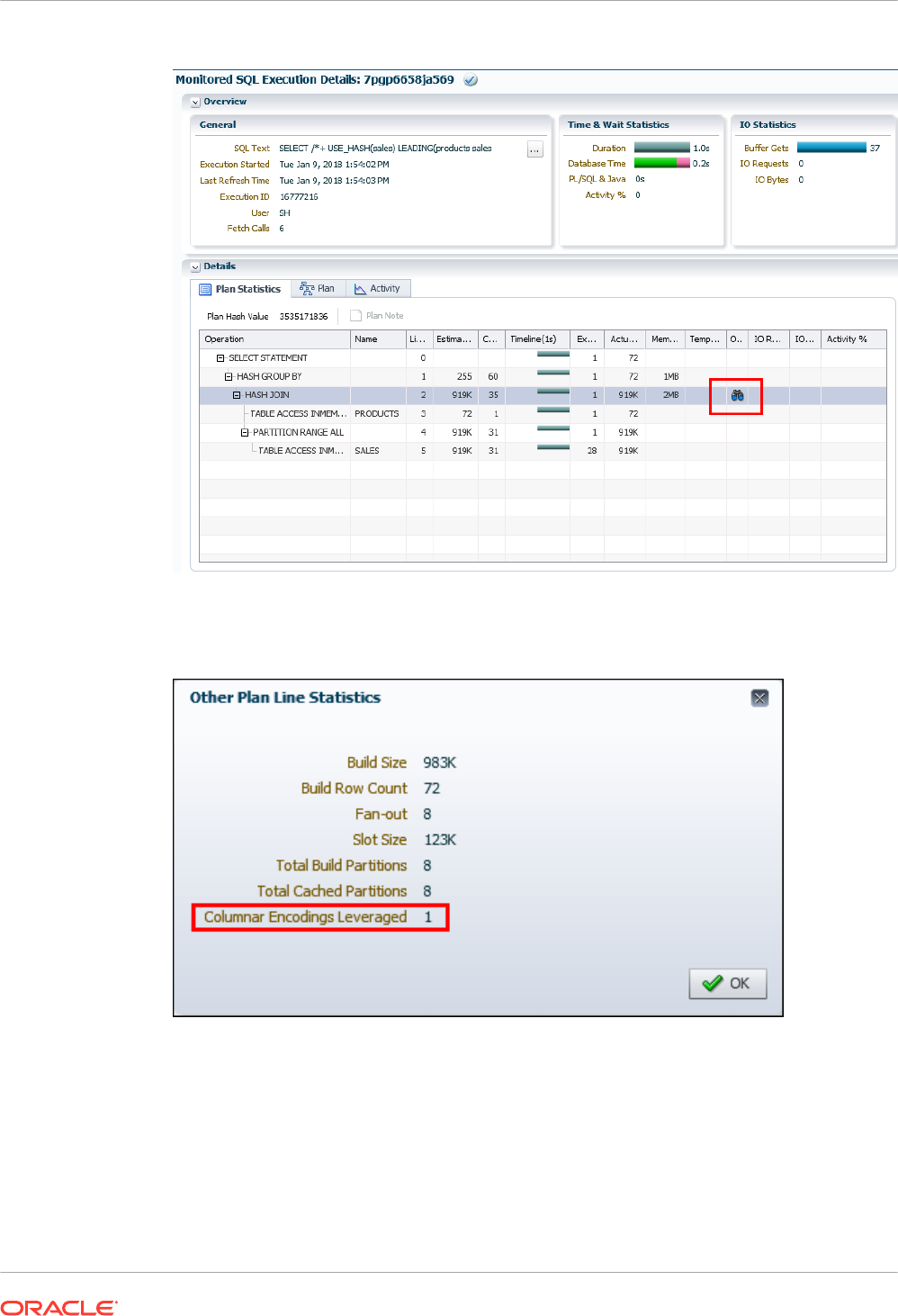
Figure 8-4 Monitored SQL Execution Details Page
9. Click the binoculars icon to open a window that shows join group statistics.
The following sample window shows the statistics:
Because
Columnar Encodings Leveraged
is a positive value and
Columnar Encodings
Observed
is not present, the join group was leveraged.
10. Optionally, clean up after the example:
DROP INMEMORY JOIN GROUP jgrp_products_sales;
ALTER TABLE sales NO INMEMORY;
ALTER TABLE products NO INMEMORY;
Chapter 8
Optimizing Joins with Join Groups
8-15

See Also:
• "When a Hash Join Uses Common Dictionary Encodings"
• Oracle Database PL/SQL Packages and Types Reference to learn about the
DBMS_SQLTUNE.REPORT_SQL_MONITOR_XML
function
• Oracle Database Reference to learn about the
V$SESSION
view
8.2.6.2 Monitoring Join Groups from the Command Line: Example
Your goal is to use command-line tools to determine whether a query leveraged a join group.
In this example, you create a join group on the
prod_id
columns of
sh.products
and
sh.sales
tables, and then join these tables on this column. You grant the
sh
account administrative
privileges.
Example 8-4 Monitoring a Join Group from the Command Line
1. Log in to the database as
sh
.
2. Create a SQL*Plus variable to store the SQL ID as follows:
VAR b_sqlid VARCHAR2(13)
3. Apply the
INMEMORY
attribute to the
sh.products
and
sh.sales
tables as follows:
ALTER TABLE sales NO INMEMORY;
ALTER TABLE products NO INMEMORY;
ALTER TABLE sales INMEMORY MEMCOMPRESS FOR QUERY;
ALTER TABLE products INMEMORY MEMCOMPRESS FOR QUERY;
4. Create a join group on
prod_id
:
CREATE INMEMORY JOIN GROUP jgrp_products_sales (products(prod_id),
sales(prod_id));
5. Scan the tables to populate them in the IM column store:
SELECT /*+ FULL(s) */ COUNT(*) FROM sales s;
SELECT /*+ FULL(p) */ COUNT(*) FROM products p;
6. Execute a query that joins on the
prod_id
column, and then aggregates product sales:
SELECT /*+ USE_HASH(sales) LEADING(products sales) MONITOR */
products.prod_id,
products.prod_category_id, SUM(sales.amount_sold)
FROM products, sales
WHERE products.prod_id = sales.prod_id
GROUP BY products.prod_category_id, products.prod_id;
Chapter 8
Optimizing Joins with Join Groups
8-16

7. Obtain the SQL ID of the preceding aggregation query:
BEGIN
SELECT PREV_SQL_ID
INTO :b_sqlid
FROM V$SESSION
WHERE SID=USERENV('SID');
END;
8. Use
DBMS_SQLTUNE.REPORT_SQL_MONITOR_XML
to determine whether the database used the
join group.
For example, execute the following query:
COL row_source_id FORMAT 999
COL columnar_encoding_usage_info FORMAT A40
SELECT
encoding_hj.rowsource_id row_source_id,
CASE
WHEN encoding_hj.encodings_observed IS NULL
AND encoding_hj.encodings_leveraged IS NOT NULL
THEN
'join group was leveraged on ' || encoding_hj.encodings_leveraged
|| ' processes'
ELSE
'join group was NOT leveraged'
END columnar_encoding_usage_info
FROM
(SELECT
DBMS_SQLTUNE.REPORT_SQL_MONITOR_XML(session_id=>-1,sql_id=>:b_sqlid).
EXTRACT(q'#//operation[@name='HASH JOIN' and @parent_id]#')
xmldata
FROM DUAL
) hj_operation_data,
XMLTABLE('/operation'
PASSING hj_operation_data.xmldata
COLUMNS
"ROWSOURCE_ID" NUMBER PATH '@id',
"ENCODINGS_LEVERAGED" NUMBER PATH 'rwsstats/stat[@id="9"]',
"ENCODINGS_OBSERVED" NUMBER PATH 'rwsstats/stat[@id="10"]'
) encoding_hj;
The following sample output shows that the join group was leveraged in the query:
ROW_SOURCE_ID COLUMNAR_ENCODING_USAGE_INFO
------------- ----------------------------------------
2 join group was leveraged on 1 processes
9. Optionally, clean up after the example:
DROP INMEMORY JOIN GROUP jgrp_products_sales;
ALTER TABLE sales NO INMEMORY;
ALTER TABLE products NO INMEMORY;
Chapter 8
Optimizing Joins with Join Groups
8-17

See Also:
• "When a Hash Join Uses Common Dictionary Encodings"
• Oracle Database PL/SQL Packages and Types Reference to learn about the
DBMS_SQLTUNE.REPORT_SQL_MONITOR_XML
function
• Oracle Database Reference to learn about the
V$SESSION
view
8.2.7 Leveraging Join Groups on a RAC Cluster
RAC now supports dictionaries that are global across the RAC cluster.
A common dictionary is instance-specific on single-instance Oracle databases and on Oracle
RAC One Node databases. On these systems, join group aware hash joins are only enabled
for joins that do not involve row distribution.
An Oracle RAC cluster supports a distributed, global dictionary that is shared across instances
in a RAC cluster. This enables you to leverage join group aware hash joins for distributed joins
on RAC. When you issue a
CREATE INMEMORY JOIN GROUP
statement on a RAC database, a
distributed RAC-level global dictionary is created as part of the object population.
Consider the example below. A join group is created on the columns
sales.dealer_key
and
dealership.dealership_key
, which are used as join keys between the two tables. When you
create an in-memory join group comprising these tables, a common RAC-level global
dictionary is created for these columns. As you can see below, you do not need to do anything
differently in order to benefit from this enhancement.
create inmemory join group jg1 (sales(dealer_key),
dealership(deadlership_key));
Queries that access these columns can then take advantage of the join group.
select sum(revenue) from sales s, dealership d where s.dealership_key =
d.dealership_key;
Distributed RAC-level global dictionaries can enhance query performance. Performance runs
with join group aware hash joins leveraging RAC-level global dictionaries demonstrate
significant gains on the SSB (Star Schema Benchmark).
8.3 Optimizing Joins Using In-Memory Deep Vectorization
In-Memory deep vectorization can optimize complex SQL operators by pipelining the physical
operators inside each SQL operator and vectorizing them using SIMD techniques. This feature
is enabled by default.
8.3.1 About In-Memory Deep Vectorization
In-Memory deep vectorization is a SIMD-based framework that supports vectorization for
higher-level query operators in the query plan. The framework includes optimizations such as
SIMD, hardware acceleration, and pipelined execution.
Chapter 8
Optimizing Joins Using In-Memory Deep Vectorization
8-18

The In-Memory vectorized joins feature is key to the deep vectorization framework. Using
SIMD vector processing, the framework optimizes aspects of hash joins such as hashing,
building, probing, and gathering. This optimization can improve the performance of join
processing by 100% or more.
The In-Memory vectorized joins feature is transparent to the user, requiring no plan changes.
The optimization is enabled by default, but you can disable it by setting the
INMEMORY_DEEP_VECTORIZATION
initialization parameter to
false
.
See Also:
• "CPU Architecture: SIMD Vector Processing" to learn more about SIMD
vectorization
• Oracle Database SQL Tuning Guide to learn more about hash joins
8.3.2 How In-Memory Deep Vectorization Works
The In-Memory deep vectorization framework deconstructs high-level, complex SQL operators
such as hash joins into smaller kernel-sized units.
The deconstructed kernels are suitable for SIMD vectorization techniques. The database
executes the kernels in a pipelined fashion to accelerate the overall operation.
See Also:
"CPU Architecture: SIMD Vector Processing" to learn more about SIMD vectorization
8.3.3 How an In-Memory Vectorized Join Works
The vectorized joins feature is a key aspect of the In-Memory deep vectorization framework.
An In-Memory vectorized join works as follows:
1. At run time, the database decides whether a hash join would benefit from In-Memory deep
vectorization. If so, the database proceeds to the next step.
Note:
Because selection of the vectorized joins operation occurs at runtime, the
execution plan does not show the optimization.
2. The database pushes down join processing to the scan operators for evaluation directly on
In-Memory columnar data formats.
3. The operation uses a SIMD-optimized hash table data structure instead of a traditional
hash table.
4. The database determines matched rows from the left and right side of the join, and sends
them back to the parent SQL operator using vectorization techniques.
Chapter 8
Optimizing Joins Using In-Memory Deep Vectorization
8-19

An In-Memory vectorized join may leverage In-Memory features such as the following:
• Join groups
If a join group is declared, then join processing with deep vectorization may be significantly
faster.
• IM dynamic scans
Join processing is parallelized further in scan operators using lightweight threads.
• Aggregation pushdown
Aggregations on top of joins are vectorized with the join operation.
• In-Memory columnar compression formats
The vectorized joins feature heavily leverages columnar data formats.
See Also:
• "In-Memory Dynamic Scans"
• "Optimizing In-Memory Aggregation with VECTOR GROUP BY"
• "Optimizing Joins with Join Groups"
8.3.4 User Interface for Deep Vectorization
The deep vectorization framework is enabled when the
INMEMORY_DEEP_VECTORIZATION
initialization parameter is
true
, which is the default value.
You can use SQL Monitor to determine whether a query used a vectorized join. In a SQL
Monitor report, click the binoculars icon next to the
HASH JOIN
operation in the Information
column. If
DeepVec Hash Joins
has the value
1
, then the query used deep vectorization;
otherwise, the query did not use it.
8.3.5 Query Types Supported by the Deep Vectorization Framework
Queries containing the following are supported by the In-Memory Deep Vectorization
Framework:
• Multiple join key columns
• Semi join and outer join
• These function-based aggregations:
Aggregations are also fully supported. This includes:
• Columns from the build side, or combination of build and probe sides.
• Simple expressions grouping columns or aggregates.
Chapter 8
Optimizing Joins Using In-Memory Deep Vectorization
8-20

8.3.6 In-Memory Vectorized Join: Example
This example indicates how a hash join benefits from deep vectorization.
In this example, a
customers
and
orders
table exist, and
INMEMORY_DEEP_VECTORIZATION
is
currently set to
false
. Your goal is to count the orders within a single nation, making use of the
deep vectorization optimizations if possible.
1. Log in to the database as administrative user
DB1
.
2. Using
ALTER SESSION
, set the
INMEMORY_DEEP_VECTORIZATION
initialization parameter to
ENABLE
.
3. Join the
tpch.customer
and
tpch.orders
tables as follows, filtering on the value
21
in the
tpch.customer.c_nationkey
column:
SELECT /*+monitor */ COUNT(*)
FROM tpch.customer c, tpch.orders o
WHERE c.c_custkey = o.o_custkey
AND c.c_nationkey = 21
4. To create a SQL Monitor report in HTML, pass the SQL ID to
DBMS_SQL_MONITOR.REPORT_SQL_MONITOR
.
See "Monitoring Join Group Usage" for an example showing how to generate the report.
5. Open the SQL Monitor report in a browser.
The overview section of the report appears below.
Figure 8-5 Overview Section
6. In the Details section of the report, find the
HASH JOIN
operation, and then click the
binoculars icon.
Chapter 8
Optimizing Joins Using In-Memory Deep Vectorization
8-21
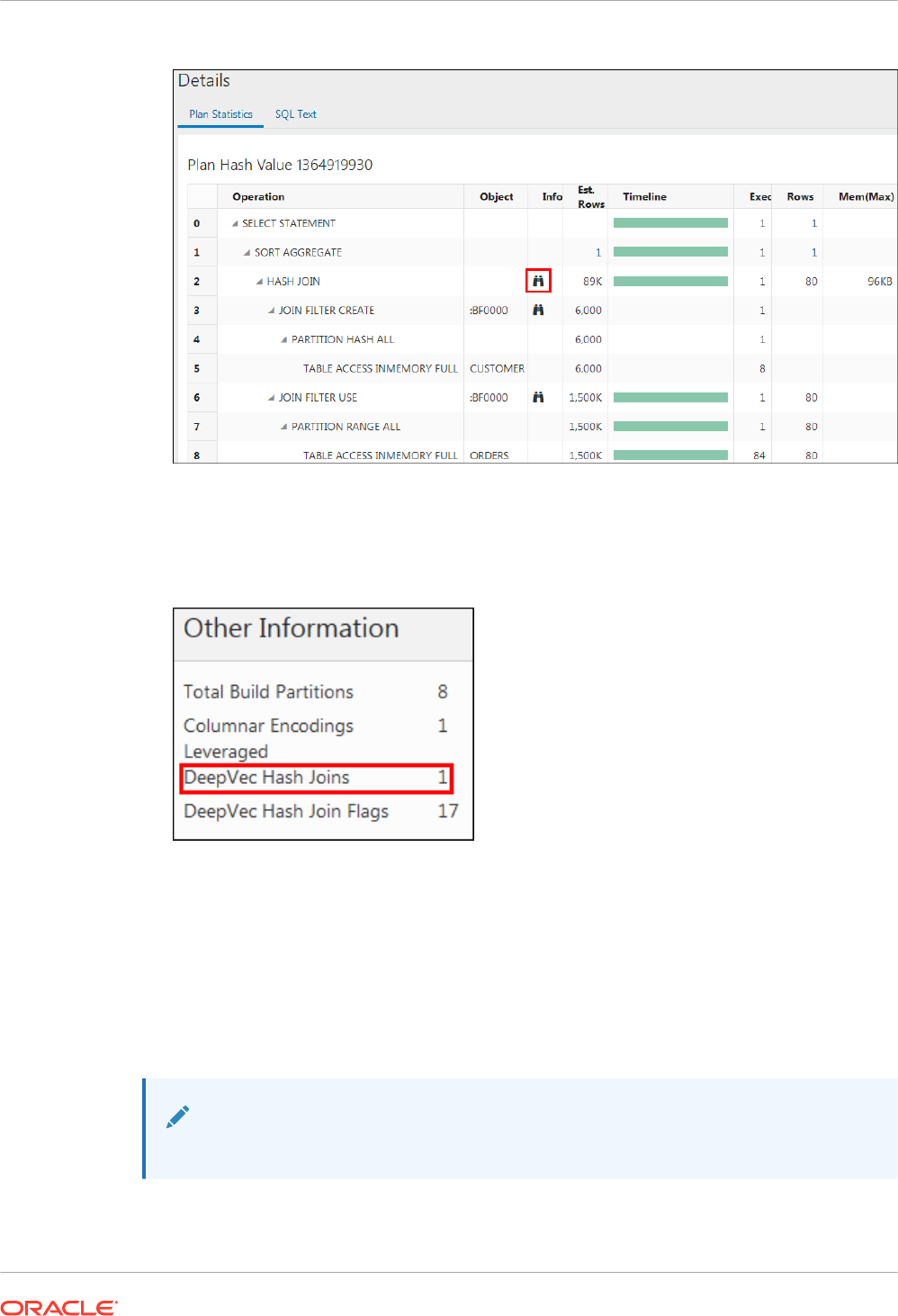
Figure 8-6 Details Section
7. In the Other Information window, look for
DeepVec Hash Joins
. Because the value is
1
, the
database used an In-Memory vectorized join.
Figure 8-7 Other Information Section
Note that
DeepVec Hash Join Flags
is an internal statistic that indicates which
optimizations deep vectorization employed.
8.3.7 In-Memory Deep Vectorization for Multi-Level Joins
In-Memory Deep Vectorization enhancements now enable support for complex queries
performing multi-table joins and aggregations.
Note:
Hash Hash hash join plans are not currently supported.
As with other aspects of In-Memory Deep Vectorization , vectorization for multi-level joins is
transparent to the user, requiring no plan changes.
Chapter 8
Optimizing Joins Using In-Memory Deep Vectorization
8-22
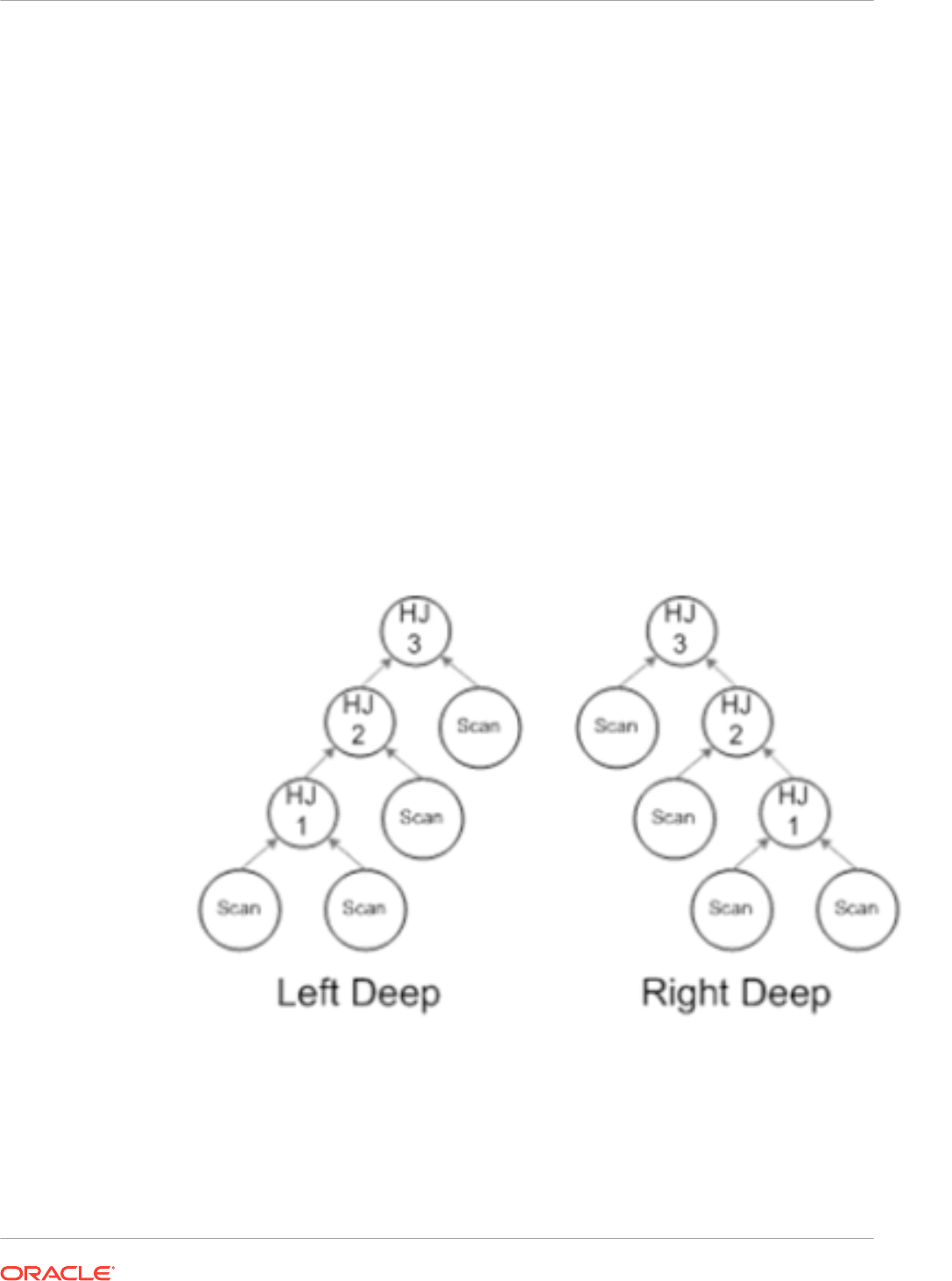
Multiple join key columns in joins like the following are supported.
select * from build, probe
where build.key1 = probe.key1
and build.key2 = probe.key2
and …
select orders_order_id, avg(lineitem_extendedprice)
from orders, lineitem
where orders.zipcode = lineitem.zipcode
and orders.city = lineitem.city
group by orders.order_id;
Types of Multi-Level Joins Supported by the Optimizer
There are two types of multi-level joins generated by the optimizer:
• Left Deep Joins
The result of each join node feeds the Build side of its parent join
• Right Deep Join
The result of each join node feeds the Probe side of its parent join
Chapter 8
Optimizing Joins Using In-Memory Deep Vectorization
8-23

9
Optimizing Aggregation
Database In-Memory provides optimizations to speed up aggregation and arithmetic.
9.1 Optimizing In-Memory Aggregation with VECTOR GROUP
BY
Starting with Oracle Database 12c Release 1 (12.1.0.2), In-Memory Aggregation (IM
aggregation) enables queries to aggregate while scanning.
9.1.1 About IM Aggregation
IM aggregation optimizes query blocks involving aggregation and joins from a large table to
multiple small tables.
The
KEY VECTOR
and
VECTOR GROUP BY
operations use efficient arrays for joins and
aggregation. The optimizer chooses
VECTOR GROUP BY
for
GROUP BY
operations based on cost.
The optimizer does not choose
VECTOR GROUP BY
aggregations for
GROUP BY ROLLUP
,
GROUPING
SETS
, or
CUBE
operations.
Note:
IM aggregation is also called vector aggregation and
VECTOR GROUP BY
aggregation.
IM aggregation requires
INMEMORY_SIZE
to be set to a nonzero value. However, IM aggregation
does not require that the referenced tables be populated in the IM column store.
See Also:
• "Enabling the IM Column Store for a CDB or PDB"
•
Oracle Database Data Warehousing Guide to learn more about SQL aggregation
9.1.2 Purpose of IM Aggregation
IM aggregation preprocesses the small tables to accelerate the per-row work performed on the
large table.
A typical analytic query aggregates from a fact table, and joins it to dimension tables. This type
of query scans a large volume of data, with optional filtering, and performs a
GROUP BY
of
between 1 and 40 columns. The first aggregation on the fact table processes the most rows.
9-1

Before Oracle Database 12c, the only
GROUP BY
operations were
HASH
and
SORT
. The
VECTOR
GROUP BY
is an additional cost-based transformation that transforms a join between a
dimension and fact table into a filter. The database can apply this filter during the fact table
scan. The joins use key vectors, which are similar to Bloom filters, and the aggregation uses a
VECTOR GROUP BY
.
Note:
Although vector transformations are independent of the IM column store, they can be
applied very efficiently to In-Memory data through SIMD vector processing.
IM aggregation enables vector joins and
GROUP BY
operations to occur simultaneously with the
scan of the large table. Thus, these operations aggregate as they scan, and do not need to
wait for table scans and join operations to complete. IM aggregation optimizes CPU usage,
especially the CPU cache.
IM aggregation can greatly improve query performance. The database can create a report
outline dynamically, and then fill in report details during the scan of the fact table.
See Also:
• "CPU Architecture: SIMD Vector Processing"
• Oracle Database SQL Tuning Guide to learn more about query transformations
9.1.2.1 When IM Aggregation Is Useful
IM aggregation improves performance of queries that join relatively small tables to a relatively
large fact table, and aggregate data in the fact table. This typically occurs in a star or
snowflake query.
Both row-store tables and tables in the IM column store can benefit from IM aggregation.
Example 9-1 VECTOR GROUP BY
Consider the following query, which performs a join of the
customers
dimension table with the
sales
fact table:
SELECT c.customer_id, s.quantity_sold, s.amount_sold
FROM customers c, sales s
WHERE c.customer_id = s.customer_id
AND c.country_id = 'FR';
When both tables are populated in the IM column store, the database can use SIMD vector
processing to scan the row sets and apply filters. The following figure shows how the query
uses vector joins. The optimizer converts the predicate on the
customers
table,
c.country_id='FR'
into a filter on the
sales
fact table. The filter is
country_id='FR'
. Because
sales
is stored in columnar format, the query only needs to scan one column to determine the
result.
Chapter 9
Optimizing In-Memory Aggregation with VECTOR GROUP BY
9-2
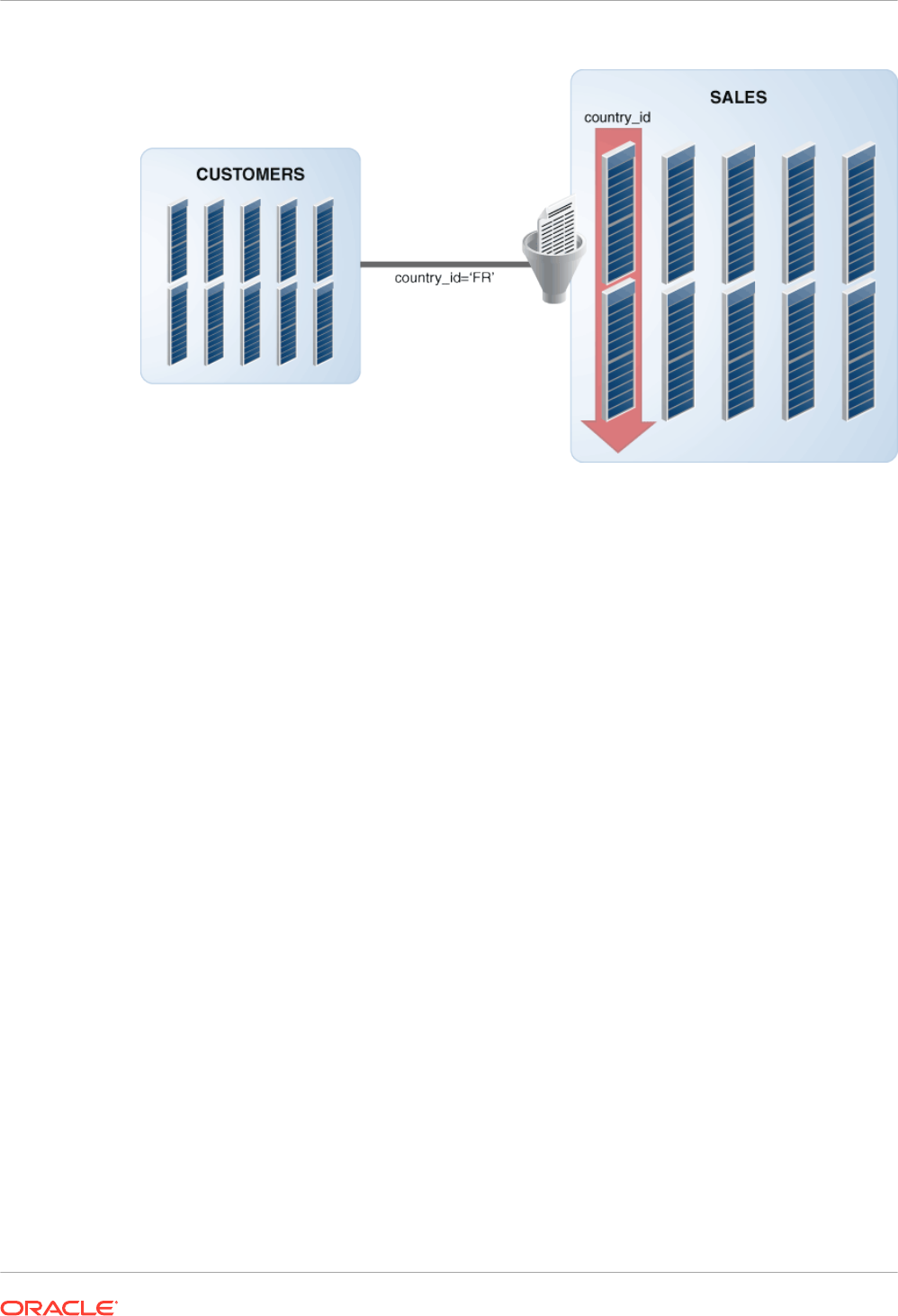
Figure 9-1 Vector Joins Using In-Memory Column Store
9.1.2.2 When IM Aggregation Is Not Beneficial
IM aggregation benefits certain star queries when sufficient system resources exist. Other
queries may receive little or no benefit.
Situations Where VECTOR GROUP BY Aggregation Is Not Advantageous
Specifically,
VECTOR GROUP BY
aggregation does not benefit performance in the following
scenarios:
• Joins are performed between two very large tables.
By default, the optimizer chooses a
VECTOR GROUP BY
transformation only if a relatively
small table is joined to a relatively large table.
• Dimensions contain more than 2 billion rows.
The
VECTOR GROUP BY
transformation is not used if a dimension contains more than 2
billion rows.
• The system does not have sufficient memory.
Most databases that use the IM column store benefit from IM aggregation.
9.1.3 How IM Aggregation Works
A typical analytic query distributes rows among processing stages.
The stages are as follows:
1. Filtering tables and producing row sets
2. Joining row sets
3. Aggregating rows
The
VECTOR GROUP BY
transformation combines the work in the different stages, converting
joins to filters and aggregating while scanning the fact table.
Chapter 9
Optimizing In-Memory Aggregation with VECTOR GROUP BY
9-3

The unit of work between stages is called a data flow operator (DFO).
VECTOR GROUP BY
aggregation uses a DFO for each dimension to create a key vector structure and temporary
table. When aggregating measure columns from the fact table, the database uses this key
vector to translate a fact join key to its dense grouping key. The late materialization step joins
on the dense grouping keys to the temporary tables.
9.1.3.1 When the Optimizer Chooses IM Aggregation
The optimizer decides whether to use vector transformation based on the size of the key vector
(that is, the distinct join keys), the number of distinct grouping keys, and other factors.
The optimizer tends to choose this transformation when dimension join keys have low
cardinality. Oracle Database uses
VECTOR GROUP BY
aggregation to perform data aggregation
when the following conditions are met:
• The queries or subqueries aggregate data from a fact table and join the fact table to one or
more dimensions.
Multiple fact tables joined to the same dimensions are also supported assuming that these
fact tables are connected only through joins to the dimension. In this case,
VECTOR GROUP
BY
aggregates fact table separately and then joins the results on the grouping keys.
• The dimensions and fact table are connected to each other only through join columns.
Specifically, the query must not have any other predicates that refer to columns across
multiple dimensions or from both a dimension and the fact table. If a query performs a join
between two or more tables and then joins the result to the fact, then
VECTOR GROUP BY
aggregation treats the multiple dimensions as a single dimension.
Note:
You can direct the database to use
VECTOR GROUP BY
aggregation for a query by
using query block hints or table hints.
VECTOR GROUP BY
aggregation does not support the following:
• Semi-joins and anti-joins across multiple dimensions or between a dimension and the fact
table
• Equijoins across multiple dimensions
• Aggregations performed using the
DISTINCT
function
Note:
Bloom filters and
VECTOR GROUP BY
aggregation are mutually exclusive. Therefore, if
a query uses Bloom filters to join row sets, then
VECTOR GROUP BY
aggregation is not
applicable to the processing of this query.
Chapter 9
Optimizing In-Memory Aggregation with VECTOR GROUP BY
9-4

See Also:
Oracle Database Data Warehousing Guide to learn more about SQL aggregation
9.1.3.2 Key Vector
A key vector is a data structure that maps between dense join keys and dense grouping keys.
A dense key is a numeric key that is stored as a native integer and has a range of values. A
dense join key represents all join keys whose join columns come from a particular fact table or
dimension. A dense grouping key represents all grouping keys whose grouping columns come
from a particular fact table or dimension. A key vector enables fast lookups.
Example 9-2 Key Vector
Assume that the
hr.locations
table has values for
country_id
as shown (only the first few
results are shown):
SQL> SELECT country_id FROM locations;
CO
--
IT
IT
JP
JP
US
US
US
US
CA
CA
CN
A complex analytic query applies the filter
WHERE country_id='US'
to the
locations
table. A
key vector for this filter might look like the following one-dimensional array:
0
0
0
0
1
1
1
1
0
0
0
In the preceding array,
1
is the dense grouping key for
country_id='US'
. The
0
values indicate
rows in
locations
that do not match this filter. If a query uses the filter
WHERE country_id IN
Chapter 9
Optimizing In-Memory Aggregation with VECTOR GROUP BY
9-5

('US','JP')
, then the array might look as follows, where
2
is the dense grouping key for
JP
and
1
is the dense grouping key for
US
:
0
0
2
2
1
1
1
1
0
0
0
9.1.3.3 Two Phases of IM Aggregation
Typically,
VECTOR GROUP BY
aggregation processes each dimension in sequence, and then
processes the fact table.
When performing IM aggregation, the database proceeds as follows:
1. Process each dimension sequentially as follows:
a. Find the unique dense grouping keys.
b. Create a key vector.
c. Create a temporary table (
CURSOR DURATION MEMORY
).
The following figure illustrates the steps in this phase, beginning with the scan of the
dimension table in DFO 0, and ending with the creation of a temporary table. In the
simplest form of parallel
GROUP BY
or join processing, the database processes each join or
GROUP BY
in its own DFO.
Figure 9-2 Phase 1 of In-Memory Aggregation
DFO 0
DFO 1
temporary table create
KEY VECTOR CREATE
dimension scan
VECTOR GROUP BY
2. Process the fact table.
a. Process all the joins and aggregations using the key vectors created in the preceding
phase.
b. Join back the results to each temporary table.
Chapter 9
Optimizing In-Memory Aggregation with VECTOR GROUP BY
9-6
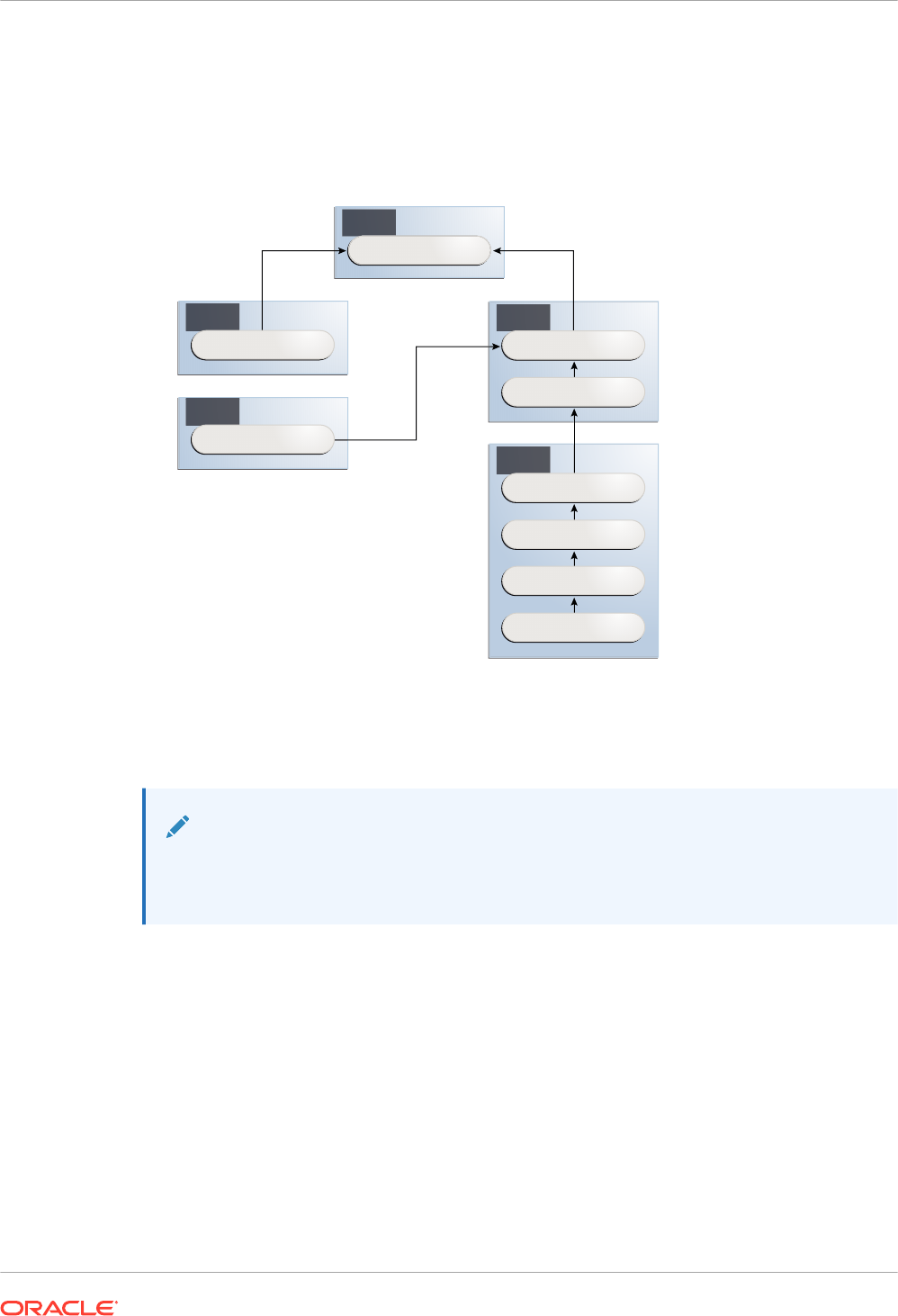
Figure 9-3 illustrates phase 2 in a join of the fact table with two dimensions. In DFO 0, the
database performs a full scan of the fact table, and then uses the key vectors for each
dimension to filter out nonmatching rows. DFO 2 joins the results of DFO 0 with DFO 1.
DFO 4 joins the result of DFO 2 with DFO 3.
Figure 9-3 Phase 2 of In-Memory Aggregation
DFO 3
DFO 1
hash join 2
DFO 4
DFO 0
DFO 2
temporary table 2
temporary table 1
hash join 1
HASH GROUP BY
fact scan
KEY VECTOR USE 1
KEY VECTOR USE 2
VECTOR GROUP BY
9.1.3.4 IM Aggregation: Scenario
This section gives a conceptual example of how
VECTOR
GROUP BY
aggregation works.
Note:
The scenario does not use the sample schema tables or show an actual execution
plan.
9.1.3.4.1 Sample Analytic Query of a Star Schema
This sample star schema in this scenario contains the
sales_online
fact table and two
dimension tables:
geography
and
products
.
Each row in
geography
is uniquely identified by the
geog_id
column. Each row in
products
is
uniquely identified by the
prod_id
column. Each row in
sales_online
is uniquely identified by
the
geog_id
,
prod_id
, and amount sold.
Chapter 9
Optimizing In-Memory Aggregation with VECTOR GROUP BY
9-7

Table 9-1 Sample Rows in geography Table
country state city geog_id
USA WA seattle 2
USA WA spokane 3
USA CA SF 7
USA CA LA 8
Table 9-2 Sample Rows in products Table
manuf category subcategory prod_id
Acme sport bike 4
Acme sport ball 3
Acme electric bulb 1
Acme electric switch 8
Table 9-3 Sample Rows in sales_online Table
prod_id geog_id amount
8 1 100
9 1 150
8 2 100
4 3 110
2 30 130
6 20 400
3 1 100
1 7 120
3 8 130
4 3 200
A manager asks the business question, "How many Acme products in each subcategory were
sold online in Washington, and how many were sold in California?" To answer this question, an
analytic query of the
sales_online
fact table joins the
products
and
geography
dimension
tables as follows:
SELECT p.category, p.subcategory, g.country, g.state, SUM(s.amount)
FROM sales_online s, products p, geography g
WHERE s.geog_id = g.geog_id
AND s.prod_id = p.prod_id
AND g.state IN ('WA','CA')
AND p.manuf = 'ACME'
GROUP BY category, subcategory, country, state
Chapter 9
Optimizing In-Memory Aggregation with VECTOR GROUP BY
9-8

9.1.3.4.2 Step 1: Key Vector and Temporary Table Creation for geography Dimension
In the first phase of
VECTOR GROUP BY
aggregation for this query, the database creates a dense
grouping key for each city/state combination for cities in the states of Washington or California.
In Table 9-6, the
1
is the
USA,WA
grouping key, and the
2
is the
USA,CA
grouping key.
Table 9-4 Dense Grouping Key for geography
country state city geog_id dense_gr_key_geog
USA WA seattle 2 1
USA WA spokane 3 1
USA CA SF 7 2
USA CA LA 8 2
A key vector for the
geography
table looks like the array represented by the final column in
Table 9-5. The values are the
geography
dense grouping keys. Thus, the key vector indicates
which rows in
sales_online
meet the
geography.state
filter criteria (a sale made in the state
of
CA
or
WA
) and which country/state group each row belongs to (either the
USA,WA
group or
USA,CA
group).
Table 9-5 Online Sales
prod_id geog_id amount key vector for geography
8 1 100 0
9 1 150 0
8 2 100 1
4 3 110 1
2 30 130 0
6 20 400 0
3 1 100 0
1 7 120 2
3 8 130 2
4 3 200 1
Internally, the database creates a temporary table similar to the following:
CREATE TEMPORARY TABLE tt_geography AS
SELECT MAX(country), MAX(state), KEY_VECTOR_CREATE(...) dense_gr_key_geog
FROM geography
WHERE state IN ('WA','CA')
GROUP BY country, state
Table 9-6 shows rows in the
tt_geography
temporary table. The dense grouping key for the
USA,WA
combination is
1
, and the dense grouping key for the
USA,CA
combination is
2
.
Chapter 9
Optimizing In-Memory Aggregation with VECTOR GROUP BY
9-9

Table 9-6 tt_geography
country state dense_gr_key_geog
USA WA 1
USA CA 2
9.1.3.4.3 Step 2: Key Vector and Temporary Table Creation for products Dimension
The database creates a dense grouping key for each distinct category/subcategory
combination of an Acme product.
For example, in Table 9-7, the
4
is the dense grouping key for an Acme electric switch.
Table 9-7 Sample Rows in products Table
manuf category subcategory prod_id dense_gr_key_prod
Acme sport bike 4 1
Acme sport ball 3 2
Acme electric bulb 1 3
Acme electric switch 8 4
A key vector for the
products
table might look like the array represented by the final column in
Table 9-8. The values represent the
products
dense grouping key. For example, the
4
represents the online sale of an Acme electric switch. Thus, the key vector indicates which
rows in
sales_online
meet the
products
filter criteria (a sale of an Acme product).
Table 9-8 Key Vector
prod_id geog_id amount key vector for products
8 1 100 4
9 1 150 0
8 2 100 4
4 3 110 1
2 30 130 0
6 20 400 0
3 1 100 2
1 7 120 3
3 8 130 2
4 3 200 1
Internally, the database creates a temporary table similar to the following:
CREATE TEMPORTARY TABLE tt_products AS
SELECT MAX(category), MAX(subcategory), KEY_VECTOR_CREATE(...) dense_gr_key_prod
FROM products
WHERE manuf = 'ACME'
GROUP BY category, subcategory
Chapter 9
Optimizing In-Memory Aggregation with VECTOR GROUP BY
9-10

Table 9-9 shows rows in this temporary table.
Table 9-9 tt_products
category subcategory dense_gr_key_prod
sport bike 1
sport ball 2
electric bulb 3
electric switch 4
9.1.3.4.4 Step 3: Key Vector Query Transformation
In this phase, the database processes the fact table.
The optimizer transforms the original query into the following equivalent query, which accesses
the key vectors:
SELECT KEY_VECTOR_PROD(prod_id),
KEY_VECTOR_GEOG(geog_id),
SUM(amount)
FROM sales_online
WHERE KEY_VECTOR_PROD_FILTER(prod_id) IS NOT NULL
AND KEY_VECTOR_GEOG_FILTER(geog_id) IS NOT NULL
GROUP BY KEY_VECTOR_PROD(prod_id), KEY_VECTOR_GEOG(geog_id)
The preceding transformation is not an exact rendition of the internal SQL, which is much more
complicated, but a conceptual representation designed to illustrate the basic concept.
9.1.3.4.5 Step 4: Row Filtering from Fact Table
This phase obtains the amount sold for each combination of grouping keys.
The database uses the key vectors to filter out unwanted rows from the fact table. In
Table 9-10, the first three columns represent the
sales_online
table. The last two columns
provide the dense grouping keys for the
geography
and
products
tables.
Table 9-10 Dense Grouping Keys for the sales_online Table
prod_id geog_id amount dense_gr_key_prod dense_gr_key_geog
7 1 100 4
9 1 150
8 2 100 4 1
4 3 110 1 1
2 30 130
6 20 400
3 1 100 2
1 7 120 3 2
3 8 130 2 2
4 3 200 1 1
Chapter 9
Optimizing In-Memory Aggregation with VECTOR GROUP BY
9-11
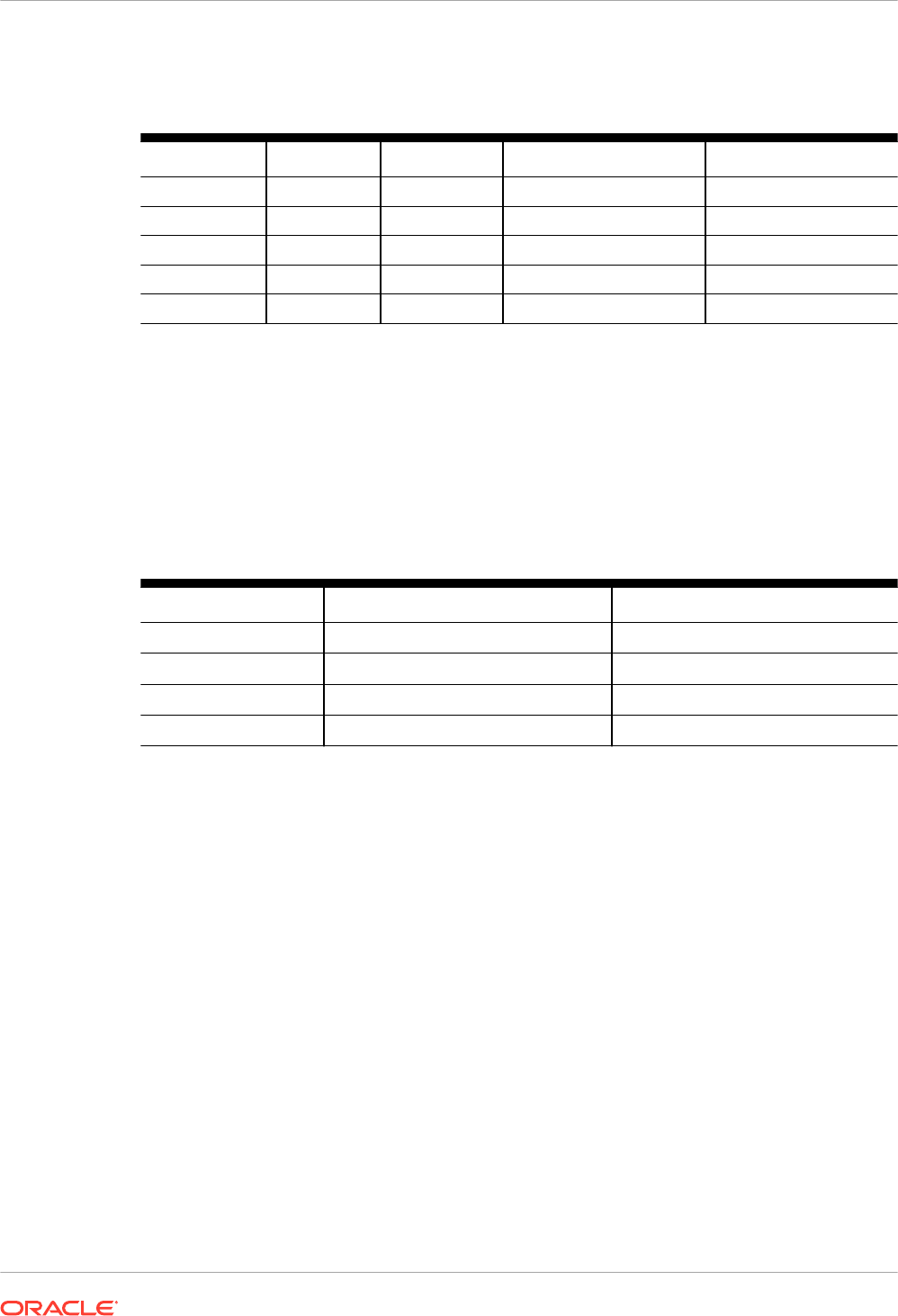
As shown in Table 9-11, the database retrieves only those rows from
sales_online
with non-
null values for both dense grouping keys, indicating rows that satisfy all the filtering criteria.
Table 9-11 Filtered Rows from sales_online Table
geog_id prod_id amount dense_gr_key_prod dense_gr_key_geog
2 8 100 4 1
3 4 110 1 1
3 4 200 1 1
7 1 120 3 2
8 3 130 2 2
9.1.3.4.6 Step 5: Aggregation Using an Array
The database uses a multidimensional array to perform the aggregation.
In Table 9-12, the
geography
grouping keys are horizontal, and the
products
grouping keys are
vertical. The database adds the values in the intersection of each dense grouping key
combination. For example, for the intersection of the
geography
grouping key
1
and the
products
grouping key
1
, the sum of
110
and
200
is
310
.
Table 9-12 Aggregation Array
dgkp/dgkg 1 2
1
110,200
2
130
3
120
4
100
9.1.3.4.7 Step 6: Join Back to Temporary Tables
In the final stage of processing, the database uses the dense grouping keys to join back the
rows to the temporary tables to obtain the names of the regions and categories.
The results look as follows:
CATEGORY SUBCATEGORY COUNTRY STATE AMOUNT
-------- ----------- ------- ----- ------
electric bulb USA CA 120
electric switch USA WA 100
sport ball USA CA 130
sport bike USA WA 310
9.1.4 Controls for IM Aggregation
IM aggregation is integrated with the optimizer.
No new SQL or initialization parameters are required. IM aggregation does not need additional
indexes, foreign keys, or dimensions.
To control IM aggregation manually, you can use the following pairs of hints:
Chapter 9
Optimizing In-Memory Aggregation with VECTOR GROUP BY
9-12

• Query block hints
VECTOR_TRANSFORM
enables the vector transformation on the specified query block,
regardless of costing.
NO_VECTOR_TRANSFORM
disables the vector transformation from
engaging on the specified query block.
• Table hints
You can use the following pairs of hints:
–
VECTOR_TRANSFORM_FACT
includes the specified
FROM
expressions in the fact table
generated by the vector transformation.
NO_VECTOR_TRANSFORM_FACT
excludes the
specified
FROM
expressions from the fact table generated by the vector transformation.
–
VECTOR_TRANSFORM_DIMS
includes the specified
FROM
expressions in enabled
dimensions generated by the vector transformation.
NO_VECTOR_TRANSFORM_DIMS
excludes the specified
FROM
expressions from enabled dimensions generated by the
vector transformation.
See Also:
Oracle Database SQL Language Reference to learn more about the
VECTOR_TRANSFORM_FACT
and
VECTOR_TRANSFORM_DIMS
hints
9.1.5 In-Memory Aggregation: Example
In this example, the business question is "How many products were sold in each category in
each calendar year?"
You write the following query, which joins the
times
,
products
, and
sales
tables:
SELECT t.calendar_year, p.prod_category, SUM(quantity_sold)
FROM times t, products p, sales s
WHERE t.time_id = s.time_id
AND p.prod_id = s.prod_id
GROUP BY t.calendar_year, p.prod_category;
Example 9-3 VECTOR GROUP BY Execution Plan
The following example shows the execution plan contained in the current cursor. Steps 4 and 8
show the creation of the key vectors for the dimension tables
times
and
products
. Steps 17
and 18 show the use of the previously created key vectors. Step 15 shows the
VECTOR GROUP
BY
operation.
----------------------------------------------------------
Execution Plan
----------------------------------------------------------
Plan hash value: 2093829546
------------------------------------------------------------------------------------------------------------------
|Id| Operation | Name |Rows|Bytes|Cost(%CPU)|Time |Pstart| Pstop |
------------------------------------------------------------------------------------------------------------------
|0 |SELECT STATEMENT | | 18 | 1116|302(90)|0:00:01| | |
|1 | TEMP TABLE TRANSFORMATION | | | | | | | |
|2 | LOAD AS SELECT (CURSOR DURATION MEMORY)|SYS_TEMP_0FD9D6608_F6A13| | | | | | |
|3 | HASH GROUP BY | | 5 | 80 | 3 (67)|0:00:01| | |
|4 | KEY VECTOR CREATE BUFFERED | :KV0000 | 5 | 80 | 2 (50)|0:00:01| | |
Chapter 9
Optimizing In-Memory Aggregation with VECTOR GROUP BY
9-13

|5 | TABLE ACCESS INMEMORY FULL | TIMES |1826|21912| 2 (50)|0:00:01| | |
|6 | LOAD AS SELECT (CURSOR DURATION MEMORY)|SYS_TEMP_0FD9D6607_F6A13| | | | | | |
|7 | HASH GROUP BY | | 5 | 125 | 2 (50)|0:00:01| | |
|8 | KEY VECTOR CREATE BUFFERED | :KV0001 | 5 | 125 | 1 (0)|0:00:01| | |
|9 | TABLE ACCESS INMEMORY FULL | PRODUCTS | 72 |1512 | 1 (0)|0:00:01| | |
|10| HASH GROUP BY | | 18 |1116 |297(91)|0:00:01| | |
|11| HASH JOIN | | 18 |1116 |296(91)|0:00:01| | |
|12| HASH JOIN | | 18 | 666 |294(91)|0:00:01| | |
|13| TABLE ACCESS FULL |SYS_TEMP_0FD9D6608_F6A13| 5 | 80 | 2 (0)|0:00:01| | |
|14| VIEW | VW_VT_0737CF93 | 18 | 378 |291(92)|0:00:01| | |
|15| VECTOR GROUP BY | | 18 | 414 |291(92)|0:00:01| | |
|16| HASH GROUP BY | | 18 | 414 |291(92)|0:00:01| | |
|17| KEY VECTOR USE | :KV0000 |918K| 20M |285(92)|0:00:01| | |
|18| KEY VECTOR USE | :KV0001 |918K| 16M |284(92)|0:00:01| | |
|19| PARTITION RANGE ITERATOR | |918K| 13M |282(92)|0:00:01|:KV0000|:KV0000|
|20| TABLE ACCESS INMEMORY FULL | SALES |918K| 13M |282(92)|0:00:01|:KV0000|:KV0000|
|21| TABLE ACCESS FULL |SYS_TEMP_0FD9D6607_F6A13| 5 | 125 | 2 (0)|0:00:01| | |
------------------------------------------------------------------------------------------------------------------
Predicate Information (identified by operation id):
---------------------------------------------------
11 - access("ITEM_9"=INTERNAL_FUNCTION("C0"))
12 - access("ITEM_8"=INTERNAL_FUNCTION("C0"))
20 - inmemory(SYS_OP_KEY_VECTOR_FILTER("S"."PROD_ID",:KV0001) AND SYS_OP_KEY_VECTOR_FILTER("S"."TIME_ID",:KV0000))
filter(SYS_OP_KEY_VECTOR_FILTER("S"."PROD_ID",:KV0001) AND SYS_OP_KEY_VECTOR_FILTER("S"."TIME_ID",:KV0000))
Note
-----
- vector transformation used for this statement
Statistics
----------------------------------------------------------
26 recursive calls
13 db block gets
124 consistent gets
67 physical reads
2200 redo size
1454 bytes sent via SQL*Net to client
634 bytes received via SQL*Net from client
3 SQL*Net roundtrips to/from client
2 sorts (memory)
0 sorts (disk)
20 rows processed
9.2 Optimizing In-Memory Arithmetic
In-Memory Optimized Arithmetic uses an optimized
NUMBER
format for fast calculations using
SIMD hardware.
9.2.1 About In-Memory Optimized Arithmetic
The In-Memory optimized
NUMBER
format enables fast calculations using SIMD hardware.
For tables compressed with
QUERY LOW
,
NUMBER
columns are encoded using an optimized
format that enables native calculations in hardware. SIMD vector processing enables simple
aggregations,
GROUP BY
aggregations, and arithmetic operations to benefit significantly. The
performance improvement depends on the amount of time the aggregation spends on
arithmetic computation. Some aggregations may benefit by up to a factor of 9.
Not all row sources in the query processing engine have support for the In-Memory optimized
number format. Therefore, the IM column store must store both the traditional Oracle Database
Chapter 9
Optimizing In-Memory Arithmetic
9-14

NUMBER
data type and the In-Memory optimized number type. This dual storage increases
space overhead, sometimes up to 15%.
See Also:
"Estimating the Required Size of the IM Column Store"
9.2.2 Enabling and Disabling In-Memory Optimized Arithmetic
Control the feature by setting the initialization parameter
INMEMORY_OPTIMIZED_ARITHMETIC
to
DISABLE
(default) or
ENABLE
.
When set to
ENABLE
, Oracle Database uses an In-Memory optimized encoding for
NUMBER
columns in tables that use
FOR QUERY LOW
compression. When set to
DISABLE
, the database
does not use the optimized encoding.
Switching from
ENABLE
to
DISABLE
does not drop the optimized number encoding for existing
IMCUs immediately. Instead, as the IM column store repopulates IMCUs, the new IMCUs do
not use the optimized encoding.
To enable and disable In-Memory Optimized Arithmetic:
1. In SQL*Plus or SQL Developer, log in to the database as a user with the necessary
privileges.
2. Specify
INMEMORY_OPTIMIZED_ARITHMETIC
using the
ALTER SYSTEM
statement.
The following example enables In-Memory Optimized Arithmetic:
ALTER SYSTEM SET INMEMORY_OPTIMIZED_ARITHMETIC = 'ENABLE' SCOPE=BOTH;
See Also:
Oracle Database Reference to learn more about the
INMEMORY_OPTIMIZED_ARITHMETIC
initialization parameter
Chapter 9
Optimizing In-Memory Arithmetic
9-15

10
Optimizing Repopulation of the IM Column
Store
The IM column store periodically refreshes objects that have been modified. You can control
this behavior using initialization parameters and the
DBMS_INMEMORY
package.
10.1 About Repopulation of the IM Column Store
The automatic refresh of columnar data after significant modifications is called repopulation.
10.1.1 Row Modifications and the Transaction Journal
An In-Memory Compression Unit (IMCU) is a read-only structure that does not modify data in
place when DML occurs on an internal table.
The Snapshot Metadata Unit (SMU) associated with each IMCU tracks row modifications in a
transaction journal. If a query accesses the data, and discovers modified rows, then it can
obtain the corresponding rowids from the transaction journal, and then retrieve the modified
rows from the buffer cache.
As the number of modifications increase, so do the size of SMUs, and the amount of data that
must be fetched from the transaction journal or database buffer cache. To avoid degrading
query performance through journal access, background processes repopulate modified
objects.
10.1.2 Automatic Repopulation
When DML occurs for objects in the IM column store, the database repopulates them
automatically.
Automatic repopulation takes the following forms:
• threshold-based repopulation
This form depends on the percentage of stale entries in the transaction journal for an
IMCU.
• trickle repopulation
This form supplements threshold-based repopulation by periodically refreshing columnar
data even when the staleness threshold has not been reached.
During automatic repopulation, traditional access mechanisms are available. Data is always
accessible from the buffer cache or disk. Additionally, the IM column store is always
transactionally consistent with the data on disk. No matter where the query accesses the data,
the database always returns consistent results.
10-1

See Also:
• "Transaction Journal"
• "In-Memory Process Architecture"
10.1.3 Manual Repopulation of External Tables
External tables are not eligible for automatic repopulation.
The IM column store manages external tables differently from internal tables. Because external
tables are read-only, they are not updated through DML, and thus do not rely on the
transaction journal. For this reason, the database does not repopulate external tables
automatically. However, you can refresh external tables manually by using
DBMS_INMEMORY.REPOPULATE
. In-Memory scans of external tables are only supported when the
tables are completely populated in the IM column store.
Note:
Sessions that query In-Memory external tables must have the initialization parameter
QUERY_REWRITE_INTEGRITY
set to
stale_tolerated
.
It is important to keep in mind that if an external table is modified, then the results
from the IM column store are undefined. Results are also undefined if a partition is
altered (by dropping or adding values). This may lead to differences in results
between IM and non-IM based scans. You can run
DBMS_INMEMORY.REPOPULATE
to
refresh the IM store so that it is resynchronized with the table data.
See Also:
• "Populating an In-Memory External Table Using DBMS_INMEMORY.POPULATE:
Example"
• Oracle Database Reference to learn more about the
QUERY_REWRITE_INTEGRITY
initialization parameter
10.2 How Data Loading Works with the IM Column Store
The IM column store uses different mechanisms depending on the type of data loading:
conventional DML, direct path loads, and partition exchange loads.
10.2.1 How Conventional DML Works with the IM Column Store
Conventional DML processes one row or array of rows at a time, and inserts rows below the
high water mark. Regardless of whether the IM column store is enabled, the database
processes DML using the buffer cache.
Chapter 10
How Data Loading Works with the IM Column Store
10-2

IMCUs are read-only. When a statement modifies a row in an IMCU, the IM column store
records the rowid in the associated SMU.
A Column Compression Unit (CU) entry becomes stale when its value differs from the value in
its corresponding journal entry. For example, a transaction may change an employee’s weekly
salary from
1000
to
1200
, but the actual value in the IMCU is still
1000
. The transaction journal
records the rowid of the stale row and its SCN.
Note:
The transaction journal does not record the new value. Rather, it indicates the
corresponding row as stale as of a specific SCN.
10.2.1.1 Staleness Threshold
As the number of stale entries in an IMCU increases, the speed of the IMCU scan decreases.
Performance decreases because the database must fetch the modified rows from the buffer
cache or disk, rather than from the IM column store. For this reason, Oracle Database
repopulates an IMCU when the number of stale entries in an IMCU reaches an internal
staleness threshold.
The database determines the threshold using heuristics that consider the frequency of IMCU
access and the number of stale rows. Repopulation is more frequent for IMCUs that are
accessed frequently or have a higher percentage of stale rows.
See Also:
• "In-Memory Compression Units (IMCUs)"
• Oracle Database Concepts to learn more about the database buffer cache
10.2.1.2 Double Buffering
In double buffering, background processes create new IMCU versions by combining the
original rows with the latest modified rows.
When the database begins either threshold-based repopulation or trickle repopulation, the IM
column store uses double buffering. As shown in the following figure, the IM column store
maintains two versions of an IMCU simultaneously, with the original stale IMCU remaining
accessible to queries.
Chapter 10
How Data Loading Works with the IM Column Store
10-3

Figure 10-1 Double Buffering
In-Memory Area
IMCU
Original IMCU
Original
SMU
ROW_ID:123765490
ROW_ID:123800000
ROW_ID:257643100
ROW_ID:257643100
ROW_ID:257643100
Journal
IMCU
New Version
of IMCU
New SMU
Journal
Mark original IMCU as old
version as of SCN
1
Create a new version of
IMCU by combining clean
rows from original with
latest version of
changed rows
2
Track any DML
operations that
occur during
IMCU creation
in Journal
3
The basic steps of double buffering are:
1. In the original SMU, the database marks the existing IMCU as the original version as of a
specific SCN.
2. Background processes create a new version of the IMCU by combining the original rows
with the latest versions of the modified rows.
3. In the journal of the new SMU, the database tracks DML operations that occur during
IMCU creation.
In this way, the original IMCU stays online. The database keeps both old and new IMCUs
versions for as long as they are useful, or until the IM column store is under space pressure.
10.2.2 How Direct Path Loads Work with the IM Column Store
A direct path load is an
INSERT /*+APPEND*/
statement or a SQL*Loader operation in which
DIRECT=true
.
In a direct path load, the database writes formatted data blocks directly to the data files,
bypassing the database buffer cache. The database appends the data above the high water
mark, which is the boundary between used and unused space in a segment. Direct path loads
operate are “all or nothing” operations: the operation either inserts all data or no data.
Chapter 10
How Data Loading Works with the IM Column Store
10-4

Figure 10-2 Direct Path Loads and the High Water Mark
Sales Table Sales Table Sales Table
High Water Mark High Water Mark
New
Data
High Water Mark
When the segment is populated in the IM column store, a direct path load works as follows:
1. You load data using a
CREATE TABLE AS SELECT
or
INSERT /*+APPEND*/
statement. Only
the current session is aware of the DML.
2. You commit the statement.
3. The high water mark moves to encompass the new data, which alerts the IMCU that data
is missing.
V$IM_SEGMENTS.BYTES_NOT_POPULATED
now indicates the size of the newly
inserted data.
4. The IM column store manages repopulation based on the following algorithm:
• If the affected object has a
PRIORITY
set to a value other than
NONE
, then the database
repopulates the data.
• If the affected object has a
PRIORITY
set to
NONE
, then the database repopulates at the
next full scan of the object.
10.2.3 How a Partition Exchange Load Works with the IM Column Store
A partition exchange load is a technique that exchanges a table for a partition. An exchange
load is almost instantaneous because it modifies metadata instead of data.
To perform an exchange load, follow these steps:
1. Create a nonpartitoned table, called a source table.
2. Load rows into the source table.
3. Exchange an existing table partition, called the target partition, with the table.
For the target partition to be populated in the IM column store after the exchange, the source
table must be populated in the IM column store before the exchange. The following scenarios
are possible, depending on the whether the target partition is populated:
• Before the exchange, the target partition is not populated in the IM column store. For
example, the partition is empty.
Chapter 10
How Data Loading Works with the IM Column Store
10-5

After the exchange, the source table is no longer populated in the IM column store. The
source IMCUs are now associated with the target partition.
• Before the exchange, the target partition is populated in the IM column store.
After the exchange, the source table remains populated in the IM column store.
Example 10-1 INMEMORY Partition Exchange Load
In this example, the
sales
table, which is partitioned, has the
INMEMORY
attribute set at the table
level. All non-empty partitions in this table are currently populated. The
sales_p042616
partition
is currently empty. Your goal is to populate the empty partition
sales_p042616
with data
contained in text files. The following figure illustrates the before and after scenarios.
Figure 10-3 Partition Exchange
IM Column Store
Sales Table
Before
sales_tmp_ld
is populated
IM Column Store
Sales Table
sales_tmp_ld
After
sales_tmp_ld
is populated
IM Column Store
Sales Table
After the partition
exchange
sales_p042016
sales_p042116
sales_p042216
sales_p042316
sales_p042416
sales_p042516
sales_p042016
sales_p042116
sales_p042216
sales_p042316
sales_p042416
sales_p042516
sales_p042016
sales_p042116
sales_p042216
sales_p042316
sales_p042416
sales_p042516
sales_p042616
To perform the exchange, do the following:
1. Create an external table
sales_tmp_ext
using the
CREATE TABLE ... ORGANIZATION
EXTERNAL
statement.
The external table does not reside in the database, and can be in any format for which an
access driver is provided. The table is read-only.
2. Create a nonpartitioned table named
sales_tmp_ld
using
CREATE TABLE ... AS SELECT *
FROM sales_tmp_ext
.
The
sales_tmp_ld
table is not external, which means it stores rows in the data files.
3. Set the
INMEMORY
attribute in
sales_tmp_ld
using an
ALTER TABLE
statement.
The
sales_tmp_ld
table is now marked as
INMEMORY
, but it is not yet populated into the IM
column store.
4. Populate
sales_tmp_ld
into the IM column store by forcing a full table scan.
Chapter 10
How Data Loading Works with the IM Column Store
10-6

For example, the following query forces a full scan:
SELECT /*+ FULL(s) NO_PARALLEL(s) */ COUNT(*) FROM sales_tmp_ld s;
5. Exchange the
sales_p042616
partition with the
sales_tmp_ld
table.
For example, alter the
sales
table as follows:
ALTER TABLE sales EXCHANGE PARTITION sales_p042616 WITH TABLE sales_tmp_ld;
After the exchange completes, the
sales_p042616
partition is populated in the IM column
store, and the
sales_tmp_ld
is no longer populated.
See Also:
Oracle Database VLDB and Partitioning Guide to learn more about partition
exchange loads
10.3 When the Database Repopulates the IM Column Store
The database repopulates the IM column store automatically according to an internal
algorithm. You can manually disable repopulation, and influence its aggressiveness.
Note:
This section describes automatic repopulation. You can force repopulation manually
by using the
DBMS_INMEMORY.REPOPULATE
procedure.
See Also:
Oracle Database PL/SQL Packages and Types Reference to learn about the
DBMS_INMEMORY.REPOPULATE
procedure
10.3.1 Threshold-Based and Trickle Repopulation
Automatic repopulation takes two forms: threshold-based repopulation and trickle
repopulation.
Automatic repopulation always checks stale journal entries and uses double buffering.
However, repopulation has different triggers:
• Threshold-based repopulation
The database repopulates IMCUs when the number of changes recorded in the transaction
journal reaches an internal staleness threshold. Threshold-based repopulation occurs
automatically when
INMEMORY_MAX_POPULATE_SERVERS
initialization parameter is set to a
value other than
0
.
Chapter 10
When the Database Repopulates the IM Column Store
10-7

• Trickle repopulation
The IMCO (In-Memory Coordinator) background process periodically checks whether stale
rows exist, and then adds IMCUs to a repopulation queue. This mechanism does not
depend on meeting the staleness threshold. The
INMEMORY_TRICKLE_REPOPULATE_SERVERS_PERCENT
initialization parameter limits the
number of background processes used for trickle repopulation. Setting this parameter to
0
disables trickle repopulation.
Trickle repopulation is analogous to Java garbage collection. The mechanism works as follows:
1. IMCO wakes up.
2. IMCO determines whether any population tasks need to be performed, including whether
any stale entries exist in the transaction journal associated with an IMCU.
3. If IMCO finds stale entries, then it triggers a Space Management Worker Process (Wnnn)
to create a new version of the IMCU.
During IMCU creation, the database records the rowids of modified rows in the transaction
journal.
4. IMCO sleeps for two minutes, and then returns to Step 1.
Figure 10-4 Trickle Repopulation
In-Memory Area
IMCU
Original IMCU
ROW_ID:123765490
ROW_ID:123800000
ROW_ID:257643100
Journal
IMCU
New Version
of IMCU
Journal
Wake IMCO every two
minutes to check journal
for stale entries
1
Create a new version of the
IMCU by combining original
rows with latest versions
2
Track DML in
journal while
IMCU is being
created
3
For example, a database may be busy for 8 hours per day. Most SMUs contain a small number
of transaction journal entries (below the staleness threshold). When the database is quiet,
IMCO wakes up, checks the journals to determine which IMCUs have stale entries, and then
uses trickle repopulation to refresh the IMCUs.
Chapter 10
When the Database Repopulates the IM Column Store
10-8

See Also:
• "In-Memory Process Architecture"
• "Transaction Journal"
• Oracle Database Reference to learn about In-Memory background processes
10.3.2 Factors Affecting Repopulation
The algorithm that triggers repopulation is internal, and depends on several factors.
The principal factors affecting repopulation are as follows:
• Rate of DML changes
As the number of modified rows increases, the percentage of stale columnar data
increases. The transaction journal grows, increasing the need to use the buffer cache to
satisfy queries.
• Type of DML operations
Typically, inserts have less performance overhead than deletes and updates because
inserts often go into a new data block.
• Location of modified rows within a data block
Changes grouped within the same database block or table partition have less effect then
changes distributed across an entire table. Versioning every IMCU has a greater impact
than versioning a small number of IMCUs.
• Compression level applied to
INMEMORY
objects
Because of double buffering, tables with higher compression levels incur more query and
DML overhead during repopulation. For example,
MEMCOMPRESS FOR CAPACITY HIGH
incurs
more overhead than
MEMCOMPRESS FOR DML
.
• Number of active worker processes
As the number of worker processes increases, more work occurs in parallel. Consequently,
the rate of repopulation increases.
See Also:
• "Compression Levels for In-Memory Objects"
• Oracle Database Reference to learn about the
INMEMORY_TRICKLE_REPOPULATE_SERVERS_PERCENT
initialization parameter
Chapter 10
When the Database Repopulates the IM Column Store
10-9

10.4 Controls for Repopulation of the IM Column Store
Repopulation occurs automatically by default, but you can control its aggressiveness, or
disable it altogether.
Initialization Parameters
The following initialization parameters influence background process behavior:
•
INMEMORY_MAX_POPULATE_SERVERS
This parameter limits the maximum number of Wnnn processes available for population
and repopulation (threshold-based and trickle). The default value is half the
CPU_COUNT
.
This parameter acts as a throttle, preventing these server processes from overloading the
rest of the database. Setting this parameter to
0
disables both population and repopulation.
Caution:
Be careful not to set the value of this parameter too high. If it is set close to the
number of cores or higher, then no CPU may be available for the rest of the
system to run.
•
INMEMORY_TRICKLE_REPOPULATE_SERVERS_PERCENT
This parameter limits the percentage of the total population and repopulation processes
that perform trickle repopulation. Its effect is to limit the number of IMCUs repopulated
through trickle repopulation within a two-minute interval.
The value for this parameter is a percentage of the
INMEMORY_MAX_POPULATE_SERVERS
value. For example, if
INMEMORY_TRICKLE_REPOPULATE_SERVERS_PERCENT
is
5
percent, and
if
INMEMORY_MAX_POPULATE_SERVERS
is
20
, then the IM column store uses an average of 1
core (.05 * 20) for trickle repopulation.
To increase throughput at the expense of increased background CPU, set this parameter
to higher values such as
5
or
10
. A value greater than
50
is not allowed, so that at least half
of the
INMEMORY_MAX_POPULATE_SERVERS
processes are available for other tasks.
Setting this parameter to
0
disables trickle population.
See Also:
• Oracle Database Reference to learn about
INMEMORY_TRICKLE_REPOPULATE_SERVERS_PERCENT
• Oracle Database Reference to learn about
INMEMORY_MAX_POPULATE_SERVERS
DBMS_INMEMORY.REPOPULATE Procedure
To manually repopulate a table, partition, or subpartition, use the
DBMS_INMEMORY.REPOPULATE
procedure. Only objects that are currently populated in the IM column store are eligible for
repopulation.
The following values are possible for the
force
parameter:
Chapter 10
Controls for Repopulation of the IM Column Store
10-10

•
FALSE
— The database repopulates only IMCUs containing modified rows. This is the
default.
•
TRUE
— The database drops the segment, and then rebuilds it. The database increments
the statistics and performs all other tasks related to initial population.
For example, IMCU 1 contains rows 1 to 500,000, and IMCU 2 contains rows 500,001 to
1,000,000. A statement modifies row 600,000. When
force
is
FALSE
, the database only
repopulates IMCU 2. When
force
is
TRUE
, the database repopulates both IMCUs.
Consider further that the
INMEMORY_VIRTUAL_COLUMNS
initialization parameter is set to
ENABLE
,
and an application creates a new virtual column. When
force
is
FALSE
, the database only
repopulates IMCU 2 with the new column. When
force
is
TRUE
, the database repopulates both
IMCUs with the new column.
See Also:
Oracle Database PL/SQL Packages and Types Reference to learn more about
DBMS_INMEMORY.REPOPULATE
10.5 Optimizing Trickle Repopulation: Tutorial
In this tutorial, you increase the percentage of background processes available for trickle
repopulation.
Assumptions
This tutorial assumes the following:
• The IM column store is enabled.
• You want to devote more CPU to the Space Management Worker Processes (Wnnn) that
perform trickle repopulation.
• The database server has 12 CPU cores.
To increase the aggressiveness of repopulation:
1. In SQL*Plus or SQL Developer, log in to the database as a user with administrative
privileges.
2. Show the settings for the initialization parameters relating to repopulation (sample output
included):
SHOW PARAMETER POPULATE_SERVERS
NAME TYPE VALUE
------------------------------------ ----------- -----------
inmemory_max_populate_servers integer 12
inmemory_trickle_repopulate_servers_percent integer 1
The preceding output indicates that 12 cores are available for population and repopulation
tasks. The
INMEMORY_TRICKLE_REPOPULATE_SERVERS_PERCENT
is 1% of the
INMEMORY_MAX_POPULATE_SERVERS
value. Of the server processes available for population
Chapter 10
Optimizing Trickle Repopulation: Tutorial
10-11

and repopulation tasks, the IM column store can use a maximum of .12 CPU cores (.01 *
12) for trickle repopulation.
3. Increase the trickle repopulation maximum to 25% of the
INMEMORY_MAX_POPULATE_SERVERS
initialization parameter value.
For example, use the following statement:
ALTER SYSTEM
SET INMEMORY_TRICKLE_REPOPULATE_SERVERS_PERCENT=25
SCOPE=BOTH;
As a result, the IM column store now uses a maximum of 3 CPU cores (.25 * 12) for trickle
repopulation, out of a total of 12 that are available for population and repopulation work.
See Also:
• Oracle Database Reference to learn about
INMEMORY_TRICKLE_REPOPULATE_SERVERS_PERCENT
• Oracle Database Reference to learn about
INMEMORY_MAX_POPULATE_SERVERS
Chapter 10
Optimizing Trickle Repopulation: Tutorial
10-12

Part IV
High Availability and the IM Column Store
This part explains how to use the IM column store with high availability features such as In-
Memory FastStart (IM FastStart), Oracle Data Guard, and Oracle Real Application Clusters
(Oracle RAC).
This section contains the following topics:
See Also:
The MAA white paper Oracle Database In-Memory High Availability Best Practices

11
Managing IM FastStart for the IM Column
Store
When the IM column store is enabled, In-Memory FastStart (IM FastStart) enables the
database to open faster by storing columnar data on disk.
This chapter contains the following topics:
11.1 About IM FastStart
IM FastStart optimizes the population of database objects in the IM column store by storing
IMCUs directly on disk.
The database can read from the IM FastStart area after instance failure and recovery, or during
duplication to a different Oracle RAC instance.
Note:
IM FastStart is not supported in a standby database, which is read-only.
This section contains the following topics:
11.1.1 Purpose of IM FastStart
The IM column store is populated whenever a database instance restarts, which can be a slow
operation that is I/O-intensive and CPU-intensive.
When IM FastStart is enabled, the database periodically saves a copy of columnar data to disk
for faster repopulation during instance restarts. If the database re-opens after being closed,
then the database reads columnar data from the FastStart area, and then populates it into the
IM column store, ensuring that all transactional consistencies are maintained.
An IM FastStart tablespace requires intermittent I/O while the database is open and
operational. The performance gain occurs when the database re-opens because the database
avoids the CPU-intensive compression and formatting of data.
11.1.2 How IM FastStart Works
A FastStart area is a designated tablespace where IM FastStart stores and manages data for
INMEMORY
objects. Oracle Database manages the FastStart tablespace without DBA
intervention.
Only one FastStart area, and one designated FastStart tablespace, is allowed for each PDB.
You cannot alter or drop the tablespace while it is the designated IM FastStart tablespace. In
an Oracle RAC database, all nodes share the FastStart data.
11-1

Enable a FastStart tablespace using the
DBMS_INMEMORY_ADMIN.FASTSTART_ENABLE
procedure.
The Space Management Worker Processes (Wnnn) creates an empty SecureFiles LOB named
SYSDBinstance_name_LOBSEG$
.
Note:
Enabling the IM FastStart area is not sufficient to create the FastStart area. Data
population or repopulation is required.
See Also:
• "Space Management Worker Processes (Wnnn)"
• "About Repopulation of the IM Column Store"
• Oracle Database PL/SQL Packages and Types Reference to learn about the
DBMS_INMEMORY_ADMIN.FASTSTART_ENABLE
procedure
11.1.2.1 How the Database Manages the FastStart Area
During the first population or repopulation after the FastStart area is enabled, the database
creates the FastStart area.
The database manages the FastStart area automatically as follows:
• Whenever population or repopulation of an object occurs, the database writes its columnar
data to the FastStart area.
Note:
The database writes segments from encrypted tablespaces to the FastStart area
only if the FastStart tablespace is also encrypted.
The Space Management Worker Processes (Wnnn) write IMCUs (not IMEUs or SMUs) to
the SecureFiles LOB named
SYSDBinstance_name_LOBSEG$
. The database writes FastStart
metadata to the
SYSAUX
tablespace, which must be online.
Depending on how much DML activity occurs for a CU, a lag can exist between the CUs in
the FastStart area and the CUs in the IM column store. The “hotter” a CU is, the less
frequently the database populates it in the IM column store and writes it to the FastStart
area. If the database crashes, then some CUs that were populated in the IM column store
may not exist in the FastStart area.
Note:
If the FastStart area becomes temporarily inaccessible, then In-Memory
population is unaffected.
Chapter 11
About IM FastStart
11-2

• If you define an ADO policy on a segment, then the database manages the segment in the
FastStart area based on the rule in the policy. For example, if ADO specifies that an object
changes its attribute to
NO INMEMORY
based on a policy, then the IM column store removes
its data from the FastStart area.
• If the attribute of a populated object is changed to
NOINMEMORY
, then the database
automatically removes its IMCUs from the FastStart area.
• If the FastStart tablespace runs out of space, then the database uses an internal algorithm
to drop the oldest segments, and continues writing to the FastStart area. If no space
remains, then the database stops writing to the FastStart area.
The following figure shows
products
,
customers
, and
sales
populated in the IM column store.
Chapter 11
About IM FastStart
11-3

Figure 11-1 FastStart Area
Database Buffer Cache
System Global Area (SGA)
Instance
Disk
sales
Segment
Disk
In-Memory Column Store
sales
customers
products
IMCU 1
IMCU 2
IMCU 3
IMCU 4
IMCU 5
IMCU 6
USERS Tablespace FS_TBS
products
Segment
customers
Segment
IMCU 1
IMCU 2
IMCU 4
IMCU 5
IMCU 6
IMCU 3
custom
ers
sal
sal
sal
es
When the FastStart area is enabled, the database also writes the IMCUs for these segments to
the FastStart area in
fs_tbs
. If the database re-opens or if the instance restarts, then the
database can validate the IMCUs for modifications to ensure the transactional consistency, and
reuse the IMCUs. Regardless of whether the FastStart area is enabled, the database stores
data blocks and segments on disk in the
users
tablespace.
Chapter 11
About IM FastStart
11-4

Note:
You cannot manually force the IM column store to write data to the FastStart
tablespace.
See Also:
• "Enabling ADO for the IM Column Store"
• "FastStart Area in Oracle RAC"
• "About Repopulation of the IM Column Store"
• Oracle Database VLDB and Partitioning Guide to learn more about ADO
11.1.2.2 How the Database Reads from the FastStart Area
The FastStart area defines what data is loaded when the database reopens, but not when it is
loaded. Population is controlled by the priority settings.
When the database reopens, the standard
PRIORITY
rules determine population. For example,
the database populates objects with
PRIORITY NONE
on demand. Objects with priority
CRITICAL
are higher in the automatic population queue than objects with priority
LOW
.
For example, in a single-instance database, the
sales
,
customers
, and
product
tables are
populated with
PRIORITY NONE
in the IM column store. At every repopulation, the database
saves the IMCUs for these tables to the FastStart area. Assume that the instance
unexpectedly terminates. When you reopen the database, the IM column store is empty. If a
query scans the
sales
,
customers
, or
product
table, then the database loads the IMCUs for
this table from the FastStart area into the IM column store.
In most cases, the FastStart area increases the speed of population. However, if any CU
stored in the FastStart area reaches an internal threshold of DML activity, then the database
populates the row data from data files instead of from the FastStart area.
See Also:
• "Prioritization of In-Memory Population"
• "FastStart Area in Oracle RAC"
• Oracle Database SQL Language Reference for
INMEMORY
clause semantics
11.2 Enabling IM FastStart for the IM Column Store
Specify a tablespace for the FastStart area using the
DBMS_INMEMORY_ADMIN.FASTSTART_ENABLE
procedure.
Optionally, set the logging mode of the LOB created for the FastStart area. If the
nologging
parameter is set to
TRUE
(default), then the database creates the LOB with the
NOLOGGING
Chapter 11
Enabling IM FastStart for the IM Column Store
11-5

option. If
nologging
is set to
FALSE
, then the database creates the FastStart LOB with the
LOGGING
option.
Prerequisites
To create a FastStart area, you must meet the following prerequisites:
• The tablespace that will be designated as the FastStart area must exist.
• This tablespace must have enough space to store data for the IM column store, and it must
not contain any other data before you designate it as the FastStart area. Oracle
recommends that you create the FastStart tablespace with twice the size of the
INMEMORY_SIZE
setting.
• You must have administrator privileges.
To create the IM FastStart area:
1. In SQL*Plus or SQL Developer, log in to the database as a user with the necessary
privileges.
2. Use the
DBMS_INMEMORY_ADMIN.FASTSTART_ENABLE
procedure.
Example 11-1 Designating an IM FastStart Area
This example creates a tablespace and designates it as the FastStart area.
1. In SQL*Plus or SQL Developer, log in to the database as a user with administrative
privileges.
2. Create a tablespace named
fs_tbs
:
CREATE TABLESPACE fs_tbs
DATAFILE 'fs_tbs.dbf' SIZE 500M REUSE
AUTOEXTEND ON NEXT 500K MAXSIZE 1G;
3. Enable IM FastStart, and designate the
fs_tbs
tablespace as the FastStart area, using the
default
NOLOGGING
option for the FastStart LOB:
EXEC DBMS_INMEMORY_ADMIN.FASTSTART_ENABLE('fs_tbs');
4. Query the status and size of the FastStart area:
COL TABLESPACE_NAME FORMAT a15
SELECT TABLESPACE_NAME, STATUS,
( (ALLOCATED_SIZE/1024) / 1024 ) AS ALLOC_MB,
( (USED_SIZE/1024) / 1024 ) AS USED_MB
FROM V$INMEMORY_FASTSTART_AREA;
TABLESPACE_NAME STATUS ALLOC_MB USED_MB
--------------- -------------------- ---------- ----------
FS_TBS ENABLE 500 .0625
At this stage, no user data is in the FastStart area.
Chapter 11
Enabling IM FastStart for the IM Column Store
11-6

5. Query the logging mode of the FastStart LOB:
COL SEGMENT_NAME FORMAT a20
SELECT SEGMENT_NAME, LOGGING
FROM DBA_LOBS
WHERE TABLESPACE_NAME = 'FS_TBS';
SEGMENT_NAME LOGGING
-------------------- -------
SYSDBIMFS_LOBSEG$ NO
6. Force the IM column store to repopulate any currently populated objects.
The following queries force the repopulation of the
sales
,
products
, and
customers
tables:
SELECT /*+ FULL(s) NO_PARALLEL(s) */ COUNT(*) FROM sh.sales s;
SELECT /*+ FULL(p) NO_PARALLEL(p) */ COUNT(*) FROM sh.products p;
SELECT /*+ FULL(c) NO_PARALLEL(c) */ COUNT(*) FROM sh.customers c;
7. Query the size of the FastStart area:
COL TABLESPACE_NAME FORMAT a15
SELECT TABLESPACE_NAME, STATUS,
( (ALLOCATED_SIZE/1024) / 1024 ) AS ALLOC_MB,
( (USED_SIZE/1024) / 1024 ) AS USED_MB
FROM V$INMEMORY_FASTSTART_AREA;
TABLESPACE_NAME STATUS ALLOC_MB USED_MB
--------------- -------------------- ---------- ----------
FS_TBS ENABLE 500 2.25
Now the same query shows that 2.25 MB of the FastStart area has been filled.
See Also:
Oracle Database PL/SQL Packages and Types Reference to learn about the
DBMS_INMEMORY_ADMIN
package
11.3 Retrieving the Name of the Current IM FastStart Tablespace
Obtain the name of the tablespace that is currently designated as the FastStart area by
querying
V$INMEMORY_FASTSTART_AREA
view.
If no FastStart tablespace is enabled, then the
STATUS
column shows
NOT ENABLED
; otherwise,
the column shows the tablespace name.
Prerequisites
To retrieve the name of the FastStart tablespace, you must have administrator privileges.
Chapter 11
Retrieving the Name of the Current IM FastStart Tablespace
11-7

To retrieve the name of the FastStart tablespace:
1. In SQL*Plus or SQL Developer, log in to the database as a user with the necessary
privileges.
2. Query the
V$INMEMORY_FASTSTART_AREA
view.
Example 11-2 Getting the Name of the Current IM FastStart Tablespace
This example queries the name and status of the FastStart tablespace (sample output
included):
COL TABLESPACE_NAME FORMAT a20
SELECT TABLESPACE_NAME, STATUS
FROM V$INMEMORY_FASTSTART_AREA;
TABLESPACE_NAME STATUS
-------------------- ----------
FS_TBS ENABLE
See Also:
Oracle Database Reference to learn about the
V$INMEMORY_FASTSTART_AREA
view
11.4 Migrating the FastStart Area to a Different Tablespace
You can migrate the FastStart area to a different tablespace by running the
FASTSTART_MIGRATE_STORAGE
procedure in the
DBMS_INMEMORY_ADMIN
package.
In a PDB, you can designate only one tablespace at a time as the FastStart area.
Prerequisites
To migrate a FastStart area, you must meet the following prerequisites:
• The tablespace that will be designated as the new FastStart area must exist.
• This tablespace must have enough space to store data for the IM column store, and it must
not contain any other data before it is designated as the FastStart area.
• You must have administrator privileges.
To migrate the IM FastStart area:
1. In SQL*Plus or SQL Developer, log in to the database as a user with the necessary
privileges.
2. Run the
DBMS_INMEMORY_ADMIN.FASTSTART_MIGRATE_STORAGE
procedure.
Example 11-3 Migrating the FastStart Area to a Different Tablespace
This example migrates the IM FastStart area to the
new_fs_tbs
tablespace.
1. In SQL*Plus or SQL Developer, log in to the database as a user with administrative
privileges.
Chapter 11
Migrating the FastStart Area to a Different Tablespace
11-8

2. Query the name of the current FastStart tablespace:
COL TABLESPACE_NAME FORMAT a15
SELECT TABLESPACE_NAME, STATUS
FROM V$INMEMORY_FASTSTART_AREA;
TABLESPACE_NAME STATUS
--------------- -----------
FS_TBS ENABLE
3. Create a tablespace named
new_fs_tbs
:
CREATE TABLESPACE new_fs_tbs
DATAFILE 'new_fs_tbs.dbf' SIZE 500M REUSE
AUTOEXTEND ON NEXT 500K MAXSIZE 1G;
4. Migrate the FastStart area to the new tablespace:
EXEC DBMS_INMEMORY_ADMIN.FASTSTART_MIGRATE_STORAGE('new_fs_tbs');
5. Query the name of the current FastStart tablespace:
TABLESPACE_NAME STATUS
-------------------- --------------------
NEW_FS_TBS ENABLE
See Also:
Oracle Database PL/SQL Packages and Types Reference to learn about the
FASTSTART_MIGRATE_STORAGE
procedure
11.5 Disabling IM FastStart for the IM Column Store
When you disable IM FastStart, the database no longer maintains the FastStart area. The
database does not use IM FastStart to populate the IM column store when the database
reopens.
Prerequisites
To disable the FastStart area, the following conditions must be true:
• The FastStart area must be enabled.
• You must have administrator privileges.
To disable the FastStart tablespace:
1. In SQL*Plus or SQL Developer, log in to the database as a user with the necessary
privileges.
2. Query
V$INMEMORY_FASTSTART_AREA
to confirm that the IM FastStart area is enabled.
3. Execute the
DBMS_INMEMORY_ADMIN.FASTSTART_DISABLE
procedure.
Chapter 11
Disabling IM FastStart for the IM Column Store
11-9

4. Optionally, drop the FastStart tablespace.
Example 11-4 Disabling IM FastStart
This example disables the IM FastStart area, and then drops the
fs_tbs
tablespace.
1. In SQL*Plus or SQL Developer, log in to the database as a user with administrative
privileges.
2. Query the status of the FastStart area:
COL TABLESPACE_NAME FORMAT a15
SELECT TABLESPACE_NAME, STATUS
FROM V$INMEMORY_FASTSTART_AREA;
TABLESPACE_NAME STATUS
--------------- -----------
FS_TBS ENABLE
3. Disable the FastStart area:
EXEC DBMS_INMEMORY_ADMIN.FASTSTART_DISABLE;
4. Query the status of the FastStart area:
SELECT TABLESPACE_NAME, STATUS
FROM V$INMEMORY_FASTSTART_AREA;
TABLESPACE_NAME STATUS
-------------------- --------------------
INVALID_TABLESPACE DISABLE
When IM FastStart is not enabled, the value of
TABLESPACE_NAME
is
INVALID_TABLESPACE
and the value of
STATUS
is
DISABLE
.
5. Drop the former FastStart tablespace:
DROP TABLESPACE fs_tbs INCLUDING CONTENTS AND DATAFILES;
See Also:
Oracle Database PL/SQL Packages and Types Reference to learn about the
FASTSTART_DISABLE
procedure
Chapter 11
Disabling IM FastStart for the IM Column Store
11-10

12
Deploying IM Column Stores in Oracle RAC
This chapter explains how to enable IM column stores in an Oracle Real Application Clusters
(Oracle RAC) environment, and configure objects for population.
This section contains the following topics:
12.1 Overview of Database In-Memory and Oracle RAC
Every Oracle RAC node has its own In-Memory (IM) column store. By default, populated
objects are distributed across all IM column stores in the cluster.
Oracle recommends that you size the IM column stores equally on every Oracle RAC node. If
an Oracle RAC node does not require an IM column store, then set the
INMEMORY_SIZE
parameter to
0
.
It is possible to have completely different objects populated on every node, or to have larger
objects distributed across all of the IM column stores in the cluster. On Oracle Engineered
Systems, it is also possible for the same objects to appear in the IM column store on every
node. The distribution of objects across the IM column stores in a cluster is controlled by two
subclauses to the
INMEMORY
attribute:
DISTRIBUTE
and
DUPLICATE
.
In an Oracle RAC environment, an object that only has the
INMEMORY
attribute specified is
automatically distributed across the IM column stores in the cluster. You can use the
DISTRIBUTE
clause to specify how an object is distributed across the cluster. By default, the
type of partitioning used (if any) determines how the object is distributed. If the object is not
partitioned, then it is distributed by rowid range. Alternatively, you can specify the
DISTRIBUTE
clause to override the default behavior.
On an Oracle Engineered System, you can duplicate or mirror populated objects across the IM
column stores in the cluster. This technique provides the highest level of redundancy. The
DUPLICATE
clause controls how an object is duplicated. If you specify only
DUPLICATE
, then one
mirrored copy of the data is distributed across the IM column stores in the cluster. To duplicate
the entire object in each IM column store, specify
DUPLICATE ALL
.
Note:
When you deploy Oracle RAC on a non-Engineered System, the
DUPLICATE
clause is
treated as
NO DUPLICATE
.
12.1.1 Multiple IM Column Stores
In Oracle RAC, each database instance has its own IM column store.
Conceptually, the IM column store in Oracle RAC environment uses a shared-nothing
architecture. On each database instance, you size and manage the IM column stores
separately. The database instances do not use Cache Fusion to transfer IMCUs back and
forth.
12-1

Figure 12-1 IM Column Stores in an Oracle RAC Database
This figure shows a two-node Oracle RAC cluster. Each instance has a separately configured
IM column store.
Instance 1
System Global Area (SGA)
In-Memory Column
Store
Shared Disk
Database Buffer Cache
Instance 2
System Global Area (SGA)
In-Memory Column
Store
Database Buffer Cache
Oracle recommends that you set the size of the IM column stores on every Oracle RAC node
to an equal value. For example, you might assign every IM column store 100 GB of memory.
For any node that does not require an IM column store, set the
INMEMORY_SIZE
initialization
parameter on this node to 0.
Figure 12-2 Three-Node Oracle RAC Database with Two IM Column Stores
In this example, instance 1 and instance 2 both have IM column stores. Instance 3 does not
require an IM column store, so the
INMEMORY_SIZE
initialization parameter on this node is set to
0.
Chapter 12
Overview of Database In-Memory and Oracle RAC
12-2
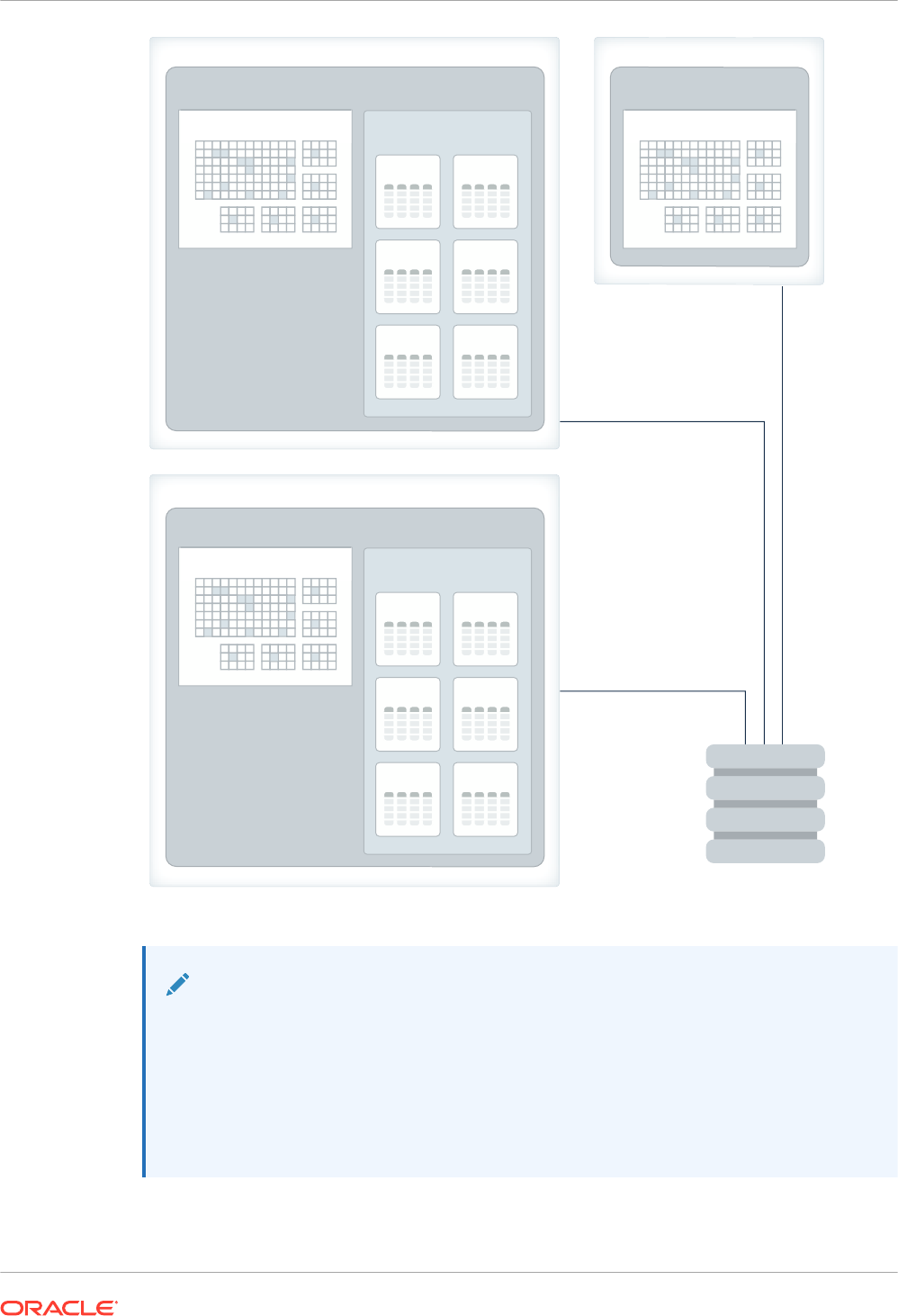
Instance 1
IMCU
System Global Area (SGA)
In-Memory Column
Store
Shared Disk
Database Buffer Cache
INMEMORY_SIZE=100M
IMCU
IMCU IMCU
IMCU IMCU
Instance 2
IMCU
System Global Area (SGA)
In-Memory Column
Store
Database Buffer Cache
INMEMORY_SIZE=100M
IMCU
IMCU IMCU
IMCU IMCU
Instance 3
System Global Area (SGA)
Database Buffer Cache
INMEMORY_SIZE=0
See Also:
• "Enabling the IM Column Store for a CDB or PDB"
• Oracle Database Reference for more information about the
INMEMORY_SIZE
initialization parameter
• Oracle Real Application Clusters Administration and Deployment Guide for an
introduction to Oracle RAC
Chapter 12
Overview of Database In-Memory and Oracle RAC
12-3

12.1.2 Distribution and Duplication of Columnar Data in Oracle RAC
When
INMEMORY
is specified, the
DISTRIBUTE
and
DUPLICATE
keywords control the distribution
of objects.
Oracle RAC provides multiple distribution options. You can have different objects populated on
each node, or have larger objects distributed across all IM column stores in the Oracle RAC
cluster. You can also have the same objects populated in the IM column store on every node
(Oracle Engineered Systems only).
Note:
If a table is currently populated in the IM column store, and if you change any
INMEMORY
attribute of the table other than
PRIORITY
, then the database evicts the
table from the IM column store. The repopulation behavior depends on the
PRIORITY
setting.
This section contains the following topics:
12.1.2.1 Distribution of Columnar Data in Oracle RAC
The
DISTRIBUTE
clause of
INMEMORY
controls how table data in the IM column store is
distributed across Oracle RAC instances.
When the default option of
AUTO
is set, the Oracle RAC instances distribute data automatically.
While populating a segment, space management child processes (Wnnn) processes attempt to
put an equal amount of data on each instance. Distribution depends on access patterns and
object size. Alternatively, you can manually specify how the database must distribute partitions,
subpartitions, or rowid ranges across instances.
Equal data distribution is important for performance. The goal is for parallel query processes to
work on equal data set sizes so that they all finish in the minimum amount of time. If data
distribution is skewed, then a long-running process delays the completion of the query.
If an Oracle RAC instance fails, then the IMCUs on the failed instance are unavailable.
Consequently, a query that needs data stored in the inaccessible IMCUs must read it from
somewhere else: the database buffer cache, flash storage, disk, or mirrored IMCUs in other IM
column stores.
The
DBA_TABLES.INMEMORY_DISTRIBUTE
column indicates how IMCUs are distributed. When
the
AUTO
option is set, the column value is
AUTO-DISTRIBUTE
.
Example 12-1 Default Distribution
This example shows the database distributing a
sales
table that contains only partitions:
sales_2013_pt
and
sales_2014_pt
. The database automatically places the
sales_2013_pt
partition in Instance 1, and
sales_2014_pt
in Instance 2.
Chapter 12
Overview of Database In-Memory and Oracle RAC
12-4
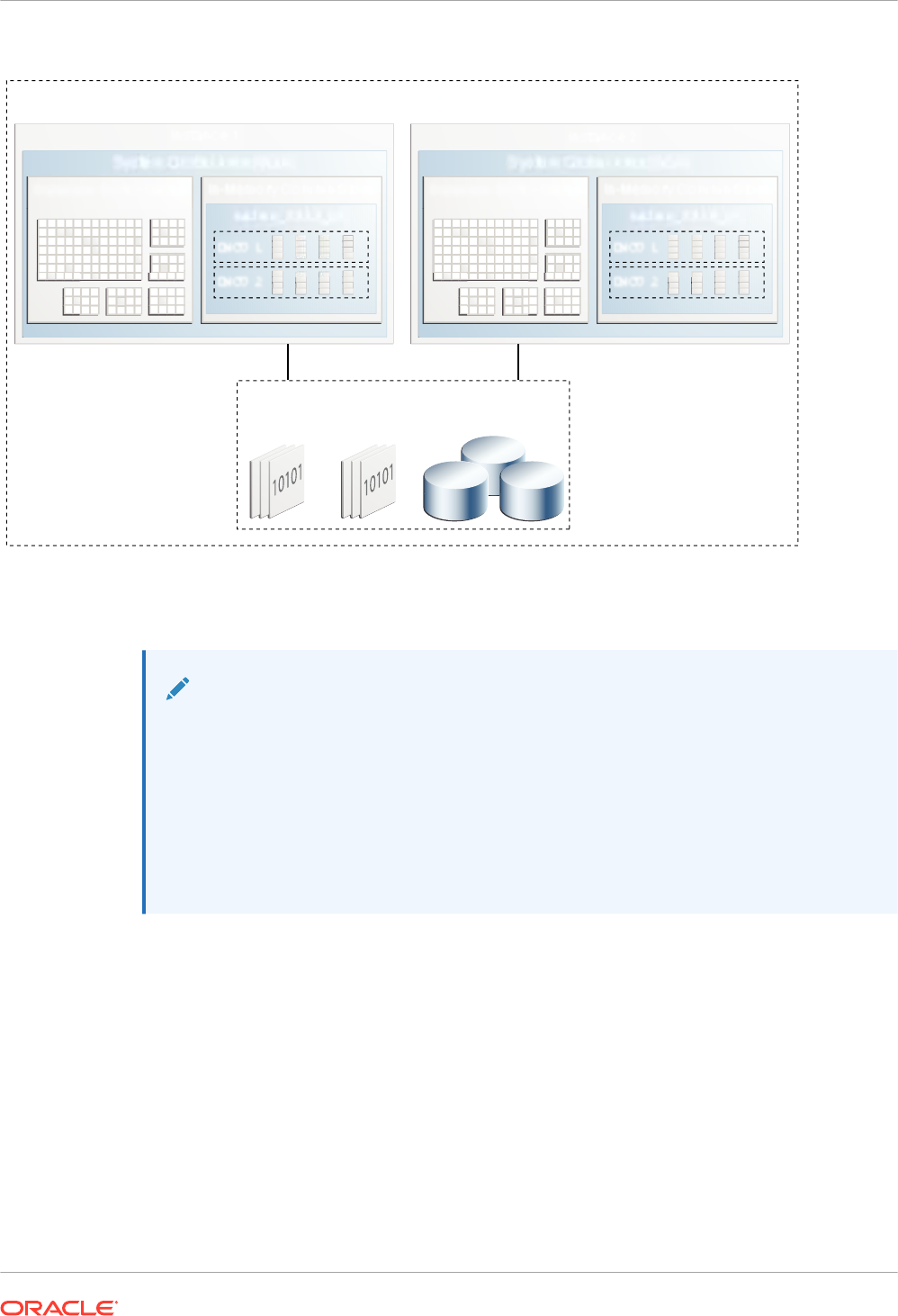
Figure 12-3 Automatic In-Memory Distribution in Oracle RAC
Database Buffer Cache
System Global Area (SGA)
Instance 1
In-Memory Column Store
IMCU 1
IMCU 2
sales_2013_pt
Database Buffer Cache
System Global Area (SGA)
Instance 2
In-Memory Column Store
IMCU 1
IMCU 2
sales_2014_pt
Oracle RAC Database
Data
Files
Control
Files
Online Redo
Logs
Database
This section contains the following topics:
See Also:
• "Space Management Worker Processes (Wnnn)"
• Oracle Real Application Clusters Administration and Deployment Guide to learn
how to manage the IM column store on Oracle RAC
• Oracle Database SQL Language Reference to learn more about the
DISTRIBUTE
clause
• Oracle Database Reference to learn about the Wnnn background processes
12.1.2.1.1 Distribution by Partition
You can use the
DISTRIBUTE BY PARTITION
clause to distribute data in partitions to different
Oracle RAC instances.
This technique is ideal for hash partitions. For example, to distribute partitions in the
orders
table equally, you could partition by hash on the
order_id
column. As shown in the following
figure, Oracle Database distributes partitions among four instances by hashing on the
order_id
column.
Chapter 12
Overview of Database In-Memory and Oracle RAC
12-5
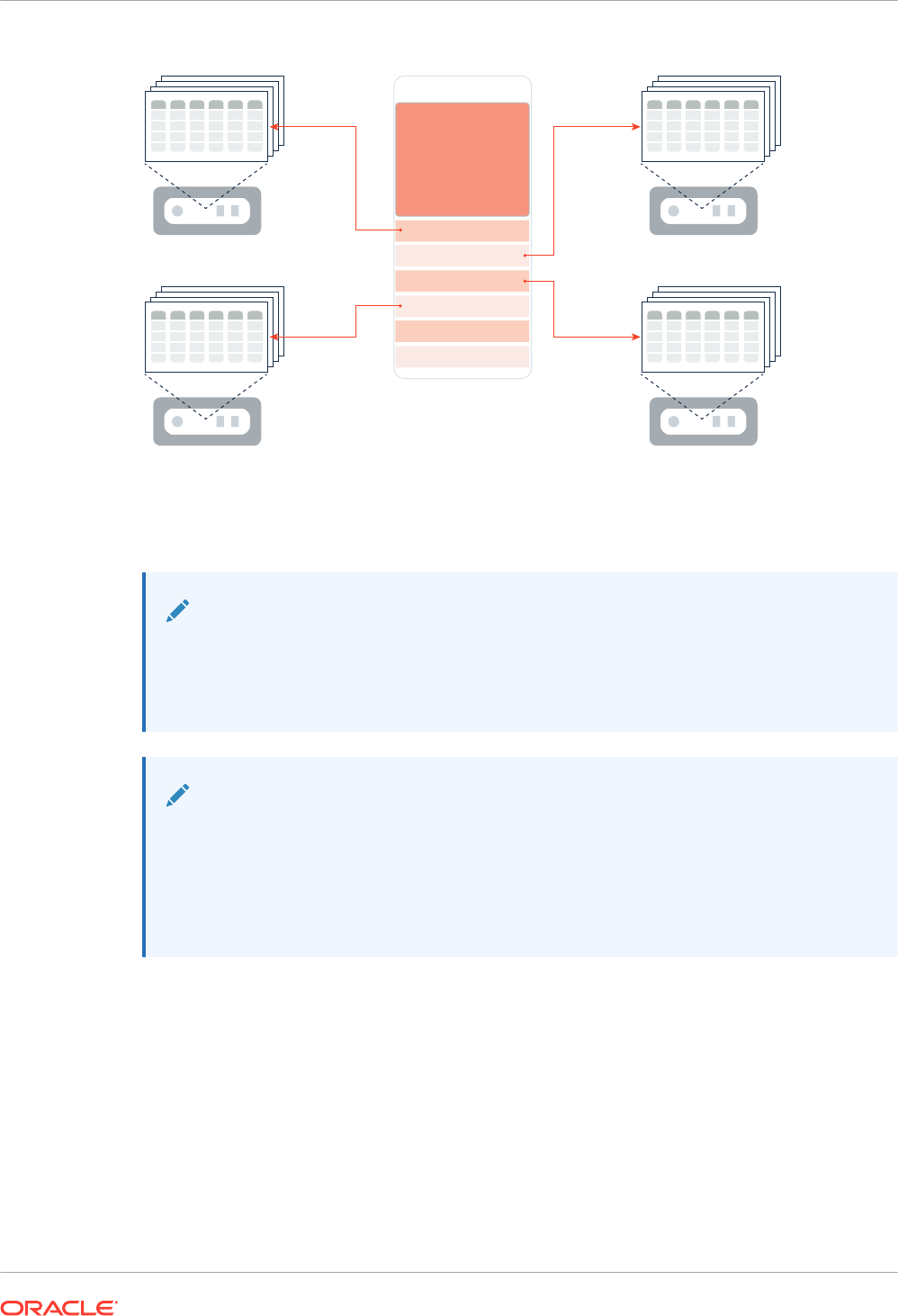
Figure 12-4 Distributing Partitions by Hash
ORDERS
PARTITION BY
HASH ON
ORDER_ID
. . .
0
1
2
3
4
This technique is suitable for other partitioning schemes when the partitions are uniformly
accessed. The
DISTRIBUTE BY PARTITION
clause also supports partition-wise joins.
Note:
If your partitioned strategy results in a large data skew, that is, one partition is much
larger than the others, then Oracle recommends that you override the default
distribution (
BY PARTITION
) by manually specifying
DISTRIBUTE BY ROWID RANGE
.
See Also:
• Oracle Database SQL Language Reference to learn more about the
DISTRIBUTE
BY PARTITION
subclause
• Oracle Database VLDB and Partitioning Guide for an introduction to partitioned
tables
12.1.2.1.2 Distribution by Subpartition
In tables with a composite partitioning scheme, you can use the
DISTRIBUTE BY SUBPARTITION
clause to distribute data in subpartitions to different instances.
This technique is ideal for hash subpartitions. For example, to distribute partitions in the
orders
table equally, you could partition by range on the
order_date
column and by hash on the
order_id
column.
Chapter 12
Overview of Database In-Memory and Oracle RAC
12-6

Figure 12-5 Distributing Partitions by Range and Subpartitions by Hash
ORDERS
PARTITION BY
RANGE ON
ORDER_DATE
SUBPARTITION
BY HASH ON
ORDER_ID
1
2
3
4
1
NOV ‘13
NOV ‘13
NOV ‘13
NOV ‘13
NOV ‘13
. . .
This technique is suitable for other partitioning schemes when the subpartitions are uniformly
accessed. The
DISTRIBUTE BY PARTITION ... SUBPARTITION
clause also supports partition-
wise joins.
See Also:
• Oracle Database VLDB and Partitioning Guide to learn more about composite
partitioning
• Oracle Database SQL Language Reference to learn more about the
DISTRIBUTE
BY PARTITION ... SUBPARTITION
subclause
12.1.2.1.3 Distribution by Rowid Range
You can use the
DISTRIBUTE BY ROWID RANGE
clause to distribute data in specific ranges of
rowids to different Oracle RAC instances.
This technique distributes IMCUs by uniform hash on the first rowid. For example, Oracle
Database might distribute rows 1-105 in the
orders
table to one database instance, rows
106-121 to a different instance, and so on.
Chapter 12
Overview of Database In-Memory and Oracle RAC
12-7

Figure 12-6 Distribution by Rowid Range
ORDERS
Rowid_Ranges
. . .
1-105
106-201
202-310
311-421
422-535
The rowid distribution technique is most useful for nonpartitioned tables. However, if your
partitioned strategy results in a large data skew, for example, one partition is much larger than
the others, then Oracle recommends overriding the default distribution (
BY PARTITION
) by
manually specifying
DISTRIBUTE BY ROWID RANGE
.
See Also:
Oracle Database SQL Language Reference to learn more about the
DISTRIBUTE BY
ROWID RANGE
subclause
12.1.2.2 Duplication of Columnar Data in Oracle RAC
The
DUPLICATE
clause controls how an Oracle RAC database duplicates columnar data across
Oracle RAC instances.
Note:
The
DUPLICATE
clause is only available with Oracle RAC on an Oracle Engineered
System. When Oracle RAC does not run on an Oracle Engineered System, the
DUPLICATE
clause is functionally equivalent to
NO DUPLICATE
.
To provide IM column store fault tolerance, you may choose to mirror the IMCUs. With IMCU
mirroring, the same IMCU resides in multiple IM column stores. This technique is analogous to
storage mirroring.
Chapter 12
Overview of Database In-Memory and Oracle RAC
12-8

Figure 12-7 Duplication of IMCUs in Oracle RAC
Node 1 Node 2
Node 3 Node 4
Using the
DUPLICATE
clause to mirror data at the tablespace or object (table, partition, or
subpartition) level provides the following benefits:
• Provides fault tolerance because if one node fails, then the mirrored columnar data is
accessible from a different node
• Improves performance because queries can access data locally, thus avoiding buffer
cache or disk access
For example, in a star query, the fact table might be partitioned, whereas the dimension
tables use
DUPLICATE ALL
. In this scenario, all joins take place fully on the local nodes.
• Enhances manageability because you can duplicate a subset of objects
For example, you can duplicate this year’s partitions while leaving others partitions from
the same table not duplicated.
A disadvantage of IMCU mirroring is that when an object is duplicated n times, its memory
requirements increase by a factor of n. For example, a 500 MB table that is duplicated in 4
instances occupies a total of 2000 MB of memory.
This section contains the following topics:
See Also:
Oracle Database SQL Language Reference to learn more about the
DUPLICATE
clause
Chapter 12
Overview of Database In-Memory and Oracle RAC
12-9

12.1.2.2.1 DUPLICATE Clause in Oracle RAC
The
DUPLICATE
clause specifies that the database maintain a copy of every IMCU in a second
database instance. Thus, the same segment is populated in exactly two Oracle RAC instances.
For each object, one IMCU is primary. A secondary IMCU resides on a different database
instance. The database can use either copy to satisfy a query. If the database instance with the
primary copy of the IMCU fails, then the database can use the surviving IMCU to satisfy the
query.
For example, you might specify
DUPLICATE
for the partition
sales_q1_2014
. The IM column
stores in instance 1 and instance 2 both have an identical copy of the data. If instance 1
terminates, then the IM column store on instance 2 can satisfy requests for
sales_q1_2014
.
See Also:
• "In-Memory Compression Units (IMCUs)"
• Oracle Database SQL Language Reference to learn more about the
DUPLICATE
clause
12.1.2.2.2 DUPLICATE ALL Clause in Oracle RAC
The
DUPLICATE ALL
clause specifies that every In-Memory object is mirrored on every
database instance.
This setting provides the highest level of redundancy and provides linear scalability because
queries can execute completely within a single node. For example, every IMCU for the
sales
table is populated in the IM column store in instance 1, instance 2, and instance 3. Thus, any
database instance can retrieve the data requested by a query of
sales
.
A consequence of the
DUPLICATE ALL
clause is that the
DISTRIBUTE
subclause has no
application because all IMCUs for the object are distributed. You specify duplication at the
object level, which means that not all objects in the IM column store required the
DUPLICATE
ALL
clause.
The primary advantages of the
DUPLICATE ALL
technique are:
• High availability
When you use
DUPLICATE ALL
clause for all In-Memory objects, an Oracle RAC database
with n instances can sustain n-1 Oracle RAC instance failures. If you need take one
database instance out of service for maintenance, then critical data is available in at least
one IM column store. The only scenario in which all data is inaccessible is a failure of all
database instances in the cluster.
• Performance of star queries
If queries join smaller dimension tables to a large partitioned fact table, then you can use
DUPLICATE ALL
to mirror dimension tables in every Oracle RAC instance. The fact table is
distributed by partition or subpartition. In this strategy, the IM column store in every
database instance has the data necessary for a star join. This technique is analogous to a
partition-wise join because the entire dimension table is populated in every IM column
store.
Chapter 12
Overview of Database In-Memory and Oracle RAC
12-10

See Also:
Oracle Database SQL Language Reference to learn more about the
DUPLICATE ALL
clause
12.1.2.2.3 NO DUPLICATE Clause in Oracle RAC
The default
NO DUPLICATE
clause specifies that the database maintain only one copy of an
object.
For example, a three-node Oracle RAC database might store the 2012 partition of a sales table
in instance 1, the 2013 partition in instance 2, and the 2014 partition in instance 3. Each table
partition resides in exactly one database instance.
If an Oracle RAC node does not duplicate the columnar data, then the columnar data on the
failed node is not available in the IM column store on the cluster. Queries issued against
missing data do not fail. Instead, queries access the data either from the database buffer
cache or permanent storage, which may negatively affect performance. If the node remains
down for some time, and if space exists in the surviving IM column stores, then Oracle RAC
populates the missing objects or pieces of the objects on the remaining nodes in the cluster.
See Also:
Oracle Database SQL Language Reference to learn more about the
NO DUPLICATE
clause
12.1.3 Parallelism in Oracle RAC
A database instance must access the IMCUs in the IM column store in which they reside.
Population and access of IM column stores in Oracle RAC must occur in parallel so that all IM
column stores are accessible from any instance.
12.1.3.1 Serial and Parallel Queries in Oracle RAC
Database In-Memory in Oracle RAC is a shared-nothing architecture. Unless at least one
parallel server process runs on every active instance, a query is not guaranteed to access all
necessary data from the IM column stores.
Serial Queries
A serial query that runs on one node in an Oracle RAC database cannot access IMCUs in the
other IM column stores. For example, a serial query running on instance 1 requests a full scan
of
sales
. Some
sales
partitions are populated in the IM column store in instance 1, whereas
the others are populated in the IM column store in instance 2. The query can only access the
IMCUs in the IM column store on instance 1: the remaining data must come from on-disk
storage.
Parallel Queries
When parallel execution is enabled, but the
PARALLEL_DEGREE_POLICY
initialization parameter is
not set to
AUTO
, the situation is similar to the serial query case. The query coordinator runs on
Chapter 12
Overview of Database In-Memory and Oracle RAC
12-11

the database instance where the query executes. The PQ processes send data to the
coordinator. In this case, the database starts multiple PQ processes. However, unless the DOP
is greater than or equal to the number of IM column stores containing IMCUs populated for
objects referenced in the query, not all data is accessible from the IM column store. When Auto
DOP is not enabled, ensure that the DOP is at least as great as the IM column stores with
IMCUs for the populated objects in the query.
In-Memory Dynamic Scans
Both serial and parallel queries can perform an In-Memory Dynamic Scan (IM dynamic scan)
and use the lightweight thread infrastructure. The parallel execution infrastructure co-exists
with the new thread infrastructure, which is dynamically managed by Oracle Database
Resource Manager (the Resource Manager). The Resource Manager is enabled by default
when
INMEMORY_SIZE
is greater than
0
.
A table scan process can be either a foreground process in a serial query or a parallel server
process in a parallel query. When a parallel query performs an IM dynamic scan, every table
scan process can own a pool of threads.
See Also:
• "In-Memory Dynamic Scans"
• Oracle Database Administrator’s Guide to learn more about the Resource
Manager
• Oracle Database VLDB and Partitioning Guide to learn more about parallel
queries in Oracle RAC
• Oracle Database Reference to learn more about the
PARALLEL_DEGREE_POLICY
initialization parameter
12.1.3.2 Auto DOP in Oracle RAC
With Automatic Degree of Parallelism (Auto DOP), the optimizer performs a cost-based
calculation to determine the degree of parallelism for a SQL statement.
Enable Auto DOP by setting the
PARALLEL_DEGREE_POLICY
initialization parameter to
AUTO
.
When the optimizer parses a SQL statement, it estimates the execution time. It checks this
estimate against the setting of the
PARALLEL_MIN_TIME_THRESHOLD
initialization parameter,
which is automatically set when the IM column store is enabled. The optimizer then makes the
following cost-based decision:
• If the estimated time is less than
PARALLEL_MIN_TIME_THRESHOLD
, then the statement
executes serially.
• If the estimated time is greater than
PARALLEL_MIN_TIME_THRESHOLD
, then the statement
executes in parallel.
The optimizer calculates the degree of parallelism based on resource requirements. The
calculation is limited by the
PARALLEL_DEGREE_LIMIT
initialization parameter and, if
configured, the Database Resource Manager.
When using IM column stores in an Oracle RAC environment, the goal is to avoid disk or buffer
cache access. To this end, you must guarantee that at least one parallel server process runs
on every active database instance. Auto DOP is the recommended way to achieve this goal.
Chapter 12
Overview of Database In-Memory and Oracle RAC
12-12

Note:
If you do not use Auto DOP, then you must ensure that the DOP is greater than or
equal to the number of IM column stores containing the IMCUs required by the query.
Auto DOP guarantees an adequate distribution of processes because every shared pool stores
metadata that indicates where all the IMCUs are located, how large they are, and so on. The
same map is in every shared pool. No matter where the query originates in the cluster, the
parallel query coordinator is aware of the home location (instance of residence) of the IMCUs.
For example, the PQ coordinator knows that the sales partitions for 2016 are in instance 1,
whereas the partitions for 2015 are in instance 2. If a query running on instance 1 requests
both 2015 and 2016 partitions, then the query coordinator uses the home location to determine
which IM column stores to access. If the DOP has been set sufficiently high, then the
coordinator automatically starts PQ processes on both instances, and the processes send the
requested data back to the query coordinator.
See Also:
Oracle Database VLDB and Partitioning Guide to learn about Auto DOP
12.1.4 FastStart Area in Oracle RAC
The FastStart area is shared across all Oracle RAC nodes. This feature enables maximum
sharing and reusability across the cluster.
Only one copy of an IMCU resides in the FastStart area. For example, if
DUPLICATE ALL
is
specified for an object in a four-node cluster, then four copies of the object exist in the IM
column stores. However, the database saves only one copy to the FastStart area.
Any database instance in an Oracle RAC cluster can use an IMCU in the FastStart area. This
feature improves performance of instance restarts in an Oracle RAC environment.
For example, the
sales
table might have three partitions:
sales_2014
,
sales_2015
, and
sales_2016
, with each partition populated in a different instance. An instance failure occurs,
with one instance unable to restart. If sufficient space is available in the IM column stores, then
the surviving instances can read the IMCUs that were previously populated in the inaccessible
instance. Thus, all three
sales
table partitions are available to applications.
See Also:
• "FastStart Area in Oracle RAC"
• Oracle Database SQL Language Reference to learn more about the
DUPLICATE
ALL
clause
Chapter 12
Overview of Database In-Memory and Oracle RAC
12-13
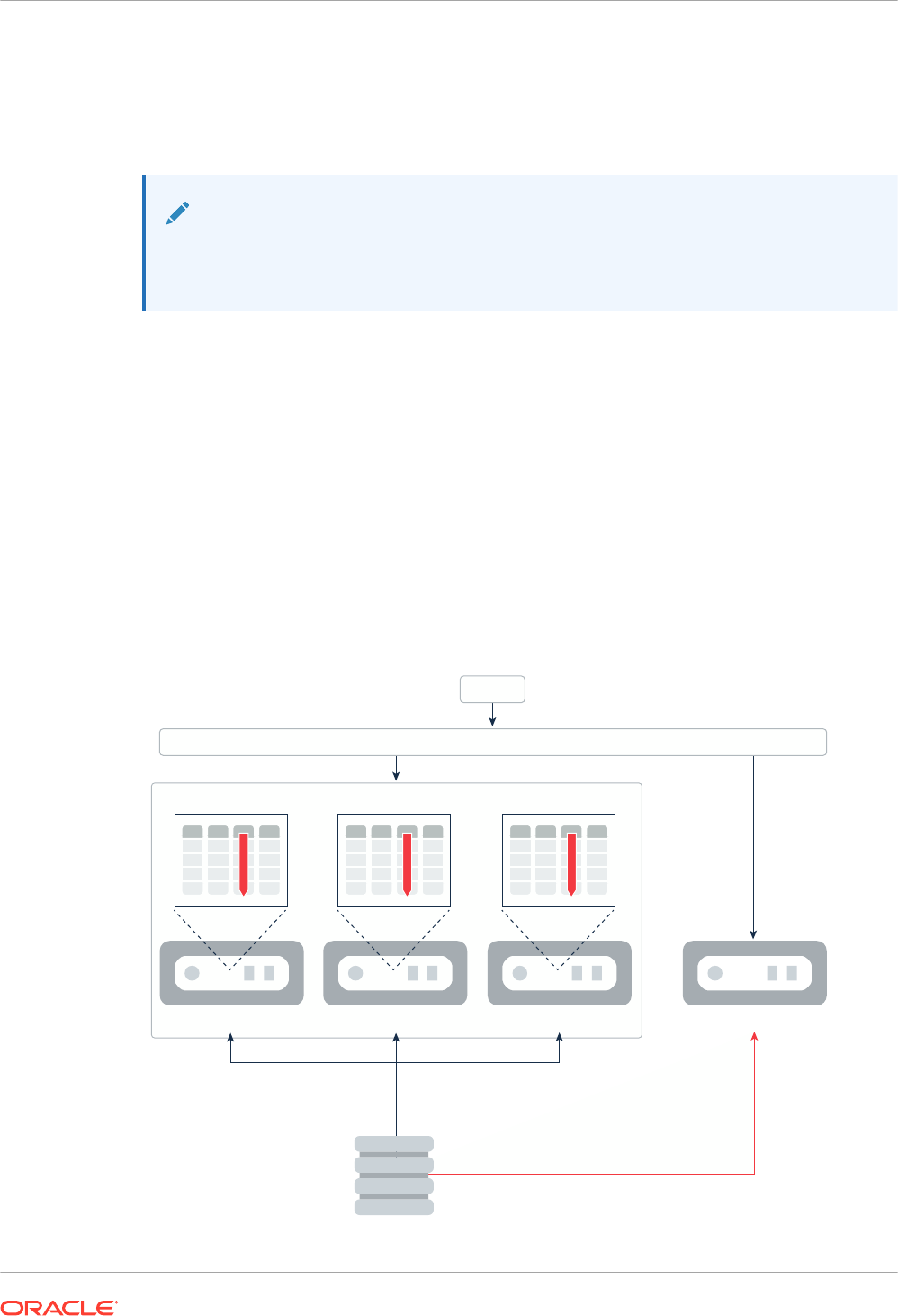
12.2 Configuring In-Memory Services in Oracle RAC
A service represents a set of instances. In Oracle RAC, you can use services to direct
connections or applications to a subset of nodes in the cluster.
See Also:
Oracle Real Application Clusters Administration and Deployment Guide to learn more
about services in Oracle RAC
12.2.1 Instance-Level Service Controls
In Oracle RAC, the population and access of IM column stores must occur in parallel so that all
IM column stores are accessible from any database instance.
The
PARALLEL_INSTANCE_GROUP
initialization parameter restricts parallel query operations to the
specified service. For example, if three out of four database instances in a cluster have an IM
column store, then you might create a service named
dbmperf
and use
PARALLEL_INSTANCE_GROUP
to assign these three instances to this service. You can then restrict
all client connections to the
dbmperf
service. Parallel operations spawn parallel execution
processes only on the instances defined in the service.
Figure 12-8 Assigning a Subset of Instances to a Service
DBMPERF Service
PARALLEL_INSTANCE_GROUP=dbmperf
Node 1
Node 2 Node 3 Node 4
In-Memory
Population and
Buffer Cache
I/O
Buffer Cache
I/O Only
Oracle Net Services Client Access
SQL
Chapter 12
Configuring In-Memory Services in Oracle RAC
12-14

See Also:
Oracle Database Reference to learn more about the
PARALLEL_INSTANCE_GROUP
initialization parameter
12.2.2 Object-Level Service Controls
For an individual object, the
INMEMORY ... DISTRIBUTE
clause has a
FOR SERVICE
subclause
that limits population to the database instance where this service can run.
The
PARALLEL_INSTANCE_GROUP
initialization parameter controls segments at the service level,
where a service represents one or more instances. In contrast,
INMEMORY ... DISTRIBUTE FOR
SERVICE
controls distribution at the segment level. For example, you can configure an
INMEMORY
object to be populated in the IM column store on instance 1 only, or on instance 2
only, or in both instances.
The
DISTRIBUTE FOR SERVICE
options are:
•
DEFAULT
- If
PARALLEL_INSTANCE_GROUP
is set, then the object is populated in all database
instances that have an IM column store specified in
PARALLEL_INSTANCE_GROUP
. If
PARALLEL_INSTANCE_GROUP
is not set, then the object is populated in all instances that have
an IM column store.
Specifying
FOR SERVICE
is equivalent to specifying
FOR SERVICE DEFAULT
.
•
ALL
- The database populates the object in all instances that have an IM column store.
Note:
If
PARALLEL_INSTANCE_GROUP
is not set, then
DEFAULT
and
ALL
are functionally
equivalent.
• service_name - As part of its duties, IMCO triggers the removal of the object from the
database instances assigned to the previous service, and populates it into the instances
assigned to the new service.
When redistributing segments, the database does the minimum work necessary. For
example, service
dbmperf
is assigned to instance 1 and instance 2. The
sales
partitions
are evenly distributed between instance 1 and instance 2. You add instance 3 to this
service. The database only populates IMCUs in instance 3 and then removes them from
instance 1 or instance 2 when necessary for even distribution. Some IMCUs remain in their
original location.
•
NONE
- IMCO removes the object from the IM column stores of the currently specified
services.
If the object has a
PRIORITY
value other than
NONE
, then Wnnn processes populate the object
during the next IMCO cycle after the DDL executes or the service starts. If the object has
PRIORITY
set to
NONE
, however, then the object is only populated during a full table scan. The
scan triggers In-Memory population on all database instances on which the specified service
for the table is active and not blocked. Note that this service can be different from the scan of
the issuing service.
If a service used for In-Memory population stops, then the database removes the segment
from the IM column stores represented by this service. In this respect, stopping the service is
Chapter 12
Configuring In-Memory Services in Oracle RAC
12-15

like shutting down the instances. The
INMEMORY
attributes of this object do not change. If the
service starts again, then the database populates the object according to its
INMEMORY
attributes. To remove an object from the IM column store, specify
NO INMEMORY
in a DDL
statement.
You can combine
DUPLICATE
with
DISTRIBUTE FOR SERVICE
. For example, you might specify
that an object use
DUPLICATE ALL
for service
dbmperf
, which is assigned to three nodes out of
four. In this case, the IM column store on each of these three nodes has a copy of the object.
See Also:
• "Prioritization of In-Memory Population"
• Oracle Database SQL Language Reference to learn more about the
DISTRIBUTE
FOR SERVICE
subclause
12.2.3 Benefits of Services for Database In-Memory in Oracle RAC
The combination of services and
DUPLICATE
enables you to control node access and In-
Memory population.
Benefits of services include the following:
• Rolling patches and upgrades
Suppose you set up an Oracle RAC service to direct client queries to the instances that
contain an IM column store. If you use the
DUPLICATE
clause, then you can selectively
remove an instance without affecting query response time. This approach assumes that
sufficient resources exist on the other instances in the service to handle the workload of
the removed instance.
For example, in a four-node cluster, you could remove each node in turn, patch it, and then
make it available again. The IMCUs for the temporarily inaccessible node are available on
at least one other node, depending on whether you use the
DUPLICATE
or
DUPLICATE ALL
clause. Thus, application access to columnar data remains uninterrupted.
• Application affinity
You can restrict application access to a single node based on service name. For example,
service
dbmperf1
is restricted to node 1, service
dbmperf2
is restricted to node 2, and so
on. When an application connects to a specific service and submits a parallel query, the
query uses processes on the nodes belonging to the same service. For example, an
application that connects to service
dbmperf1
only uses processes on node 1.
Applications can coexist in an Oracle RAC database independently and access columnar
data. Completely different objects can be populated in each node. For example, you could
direct an HR application to service
dbmperf1
, and direct a sales history application to
service
dbmperf2
.
Chapter 12
Configuring In-Memory Services in Oracle RAC
12-16

See Also:
• "About Manually Enabling Objects for In-Memory Population"
• Oracle Database SQL Language Reference for
DUPLICATE
semantics
12.2.4 Configuring an In-Memory Service for a Subset of Nodes: Example
This task explains how to assign an In-Memory service to a subset of nodes in an Oracle RAC
database.
The goal is the following:
• Create IM column stores on a subset of nodes in a RAC database
• Define a service to allow access to only the nodes that have an IM column store
Assumptions
This task assumes the following:
• The Oracle RAC database named
dbmm
has four instances:
dbm1
,
dbm2
,
dbm3
, and
dbm4
.
See "Figure 12-8".
• All instances except
dbm4
have
INMEMORY_SIZE
set to a nonzero value.
• You want to add a service named
dbmperf
and assign it to the three nodes that have an IM
column store.
• You want to populate the
sales
table in the IM column stores attached to the service.
To configure an In-Memory service for a subset of nodes:
1. Create a service that represents the three nodes running IM column stores.
On the operating system command line, use the
srvctl
command using the following
form:
srvctl add service -db db_name –s service_name
-preferred "instance_names"
For example, enter the following command:
srvctl add service –db dbmm –s dbmperf –preferred "dbm1, dbm2, dbm3"
2. Start the service.
For example, to start the
dbmperf
service, use the following command:
srvctl start service -db dbmm -service "dbmperf"
3. Create a net service name for a connection to the service.
For example, update the
tnsnames.ora
file as follows:
DBMPERF =
(DESCRIPTION =
Chapter 12
Configuring In-Memory Services in Oracle RAC
12-17

(ADDRESS =
(PROTOCOL = TCP)
(HOST = host_name)
(PORT = listener_port))
(CONNECT_DATA =
(SERVER = DEDICATED)
(SERVICE_NAME = DBMPERF)
)
)
4. Assign the
INMEMORY
attribute to the tables that you intend to populate, using the
DISTRIBUTE FOR SERVICE
subclause.
For example, alter
sales
as follows:
ALTER TABLE sales INMEMORY DISTRIBUTE FOR SERVICE "dbmperf";
The preceding statement uses the default
PRIORITY
setting of
NONE
for the
sales
table.
Therefore, population of this table occurs on demand rather than automatically.
5. To populate the
sales
table, connect to the
dbmperf
service, and then initiate a full scan of
the table.
For example, force a full scan by querying
sales
as follows:
SELECT /*+ FULL(s) */ COUNT(*) FROM sales s;
See Also:
• Oracle Database SQL Language Reference to learn more about the
INMEMORY
DISTRIBUTE FOR SERVICE
clause of
ALTER TABLE
• Oracle Database Administrator’s Guide to learn more about the
srvctl
utility
• Oracle Database Net Services Administrator's Guide to learn more about net
service names
Chapter 12
Configuring In-Memory Services in Oracle RAC
12-18

13
Deploying an IM Column Store with Oracle
Active Data Guard
This chapter explains how Database In-Memory feature works in an Oracle Active Data Guard
environment.
13.1 About Database In-Memory and Active Data Guard
Starting in Oracle Database 12c Release 2 (12.2.0.1), Oracle Database In-Memory is
supported in an Oracle Active Data Guard environment using Oracle Engineered Systems or
Oracle Cloud Platform as a Service.
See Also:
Oracle Data Guard Concepts and Administration for an introduction to Oracle Active
Data Guard
13.1.1 Purpose of IM Column Stores in Oracle Active Data Guard
You can configure an IM column store only on the primary database, only on a standby
database, or on both the primary and standby databases.
If you configure an IM column store for both databases, then you can populate the same or a
different set of objects on the two instances. This technique effectively increases the IM column
store size.
13.1.1.1 Identical IM Column Stores in Primary and Standby Databases
In the simplest scenario, the primary and standby databases both contain an IM column store
with the same size (which is not required). The IM column stores contain the same objects.
The advantage of this scenario is that analytic queries can access the IM column store on
either database. Therefore, you can direct analytic queries to the standby database and not
consume resources on the primary database. As a result, the primary database can support
the transactional workload, while the standby database supports the analytic workload.
The primary tasks are as follows:
• Set the
INMEMORY_SIZE
initialization parameter on both the primary and standby database
instances.
• Ensure that the
INMEMORY_ADG_ENABLED
initialization parameter is set to
TRUE
(default) on
the standby database instance.
• Set the
INMEMORY
attribute on all objects to be populated in the two IM column stores.
13-1

If you change the
INMEMORY
attributes of an object, then the primary database propagates the
change to the standby database. For example, if you set the
NO INMEMORY
attribute on the
sales
table, then both IM column stores evict
sales
.
On the primary database, you can enable a subset of columns of a table for population into the
IM column store. You can also specify different compression levels for different columns.
Enabling specific columns involves a dictionary change. DDL on the primary database is
propagated to the Oracle Active Data Guard database.
See Also:
• "Enabling the IM Column Store for a CDB or PDB"
• Oracle Database SQL Language Reference for information about the
CREATE
TABLE
statement
• Oracle Database Reference for more information about the
INMEMORY_SIZE
and
INMEMORY_ADG_ENABLED
initialization parameters
13.1.1.2 IM Column Store in Standby Database Only
In this scenario, an IM column store exists in the standby database, but not in the primary
database.
In this scenario, the primary database can function as a pure OLTP database. No extra
memory is required in the primary database for an IM column store. You can direct analytic
reporting applications to the standby database without sacrificing performance or consuming
resources on the primary database.
The primary tasks are as follows:
• Set the
INMEMORY_SIZE
initialization parameter to a non-zero value in the standby database
instance, and set it to
0
in the primary database instance.
• Ensure that the
INMEMORY_ADG_ENABLED
initialization parameter is set to
TRUE
(default) on
the standby database instance.
• Set the
INMEMORY
attribute with the
DISTRIBUTE FOR SERVICE
clause on all objects to be
populated in the IM column store in the standby database.
For example, if you log in to the primary database, and if you set the
INMEMORY
attribute on
the
sh.sales
table, then this table will not be populated in the IM column store on the
primary database—because no IM column store exists on this database. However, the
standby database will inherit the
INMEMORY
attribute on the
sh.sales
table. The table will be
populated in the IM column store in the standby database.
13.1.1.3 Different Objects in the Primary and Standby IM Column Stores
The most flexible scenario is separately configuring the IM column stores for primary and
standby databases.
The advantage of this scenario is that you can run different workloads in each database. For
example, an HR application runs reports in the primary database, while a sales history
application runs reports in the standby database. Thus, neither database bears the full burden
of analytic reporting.
Chapter 13
About Database In-Memory and Active Data Guard
13-2

The primary tasks are as follows:
• Set the
INMEMORY_SIZE
initialization parameter to a non-zero value on the standby and
primary database instance. The values do not need to be identical.
• Ensure that the
INMEMORY_ADG_ENABLED
initialization parameter is set to
TRUE
(default) on
the standby database instance.
• Set the
INMEMORY ... DISTRIBUTE FOR SERVICE
clause on all objects to be populated in
the two IM column stores. The service specifies the instance into which the object is
populated.
Three-Service Configuration
In a typical configuration, you create three services: standby-only, primary-only, and primary-
and-standby. For example, you may want the latest month of
sales
fact table data in the
primary instance, but the previous
sales
data in the standby instance. You want the dimension
tables populated in both instances. For each
sales
partition, you use
INMEMORY ...
DISTRIBUTE FOR SERVICE
to specify either the standby or primary service. For each dimension
table, you specify the service that includes both primary and standby database instances.
Note:
As long as the service name is defined for both the primary and standby instances,
you can specify the same service name in
DISTRIBUTE FOR SERVICE
to populate the
same tables in the primary and standby databases.
Oracle RAC and Oracle Active Data Guard
In Oracle RAC, you can combine the
FOR SERVICE
clause, which specifies the instance for
population, with the
DISTRIBUTE AUTO
or
DISTRIBUTE BY
clause, which controls the distribution
of IMCUs. However, in Oracle Active Data Guard, the
FOR SERVICE
clause specifies the
primary or standby instances in which to populate the specified object: you cannot use
DISTRIBUTE AUTO
or
DISTRIBUTE BY
to distribute IMCUs between the primary and standby
instances. For example, you cannot divide the population of the
sales
table between the
primary instance and standby instance, so that half the IMCUs are in the primary instance and
half the IMCUs are in the standby instance.
See Also:
• "Object-Level Service Controls"
• Oracle Database SQL Language Reference to learn more about the
DISTRIBUTE
FOR SERVICE
subclause
13.1.2 How IM Column Stores Work in Oracle Active Data Guard
In an Oracle Active Data Guard environment, the object-level
PRIORITY
attribute governs
population. An object is only populated in the database instances on which the service is
active.
Chapter 13
About Database In-Memory and Active Data Guard
13-3

Population is either on-demand or priority-based, depending on the
PRIORITY
value. When a
role change or switchover occurs, the database repopulates the tables according to the set of
database instances to which the service is newly mapped.
The following graphic illustrates the internal mechanism for updating a standby database with
redo from the primary database.
Figure 13-1 Updating a Standby Database
Primary Site
IM Column Store
IMCU’s for
sales table
IM Column Store
Secondary Site
IMCU’s for
sales table
Special Redo
Generation
redo shipping
1
Invalidation data
applied to SMUs
Data blocks
recovered on disk
3
2
IM column store
populated
on
demand
or by
priority
SMU
The process is as follows:
1. The primary database generates redo, and then transfers the redo to the standby
database.
The redo generated on the primary database for all DML statements includes metadata
indicating whether the change is to an
INMEMORY
object.
2. The standby database applies the redo to the data blocks stored in disk.
As the standby database applies redo generated from ongoing operations on the primary
database, the standby database keeps them transactionally consistent.
3. If an
INMEMORY
object is modified, then the standby database invalidates the modified rows
just as it does on the primary database, using the transaction journal and Snapshot
Metadata Unit (SMU) to track the changes.
The repopulation mechanism works the same way in a standby database as it does in a
primary database. When sufficient DML occurs on an object to reach an internal threshold, the
standby database repopulates the object in the IM column store.
See Also:
• "About Repopulation of the IM Column Store"
• "About Join Groups"
• Oracle Data Guard Concepts and Administration to learn more about multi-
instance redo apply
Chapter 13
About Database In-Memory and Active Data Guard
13-4

13.1.3 In-Memory Restrictions in Active Data Guard
Most In-Memory features are supported in Active Data Guard.
Standby databases do not support the following In-Memory features:
• IM FastStart
• Join groups
• IM expression capture
• Heat Map (which reflects the primary database only)
Data Guard Multi-Instance Redo Apply is supported for the IM column store on an Active Data
Guard standby database, but only when the initialization parameter
ENABLE_IMC_WITH_MIRA
is
set to
TRUE
. By default,
ENABLE_IMC_WITH_MIRA
is
FALSE
.
See Also:
Oracle Database Reference to learn more about
ENABLE_IMC_WITH_MIRA
13.2 Configuring IM Column Stores in an Oracle Active Data
Guard Environment
Configuring IM column stores in Oracle Active Data Guard requires setting
INMEMORY_SIZE
, and
setting the
INMEMORY
attribute appropriately for the objects to be populated.
This task assumes knowledge of Oracle Active Data Guard concepts and procedures.
Prerequisites
You must meet the following requirements:
• The standby database must run on an Oracle Engineered System or in Oracle Cloud
Platform as a Service.
• The
COMPATIBLE
initialization parameter must be
12.2.0
or greater.
• To populate different objects in each database, configure the appropriate services.
To configure IM column stores in an Oracle Active Data Guard environment:
1. Set the
INMEMORY_SIZE
initialization parameter on the database instances that will contain
an IM column store.
Follow these guidelines:
• To configure IM column stores on the primary and standby databases, set
INMEMORY_SIZE
on both database instances.
• To configure IM column stores on the standby database only, set
INMEMORY_SIZE
on
the standby database instance.
2. Ensure that the
INMEMORY_ADG_ENABLED
initialization parameter is set to
TRUE
(default) on
the standby database instance.
Chapter 13
Configuring IM Column Stores in an Oracle Active Data Guard Environment
13-5

3. Optionally, if you want to enable Multi-Instance Redo Apply with the IM column store, set
the
ENABLE_IMC_WITH_MIRA
initialization parameter to
TRUE
.
4. On the primary database, execute DDL statements with the
INMEMORY
attribute.
The task depends on where the IM column stores exist, and in which IM column stores you
want the objects to be populated:
• To populate an object on the standby database only, then set the
INMEMORY
attribute
with a
DISTRIBUTE FOR SERVICE
clause that specifies a valid service running only on
the standby database.
During redo transfer, the standby database receives this DDL statement from the
primary database. Population occurs on the standby database in the normal way. For
example, if
sales
has the
INMEMORY
attribute and priority
NONE
, then the table must
undergo a full scan for population to occur.
• To populate an object on the primary database only, then set the
INMEMORY
attribute
with a
DISTRIBUTE FOR SERVICE
clause that specifies a valid service running only on
the primary database.
• To populate an object on both primary and standby databases, then perform one of the
following actions:
– Do not set the
DISTRIBUTE FOR SERVICE
clause.
– Set
DISTRIBUTE FOR SERVICE servicename
, where
servicename
is a service that
is running on both the primary and standby databases.
– Set
DISTRIBUTE FOR SERVICE DEFAULT
so that the object is eligible for population
on all instances specified with the
PARALLEL_INSTANCE_GROUP
initialization
parameter.
– Set
DISTRIBUTE FOR SERVICE ALL
so that the object is eligible for population on all
instances, regardless of the setting of the
PARALLEL_INSTANCE_GROUP
initialization
parameter.
Population of an object occurs on the primary or standby database according to the
priority setting. For example, if
sales
on the standby database has priority
NONE
, then a
query of the standby database that triggers a full scan of
sales
populates this table in
the standby IM column store.
Note:
A full scan of
sales
on the standby database does not populate this table in
the IM column store in the primary database.
Chapter 13
Configuring IM Column Stores in an Oracle Active Data Guard Environment
13-6

See Also:
• "Prioritization of In-Memory Population"
• Oracle Data Guard Concepts and Administration
• Oracle Database SQL Language Reference to learn more about the
DISTRIBUTE
FOR SERVICE
subclause
• Oracle Database Reference for more information about the
INMEMORY_SIZE
,
INMEMORY_ADG_ENABLED
, and
ENABLE_IMC_WITH_MIRA
initialization parameters
Chapter 13
Configuring IM Column Stores in an Oracle Active Data Guard Environment
13-7

Part V
Database In-Memory Reference
The Part contains initialization parameters and views relevant for the In-Memory Column Store
(IM column store).

14
In-Memory Initialization Parameters
Several initialization parameters control the behavior of the IM column store.
This chapter is a summary only. Oracle Database Reference contains complete information for
all database views.
Table 14-1 Initialization Parameters Related to the IM Column Store
Initialization Parameter Description
INMEMORY_ADG_ENABLED
Indicates whether In-Memory for Oracle Active Data Guard is
enabled (
TRUE
) or disabled (
FALSE
) on the standby database.
The default is
TRUE
.
For Active Data Guard, media recovery must retrieve In-Memory
objects when applying redo and invalidate the related objects
after the query advance. This parameter controls whether media
recovery performs the retrieving and invalidating.
You can only modify this system-level parameter when standby
recovery is not running. If the standby database uses Oracle
RAC, then this parameter must be set to the same value on every
instance.
INMEMORY_AUTOMATIC_LEVEL
Automates the management of the IM column store by helping to
ensure that the working data set is always in the IM column store.
You can set the following values:
•
OFF
: When this value is set, Automatic In-Memory is
disabled. This value returns the IM column store to the
behavior that existed before Oracle Database 18c. If you do
not expect a stable working data set, then set the parameter
to
DISABLE
.
•
LOW
: When this value is set, the database evicts cold
segments from the IM column store when it is under memory
pressure.
•
MEDIUM
: This level includes an additional optimization that
ensures that any hot segment that was not populated
because of memory pressure is populated first.
•
HIGH
: This level fully automates management of the IM
column store. Oracle Database automatically decides the
optimal set of segments and the optimal columns to populate
in the IM column store, evicting infrequently accessed
segments. No user decision-making is required.
14-1

Table 14-1 (Cont.) Initialization Parameters Related to the IM Column Store
Initialization Parameter Description
INMEMORY_CLAUSE_DEFAULT
Specifies a default IM column store clause for new tables and
materialized views.
This parameter supports the following options:
• To specify that there is no default IM column store clause for
new tables and materialized views, leave this parameter
unset or set it to an empty string. Setting this parameter to
NO
INMEMORY
has the same effect as setting it to the default
value (the empty string).
• To specify that the clause is the default for all new tables and
materialized views, set this parameter to a valid
INMEMORY
clause. The clause can include valid clauses for IM column
store compression methods and data population options. The
options are:
– If the clause starts with
INMEMORY
, then all new tables
and materialized views, including those without an
INMEMORY
clause, are populated in the IM column store.
– If the clause omits
INMEMORY
, then it only applies to new
tables and materialized views that are enabled for the IM
column store with an
INMEMORY
clause during creation.
INMEMORY_EXPRESSIONS_USAGE
Controls which IM expressions are eligible to be populated in the
IM column store.
This parameter supports the following options:
•
ENABLE
The database populates both static and dynamic IM
expressions into the IM column store. Setting this value
increases the In-Memory footprint for some tables. This is the
default.
•
STATIC_ONLY
A static configuration enables the IM column store to cache
OSON (binary JSON) columns, which are marked with an
IS_JSON
check constraint. Internally, an OSON column is a
hidden virtual column named
SYS_IME_OSON
.
•
DYNAMIC_ONLY
The database only populates frequently used or “hot”
expressions that have been added to the table as
SYS_IME
hidden virtual columns. Setting this value increases the In-
Memory footprint for some tables.
•
DISABLE
The database does not populate any IM expressions,
whether static or dynamic, into the IM column store.
Note:
IM expressions do not support NLS-
dependent data types.
Chapter 14
14-2

Table 14-1 (Cont.) Initialization Parameters Related to the IM Column Store
Initialization Parameter Description
INMEMORY_FORCE
Enables or disables tables and materialized views for the IM
column store.
This parameter supports the following options:
• To allow the
INMEMORY
or
NO INMEMORY
attributes to
determine population, set this parameter to
DEFAULT
(the
default value). You can set this value dynamically.
• To disable all tables and materialized views for the IM column
store, set this parameter to
OFF
. You can set this value
dynamically.
• To enable the Database In-Memory Base Level, set this
parameter to
BASE_LEVEL
in the CDB root initialization
parameter file (not at the PDB level). You cannot set this
value dynamically.
When the CDB uses the Base Level, Automatic In-Memory is
disabled, and the compression level for
INMEMORY
objects
and columns is automatically set to
QUERY LOW
.
• To use the CellMemory feature without incurring the
overhead of creating an IM column store, set this parameter
to
CELLMEMORY_LEVEL
.
You cannot set this value dynamically.
Note that if the value of
INMEMORY_SIZE
is greater than
0
,
then setting
INMEMORY_FORCE=CELLMEMORY_LEVEL
is
equivalent to setting
INMEMORY_FORCE=DEFAULT
. In this
case, the Database In-Memory option is enabled, even if you
use CellMemory only.
INMEMORY_MAX_POPULATE_SERVERS
Specifies the maximum number of Space Management Worker
Processes (Wnnn) to use for population so that the processes do
not overload the rest of the system.
Set this parameter to an appropriate value based on the number
of cores in the system. The default is half the effective CPU
thread count or the
PGA_AGGREGATE_TARGET
value divided by
512 MB, whichever is less.
Note: When
INMEMORY_MAX_POPULATE_SERVERS
is set to
0
,
objects cannot be populated in the IM column store
INMEMORY_OPTIMIZED_ARITHMETIC
Controls whether
NUMBER
columns are stored in an In-Memory
optimized format.
This parameter supports the following options:
•
DISABLE
(the default) does not use the optimized encoding.
•
ENABLE
encodes numbers in an optimized format that
enables native calculations using SIMD hardware. This
optimization is available for tables with
FOR QUERY LOW
compression.
INMEMORY_QUERY
Specifies whether In-Memory queries are allowed.
This parameter supports the following options:
•
ENABLE
(the default) allows queries to access populated
objects.
•
DISABLE
blocks access to populated objects.
Chapter 14
14-3

Table 14-1 (Cont.) Initialization Parameters Related to the IM Column Store
Initialization Parameter Description
INMEMORY_SIZE
Sets the size of the IM column store in a database instance. The
default is 0, which disables the IM column store. The database
must be restarted after setting this parameter in order to enable
the IM column store.
Any value larger than 0 and under 100M means In-Memory is
enabled for future growth, but no memory is currently provisioned
to the In-Memory Area.
If you use the
ALTER SYSTEM
command to modify the value of
this parameter for the current instance, you must specify a value
that is greater than or equal to the initial value. You can shrink the
In-Memory area up to the initial value of
INMEMORY_SIZE
.
For the Database In-Memory Base Level option, the size must not
exceed 16 GB for a CDB. In an Oracle RAC database, the
INMEMORY_SIZE
setting in each database instance must not
exceed 16 GB.
INMEMORY_TRICKLE_REPOPULATE_SERVERS_PERCENT
Limits the percentage of the total population and repopulation
processes that perform trickle repopulation.
The value for this parameter is a percentage of the
INMEMORY_MAX_POPULATE_SERVERS
initialization parameter
value. For example, if
INMEMORY_TRICKLE_REPOPULATE_SERVERS_PERCENT
is 5
percent, and if
INMEMORY_MAX_POPULATE_SERVERS
is 20, then
the IM column store uses an average of 1 core (.05 * 20) for
trickle repopulation.
INMEMORY_VIRTUAL_COLUMNS
Controls which expressions are populated in the IM column store.
This parameter supports the following options:
•
MANUAL
(the default) permits population of IM virtual columns
explicitly specified as
INMEMORY
.
•
ENABLE
permits population of all IM virtual columns in an
INMEMORY
table, unless these columns have been explicitly
excluded from the IM column store.
•
DISABLE
specifies that no IM virtual columns are eligible for
population.
OPTIMIZER_INMEMORY_AWARE
Controls the optimizer cost model enhancements for Database In-
Memory.
This parameter supports the following options:
•
TRUE
(default) optimizes SQL statements that reference
INMEMORY
objects.
•
FALSE
ignores the
INMEMORY
attribute of tables during
optimization.
Chapter 14
14-4

15
In-Memory Views
This topic describes data dictionary and dynamic performance views related to the In-Memory
Column Store (IM column store).
Table 15-1 In-Memory Views
Initialization Parameter Description
DBA_EXPRESSION_STATISTICS
Provides expression usage tracking statistics for all the tables in the
database.
DBA_EXTERNAL_TABLES
Describes all external tables in the database. The
INMEMORY
column
indicates whether the table is enabled for
INMEMORY
, and
INMEMORY_COMPRESSION
indicates the compression level.
Related views include
ALL_XTERNAL_PART_TABLES
,
ALL_XTERNAL_TAB_PARTITIONS
, and
ALL_XTERNAL_TAB_SUBPARTITIONS
.
DBA_FEATURE_USAGE_STATISTICS
Displays information about database feature usage statistics. When
the IM column store is accessed, the
NAME
column shows
In-Memory
Column Store
.
DBA_HEAT_MAP_SEGMENT
Displays the latest segment access time for all segments. The
timestamps in the view are coarse with a granularity of a day reflecting
the flush times of the heat map.
DBA_INMEMORY_AIMTASKS
Describes the status of tasks created by Automatic In-Memory.
DBA_INMEMORY_AIMTASKDETAILS
Describes the object and action taken by Automatic In-Memory.
DBA_ILMDATAMOVEMENTPOLICIES
Contains information specific to data movement-related attributes of an
Automatic Data Optimization policy in a database.
DBA_IM_EXPRESSIONS
Describes the IM expressions, which have the column prefix
SYS_IME
,
that have the
INMEMORY
attribute.
DBA_JOINGROUPS
Describes join groups in the database. A join group is an object that
lists two columns that can be meaningfully joined. Join groups can be
either user-created or created by Automatic In-Memory.
DBA_SEGMENTS
Describes the storage allocated for all segments in the database.
Several columns, including
INMEMORY
and
INMEMORY_PRIORITY
,
describe In-Memory attributes of the segment.
DBA_TABLES
Indicates which tables have the
INMEMORY
attribute set (the
INMEMORY
column is
ENABLED
) or not set (
DISABLED
).
V$ACTIVE_SESSION_HISTORY
Displays sampled session activity. Several columns, including
INMEMORY_QUERY
and
INMEMORY_POPULATE
, describe session
activity relating to the In-Memory Column Store at the time of
sampling.
V$HEAT_MAP_SEGMENT
Displays real-time segment access information.
V$IM_COLUMN_LEVEL
Presents the selective column compression levels that are defined
using the
INMEMORY
clause of the
CREATE TABLE
statement.
SYS_IME
hidden virtual columns are not shown in this view.
15-1

Table 15-1 (Cont.) In-Memory Views
Initialization Parameter Description
V$IM_SEGMENTS
Presents information about all In-Memory segments in the database.
Only segments that have an In-Memory representation are displayed.
If a segment is marked for the IM column store but is not populated,
the view does not contain a corresponding row for this segment.
V$INMEMORY_AREA
Displays information about the space allocation inside the In-Memory
Area.
V$INMEMORY_FASTSTART_AREA
Provides information about the In-Memory FastStart (IM FastStart)
area.
V$INMEMORY_OBJECT_ADVICE Estimates the scan times for various objects in different simulated In-
Memory Column Store (IM Column Store) sizes.
V$INMEMORY_OBJECT_ADVICE_PDB Estimates the scan times for various PDB-level objects in different
simulated In-Memory Column Store (IM Column Store) sizes.
V$INMEMORY_SIZE_ADVICE Estimates usage and performance statistics for different simulated
sizes of the In-Memory Column Store (IM Column Store) in the CDB.
V$INMEMORY_OBJECT_ADVICE_PDB Estimates the scan times for various PDB-level objects in different
simulated In-Memory Column Store (IM Column Store) sizes.
V$SGA
Displays the size of the In-Memory Area.
Chapter 15
15-2

A
Using IM Column Store in Cloud Control
You can configure and manage the IM column store in Oracle Enterprise Manager Cloud
Control (Cloud Control).
A.1 Meeting Prerequisites for Using IM Column Store in Cloud
Control
Before you can enable a database to use the IM column store, ensure that the
COMPATIBLE
is
set to 12.1.0.0 or higher.
To set the compatibility level, follow these steps:
1. From the Database Home page in Enterprise Manager, choose Initialization Parameters
from the Administration menu to navigate to the Initialization Parameters page.
You can use this page to set or change the compatibility level.
2. Search for the
COMPATIBLE
initialization parameter.
The category for the parameter is Miscellaneous.
3. Change the value to
12.1.0.0
and click Apply.
Cloud Control prompts you to restart the database. After the database is restarted, the new
value takes effect.
To set or change the size of the IM column store, follow these steps:
1. From the Database Home page in Enterprise Manager, choose Initialization Parameters
from the Administration menu to navigate to the Initialization Parameters page.
2. Search for the parameter
INMEMORY_SIZE
. The category for the parameter is In-Memory.
3. Change the value and click Apply.
You can set the value to any value above the minimum size of 100 MB.
You will then be prompted to restart the database.
A.2 Using the In-Memory Column Store Central Home Page to
Monitor In-Memory Support for Database Objects
Use the In-Memory Column Store Central Home page to monitor In-Memory support for
database objects such as tables, indexes, partitions and tablespaces. You can view in-memory
functionality for objects and monitor their In-Memory usage statistics.
You can complete the following actions on the In-Memory Column Store Central Home page:
• The In-Memory Object Access Heatmap displays the top 100 objects in the IM column
store with their relative sizes and shows you how frequently objects are accessed,
represented by different colors. To activate the heat map, you must turn on the option for
A-1

the Heat Map in the initialization parameter file. Typically, there is a one day wait period
before the map is activated. You can use the date selector to pick the date range for
objects displayed in the Heat Map. You can also use the slider to control the granularity of
the color.
• Use the Configuration section to view the status settings such as In-Memory Query, In-
Memory Force, and Default In-Memory Clause. Click Edit to navigate to the Initialization
Parameters page where you can change the values and settings displayed in this section.
Use the Performance section to view the metrics for Active Sessions.
• Use the Objects Summary section to view the Compression Factor and data about the
memory used by the populated objects. The In-Memory Enabled Object Statistics are
available in a pop-up window through a drill-down from the View In-Memory Enabled
Object Statistics link on the page.
• Use the In-Memory Objects Distribution section to view the distribution on a percentage
basis of the various objects used in memory. The section includes a chart showing the
distribution of Partitions, Subpartitions, Non-partitioned Tables, and Non-partitioned
Materialized Views. The numerical values for each are displayed above the chart.
• Use the In-Memory Objects Search section to search for objects designated for In-Memory
use. Click Search after you enter the parameters by which you want to search. The results
table shows the Name of each object found along with its Size, Size in Memory, Size on
Disk, In-Memory percentage, and its In-Memory parameters. You can also search for
accessed objects that are either in-memory or not in-memory. If the Heat Map is enabled,
then the Accessed Objects option appears in the drop-down list in the View field of the In-
Memory Objects Search box. When you select Accessed Objects, you can filter based on
the top 100 objects with access data that are either in-memory or not in-memory. You can
select a time range and search for objects within that range. If you select the All Objects In-
Memory option, you can view the list of top 100 objects that are in-memory based on their
in-memory size.
If you are working in an Oracle RAC environment, you can quickly move between instances by
selecting the instance in the Instances selection box above and on the right side of the Heat
Map.
A.3 Specifying In-Memory Details When Creating a Table or
Partition
You can specify IM column store details when creating a table or partition.
1. From the Schema menu, choose Database Objects, then select the Tables option.
2. Click Create to create a table.
The Create Table page is shown. Select the In-Memory Column Store tab to specify the in-
memory options for the table.
3. Choose to override the column level in-memory details (if required) in the table below
where the columns are specified.
4. Optionally, you can click on the Partitions tab.
5. Create table partitions as needed using the wizard.
To specify IM column store details for a partition, select it from the table in the Partitions
tab, and then click Advanced Options.
6. After entering all necessary IM column store details at the table level, column level, and
partitions level, click Show SQL to see the generated SQL. Click OK to create the table.
Appendix A
Specifying In-Memory Details When Creating a Table or Partition
A-2

A.4 Viewing or Editing IM Column Store Details of a Table
You can view or edit IM column store details of a table.
1. From the Schema menu, choose Database Objects, and then select the Tables option.
2. Search for the desired table, and then click View to view its details.
3. Click Edit to launch the Edit Table page.
Alternatively, on the Search page, click Edit. Click the In-Memory Column Store tab to
specify In-Memory options for the table.
4. Edit the required details.
5. Click Apply.
A.5 Viewing or Editing IM Column Store Details of a Partition
You can view or edit IM column store details of a partition.
1. From the Schema menu, choose Database Objects, then select the Tables option.
2. Search for the table that contains the desired partition, select it, and then click View.
3. Click Edit to launch the Edit Table page.
Alternatively, on the Table Search page, click Edit.
4. Click the Partitions tab, and then select the desired partition.
5. Click Advanced Options.
6. Edit the required details.
7. Click OK to return to the Partitions tab.
8. After making similar changes to all desired partitions of the table, click Apply.
A.6 Specifying IM Column Store Details During Tablespace
Creation
You can specify IM column store details when creating a tablespace.
1. From the Administration menu, choose Storage, and then select Tablespaces.
2. Click Create to create a tablespace.
3. Enter the details that appear on the General tab.
4. Click the In-Memory Column Store tab.
5. Enter all required IM column store details for the tablespace.
6. Click Show SQL.
7. In the Show SQL page, click Return.
Another page appears.
8. Click OK.
9. Click OK to create the tablespace.
Appendix A
Viewing or Editing IM Column Store Details of a Table
A-3

The IM column store settings of a tablespace apply for any new table created in the
tablespace. IM column store configuration details must be specified at the individual table level
if a table must override the configuration of the tablespace.
A.7 Viewing and Editing IM Column Store Details of a Tablespace
You can view or edit IM column store details of a tablespace.
1. From the Administration menu, choose Storage, then select the Tablespaces option.
2. Search for the desired tablespace, select it, then click View.
3. Click Edit to launch the Edit Tablespace page, then click the In-Memory Column Store
tab.
4. Edit the required details and click Apply.
A.8 Specifying IM Column Store Details During Materialized View
Creation
You can specify IM column store details when creating a materialized view.
1. From the Schema menu, choose Materialized Views, then select the Materialized Views
option.
2. Click Create to create a materialized view.
3. Enter the materialized view name, and specify its query.
4. Click the In-Memory Column Store tab to specify IM column store options for the
materialized view.
5. After entering all necessary IM column store details, click Show SQL. Click Return from
the Show SQL page, and then in the resulting page click OK.
6. Click OK to create the materialized view.
A.9 Viewing or Editing IM Column Store Details of a Materialized
View
You can view or edit IM column store details of a materialized view.
1. From the Schema menu, choose Materialized Views, then select the Materialized Views
option.
2. Search for the desired materialized view, and click View to view its details.
3. Click Edit to launch the Edit Materialized View page.
4. Click the In-Memory Column Store tab to specify IM column store options for the
materialized view.
5. Edit the required details, and click Apply.
Appendix A
Viewing and Editing IM Column Store Details of a Tablespace
A-4

Glossary
ADO policy
A policy that specifies a rule and condition for Automatic Data Optimization (ADO). For
example, an ADO policy may specify that an object is marked
NOINMEMORY
(action) 30 days
after creation (condition). Specify ADO policies using the
ILM
clause of
CREATE TABLE
and
ALTER TABLE
statements.
Automatic Data Optimization (ADO)
A technology that creates policies, and automates actions based on those policies, to
implement an Information Lifecycle Management (ILM) strategy.
Automatic In-Memory
A feature that automatically evicts cold (infrequently accessed) segments from the IM column
store to ensure that the working data set is always populated.
availability
The degree to which an application, service, or function is accessible on demand.
Bloom filter
A low-memory data structure that tests membership in a set. The database uses Bloom filters
to improve the performance of hash joins.
Column Compression Unit (CU)
Contiguous storage for a column in an In-Memory Compression Unit (IMCU).
columnar data pool
The subpool in the In-Memory Area that stores columnar data. It is also known as the 1 MB
pool.
Glossary-1

columnar format
The column-based format for objects that reside in the In-Memory Column Store. The
columnar format contrasts with the row format used in data blocks.
common dictionary
A segment-level, instance-specific set of common dictionary codes, created from local
dictionaries. A local dictionary is a sorted list of dictionary codes specific to a Column
Compression Unit (CU). A join group uses a common dictionary to optimize joins.
compression tiering
The application of different levels of compression to data based on its access pattern. For
example, administrators may compress inactive data at a higher rate of compression at the
cost of slower access.
data flow operator (DFO)
The unit of work between data redistribution stages in a parallel query.
dense grouping key
A key that represents all grouping keys whose grouping columns come from a specific fact
table or dimension.
dense join key
A key that represents all join keys whose join columns come from a particular fact table or
dimension.
dense key
A numeric key that is stored as a native integer and has a range of values.
double buffering
A repopulation mechanism in which background processes create new In-Memory
Compression Unit (IMCU) versions by combining the original rows with the latest modified
rows. During repopulation, the stale IMCUs remain accessible for queries.
expression
A combination of one or more values, operators, and SQL functions that resolves to a value.
expression capture interval
The time interval within which the database considers IM expressions for possible capture.
Glossary
Glossary-2

expression capture window
An expression capture interval defined by invocation of the
IME_OPEN_CAPTURE_WINDOW
and
IME_OPEN_CAPTURE_WINDOW
procedures in the
DBMS_INMEMORY_ADMIN
package.
Expression Statistics Store (ESS)
A repository maintained by the optimizer to store statistics about expression evaluation. For
each segment, the ESS monitors statistics such as frequency of execution, cost of evaluation,
timestamp evaluation, and so on. The ESS is persistent in nature and has an SGA
representation for fast lookup of expressions.
FastStart area
A designated tablespace to which the database periodically writes In-Memory columnar data.
Heat Map
Heat Map shows the popularity of data blocks and rows. Automatic Data Optimization (ADO) to
decide which segments are candidates for movement to a different storage tier.
home location
The database instance in which an IMCU resides. When auto DOP is enabled on Oracle RAC,
the parallel query coordinator uses home location to determine where each IMCU is located,
how large it is, and so on.
In-Memory hybrid scan
A query that scans both the IM column store and the row store. The optimizer considers an In-
Memory hybrid scan automatically when all predicate columns have the
INMEMORY
attribute,
and some columns in the
SELECT
list do not have the
INMEMORY
attribute.
hybrid partitioned table
A table in which some partitions are stored in data file segments and some are stored in
external data source.
IM aggregation
An optimization that accelerates aggregation for queries that join from a single large table to
multiple small tables. The transformation uses
KEY VECTOR
and
VECTOR GROUP BY
operators,
which is why it is also known as
VECTOR GROUP BY
aggregation.
IM column store
An optional SGA area that stores copies of tables and partitions in a columnar format
optimized for rapid scans.
Glossary
Glossary-3

IM dynamic scan
The use of lightweight threads to automatically parallelize In-Memory table scans.
IM expression
A SQL expression whose results are stored in the In-Memory Column Store. If
last_name
is a
column stored in the IM column store, then an IM expression might be
UPPER(last_name)
.
IMCU mirroring
In Oracle RAC, the duplication of an IMCU in multiple IM column stores. For example, the IM
column stores on instance 1 and instance 2 are populated with the same
sales
table.
IMCU pruning
In a query of the In-Memory Column Store, the elimination of IMCUs based on the high and
low values in each IMCU. For example, if a statements filters product IDs greater than 100,
then the database avoids scanning IMCUs that contain values less than 100.
IM storage index
A data structure in an IMCU header that stores the minimum and maximum for all columns
within the IMCU.
In-Memory Advisor
A downloadable PL/SQL package that analyzes the analytical processing workload in your
database. This advisor recommends a size for the IM column store and a list of objects that
would benefit from In-Memory population.
In-Memory Aggregation
See IM aggregation.
In-Memory Area
An optional SGA component that contains the IM column store.
In-Memory Column Store
See IM column store.
In-Memory Compression Unit (IMCU)
A storage unit in the In-Memory Column Store that is optimized for faster scans. The In-
Memory Column Store stores each column in table separately and compresses it. Each IMCU
contains all columns for a subset of rows in a specific table segment.
A one-to-many mapping exists between an IMCU and a set of database blocks. For example, if
a table contains columns
c1
and
c2
, and if its rows are stored in 100 database blocks on disk,
Glossary
Glossary-4

then IMCU 1 might store the values for both columns for blocks 1-50, and IMCU 2 might store
the values for both columns for blocks 51-100.
In-Memory Coordinator Process (IMCO)
A background process whose primary task is to initiate background population and
repopulation of columnar data.
In-Memory Dynamic Scan
See IM dynamic scan.
In-Memory Expression
See IM expression.
In-Memory Expression Unit (IMEU)
A container that stores the computed result of an In-Memory Expression (IM expression). Each
IMEU is linked to its own parent In-Memory Compression Unit (IMCU).
In-Memory FastStart
A feature that significantly reduces the time to populate data into the IM column store when a
database instance restarts.
In-Memory population
See population.
In-Memory virtual column
A virtual column that is eligible to be populated in the In-Memory Column Store.
Information Lifecycle Management (ILM)
A set of processes and policies for managing data throughout its useful life.
join group
A user-defined object that specifies frequently joined columns from the same table or different
tables. External tables are not supported.
A typical join group candidate is a set of columns used to join fact and dimension tables. Join
groups are only supported when
INMEMORY_SIZE
is a nonzero value.
Glossary
Glossary-5

key vector
A data structure that maps between dense join keys and dense grouping keys.
local dictionary
A sorted list of dictionary codes specific to a Column Compression Unit (CU).
lightweight thread
An execution entity used in an In-Memory Dynamic Scan. Lightweight threads help to
parallelize scans of IMCUs.
metadata pool
A subpool of the In-Memory Area that stores metadata about the objects that reside in the IM
column store. The metadata pool is also known as the 64 KB pool.
on-demand population
When
INMEMORY PRIORITY
is set to
NONE
, the IM column store only populates the object when it
is accessed through a full scan. If the object is never accessed, or if it is accessed only through
an index scan or fetch by rowid, then it is never populated.
OSON
Oracle's optimized binary JSON format. OSON enables fast queries and updates of the JSON
data model in Oracle database server and Oracle database clients.
OZIP
A proprietary compression technique that offers extremely fast decompression. OZIP is tuned
specifically for Oracle Database.
partition exchange load
A technique in which you create a table, load data into it, and then exchange an existing table
partition with the table. This exchange process is a DDL operation with no actual data
movement.
population
The operation of reading existing data blocks from data files, transforming the rows into
columnar format, and then writing the columnar data to the IM column store. In contrast,
loading refers to bringing new data into the database using DML or DDL.
priority-based population
When
PRIORITY
is set to a value other than
NONE
, Oracle Database adds the object to a
prioritized population queue. The database populates objects based on their queue position,
Glossary
Glossary-6

from
CRITICAL
to
LOW
. It is “priority-based” because the IM column store automatically
populates objects using the prioritized list whenever the database re-opens. Unlike in on-
demand population, objects do not require a full scan to be populated.
repopulation
The automatic refresh of a currently populated In-Memory Compression Unit (IMCU) after its
data has been significantly modified. In contrast, population is the initial creation of IMCUs in
the IM column store.
service
The logical representation of an application workload that shares common attributes,
performance thresholds, and priorities. A single service can be associated with one or more
instances of an Oracle RAC database, and a single instance can support multiple services.
SIMD
Single Instruction, Multiple Data. An instruction that processes data as a single unit, called a
vector, rather than as separate instructions. SIMD processing is known as vectorization.
Snapshot Metadata Unit (SMU)
A storage unit in the In-Memory Area that contains metadata and transactional information for
an associated In-Memory Compression Unit (IMCU).
Space Management Worker Process (Wnnn)
A process that populates or repopulates data in the IM column store on behalf of In-Memory
Coordinator Process (IMCO).
staleness threshold
An internally set percentage of entries in the transaction journal for an IMCU that initiates
repopulation.
storage tiering
The deployment of data on different tiers of storage depending on its level of access. For
example, administrators migrate inactive data from high-performance, high-cost storage to low-
cost storage.
table scan process
A foreground or PQ process that coordinates an IM dynamic scan.
Glossary
Glossary-7

threshold-based repopulation
The automatic repopulation of an IMCU when the number of stale entries in an IMCU reaches
an internal staleness threshold.
transaction journal
Metadata in a Snapshot Metadata Unit (SMU) that keeps the IM column store transactionally
consistent.
trickle repopulation
A supplement to threshold-based repopulation. The In-Memory Coordinator Process (IMCO)
may instigate trickle repopulation automatically for any IMCU in the IM column store that has
stale entries but does not meet the staleness threshold.
vector aggregation
See IM aggregation.
virtual column
A column that is not stored on disk. The database derives the values in virtual columns on
demand by computing a set of expressions or functions.
working data set
The subset of
INMEMORY
objects that is actively queried at a given time. Typically, the work
working data set changes over time.
Glossary
Glossary-8

Index
A
Active Data Guard
about, 13-1
configuring IM column store, 13-5
how IM column store works, 13-3
purpose, 13-1
advisors
Oracle Compression Advisor, 1-22, 3-1
ALL_HEAT_MAP_SEGMENT view, 4-13
ALL_JSON_COLUMNS view, 7-3
ALTER MATERIALIZED VIEW statement, 5-5,
5-39
ALTER TABLE statement, 2-7, 5-2, 5-4, 5-8, 5-11
ALTER TABLESPACE statement, 5-6
analytic indexes, 1-8
analytic queries, 1-1, 1-2, 1-5, 1-8
Auto DOP, 12-12
Automatic Data Optimization (ADO), 4-1
Automatic In-Memory, 4-1
enabling, 4-10
Heat Map, 4-13
how policies work, 4-13
In-Memory Column Store, 4-16
policies, 4-11
purpose, 4-11
user interface, 4-14
Automatic In-Memory
, setting the time interval, 4-9
configuring, 4-1
controlling, 4-8
how it works, 4-5
purpose, 4-1
B
Bloom filters, 1-8, 8-1, 9-1, 9-4
C
Column Compression Units (CUs), 2-13
FastStart area, 11-2
local dictionary, 2-13
row modifications, 10-2
columnar data pool, 2-2
columnar format, 2-1, 2-7
benefits, 1-5
single-format approach, 1-2
common dictionaries, 8-4, 8-7
COMPATIBLE initialization parameter, 3-2, 4-14,
5-22, 5-29
compression, 3-1
effect on repopulation, 10-9
Hybrid Columnar Compression, 2-11
In-Memory Column Store, 2-11
levels, 5-8
conventional DML, 10-2
CPU architecture, 10-11
SIMD vector processing, 1-5, 9-1
CPU_COUNT initialization parameter, 6-5
CREATE MATERIALIZED VIEW statement, 5-5,
5-39
CREATE TABLE AS SELECT statement, 10-4
CREATE TABLE statement, 5-2, 5-4, 5-8
CREATE TABLESPACE statement, 5-6
CUs
See Column Compression Units (CUs)
D
data flow operator (DFO), 9-3
data loading, into IM column store, 10-2
database buffer cache, 2-3
Database In-Memory, 1-1, 1-2
about, 1-2
introduction, 1-1
principal tasks, 1-13
tools for, 1-16
database instances
multiple IM column stores, 12-1
Database Resource Manager, 2-21, 2-22
DBA_EXPRESSION_STATISTICS view, 15-1
DBA_FEATURE_USAGE_STATISTICS view,
15-1
DBA_HEAT_MAP_SEGMENT view, 4-11, 15-1
DBA_ILMDATAMOVEMENTPOLICIES view, 15-1
DBA_IM_EXPRESSIONS view, 7-1, 15-1
DBA_INMEMORY_AIMTASKDETAILS, 15-1
DBA_INMEMORY_AIMTASKDETAILS view, 4-6
DBA_INMEMORY_AIMTASKS, 15-1
DBA_INMEMORY_AIMTASKS view, 4-6
Index-1

DBA_JOINGROUPS view, 15-1
DBA_TABLES view, 5-2, 12-4, 15-1
DBMS_AUTOIMpackage
AIM_SET_PARAMETER procedure, 4-6
DBMS_COMPRESSION PL/SQL package, 3-1,
5-10
DBMS_HEATMAP PL/SQL package, 4-14
DBMS_ILM PL/SQL package, 4-14, 4-16
DBMS_ILM_ADMIN PL/SQL package, 4-14
DBMS_INMEMORY package, 7-1, 7-10, 7-17
POPULATE procedure, 6-1, 6-6, 6-8
REPOPULATE procedure, 6-1, 6-8, 10-7,
10-10
DBMS_INMEMORY_ADMIN package, 7-1, 7-4,
7-10–7-12, 7-17, 11-1, 11-8
AIM_GET_PARAMETER procedure, 4-9
AIM_SET_PARAMETER procedure, 4-9
FASTSTART_DISABLE procedure, 11-9
POPULATE_WAIT function, 6-1, 6-6, 6-8
DBMS_SQLTUNE PL/SQL package, 8-12
dense keys, 9-5
dense grouping keys, 9-3, 9-5
dense join keys, 9-5
dictionaries
common, 8-4
local, 2-14
direct path loads
into IM column store, 10-4
DISTRIBUTE clause of CREATE TABLE,
12-4–12-7
DISTRIBUTE FOR SERVICE subclause of
CREATE TABLE, 12-15, 13-5
DML
conventional, 10-2
direct path loads, 10-4
double buffering, 10-3
staleness threshold, 10-3
double buffering, 10-3, 10-9
DUPLICATE clause of CREATE TABLE, 12-4,
12-8, 12-10, 12-13, 12-16
duplication, Oracle RAC, 12-8, 12-10, 12-11
E
Enterprise Manager Cloud Control (Cloud
Control), 1-22
Exadata Smart Flash Cache, 2-28
Exadata Smart Scan, 2-26
execution plans
In-Memory Dynamic Scans, 2-24
Expression Statistics Store (ESS), 2-6, 2-19, 7-6
expressions, In-Memory, 2-18, 7-1, 7-9
external tables
INMEMORY subclause, 5-4
populating, 5-13, 5-15, 6-14
F
FastStart area, 11-2, 11-5
disabling, 11-9
migrating, 11-8
FASTSTART_DISABLE procedure, 11-9
FASTSTART_ENABLE procedure, 11-1, 11-5
FASTSTART_MIGRATE_STORAGE procedure,
11-8
FOR SERVICE subclause of CREATE TABLE,
12-17
FULL hint, 6-5
G
granules, 2-12
H
Heat Map, 4-1, 4-11, 4-13
HEAT_MAP initialization parameter, 4-14
High Availability, 1-10
benefits of the DUPLICATE ALL clause, 12-10
benefits of the NO DUPLICATE clause, 12-11
IM column store, 1-5, 1
hints
VECTOR_TRANSFORM_DIMS, 9-12
VECTOR_TRANSFORM_FACT, 9-12
Hybrid Columnar Compression, 2-11
I
ILM clause of ALTER TABLE, 4-16
IM column store
See In-Memory Column Store
IM dynamic scans, 2-21
See also In-Memory Dynamic Scans
IM expressions, 7-1, 7-3
administering, 7-10
basic tasks, 7-11
benefits, 7-2
capturing, 7-4, 7-12
configuring, 7-11
dropping, 7-17
Expression Statistics Store (ESS), 2-19, 7-6
JSON columns, 7-9
JSON optimizations, 7-3
materialized views, 7-2
modes of operation, 7-9
overview, 2-18, 7-1
populating, 7-7, 7-12
storage in IMEUs, 7-8
user interfaces, 7-9
virtual columns, 7-3
IM FastStart
See In-Memory FastStart
Index
Index-2

IM storage indexes, 2-15
IMCO
See In-Memory Coordinator Process (IMCO)
IMCU
See In-Memory Compression Units (IMCUs)
IME_CAPTURE_EXPRESSIONS procedure, 7-7,
7-10, 7-12
IME_CLOSE_CAPTURE_WINDOW procedure,
7-10
IME_DROP_ALL_EXPRESSIONS procedure,
7-4, 7-10, 7-17
IME_DROP_EXPRESSIONS procedure, 7-4,
7-10, 7-17
IME_GET_CAPTURE_STATE procedure, 7-10
IME_OPEN_CAPTURE_WINDOW procedure,
7-10
IME_POPULATE_EXPRESSIONS procedure,
7-10
IMEUs
See In-Memory Expression Units (IMEUs)
In-Memory Aggregation, 1-2, 1-8, 9-1, 9-3
about, 9-1
controls, 9-12
how it works, 9-3
phases, 9-6
purpose, 9-1
scenario, 9-7
when it occurs, 9-4
In-Memory Area
columnar data pool, 2-2
estimating size, 3-1
metadata pool, 2-2
setting size, 3-2
size, 2-5
Snapshot Metadata Units (SMUs), 2-17
In-Memory column store
ineligible for population, 5-2
In-Memory Column Store, 1-1, 12-1
about, 1-1
Active Data Guard, 13-1, 13-2, 13-5
advantages, 1-2
architecture, 2-6
Automatic Data Optimization, 4-16
benefits, 1-11
columnar format, 2-1
compression, 2-11, 3-1, 5-8
compression units, 1-5, 2-7
consistency with buffer cache, 2-3
disabling, 3-9
disabling tables, 5-11
dual memory formats, 2-1, 2-3
enabling existing tables, 5-11
enabling for a CDB or PDB, 3-2
enabling for materialized views, 5-39
enabling for tablespaces, 5-38
enabling new tables, 5-10
In-Memory Column Store (continued)
estimating size, 3-1
FastStart tablespace, 11-1
High Availability, 1
IM expressions, 2-18, 7-1, 7-2, 7-4, 7-9
IM FastStart, 11-1, 11-5, 11-7–11-9
IM storage indexes, 2-15
In-Memory Area, 1-2, 2-1, 3-1, 5-29
increasing dynamically, 3-8
initialization parameters, 14-1
join groups, 8-1
JSON optimizations, 7-3
Oracle Data Pump, 1-23
Oracle Enterprise Manager Cloud Control,
A-1
Oracle RAC, 12-1, 12-4–12-8, 12-10, 12-11
overview, 12-1
performance benefits, 1-5
population, 5-1, 6-1, 6-5
population of data at startup, 11-1
population of external tables, 5-13, 5-15, 6-14
prioritization of data population, 5-6, 11-5
prioritization of In-Memory population, 6-1
priority options, 5-6, 11-5
repopulation, 10-1, 10-4
SIMD vector processing, 2-26, 9-1
storage units, 2-6
trickle repopulation, 10-7
VECTOR GROUP BY, 9-1, 9-3
vector joins, 8-1
virtual columns, 5-22, 7-4
In-Memory Compression Units (IMCUs), 1-5, 2-7,
6-5, 11-1
Column Compression Units (CUs), 2-13
common dictionaries, 8-4, 8-7
double buffering, 10-3
FastStart area, 11-2
In-Memory Expression Units (IMEUs), 2-18
mirroring, 12-8, 12-10, 12-11
relationship to IMEUs, 7-8
row subsets, 2-12
schema objects and, 2-7
Snapshot Metadata Units (SMUs), 2-17
transaction journals, 2-17
In-Memory Coordinator Process (IMCO), 2-20,
4-13, 7-7, 10-7
In-Memory data affinity
Oracle RAC, 12-11
In-Memory Dynamic Scans, 2-21
execution plans, 2-24
how they work, 2-22
lightweight threads, 2-22, 2-23
parallel queries, 12-11
purpose, 2-21
In-Memory Expression Units (IMEUs), 2-18, 7-7,
7-8
Index
Index-3

In-Memory Expressions
See IM expressions
In-Memory FastStart, 1-2, 11-1, 12-1
disabling, 11-9
enabling, 11-5
FastStart area, 11-1, 11-2, 11-5
managing, 11-1
migrating tablespace, 11-8
Oracle RAC, 12-13
purpose, 11-1
retrieving tablespace name, 11-7
See also IM FastStart
In-Memory Optimized Arithmetic, 9-14
about, 9-14
enabling and disabling, 9-15
INMEMORY_OPTIMIZED_ARITHMETIC
initialization parameter, 14-1
SIMD vector processing, 2-26, 2-27
In-Memory process architecture, 2-20
In-Memory Coordinator Process (IMCO), 2-20
Space Management Worker Processes
(Wnnn), 2-20
In-Memory virtual columns, 5-22, 7-4
enabling, 5-29
indexes, analytic, 1-8
INMEMORY clause of ALTER TABLE, 5-11, 13-1,
13-2
INMEMORY clause of CREATE TABLE, 5-10
INMEMORY clause of CREATE TABLESPACE,
5-38
INMEMORY subclause, 5-2
INMEMORY_AUTOMATIC_LEVEL initialization
parameter, 1-11, 4-6, 4-8
INMEMORY_CLAUSE_DEFAULT initialization
parameter, 14-1
INMEMORY_EXPRESSIONS_USAGE
initialization parameter, 7-3, 7-7, 7-9,
7-11, 14-1
INMEMORY_FORCE initialization parameter,
14-1
INMEMORY_MAX_POPULATE_SERVERS
initialization parameter, 6-5, 10-7, 10-10,
14-1
INMEMORY_OPTIMIZED_ARITHMETIC
initialization parameter, 9-15, 14-1
INMEMORY_QUERY initialization parameter,
14-1
INMEMORY_SIZE initialization parameter, 1-11,
2-5, 3-1, 3-2, 3-8, 3-9, 4-14, 4-16, 7-9,
7-11, 9-1, 12-17, 13-1, 13-2, 14-1
INMEMORY_TRICKLE_POPULATE_SERVERS_
PERCENT initialization parameter, 14-1
INMEMORY_TRICKLE_REPOPULATE_SERVER
S_PERCENT initialization parameter,
10-7, 10-9–10-11
INMEMORY_VIRTUAL_COLUMNS initialization
parameter, 5-22, 5-29, 7-7, 14-1
J
join groups, 8-1
benefits, 8-2
common dictionaries, 8-4, 8-7
creating, 8-9
how they work, 8-4
In-Memory Column Store, 8-1
monitoring, 8-12
scan optimization, 8-5
single-column, 8-1
joins
Bloom filters, 1-8, 8-1, 9-4
join groups, 8-1
star queries, 8-1, 12-10
JSON, 7-9
IM expressions infrastructure, 7-3
K
key vectors, 9-5
L
lightweight threads, 2-22
LOBs, 2-26, 2-27
local dictionaries, 2-13, 2-14
M
materialized views
IM expressions, 7-2
In-Memory Column Store, 5-39
INMEMORY subclause, 5-5
MEMCOMPRESS clause of CREATE TABLE, 5-8,
5-34
metadata pool, 2-2
Snapshot Metadata Units (SMUs), 2-17
N
NO DUPLICATE clause of CREATE TABLE, 12-11
NUMBER data type, 2-26, 2-27, 9-14, 9-15, 14-1
O
optimizer
ESS statistics, 7-6
OPTIMIZER_INMEMORY_AWARE initialization
parameter, 14-1
Oracle Compression Advisor, 3-1, 5-10
Index
Index-4

Oracle Data Guard, 1-10
configure IM column store, 13-5
Oracle Data Pump
In-Memory Column Store, 1-23
Oracle Database In-Memory
See Database In-Memory
Oracle Engineered Systems, 12-8, 12-10
Oracle Enterprise Manager Cloud Control
In-Memory Column Store, A-1
Oracle RAC, 12-1
Auto DOP, 12-12
deploying IM column stores, 12-1
distribution and duplication of data, 12-4
distribution by rowid, 12-7
distribution of partitions, 12-4, 12-5
distribution of subpartitions, 12-6
duplication, 12-8, 12-10, 12-11
IM column store, 12-1
IM FastStart, 12-13
In-Memory data affinity, 12-11
serial queries, 12-11
services, 12-14–12-16
shared-nothing architecture, 12-1
Oracle Real Application Clusters (Oracle RAC),
1-10, 12-1
See also Oracle RAC
P
parallel queries, 12-11, 12-12
Oracle RAC, 12-11
PARALLEL_DEGREE_LIMIT
initialization parameter,
12-12
PARALLEL_DEGREE_POLICY initialization
parameter, 12-11, 12-12
PARALLEL_INSTANCE_GROUP initialization
parameter, 12-14, 12-15, 13-5
PARALLEL_MIN_TIME_THRESHOLD
initialization
parameter, 12-12
partition exchange loads, 10-5
partitioned tables, 12-10, 12-11
distributing in Oracle RAC, 12-4–12-6
repopulating, 10-5
policies, ADO, 4-1, 4-11, 4-13
POPULATE procedure, 6-1, 6-6, 6-8
POPULATE_WAIT function, 6-1, 6-6, 6-8
population, In-Memory
about, 6-1, 6-5, 6-6, 6-8
forcing, 6-8
ineligible objects, 5-2
initiating, 6-1, 6-5, 6-6, 6-8
purpose, 5-1
primary databases, Active Data Guard, 13-1,
13-2, 13-5
prioritization, of In-Memory population, 5-6, 6-1,
11-5
PRIORITY clause of CREATE TABLE, 5-6, 11-5
Q
queries, analytic, 1-1, 1-2, 1-5, 1-8
query transformations
In-Memory Aggregation, 9-1
R
REPOPULATE procedure, 6-1, 6-8
repopulation
controlling, 10-10
data loading, 10-2
definition, 10-1
direct path loads, 10-4
double buffering, 10-3, 10-9
factors affecting, 10-9
IMEUs, 7-8
partition exchange load, 10-5
staleness threshold, 10-3
threshold-based, 10-3, 10-7
trickle, 10-3, 10-7
tutorial, 10-11
when it occurs, 10-7
REPORT_SQL_MONITOR_XML function, 8-12
row format, 2-1
rowids
distributing by in Oracle RAC, 12-7
S
SecureFiles LOBs, 11-1, 11-2
services, Oracle RAC, 12-14–12-17
SGA (system global area)
In-Memory Area, 1-2, 2-1, 3-1, 5-29
In-Memory Column Store, 2-1
SGA_TARGET initialization parameter, 2-5
SIMD, 2-28
SIMD vector processing, 1-5, 2-26, 2-27, 5-29,
9-1
SMUs
See Snapshot Metadata Units (SMUs)
Snapshot Metadata Units (SMUs), 2-17,
10-1–10-3, 10-7
In-Memory Compression Units (IMCUs), 2-17
transaction journals, 2-17
Space Management Worker Processes (Wnnn),
2-20, 6-5, 7-7, 10-7, 10-11, 11-1, 11-2
SRVCTL, 12-17
standby databases, Active Data Guard, 13-1,
13-2, 13-5
star queries, 8-1, 9-7, 12-10, 12-11
storage mirroring, 12-8
subpartitioned tables, 12-6
SYS_IME virtual columns, 7-4, 7-12
Index
Index-5

SYSAUX tablespace, 11-2
T
TABLE ACCESS IN MEMORY FULL operation,
2-3
table scan processes, 2-22
tables
external, 5-4, 5-13, 5-15, 6-14
In-Memory Column Store, 5-10, 5-11
INMEMORY subclause, 5-2
tablespaces
In-Memory Column Store, 5-38
INMEMORY subclause, 5-6
threshold-based repopulation, 10-3, 10-7
transaction journals, 2-17, 10-1–10-3, 10-7
transformations
VECTOR GROUP BY, 1-8, 9-1
trickle repopulation, 10-7, 10-11
factors affecting repopulation, 10-9
V
V$HEAT_MAP_SEGMENT view, 15-1
V$IM_COLUMN_LEVEL view, 5-34, 15-1
V$IM_SEGMENTS view, 6-1, 10-4, 15-1
estimating memory, 3-1
V$INMEMORY_AREA view, 2-2, 2-5, 15-1
V$INMEMORY_FASTSTART_AREA view, 11-7,
11-9
V$SESSION view, 8-12
V$SGA view, 2-5, 15-1
vector aggregation
See In-Memory Aggregation
VECTOR GROUP BY aggregation
IM column store, 9-3
scenarios, 9-2
VECTOR GROUP BY transformations, 1-8
vector joins
In-Memory Column Store, 8-1
vector processing, SIMD, 2-26, 5-29
VECTOR_TRANSFORM_DIMS hint, 9-12
VECTOR_TRANSFORM_FACT hint, 9-12
virtual columns, 5-22, 7-8, 7-12
hidden, 7-4, 7-6
IM expressions infrastructure, 7-3
IMEU storage, 7-8
W
Wnnn processes
See Space Management Worker Processes (Wnnn)
Index
Index-6
